- Skip to primary navigation
- Skip to main content
- Skip to primary sidebar


Complete Guide to the 5 Grand Palaces in Seoul
Last Updated: Nov 12, 2023 by Max · This post may contain affiliate links · 2 Comments
When we think of palaces in the west, we tend to think of the royal palaces of England and Spain, but for many people, Asian countries like South Korea spring to mind. That’s because much like their Chinese, Japanese, Thai, and Malay neighbors, Koreans took the initiative to care for the magnificent palaces of Seoul .
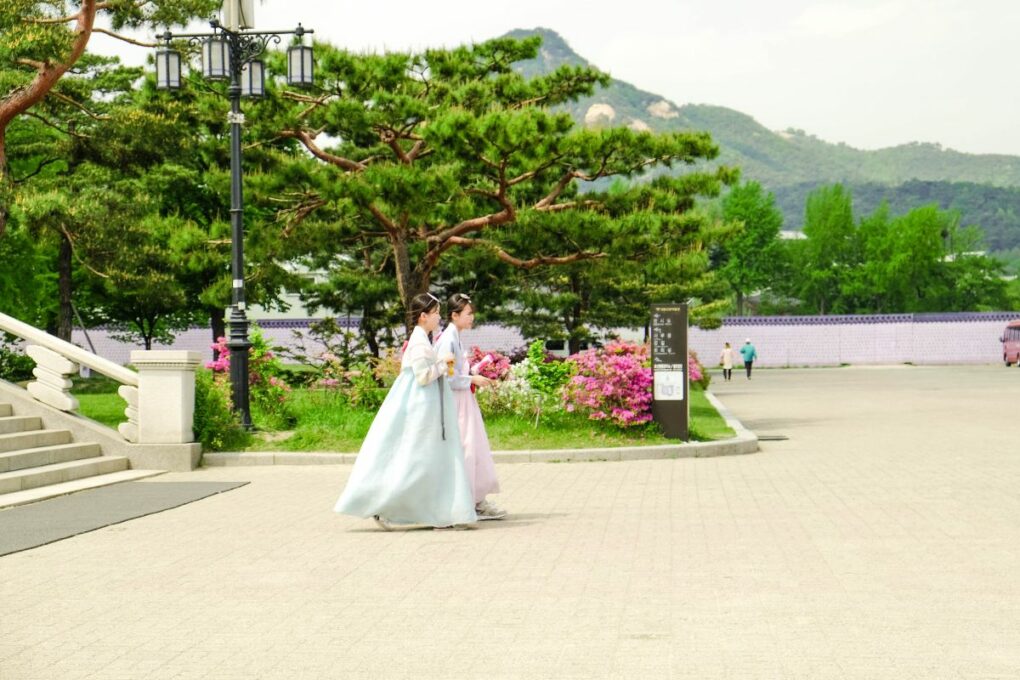
There are five Seoul palaces open to the public:
- Gyeongbokgung
- Changdeokgung
- Changgyeonggung
- Gyeonghuigung
All five Seoul palaces are best seen during spring, when the surrounding flora reinforces the palaces’ dancheong designs , or the color schemes used on wooden buildings and artifacts in pre-modern Korean architecture. Dancheong can either come in red, blue, yellow, black, and white, and these aren’t just random patterns.
There’s a reason they seem to be everywhere when you visit historical sites in Korea. These spots have stories, and as a traveler, it’s fascinating to unravel the meanings of each colorful piece.
The largest palace in Seoul, Gyeongbokgung, actually just reopened the majority of their grounds in spring 2022, after more than half a decade of renovation. So for whenever you set foot into any of the royal palaces in Seoul, here is our guide to taking a respectful trip back into the past.
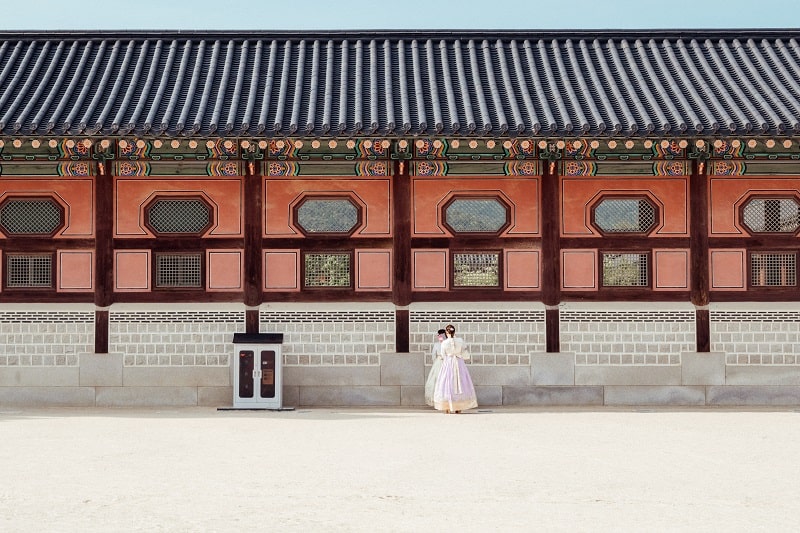
9 Tips for Visiting Palaces in Seoul
Coming to any of the royal palaces in Seoul may seem to require a lot of preparation. The areas around the grounds can get hot & humid (most especially during the Summer ), and walking from one site to another may take a while.
A couple of the 5 Seoul palaces are much like a maze, and others are easy to navigate. Overall, it’s most important to dress for comfort (keeping the weather in mind), and don shoes that are perfect for walking.
- Wear a Hanbok to Get in for Free
If you don’t know what a hanbok is, it’s a Korean traditional outfit often worn during holidays or special occasions – but you don’t have to have a special reason to wear them. There are plenty of hanbok rental shops outside every Seoul palace, and you can rent these for an affordable price (₩13,000 to ₩15,000 for the afternoon).
If you want to skip the lines, there’s an option online that lets you borrow hanboks for a whole day. Since 2013 you've even been able to come in for free, because the Cultural Heritage Administration has waived admission fees to anybody properly wearing a hanbok to any palace in Seoul.
By properly, they mean that tourists are expected to follow the requirements on how to respectfully don this traditional garment. Unfortunately, this means that women should strictly wear the skirt ( chima ) above their waists, despite how uncomfortable and inconvenient it can get in the summer.
The chima can get really billowy and heavy, so people have actually been trying to contest this rule since 2017, but until then, you can save bucks by just wearing the hanbok properly.
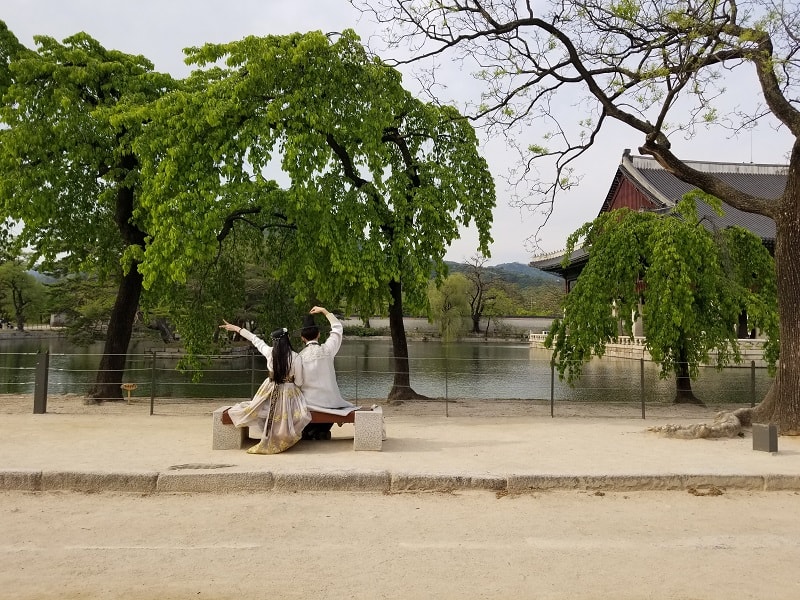
- Royal Palaces in Seoul are Free on Major Holidays
If you’re not keen on wearing the hanbok, there’s another way to get in for free, and that is to time your visits during major holidays like Chuseok (week-long fall harvest festival) or Seollal (Korean Lunar New Year) .
Cultural events are plentiful in any of the Seoul Palaces during these holidays, and sightseers will be treated to performances like the pansori (musical storytelling) , ganggangsullae (traditional circle dance) and samulnori (percussion dance).
- Come See Seoul’s Palaces on the Last Wednesday of Every Month
Here’s another cool tip: the fee to the royal palaces in Seoul is waived during “ Culture Day ,” also known as the last Wednesday of each month. This event is created to boost the approachability and accessibility of Korean culture to the public.
On this day, cultural sites other than the Seoul palaces also offer free or heavily discounted admission to locals and tourists. Their goal is to help bridge the cultural gap with opportunities that teach visitors about this wonderful country, so expect to meet lots of locals.
- Don’t Come on Mondays (or Tuesdays for Gyeongbokgung)
The downside of the Seoul Palaces are that they’re not open every day. What if you decide to wear a hanbok to get in for free only to realize that these places are closed? Save yourself from the trouble by researching when the palace closes beforehand, and planning to do other activities that day.
Note that all palaces are closed on Mondays, except Gyeongbokgung (which is closed Tuesdays).
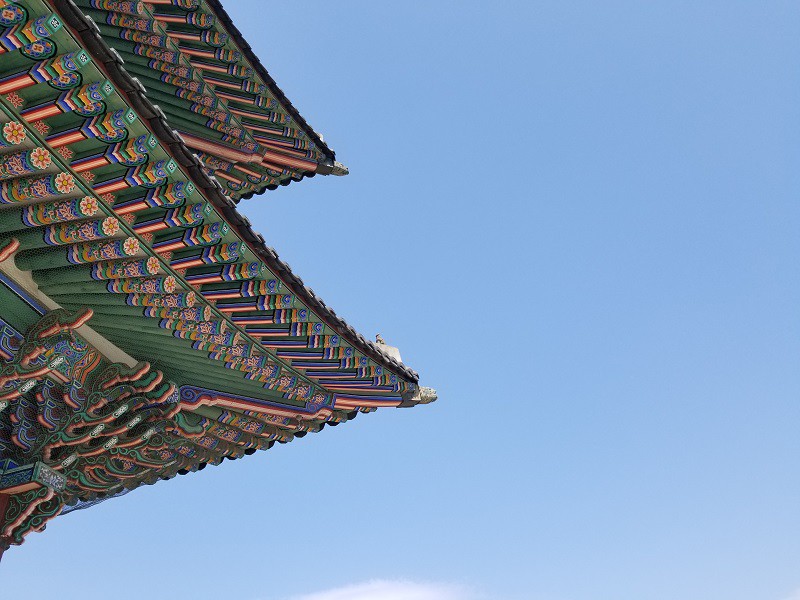
- Join a Seoul Palace Tour
What may aid in your discovery is to sign up for a tour to understand the royal palaces of Seoul even better. These guided tours not only will provide you with a lot of information, but they’ll also show you the optimal walkways to cover all the main parts of the grounds, which is especially important at Gyeongbokgung.
Whether paid or unpaid, these tour opportunities can thoroughly educate those who are genuinely interested in Korean history. Unfortunately, the official tours are only offered once a day in English, which is why many opt to join a paid tour.
Luckily, many of these tours also come with fun activities, like a stop in at a traditional tea tasting within the palace grounds, or photoshoots in special areas that normally require additional charges to get in.
Speaking of tours, Gyeongbokgung Palace offers a free guided tour in English at 2PM every day, and you can register yourself on their website or inquire about it onsite.
- There are Night Tours Too!
Many tourists are surprised to know that the palaces are even more breathtaking at night, and there are actually tours that let you enjoy a romantic walk around the palace gardens at night.
Evening photoshoots in a hanbok is a popular couples’ activity in Korea, and you can often hire photographers nearby in the most popular spots to take romantic pictures of you and your loved ones.
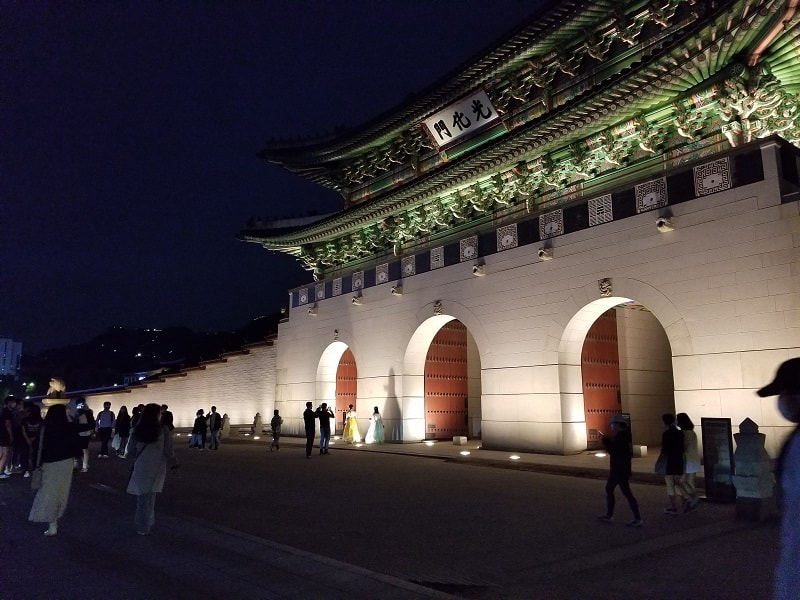
- Get an “Integrated Ticket of Palaces”
Jumping from one Seoul palace to another may be cheap (because cultural sites don’t really charge much), but it can be even more affordable if you acquire this special pass that lasts for a month. That gives you enough time to carefully plan your trip to the five palaces in Seoul without rush from one to another.
Simply visit any one of the five royal palaces in Seoul and ask for the Integrated Ticket of Palaces.
- Wear Comfortable Shoes
If you’re going to walk around the palaces, it wouldn’t make any sense to wear heels or boots. Keep in mind that you’ll be walking for hours on soft, uneven ground, and even though there are plenty of places to rest, most of the areas are already crowded with people.
If you must bring a bag, pack light, because you'll be walking quite a bit.
- Follow The Dress Code
While we are on the topic of what to wear, there is no formal dress code for any of the Seoul palaces. But it is an unwritten rule that you should show respect by wearing something that covers your shoulders, as this is a cultural site. You don’t want to get scolded by a random older Korean while you’re enjoying your visit.
Fun Fact : 'gung' is Korean for palace, which is why all the palaces' names end in -gung.
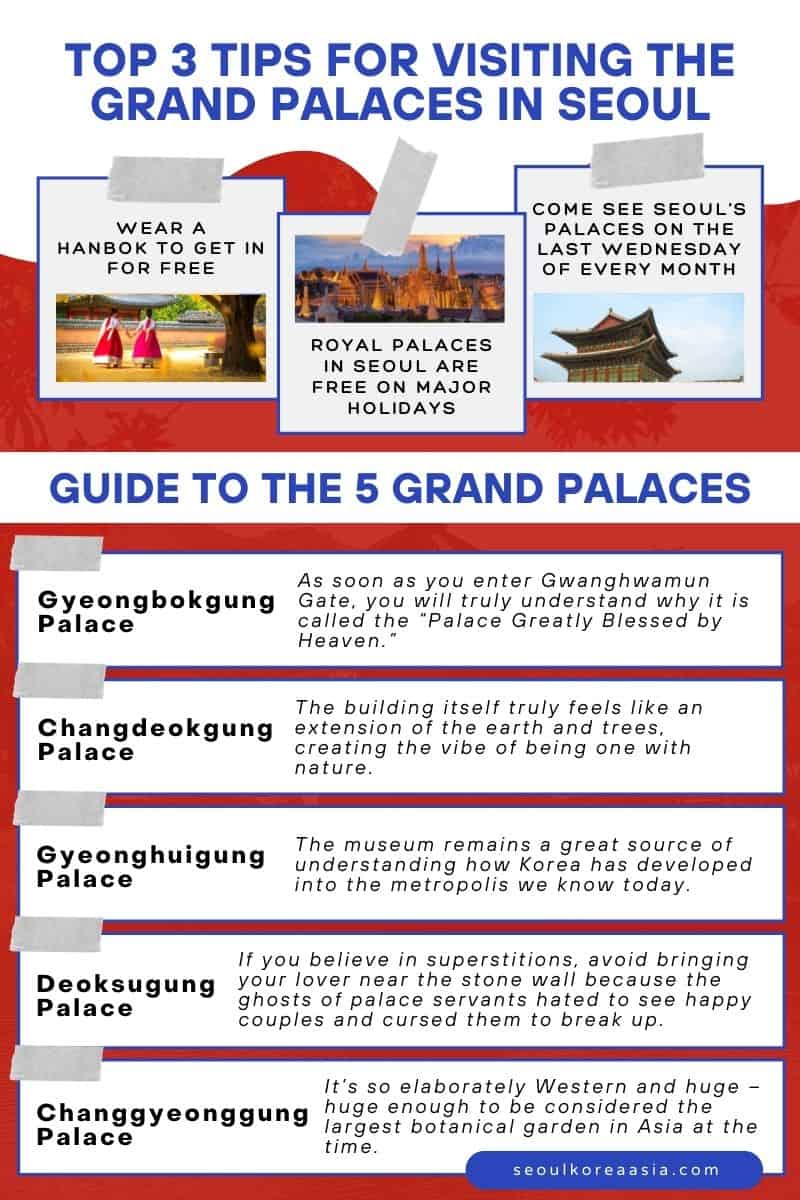
The 5 Remarkable Royal Palaces of Seoul
Gyeongbokgung palace.
Hours : closed on Tuesdays; 9AM to 6PM
Season : best in spring
Entrance Fee: Adults: ₩3,000; Children: ₩1,500
How to Get There : Gyeongbokgung Station (Line 3, Exit 5)
My advice is, before you visit other royal palaces in Korea, come see Gyeongbokgung first. This is because before you get to the palace grounds, you can visit a free museum full of well-preserved archaeological digs that date all the way back to the Joseon Dynasty, making it the perfect place to feed your inner history buff.
You’ll also get a good foundation of knowledge before wandering the large grounds; bring a water bottle if the weather is warm. Afterwards you can head over to the actual palace, just a quick walk outside and around, to truly explore the large swath of land that it occupies.
As soon as you enter Gwanghwamun Gate, you will truly understand why it is called the “Palace Greatly Blessed by Heaven.” The immense Geunjeongjeon Hall – also known as the largest wooden structure in Korea – used to be where grand coronation ceremonies were held.
You can join the long queue to peer inside and admire the detailed ceiling dancheong , with stories representing the regal authority of the King.
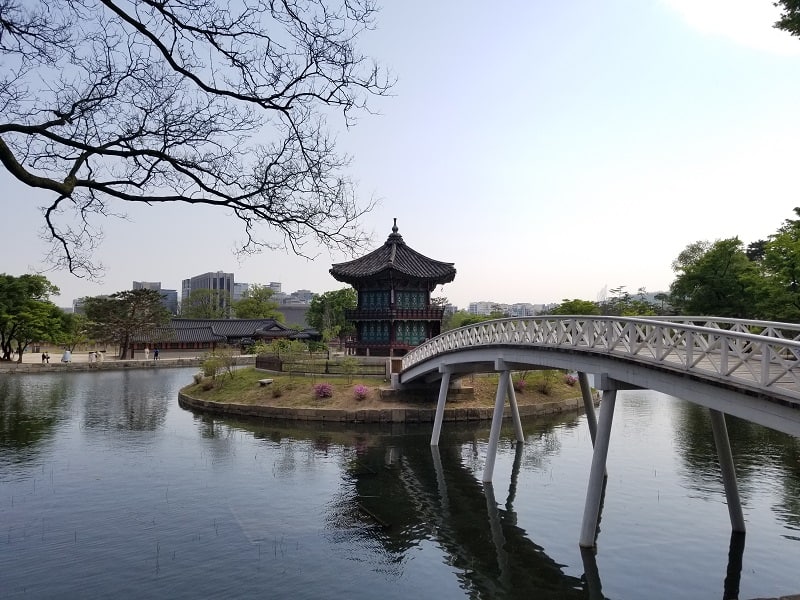
While the entrance is already serving you much of the good stuff, behind this large wooden palace is a walkway to the building floating on a man-made pond. This small structure is called the Gyeonghoeru Pavilion, and it’s a site created to hold lavish banquets to impress foreign delegates whom the King wishes to do business with.
You do have to pay extra to get in, but the panoramic views of the Seoul cityscape will quickly convince you that this is worth it. While in the middle of your visit, you might stumble upon tea ceremonies, reenactments, and traditional instrument performances.
But the most consistent show you’ll ever get is the “Changing of the Guard Ceremony” that takes place at 10AM and 2PM, right by the entrance to Gyeongbokgung Palace. Within Korea, Gyeongbokgung Palace is famous as the place where King Sejong the Great created the first Korean alphabet, called hunmin jeong-um, which was later renamed hangul .
This is because he realized that his subjects had difficulty expressing terms in written Chinese characters. True to the King's promise, 'til today hangul has been widely recognized as the world’s easiest writing system .
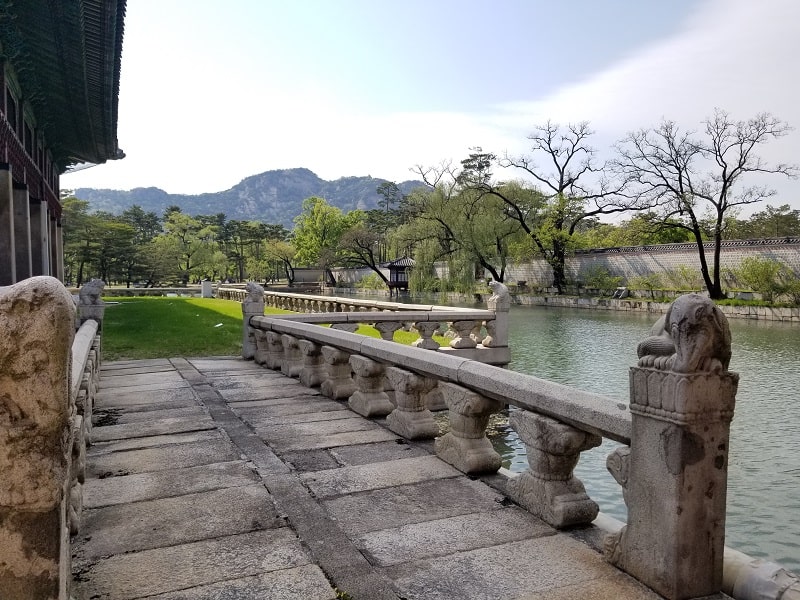
Changdeokgung Palace
Hours : closed on Mondays; 9AM to 6:30PM
Season : best in spring & autumn
Entrance Fee: Adults: ₩3,000; Children: ₩1,500; Secret Garden entrance fee : Adults: ₩5,000; Children: ₩2,500
How to Get There : Anguk Station (Line 3, Exit 3); Jongno 3-ga Station (Line 1, 3, & 5 Exit 6)
Also known as donggwol , or the Eastern Palace, Changdeokgung Palace was built after Gyeongbokgung Palace was constructed. This is also considered the most beautiful royal palace in Seoul, since this houses the not-so Secret Garden ( huwon) .
It’s known for its small pagoda with an impressive take on Korean garden architecture, overlooking a large pond called the buyeongji, which is usually covered in leaves during fall . Moreover, this is said to be the pond where King Jeongjo took his friends to fish.
Changdeokgung used to be the favorite villa of Joseon kings and princes, since its gardens were built to have a therapeutic vibe, meant to ease them from the burdens of running a kingdom. Furthermore, the building itself truly feels like an extension of the earth and trees, creating the vibe of being one with nature.
This royal palace also houses plenty of artifacts dating all the way back to the ancient period of samhan (or the era of the Three Kingdoms of Korea). This was the perfect setting for these cultural treasures, because unlike the resplendent Gyeongbokgung Palace, Changdeokgung felt muted and blended in well with the surroundings.
Nowadays it is also known as the most well-preserved palace in Seoul, and was the only Seoul palace that made the UNESCO World Heritage List in 1997.
Fun Fact : during the Goryeo and the Joseon period, this is where the gwageo , or national civil service exams, took place. Sadly the examinees and palace officials in charge of the event couldn’t wander beyond the restricted area to admire the garden without obtaining the King’s permission. If you’re curious to see what this looks like, sometime every October there’s a reenactment of the gwageo siheom process at this palace’s Injeongjeon Hall.
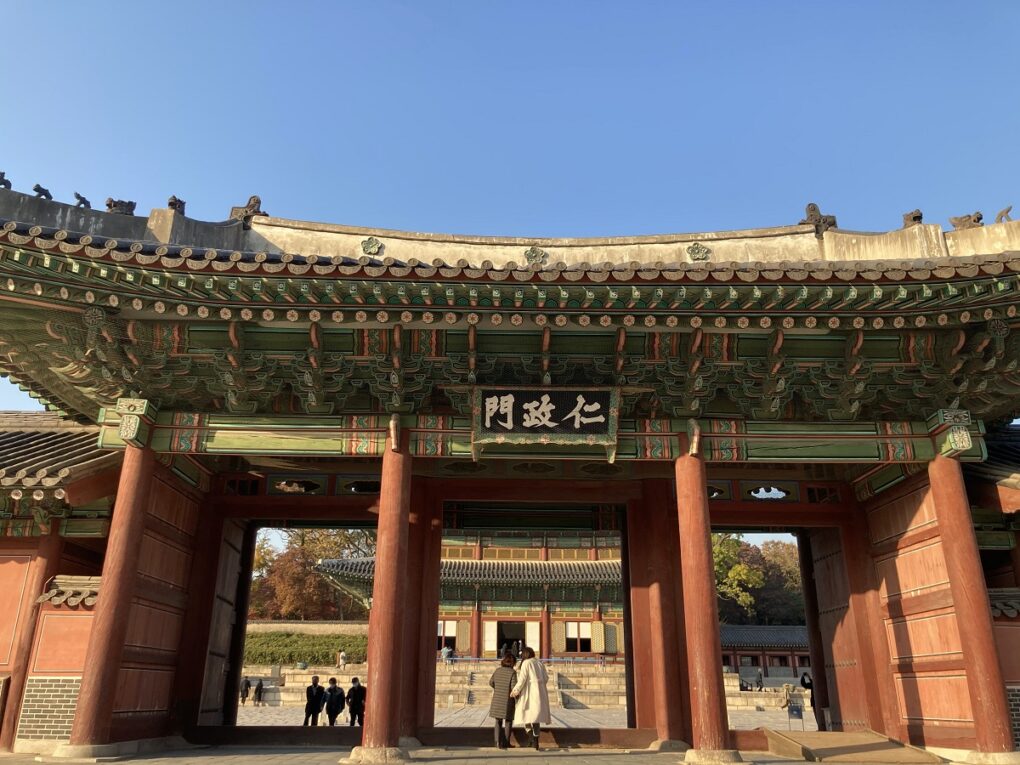
Gyeonghuigung Palace
Hours : closed on Mondays; 9AM to 6PM
Season : any season
Entrance Fee: Free
How to Get There : Seodaemun Station (Line 5, Exit 4)
Found on the west side of Seoul, this royal palace served as the King’s shelter whenever an emergency occurred. It used to be inconspicuous, hidden behind the slanted geography of the surrounding mountain, which made it the perfect hideout.
Now it’s the perfect area to view N-Seoul Tower without getting bothered by the raucous noises of Seoul. Too bad we couldn’t see how huge it used to be, because Gyeonghuigung used to have over a hundred halls and a bridge that traveled all the way to Deoksugung before the Japanese destroyed most of Korea’s palaces during the Imjin War (1592-1598).
That’s why, somewhere near the palace and the museum, almost near the parking lot in fact, there lies a concrete structure that used to be a Japanese bunker in World War II. Sadly, current restoration efforts were not given priority, and only a third of the palace grounds have been fixed.
Also, unlike the other Seoul palaces, this one feels more abandoned rather than its namesake; “serene.” Furthermore, some locals say that nobody really wants to come see it because it was so neglected, to the point that mountain tigers used to visit long ago and use it for rest.
Don’t worry about tigers coming now, though. Korean officials finally took care of the grounds and still use it for events like the recreation of the gwageo .
The number of people coming to see the nearby Seoul Museum of History has thusly increased the number of people wanting to see this palace, as well as understand the role it played in sheltering ten Joseon kings. The museum remains a great source of understanding how Korea has developed into the metropolis we know today.
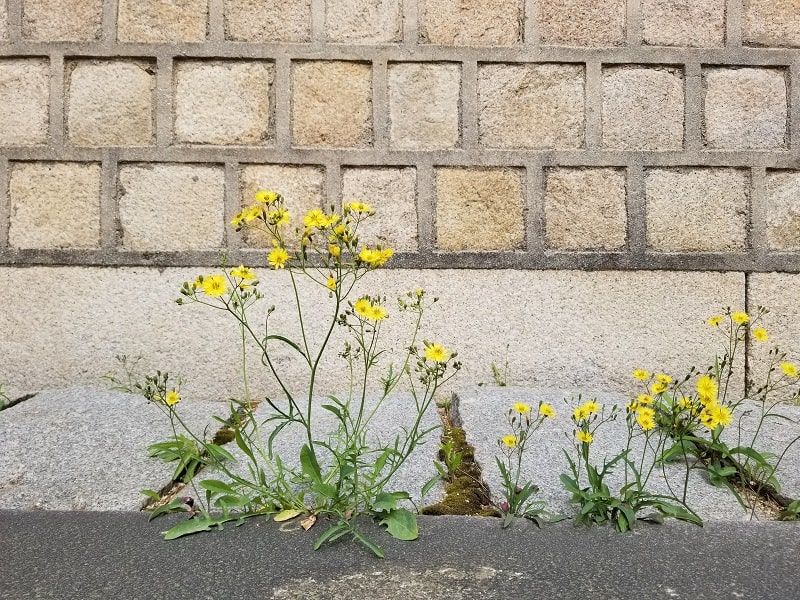
Deoksugung Palace
Season : best in fall
Entrance Fee: Adults: ₩1000; Children: ₩500
How to Get There : Sicheong Station (Line 1, Exit 1)
After the Imjin War, King Seonjo used this as a temporary place to stay. Years later, King Gojong thought it would be a brilliant idea to legalize it into a legitimate palace before stepping down to make way for the last King of the Joseon Dynasty: Sunjong.
Perhaps what’s so fascinating about Deoksugung palace is that it has a lot of foreign architecture incorporated into the design. There’s even a European-style stone wall that surrounds the entire palace.
Specifically the Jeonggwanheon Pavilion, for example, was designed by a Russian architect that used Western styles to give foreign banquet guests a feel of being acknowledged and welcomed. Local officials marveled at the infusion, thinking that this is a way to quietly view the world without leaving Seoul.
Gojong’s reasoning as to why he increased the Western influence is to make Korea seem like a modern and forward country, with the hopes at the time of keeping the Japanese at bay. Seokjojeon Hall is a far cry from Korean architecture; instead of wood it is made of stone, and is known as Korea’s first European-style building .
What a lot of people don’t know is that there’s a 45-minute tour of Seokjojeon Hall that lets you see the reception room on the first floor, and then take you to the upper floors where the central hall and the private bedrooms (including royal bathrooms) are located.
If you firmly believe in superstitions, I've been told by locals not to bring your lover near the stone wall, because the ghosts of the palace servants hated to see couples happy, and would curse them to eventually break up.
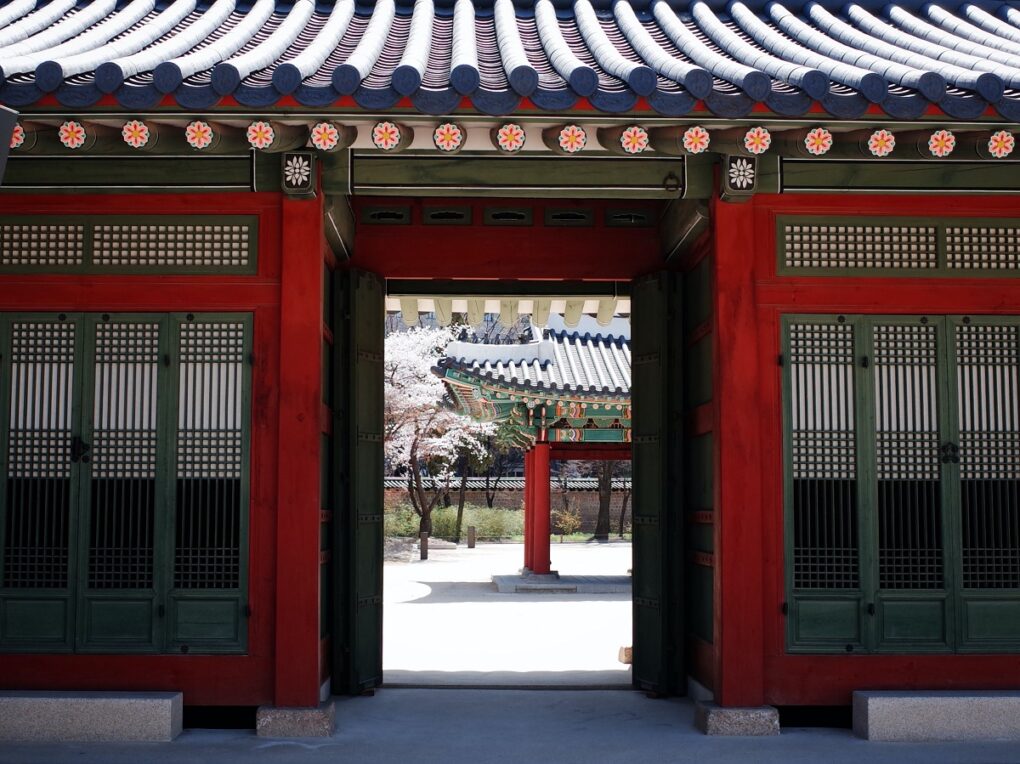
Changgyeonggung Palace
Hours : closed on Mondays; 9AM to 9PM
How to Get There : Hyehwa Station (Line 4, Exit 2), ride the Bus 301 at the Hyehwa Station-Marrionier Park Bus Station (혜화역.미로니에공원 정류장(01220)) then get off at the Changgyeonggung Palace – Seoul National University Hospital Bus Station (창경궁.서올대학교병원 정류장(01002))
Found in the middle of Seoul, this was erected by King Sejong as a gift to his father, King Taejong. Most of the people housed here over the years were queens and concubines. Eventually, this place was renovated during the time of King Seongjong, to ensure the comfort of his mother and grandmother as well as the other elders in his family.
This is why the living quarters in this palace are bigger compared to the other Seoul palaces. However, this was also the source of many royal family issues, like the brewing hatred between the king and the crown prince, and the queen’s nasty attitude towards the royal consorts.
Other horrible secrets include the death of Prince Sado after his father, King Yeongjo, ordered to have him locked up in a rice chest. Sado was also not a good guy, either – but hey, all of these are just some of the fascinating tales you'll learn on your visit here.
Sadly, this was also one of the palaces attacked during the Japanese occupation, turned into a botanical garden and zoo. Said botanical garden was also patterned like a famous one in France, which is why it’s so elaborately Western and huge – huge enough to be considered the largest botanical garden in Asia at the time.
Only the botanical garden remains standing today. Just a short walk from this place is Jongmyo Shrine, where the ancestral tables of kings and queens of Joseon Dynasty are entombed.
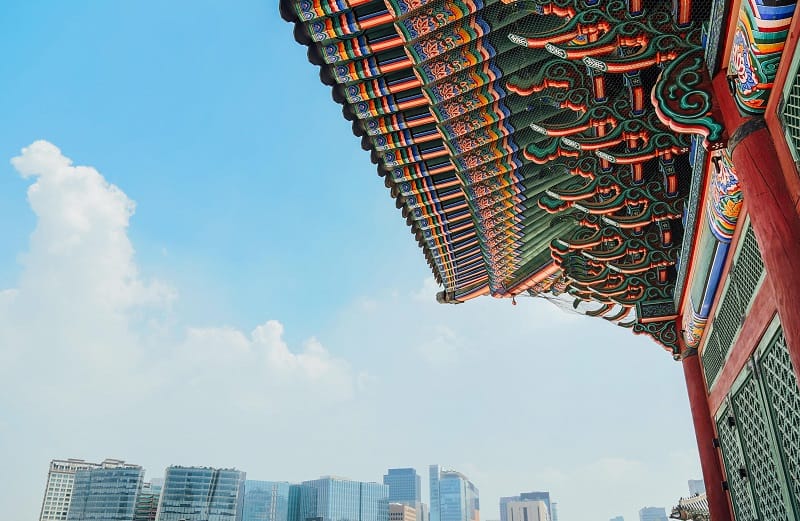
Special Mention: Unhyeongung Royal Residence
Hours : closed on Mondays; 9AM to 7PM
How to Get There : Anguk Station (Line 3, Exit 4)
This is not a Seoul Palace per se, but it could qualify as one for many, because it’s widely known as the residence of King Gojong’s father: Heungseon Daewongun. The reason it’s featured here is because most historically important events of the Joseon period took place within the walls of this residential home.
If you're a fan of historical K-Dramas, you've probably seen some part of this residence. That’s why, if you come see it in person, you’ll be treated to informative details on how royalty used to live in relatively recent times.
Every room in here contains a mannequin of people dressed in various types of hanboks that displayed their social status. Other events also feature the royal wedding ceremony reenactment, which allows you to have a glimpse of how King Gojong and Empress Myeongseong were wed.
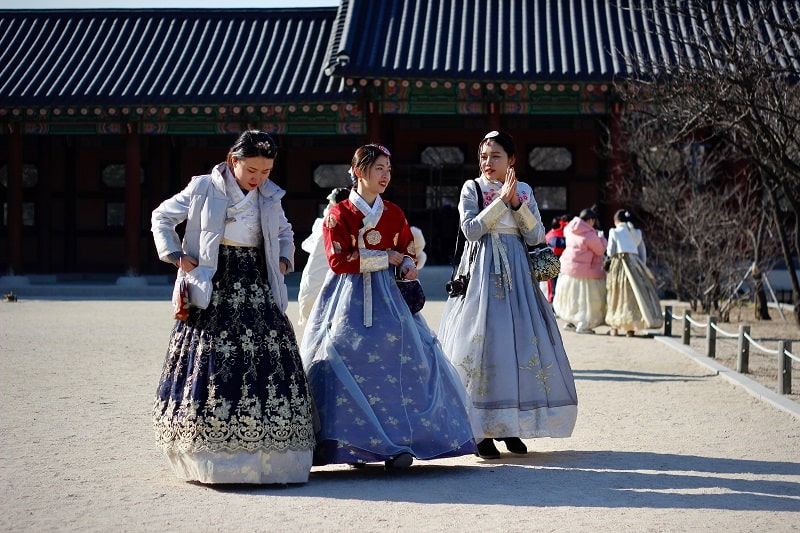
Best Tours of Seoul Palaces
Walking around the palaces is better if you have a guide educating you thoroughly about what you are seeing and experiencing. It’s also fun to hear inside stories and facts about the area that may even make you want to do more research on Korean history and the lives of the people who resided there.
- Moonlight Tour at Changdeokgung Palace
Visit the most beautiful palace in Seoul at night—even though the garden is gorgeous during the day, it is ten times more breathtaking at night. Book your tour on Changdeokgung’s website.
- Seoul Historic Walking Tour
This tour allows you stop at Changdeokgung during the day, and even witness the Changing of the Guards Ceremony at Gyeongbokgung. This is an easy tour of Seoul’s palaces that tells you all the fun and hilarious shenanigans the royals got themselves into, plus a bit of history. More details are included in this website .
- Gyeongbokgung Palace Hanok Village
The Hanok Village tour lets you imagine how people from the Joseon Dynasty traveled from the Bukchon Hanok Village to Gyeongbokgung Palace. The beauty about it is that it has activities you and your friends or family can do during the tour.
These include trying on the different hanboks , making your own hanji (traditional paper art), and trying local delicacies of the season. Also, your guide will give you a detailed explanation of Korean architecture as you move from the village to the palace; see the itinerary and the full details on this website .
- Seoul Palace Snap Shooting Tour
Bring a professional photographer along with you as you visit three out of five ancient palaces in Korea! While enjoying the tour, you’ll also be taken to the best spots that truly capture – not only you – but also the intricate Korean architecture serving as your backdrop.
At the very least you can rest reassured that after this tour your photos will definitely be nice. Learn more about this tour here .
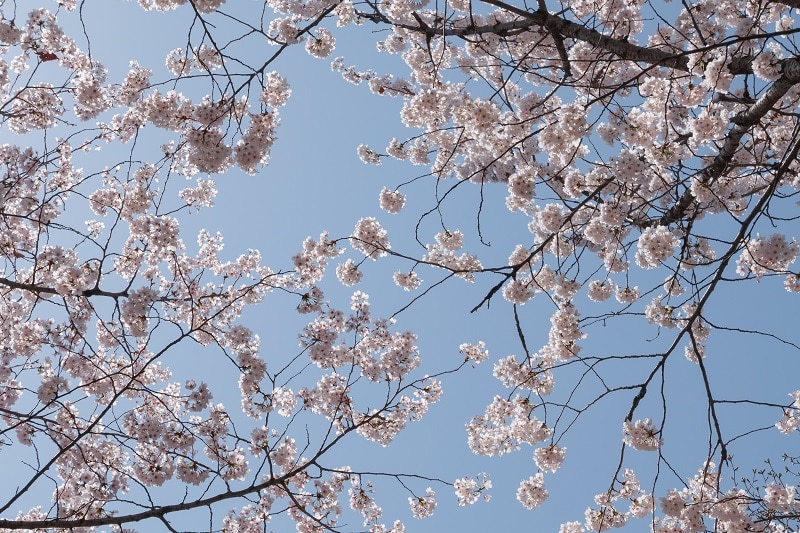
FAQ About Palaces in Seoul
There are five palaces in Seoul, all of which were built during the Joseon Dynasty (1392-1910).
Also known as the largest and grandest, it is not a surprise to know that Gyeongbokgung Palace is the most well-known out of the royal palaces in Seoul.
Aside from being known as the most well-preserved palace in Seoul, the beauty about Changdeokgung is that it has a secret garden called the Huwon.
It depends on your preference, but a lot of locals recommend Changdeokgung due to its vibrant scenery and tranquil vibe. But I also feel that Deoksugung is just as wonderful, and most of its elements feel elegant and modern.
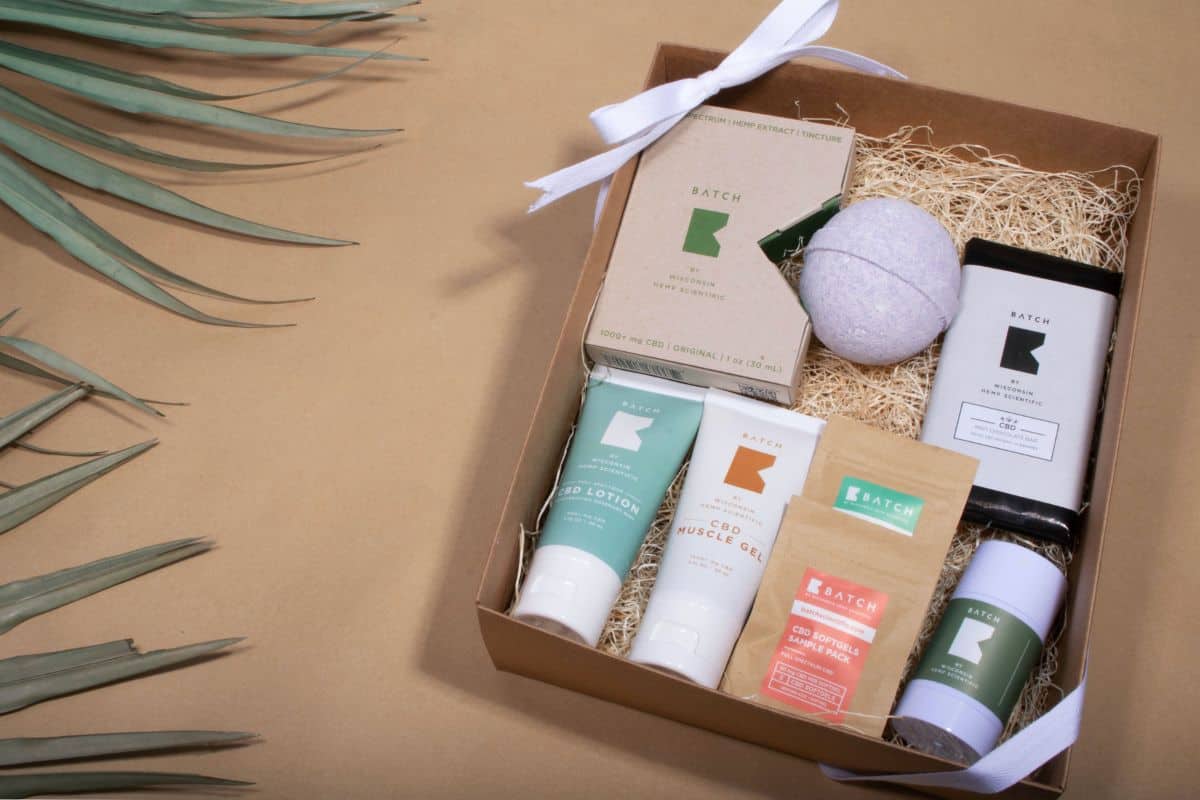
Sharing is caring!
Reader Interactions
Personalized says
December 09, 2022 at 3:39 am
Thanks for the recommendations. I'd like to visit here as soon as possible!
December 09, 2022 at 10:57 am
You're very welcome!
Leave a Reply Cancel reply
Your email address will not be published. Required fields are marked *
This site uses Akismet to reduce spam. Learn how your comment data is processed .

A Guide to the 5 Royal Palaces of Seoul
- An Introduction To The Royal Palaces In Seoul
.jpg)
Gyeongbokgung Palace Seoul
Tourists looking to enjoy a quintessentially Korean experience should look no further than a day out at a royal palace in Seoul . Discover the majesty of the palace buildings towering over wide courtyards that were once filled by Korea’s bravest and most noble citizens. Explore the many areas of natural beauty that showcase Korea’s cherry blossoms and fall foliage, all partnered with pavilions and pagodas to provide awe-inspiring scenes. Find moments of serenity in traditional teahouses and cafes with delightful Korean green tea and other natural beverages as you look out over glimmering ponds and people dressed in flowing Korean hanbok .
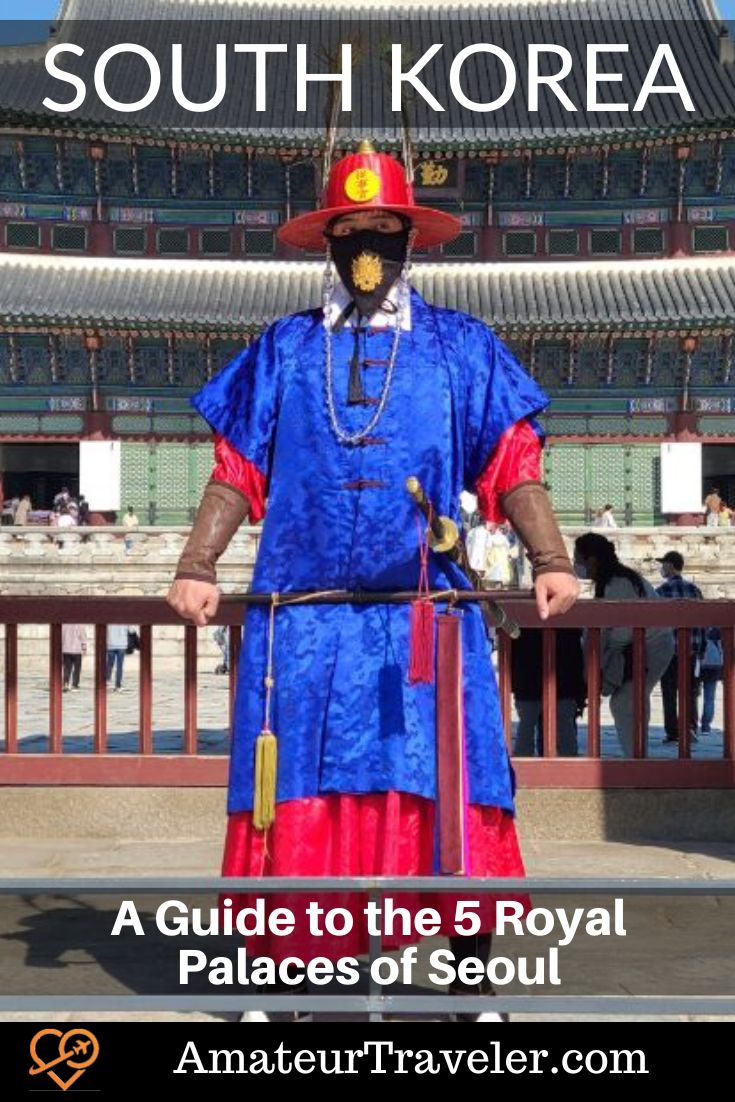
What To See At Gyeongbokgung Palace
How to get to gyeongbokgung palace, what to see at changdeokgung palace, how to get there to changdeokgung palace, what to see at changgyeonggung palace, how to get there to changgyeonggung palace, what to see at deoksugung palace, how to get there to deoksugung palace, what to see at gyeonghuigung palace, how to get there to gyeonghuigung palace, tips for visiting the royal palaces in seoul.
.jpg)
There are a total of 5 royal palaces in Seoul, all of which are open to the public and showcase the best of traditional Korean architecture, design, and royal life:
- Gyeongbokgung Palace : The main royal palace in Seoul and arguably the most beautiful and busiest.
- Changdeokgung Palace : The most well-preserved palace that also features an impressive secret garden.
- Changgyeonggung Palace : A peaceful palace that was built as a retirement place for the King’s father.
- Deoksugung Palace : An elegant palace that features a mixture of traditional Korean and neoclassical European designs.
- Gyeonghuigung Palace : A less-visited palace that includes the Seoul Museum of History and peaceful grounds.
Each royal palace has its own unique charms and features, such as tranquil ponds lined by cherry blossoms, secret gardens where royalty once hid away from the public eye, and even neoclassical European buildings surrounded by stately Korean stone walls.
This guide to the 5 royal palaces of Seoul will introduce you to each palace, highlighting each palace’s attractions, as well as shining a spotlight on its history. Seoul, and Korea in general, has had a turbulent past, with invasions and wars between neighbors for centuries, which often resulted in royal palaces being plundered or destroyed. Fortunately, Korea has worked hard over the last few decades to restore these magnificent attractions so visitors from around the world can come and enjoy palace life.
When you travel to Korea , you should definitely include at least one of these royal palaces in your itinerary, if not more. Walk around the palace grounds, peek into former royal residences, and see what life in Korea was like for those at the top.
.jpg)
Gyeongbokgung Palace: Seoul’s Main Royal Palace
Gyeongbokgung Palace is Seoul’s largest and most popular of the five royal palaces. Built in 1395, when Seoul became the capital of Korea, this palace is truly the heart of the city and is close to a number of the best tourist destinations. It lies between Gwanghwamun Square in the south and the presidential Blue House, also known as Cheong Wa Dae, to the north. You’ll also find Bukchon Hanok Village to the east and the trendy Tongin-dong neighborhood to the west.
The sprawling gardens, imperious palace grounds, pretty ponds, and beautiful nature that blends together inside Gyeongbokgung Palace make it a must-see destination for travelers to Seoul.
.jpg)
Even before you enter the palace, you can see the majesty of this destination with tall, stark white-brick walls topped with unmistakably Korean black tiles surrounding the entire palace, hiding the treasures inside. Arrive at 10:00 or 14:00 and you’ll be treated to the changing of the guards, a colorful spectacle that shows the traditional ceremony with guards holding large spears and swords, marching together into the palace.
Once you enter the palace through the beautifully decorated wooden gates, you’ll immediately realize just how large this palace is. This royal palace is indeed fit for royalty, covering more than 400,000 square meters of central Seoul. After making your way through the spacious welcome area, where Joseon-era courtiers, advisors, and nobles came to pay their respects and listen to their ruler’s orders, the palace gives you the freedom to explore the rest of the grounds as you like.
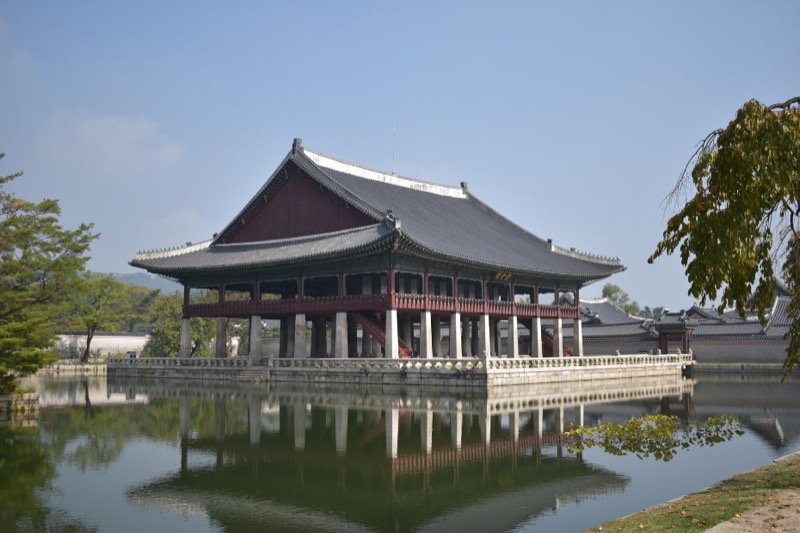
One of the main attractions inside the palace is Gyeonghoeru, a lonely pavilion that stands in a serene pond covered with lily pads and surrounded by cherry trees. This is one of the most iconic scenes in Seoul, and in early April, photographers flood here to capture the incredible views. Next to Gyeonghoeru are the royal palace buildings where the former rulers of Korea went about their daily business. Inside these rooms are the King’s Seat, detailed tapestries, golden statues, and other displays of royal wealth and power.
.jpg)
Near the rear of the palace is the newly renovated Hyangwonjeong Pavilion, which stands in the middle of a circular pond, accessible only by a white wooden bridge. Sadly, visitors can’t enter this pavilion, but there are many spots to take pictures in this part of the palace, which show off the drooping willow trees and mountainous background.
To learn more about Korea’s rich history, there are two museums that are free to enter when you’re inside the palace. The National Palace Museum of Korea houses a collection of Joseon Dynasty artifacts, while the National Folk Museum of Korea has interesting displays about Korea’s historic past and is a good place to learn about Korean customs and culture.
.jpg)
The nearest subway stations to Gyeongbokgung Palace are Gyeongbokgung Station (Exit 5), Anguk Station (Exit 1), and Gwanghwamun Station (Exit 2). You can easily spot the palace by the large walls surrounding it.
Opening hours:
- Nov-Feb 09:00-17:00
- Mar-May 09:00-18:00
- Jun-Aug 09:00-18:30
- Sep-Oct 09:00-18:00
- Closed every Tuesday
Entry Fees:
- Adults: 3,000 won
- Children (7-18): 1,500 won
- Children under 7: Free

Changdeokgung Palace & Secret Garden: Seoul’s Hidden Beauty
A 10-minute walk away from Gyeongbokgung Palace, passing through the traditional Bukchon Hanok Village, takes you to Changdeokgung Palace and Secret Garden. Whereas Gyeongbokgung Palace offers majestic awe, this secondary palace is much more in tune with nature and offers idyllic views of ponds, plants, and peaceful royal resting places. The surrounding walls are lower here, making the palace more welcoming. The low walls also give a chance to the tall trees to creep over and tease the beauty that lies within.
Changdeokgung Palace, built in 1405, served as the secondary royal palace to Gyeongbokgung Palace until they were both destroyed during a Japanese invasion in the 16 th Century. Afterward, Changdeokgung Palace became the primary royal palace in Seoul during the reconstruction period during the 17 th and 18 th Centuries, when Korea started to prosper again until Gyeongbokgung Palace was also rebuilt and became the main royal palace once more. Despite this change, Changdeokgung remained a popular place for the royal family to relax. It included many buildings dedicated to raising the Crown Prince.
Where Gyeongbokgung Palace impresses with large, open spaces, Changdeokgung Palace beguiles you with closely built palace buildings, narrow pathways, and the ever-encroaching trees and bushes that paint a beautiful background. Once you enter, you’ll see a small courtyard and the forest of pagoda trees, with a stone bridge leading into the main palace buildings. Once past this courtyard, you’ll find the central Changdeokgung Park and other buildings. Wind your way through the low-roofed palace buildings, under walkways, through narrow gates, and under the drooping trees as you explore the palace grounds.
.jpg)
Although Changdeokgung is considered a secondary palace, it’s actually larger than the main royal palace, with more than 460,000 square meters of grounds to explore. However, 60% of the palace grounds are taken up by the delightful Secret Garden, known locally as Huwon. The Secret Garden is a meticulously preserved park that features a number of secluded spots where the royal family would contemplate the responsibilities of imperial life, hold private events, and escape the Korean summer heat. The Secret Garden is one of the highlights of Seoul’s royal palaces and a must-see in the city.
Access to the Secret Garden is limited to 4 English-language guided tours each day, with a limit of 100 guests per tour. Bookings are available in the morning, and tickets sell out fast during peak times. Thanks to this restricted access, the Secret Garden has remained pristine, with nature able to flourish all around. Visitors who make it into the Secret Garden will be treated with views of pagodas overlooking calm ponds, stonewall pathways shaded by leafy trees, secluded resting grounds, and many beautifully preserved traditional buildings.
.jpg)
The nearest subway station is Anguk Station (Exit 3). It’s a short walk from the subway exit to the royal palace, passing the Arario Museum on the way.
- Feb-May, Sep-Oct 09:00-18:00
- Nov-Jan 09:00-17:30
- Closed on Mondays
Secret Garden Opening Hours:
- Mar-May, Sep-Oct 10:00-17:30
- Jun-Aug 10:00-18:00
- Feb, Nov 10:00-17:00
- Dec-Jan 10:00-16:30
- Children (ages 7-18): 1,500 won
Secret Garden Entry Fees:
- Adults (ages 25-64): 8,000 won
- Young adults (ages 19-24): 5,000 won
- Senior citizens (ages 65+): 5,000 won
- Children (ages 7-18): 2,500 won
- Children under 7 Free
.jpg)
Changgyeonggung Palace: An Urban Retreat
When you arrive at Changdeokgung Palace, you might not realize that there are actually two palaces in the same location, not just one. These two palaces, seen from above, look like a taijitu, or yin and yang, curving into each other to make one large palatial area that has two distinct halves.
The yin is Changdeokgung Palace, taking up the western and northern areas, while the yang is Changgyeonggung Palace, covering the east and southern areas and sneaking into the north. This palace was typically used as a place for visiting nobility to stay, as well as a home for the royal concubines and lesser royal family members.
.jpg)
King Sejong, one of the most celebrated rulers during the Joseon Dynasty, ordered the construction of Changgyeonggung Palace in the 15 th Century as a tribute to his father, King Taejong. At this time, it was known as Suganggung Palace but was later renovated and renamed to the current Changgyeonggung Palace.
This peaceful palace features fewer palace buildings than the aforementioned royal palaces and instead appears more like a majestic retirement home. Although a wall divides these two palaces, you can easily pass between them at a central gate near the entrance to the Secret Garden. When you enter the second palace, you have to pay the 1,000 won entrance fee.
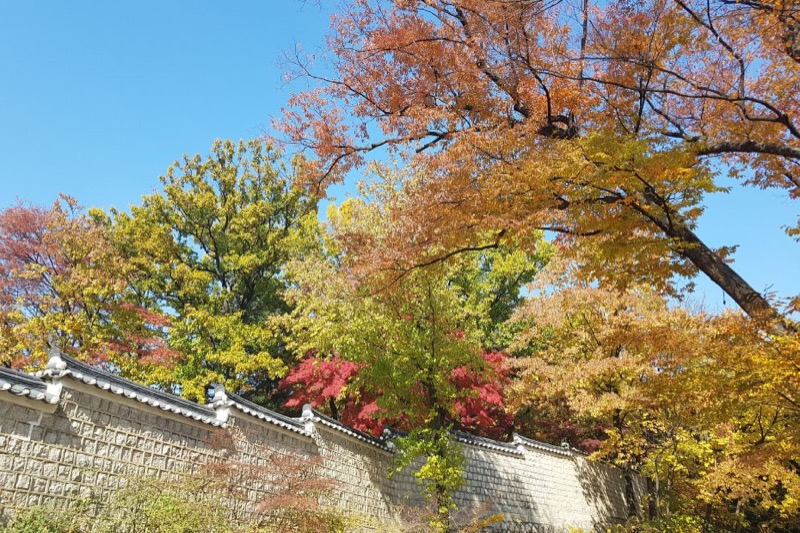
This leafy palace is the perfect place for a stroll on a sunny day and has lots of pathways through tall forests, lakes, and ponds to peer into, and a greenhouse that looks like it would be more at home in an English palace. Chundangji is a figure-eight pond in the northern part of the palace with a wide variety of trees surrounding it, each bringing their own distinct color and shades during fall and creating one of the best fall foliage sights in Seoul. This part of the palace was originally used by the king and queen to experience farming and sericulture (silk production) so they could understand how their subjects lived and worked.
Near the entrance in the east, you can see the main palace building and surrounding structures. This area is less busy than in other palaces and is a good place to take some photographs among the bright red pillars, dark brown woodwork, and resplendent murals and decorations on the walls.
You can see cultural performances in this area, including some evening shows during summer. Large pagodas are scattered around the palace grounds, perfect for taking your shoes off and recovering in the shade.
.jpg)
The nearest subway station is Anguk Station (Exit 3). It’s a short walk from the subway exit to the royal palace, passing the Arario Museum and Changdeokgung Palace on the way. You can also enter via Changdeokgung Palace.
- Nov-Jan 09.00-17:30
- Adults: 1,000 won
- Children (ages 7-18): 500 won
.jpg)
Deoksugung Palace: Where East Meets West
Located opposite City Hall, Deoksugung Palace is a small but pretty royal palace that is perfect for travelers looking to sample traditional Korean treasures and designs without spending a lot of time walking around large palace grounds. Its location next to the City Hall subway station makes it very convenient.
The moment you walk outside, you are confronted by the traditionally dressed royal guards, who perform the changing of the guard ceremony. The changing of the guards at Deoksugung Palace is held at 11:00, 14:00, and 15:30 every day (except Monday).
.jpg)
Originally built as a royal residence for the King’s brother, Deoksugung Palace became a temporary royal palace in Seoul after the Japanese invasion of 1592 as the royal family needed somewhere to live. It became an official palace in 1611 and covered a large part of the area west of Gyeongbokgung Palace.
Unfortunately, most of the palace grounds were converted into other city buildings, leaving Deoksugung as one of the smallest royal palaces in Seoul. What’s left is an eclectic mix of traditional Korean and neoclassical European design that blends East and West in a surprisingly beautiful way. It also features a European-style fountain and garden that provides an interesting contrast to the Korean designs.
.jpg)
The palace welcomes you with a tree-lined walkway guiding you towards the two halves inside – the Korean-style traditional palace and Western-style neoclassical buildings. The traditional Korean palace buildings are beautifully decorated, with slanting black rooftops adorned with small statuettes to fend off spirits and protect the inhabitants.
Wander through the palace buildings and discover Jeonggwanheon, a coffee and banquet house built in 1900 in a Romanesque style with side balconies. It’s quite a sight and very different from the traditional buildings.
.jpg)
In the western part of the palace lies two European-style buildings that house the National Museum of Modern and Contemporary Art. It is framed by the aforementioned fountain and gardens.
The outside of Deoksugung Palace is just as famous as the interior and a popular place to go for a stroll and take pictures, especially during fall. The Deoksugung Stonewall Walkway that runs around the palace and surrounding buildings, which includes the Seoul Museum of Art, is a pedestrian-friendly walkway that showcases Korean-style walls topped with the ubiquitous curved black tiles that you’ll see on all traditional Korean buildings. It is best seen when maple leaves and other fall foliage bring their colors to the muted browns and blacks of the walkway.
This area is also a popular K-Drama filming location in Seoul due to its romantic pathways and wide streets.
.jpg)
The palace is directly outside City Hall Station (Exit 2).
- Open from 09:00 to 21:00
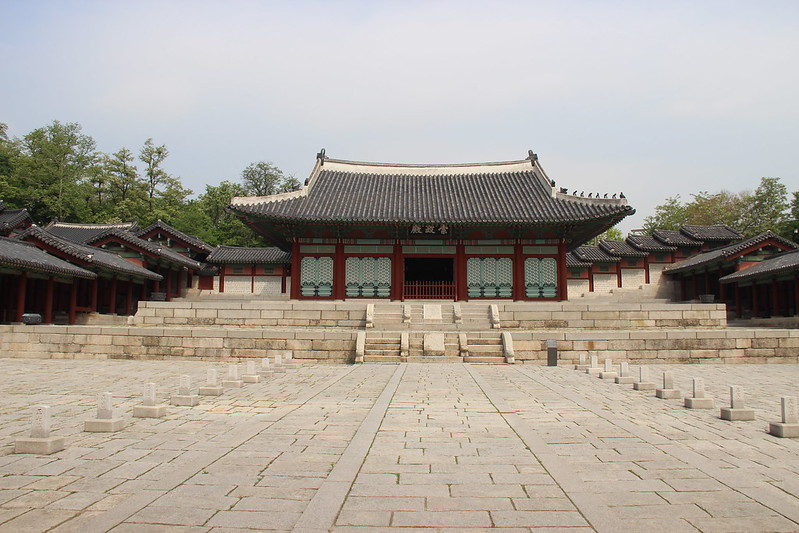
Gyeonghuigung Palace: Seoul’s Forgotten Royal Palace
Perhaps the most overlooked royal palace in Seoul, Gyeonghuigung Palace is the youngest palace and least visited. You’d be forgiven for missing it as you explore Seoul, as it’s not in the main tourist areas and is actually hidden behind the Seoul Museum of History and the impressive Heunghwamun Gate. The tall gate, with typically bright red pillars topped with wooden beams, painted green and gold, does a disservice to the palace by obscuring the palace that it is protecting.
Built in the 17 th Century, this palace acted as a secondary palace while Changdeokgung was the primary palace. Connected to Deoksugung Palace by a bridge, back when both palaces commanded a much larger presence in the city, this palace once had over 100 halls to house guests and royal events. Tragically, most of the palace was destroyed, and it wasn’t until the 1990s that the palace grounds started to be restored.
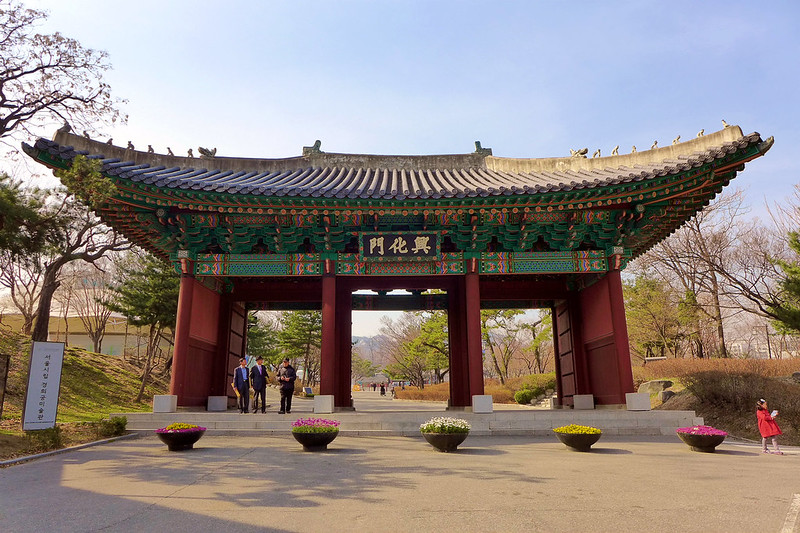
Compared to the other royal palaces in Seoul, this palace doesn’t feel as impressive, lacking tranquil ponds housing isolated pavilions or majestic natural beauty spread over large palace grounds. However, that’s not to say this palace doesn’t have its own appeal. Due to its lack of popularity, it’s less crowded, so visitors can explore peacefully. That’s especially appealing if you want to capture some scenic photos of royal Seoul without getting crowds of people in the frame.
The aforementioned Seoul Museum of History is a fascinating place to check out to learn more about Seoul’s history and covers local history from prehistoric times to modern day. The two places can be combined in an afternoon.
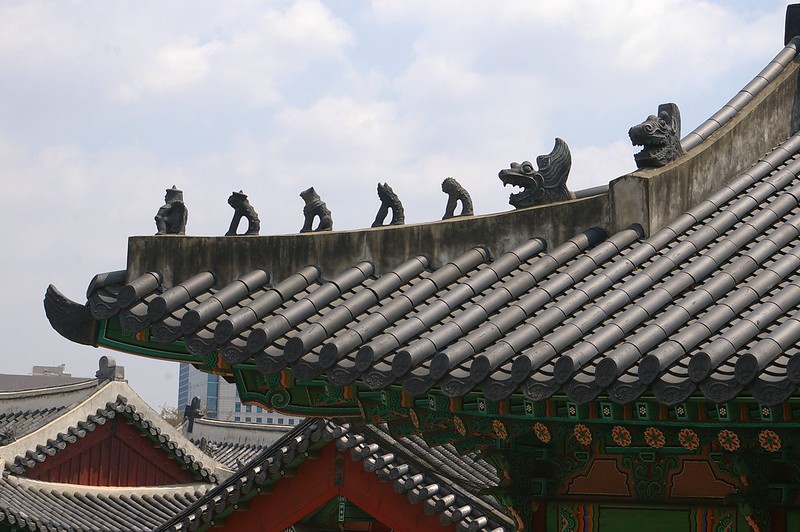
Take the subway to Seodaemun Station (Exit 4) or Gwanghwamun Station (Exit 7) and walk a short distance to get to the palace.
Opening Hours:
- Open every day 09:00-18:00
- Closed January 1st
- Free to enter
.jpg)
Here are a few tips to help you enjoy visiting the royal palaces in Seoul:
1: Take a tour
Walking tours inside the palace will take you around the palace while explaining the history and significance of each area.
2: Enter for free
You can enter the palaces for free on the last Wednesday of every month. This is known as Culture Day in Korea, and cultural attractions are free or discounted. You can also enter for free if you’re wearing Korean hanbok , which you can rent near to Gyeongbokgung Palace.
3: Buy a discounted palace pass
If you plan to visit all of the palaces while in Seoul, buy the Seoul Palace Combination Ticket. You can get entry to all of the palaces, as well as the Jongmyo Shrine for 10,000 KRW. The pass is valid for 3 months.
.jpg)
Changdeokgung Palace Seoul
4: Join a night tour
During the summer, there are limited night tours that show you the palace at night. These can be a good way to see unique sights that aren’t normally available.
5: Start early
Seoul’s royal palaces are popular tourist destinations and can be very busy, especially during spring and fall. Visit early to experience less crowded scenes and to give yourself plenty of time to explore at your own pace.
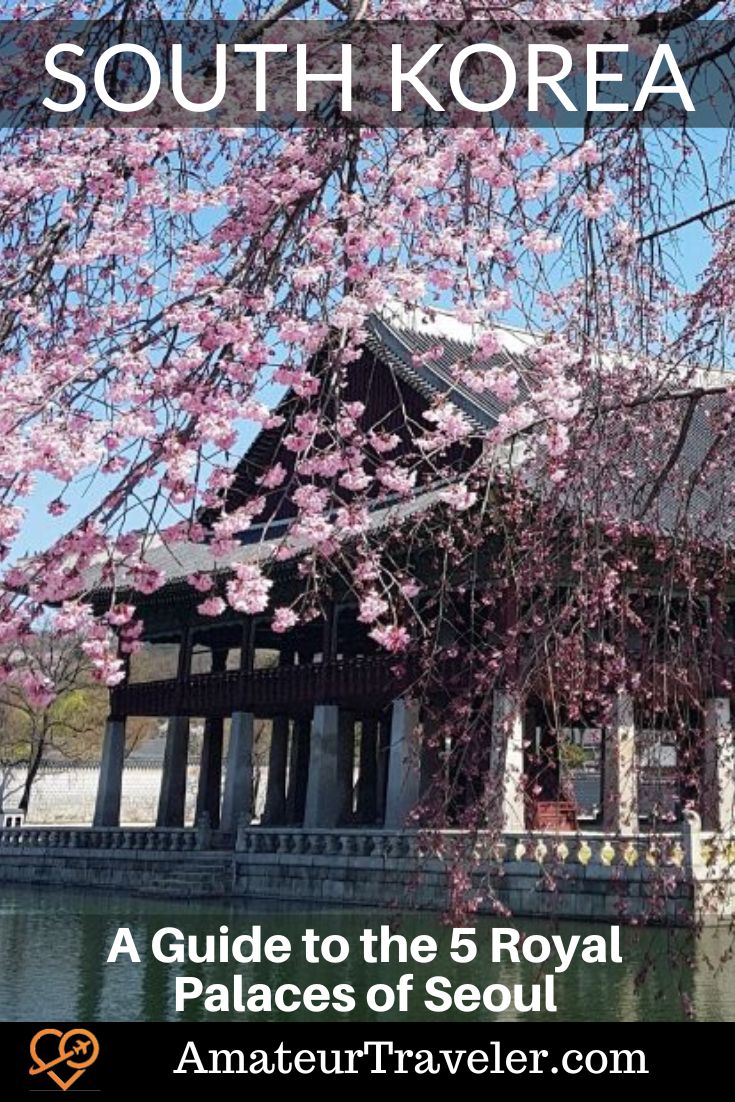
Related Posts
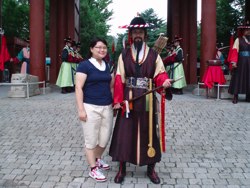
by Joel Marrinan
Leave a reply.
Name (must be a real name) (required)
Mail (will not be published) (required)
Tags: article , seoul , south korea

Guides / Resources
- Getting Started Traveling
- Guide to Round The World (RTW) Tickets
- 27 Websites for Booking Hotels and Alternate Accommodations
- First Time Cruise Tips – Planning a Cruise
- How to Start an Airbnb – Tips from an Airbnb Superhost
- Travel Resources – What I Pack
- Map of San Francisco by Neighborhood and What to See by Neighborhood
- Guide to the Monterey Peninsula
- Missions of California Map – All 21 California Missions from South to North

Sign up for our newsletter and get the eBook "How To Save Money Booking Your Travel Online"
World Regions

- BloggerBridge
- California Travel
- Episode Map
- Inside Chris's Head Blog
- My CafePress Store
- My Etsy Store
- The Bible Study Podcast
- Tourism Marketing Consulting
- Privacy Policy
- Amateur Traveler Media Kit
- Working with Amateur Traveler
- Pitch me a Podcast Episode
- Guest Post Guidelines
- Travel with Amateur Traveler group
- The Amateur Traveler Manifesto
- find me on BloggerBridge.com
Living and traveling in Korea

A Quick Guide To The Five Palaces Of Seoul
Did you know there are five main palaces in Seoul, Korea? Oh, and bonus, there’s a royal residence, too. When you begin to plan your trip to this vibrant city and realize there are five palaces of Seoul to see, that can be overwhelming for even the best of travel planners. Which of the Seoul palaces should you visit? Which of the palaces in Seoul is the grandest? Is there even a difference?
I’ve done full guides of all of the palaces, but with this Seoul palace quick guide, I’m going to break it down so you know which one is right for you. Honestly, if you have the time, see them all. But if not, here’s everything you need to know about the palaces of Seoul to plan your Seoul itinerary . If you need more help, definitely check out this Epic Travel Guide to Seoul for the First Timer .

The five palaces of Seoul, a royal residence, and what to know:
General Tips for Visiting the Palaces of Seoul
Gyeongbokgung palace (경복궁), changdeokgung palace (창덕궁), deoksugung palace (덕수궁), changgyeonggung palace (창경궁), gyeonghuigung palace (경희궁), unhyeongung royal residence (운현궁).
(This post contains affiliate links, which means I receive a certain percentage of a sale if you purchase after clicking at no cost to you. Thank you for your support.)

- Entry Fees: Most palaces have a small entry fee. Gyeonghuigung Palace is already free.
- Combination Ticket: If you plan to see the main palaces, look into getting the combination ticket which costs W10,000 and includes entrance to Gyeongbokgung Palace, Changdeokgung Palace, Changgyeonggung Palace, Deoksugung Palace, and Jongmyo Shrine . This pass is good for up to 3 months so is also beneficial to people that are living in Korea and plan to do a lot of touring in the next few months.
- On Culture Day: There is free entrance to all of the palaces on the last Wednesday of the month which is Culture Day in Korea.
- By Wearing Hanbok: There is free entrance to the palaces of Seoul if you are wearing a Hanbok. A Hanbok is a traditional Korean dress and not only tourists, but Koreans rent Hanboks too. They make for gorgeous photos.
- On Major Holidays: There is often free entrance to the main palaces of Seoul on major holidays like Chuseok, the Korean Thanksgiving, and Seollal, the Lunar New Year.

Where To Rent A Hanbok In Seoul: Everything To Know
- Dress Code: There’s no strict dress code, but respectful attire is appreciated.
- Cultural Etiquette: Be mindful of palace rules, such as not touching ancient structures and keeping noise levels down. Follow the signs posted and don’t step inside any of the buildings with signs telling you to keep out. If you are allowed to enter a room, there may be a sign to remove your shoes. Be mindful.
- Night Hours: At special times throughout the year, usually in the spring and autumn, you can visit Gyeongbokgung Palace at night as well as Changdeokgung Palace and Changgyeonggung Palace.

Ideal for: First time visitors and those with only time to see one palace in Seoul. History enthusiasts and those interested in Joseon Dynasty architecture will love this.
- Key Info: Gyeongbokgung Palace, built in 1395, is the largest and most famous of the five palaces. You could spend many hours here really, but at a minimum two to three is enough. It boasts the National Folk Museum and the National Palace Museum of Korea within its premises.
- Recommended Tour: To get the most out of your visit, take a guide, someone knowledgeable that can tell you all about the history and culture and what you’re looking at. Book this Gyeongbokgung Tour on Klook
- Address: 161 Sajik-ro, Jongno-gu, Seoul (서울특별시 종로구 사직로 161)
- Hours: January – February, November – December: 9:00am ~ 5:00pm; March – May, September – October: 10:00am ~ 6:00pm; June – August: 9:00am ~ 6:30pm
- Closed: Tuesdays
- Admission: Adults (19-24): W3,000
- Tours last 1 hour and limited to 30 people.
- Tour starts in front of Gyeongbokgung Palace Information Center inside the Heungnyemun Gate.
- Visit Duration: 3+ hours (If you plan to see the museums on the grounds as well, you could spend most of the day here.)
- The most popular and must-see of the palaces.
- Changing of the Guard Ceremony
- Substantial grounds and number of buildings. If you can only see one palace, this is THE one to see.
- Free guided tours available.
- Easily accessible from the subway.
- There can be major crowds in high season.
- Expansive grounds so you’ll be walking a lot. Wear good shoes.
- Not a quick visit. Plan to spend at least 3 hours there if you want to see everything.
- Changing Of The Guard Ceremony: 10:00am and 2:00pm (Duration: 20 minutes)
- Tips: Visit early in the morning to avoid crowds. When you head in, after seeing the main hall, go left to see the most popular views of the palace before walking back in the center to head back.
- Recommended Route: Gyeongbokgung Palace -> National Folk Museum of Korea -> National Museum of Korean Contemporary History (You can get an amazing view of Gyeongbokgung Palace from above from the rooftop observatory. Even if you don’t want to check out this museum, you can still go to the observatory for free.) -> Gwanghwamun Square -> Cheonggyecheon Stream -> HiKR Ground -> Gwangjang Market
For more information:

Gyeongbokgung Palace: A Step By Step Guide To Missing The Crowds + A Map

Ideal for: Nature lovers and photographers. This palace is said to be so beautiful in each season that you should visit it at least 4 times.
- Key Info: Changdeokgung, originally built in 1405 as a secondary palace to Gyeongbokgung served as the primary residence from the 1600s – 1800s. It is renowned for its beautiful secret garden, Huwon, which requires a separate guided tour to enter. This palace is a UNESCO World Heritage site, celebrated for its harmonious integration into the natural landscape.
- Address: 99 Yulgok-ro, Jongno-gu, Seoul (서울특별시 종로구 율곡로 99)
- Hours: February – May, September – October: 9:00am ~ 6:00pm; June – August: 9:00am ~ 6:30pm; November – January: 9:00am ~ 5:30pm
- Closed: Mondays
- Admission: Adults (19-24): W3,000; Youth (7-18): W1,500
- Palace Building Area: In English, every open day except Mondays: 10:15am and 1:15am.
- Secret Garden: In English, March – November: 10:30am, 11:30am, 2:30pm, 3:30pm; December – February: 10:30am, 11:30am, 2:30pm
- Visit Duration: 2-3 hours
- The most well-preserved palace in Seoul.
- The secret garden is a major feature and with limited ticket sales each day, not overrun.
- Tickets can sell out quickly during high season.
- Smaller palace grounds to visit if you take the garden tour. More focus on the garden than buildings.
- Tips: The secret garden tour is a must; book in advance during high season as slots fill up quickly. There are only a certain amount of tickets sold which keeps this palace much more peaceful even during high season.
- Recommended Route: Changdeokgung Palace and Secret Garden -> Bukchon Hanok Village

Changdeokgung Palace & The Secret Garden Everyone Is Talking About In Seoul

Ideal for: Art and culture aficionados. Smaller but no less beautiful changing of the guard ceremony and look at traditional Korean palace buildings as well as contemporary architectural buildings.
- Key Info: Deoksugung is unique for its blend of traditional Korean and Western architectural styles. It also houses the National Museum of Modern and Contemporary Art, Deoksugung branch. This was the home of the last king and second to last emperor of Korea, Gojong. Often hosting artistic exhibitions for a fun experience that combines art and culture.
- Recommended Tour: Join a night tour to Deoksugung on Klook .
- Address: 99 Sejong-daero, Jung-gu, Seoul (서울특별시 중구 세종대로 99)
- Hours: 9:00am ~ 9:00pm
- Admission: Adults (19-64): W1,000
- Visit Duration: 2 hours
- Interesting architecture that includes both traditional and historic as well as more contemporary.
- Often hosts artistic exhibitions.
- Smaller palace grounds to explore.
- Not a completely traditional complex so if that’s what you expect, another palace is a better choice.
- Changing Of The Guard Ceremony: 11:00am, 2:00pm, 3:30pm
- Tips: Don’t miss the stone-wall road outside the palace, which offers one of Seoul’s most picturesque walks, especially beautiful in autumn. This is also where you can find the Jeongdong Observatory to get a view of Deoksugung Palace from above.
- Recommended Route: Deoksugung Palace -> City Hall Building -> Myeongdong -> Ani Town -> N Seoul Tower

Deoksugung Palace: The Most Unique Palace In Seoul

Ideal for: Families and those looking for a peaceful escape. My personal favorite as it’s almost always quiet and yet has all of the traditional buildings and facades you’ll want to see.
- Key Info: Originally built as a summer palace, Changgyeonggung offers a more relaxed atmosphere. It has a large park and greenhouse as it was converted to a garden and zoo during the Japanese occupation. While it’s very peaceful now, this palace is most well-known for the death of Crown Prince Sado who was locked in a chest and starved to death over 8 days.
- Recommended Tour: Join this evening tour of Changgyeonggung Palace on Klook .
- Address: 185 Changgyeonggung-ro, Jongno-gu, Seoul (서울특별시 종로구 창경궁로 185)
- Admission: Adults (19-64): W1,000; Children (7-18): W500
- Free Guided Tours: In English, Every open day: 11:00am and 4:00pm
- Visit Duration: 2 hours.
- Much smaller crowds even in high season.
- Beautiful greenhouse on the grounds.
- Beautiful fall foliage and spring flower spot.
- Entrance is out of the way so not easily accessible from a subway station.
- 13 buildings to explore, but not as many as the main palace.
- Tips: Combine your visit with Changdeokgung as they are adjacent to each other and actually have a back entrance that connects the two palace grounds.
- Recommended Route: Changgyeonggung Palace -> Gwangjang Market -> Sewoon Sangga

Changgyeonggung: The Hidden Palace In Seoul

Ideal for: Those looking to explore off the beaten path or see as many free things in the city.
- Key Info: Gyeonghuigung is the smallest of the five palaces and was once linked to Deoksugung Palace. Originally built in the 1600s, it was originally much larger than what you can see today. Only about a third of the palace has been rebuilt from what it was in its heyday. It’s less crowded, offering a more tranquil experience.
- Address: 45 Saemunan-ro, Jongno-gu, Seoul (서울특별시 종로구 새문안로 45)
- Hours: Tuesday – Sunday: 9:00am ~ 6:00pm
- Admission: Free
- Visit Duration: 1 hour
- Free admission.
- Rarely if ever crowded.
- Not a substantial number of buildings left of the complex.
- Tips: Perfect for a quick, peaceful stroll amidst historical surroundings.
- Recommended Route: Gyeonghuigung Palace -> Seoul Museum of History -> Gwanghwamun Square

Gyeonghuigung Palace: The Smallest Palace In Seoul

Ideal for: Those wanting to see a different side of royal life. It often hosts cultural events and exhibitions during major Korean holidays.
- Key Info: What’s most striking is that the buildings in this complex are not painted the many colors of the other palaces. It’s a well-known location for Korean families to take photos with their children to celebrate their first 100 days, or dol , and other major events.
- Address: 464 Samil-daero, Jongno-gu, Seoul (서울특별시 종로구 삼일대로 464)
- Hours: April – October: 9:00am ~ 7:00pm; November – March: 9:00am ~ 6:00pm
- Unique, though smaller buildings.
- Hosts a lot of cultural events for traditional Korean holidays.
- Tips: At Unhyeongung Palace they have a very budget-friendly Hanbok rental spot just inside the entrance. If you don’t want to rent Hanboks for many hours, you can rent them for just a half hour while you’re here to take beautiful photos and then leave them before you go.
- Recommended Route: Unhyeongung Palace -> Ikseon-dong -> Tapgol Park -> Insadong -> Seoul Museum of Craft Art

You May Also Like

The Hangang Parks: A Guide To The 11 Han River Parks In Seoul, Korea

Why you shouldn’t just walk by Seoul City Hall

A List Of Art Museums In Seoul That Will Inspire You
Leave a reply cancel reply.
Your email address will not be published. Required fields are marked *
Sign me up for the weekly updates newsletter!
This site uses Akismet to reduce spam. Learn how your comment data is processed .
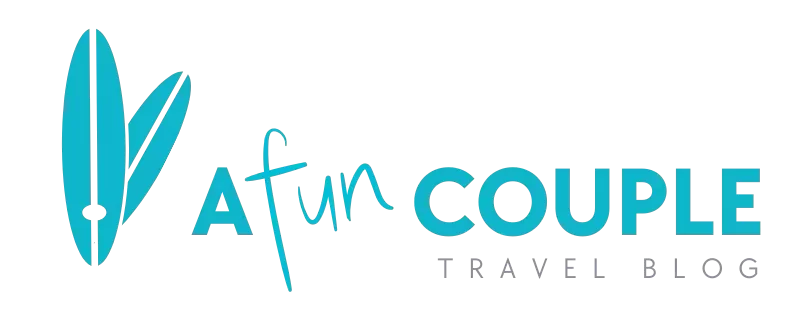
GUIDE TO THE 5 GRAND PALACES IN SEOUL
Visiting the five grand palaces in Seoul is a fantastic way to immerse yourself in the rich history and cultural heritage of South Korea.
Each palace has its unique charm, architecture, and historical significance. Here’s a brief overview of what each palace offers:
Gyeongbokgung , Changdeokgung , Changgyeonggung , Deoksugung , and Gyeonghuigung. are the 5 Grand Palaces of Seoul.
This post is the perfect guide if you are visiting Seoul and intend to explore 1, a few, or all of the 5 Grand Palaces during your time in South Korea .
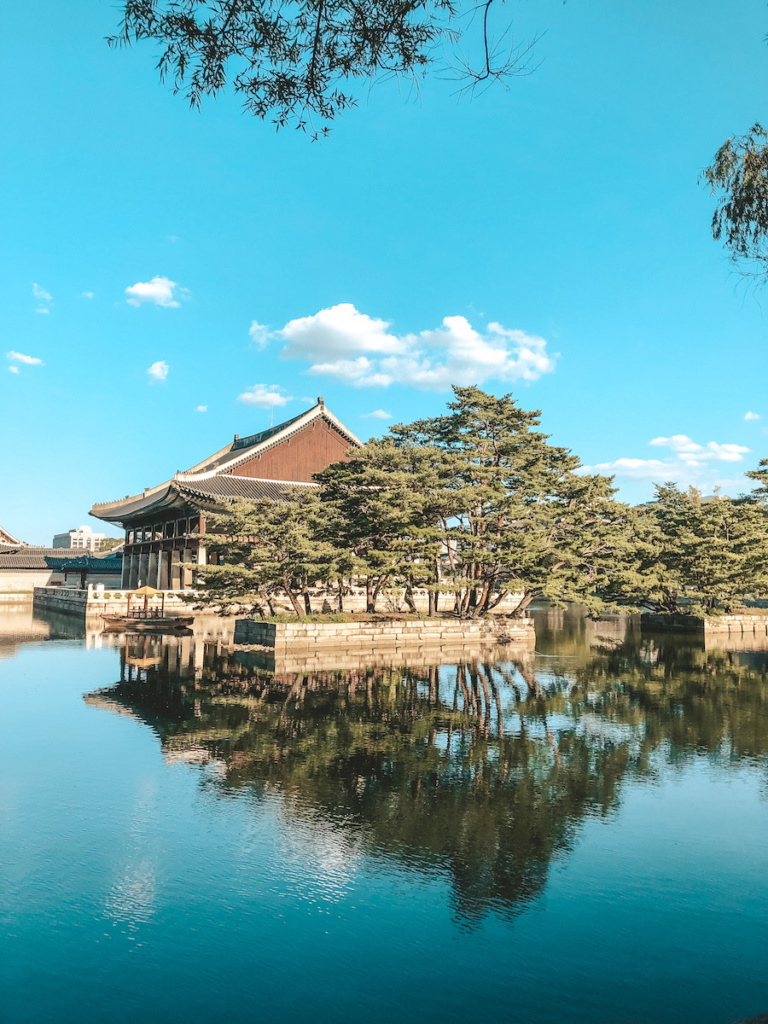
Highlights about the 5 Grand Palaces in Seoul:
– The 5 Grand Palaces in Seoul were originally built several hundred years ago. – These palaces have similar architectures (which we will explain in the last part of this post) but each of them is unique and presents its own charm. – These palaces are a great way to remember the triumphs and falls of the Kings during the Joseong Dynasty.
For each palace, we will provide more explanation about the history and interesting facts and figures. We hope that you will enjoy the read and that you will find it useful.
The 5 Grand Palaces in Seoul
1. gyeongbokgung (경복궁) – the main palace.
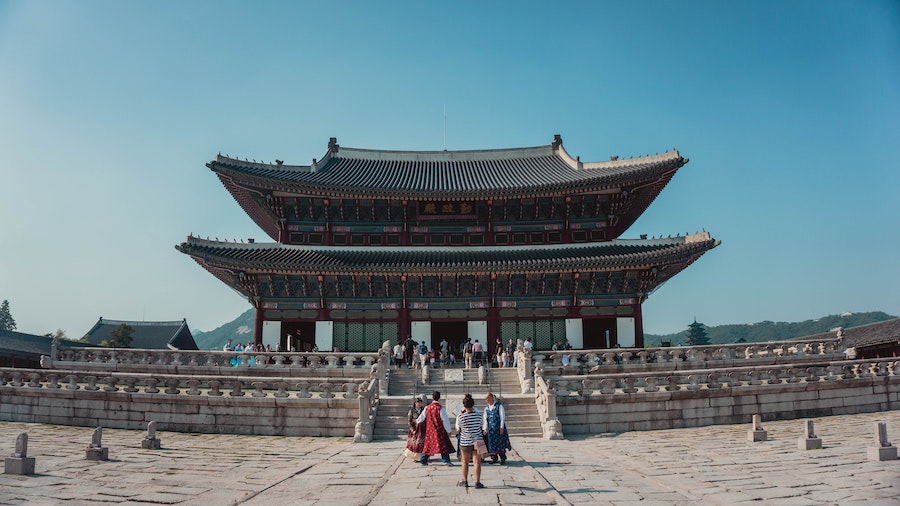
If your time is limited and you can only visit 1 palace, we recommend Gyeongbokgung. You can’t miss it, as its main gate is located at the end of Gwanghwamun (광화문) Square (the main square of Seoul). Gwanghwamun Square is like the Champs Elysees of Paris, in a way.
In Gyeongbokgung Royal Palace it is also there where you can experience the change of guards every day. More about this later…
The Gyeongbokgung Royal Palace was the first palace built during the Joseon Dynasty by King Taejo. Completed in 1395, the palace was continuously enlarged during the reigns of King Taejong and Sejong the Great. However, Gyeongbokgung was destroyed by a fire during Japan’s invasion of Korea (1592 ~ 1598). It was not until 1867 that the site was rebuilt to bring it back to life.
Unfortunately, during the Japanese occupation (1910-1945), 80% of the restored buildings were again dismantled, the main gate was removed, and a huge Japanese government building was constructed opposite the main palace area. Since 1990, the restoration of the palace has been underway. Finally, in 2010, the great main gate of the palace was able to regain its original place in front of Gwanghwamun Square. A magical sight, really!
You can check out our full post about Gyeongbokgung here.
What to see in Gyeongbokgung Palace?
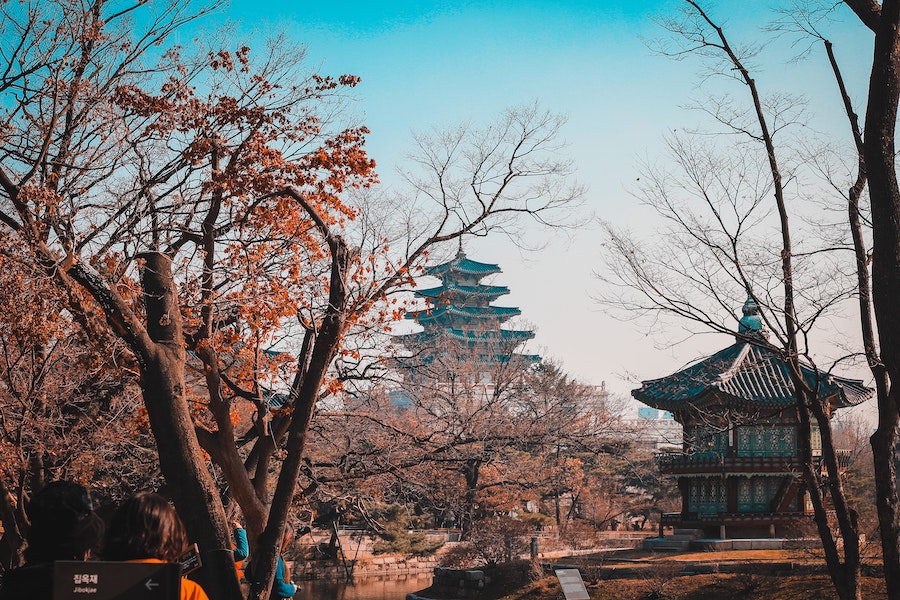
As you enter Gyeongbokgung Palace through Gwanghwamun Entrance, you can see the Geunjeongjeon Building, the center of the palace but also the largest wooden building in Korea. This building was the place of the king’s throne and housed important events related to the politics of the kingdom.
To the left of the geunjeongjeon building, visitors can admire the Gyeonghoeru pavilion which once served as a reception hall. This two-story pavilion was built over an artificial pond and is one of the structures not to be missed in the palace.
Out of the 5 Grand Palaces, Gyeongbokgung is considered the most beautiful of all. It serves as the backdrop for many movies, series, and TV shows.
Additionally, there are many other activities around Gyeongbokgung. Make sure to attend the change of guards every day at 10 a.m. and 2 p.m. inside the place. A similar ceremony takes place at the Gwanghwamun gate, at 11 a.m. and 1 p.m. It is the perfect opportunity to admire the parade of guards in traditional costumes full of bright colors.
There are 2 museums located inside the walls of the Palace. The National Folk Museum of Korea (국립민속박물관) displays historical artifacts that were used in the daily lives of Koreans in the past.
The 2nd Museum is The National Palace Museum of Korea. This museum showcases 500 years of history with roughly 45,000 artifacts from the Joseon Dynasty including texts and poems that were handwritten by kings of the past, robes worn by royalty, jewelry, and other items from the royal courts of Korea. Both museums are free.
Our opinion about Gyeongbokgung Palace

For us Gyeongbokgung Palace, felt a bit like the forbidden city in Beijing. A huge palace surrounded by tall walls at the center of the city.
Overall Gyeongbokgung Palace is very impressive from the entrance at Gwanghwamun Gate to the Gyeonghoeru pavilion and some of the museums, this is one of the most impressive places to visit in Seoul .
Although Gyeongbokgung Palace is supposed to be the main palace out of the 5 Grand Palaces in Seoul, it isn’t actually our favorite one… Keep reading to find out which one is our favorite 🙂
Important information
- Address : 161, Sajik-ro, Jongno-gu, Seoul (서울특별시 종로구 사직로 161)
- Opening hours: March-May, September-October 09:00-18:00 / June-August 09:00-18:30 / November-February 09:00-17:00 (closed Tuesdays)
- Admission: Adults 3,000 won / Children 1,500 won
- Hanbok rental : like for any palaces in Seoul, if you rent a Hanbok you can enter for free. You can rent a Hanbok with a discount here.
- Website : www.royalpalace.go.kr
- National Palace Museum : here
- National Folk Museum of Korea : here
- Full post: here
How to get there?
Walk approx. 4 min from Gyeongbokgung Station (Seoul Subway Line 3), Exit 5
2. Changgyeonggung (창경궁) the most romantic one
Changgyeonggung palace wasn’t built during the Joseon dynasty but during the Goryeo dynasty. Indeed the site of this palace was used as early as 1104 by King Sukjong. This is why this palace has a special feature. Its throne room faces east, not south as it would be during the Joseon dynasty.
The Myeongjeongjeon Pavilion (명 졍전) is now the oldest throne room in South Korea. It has been designated a national treasure.
The founder of the Joseon dynasty, King Taejo, decides two years after founding the dynasty to make Seoul the capital of the kingdom. While waiting for the construction of the Gyeongbuk Palace to be completed, the king decided to stay at the location of the present Changgyeongung Palace.
In 1418, his son, King Sejong, built Changgyeongung Palace for his father who had just abdicated in his favor. In 1484, King Seongjong (1469-1494) extended the Palace, and this building was intended to accommodate King Sejo’s widows. It was then that he took the name of Changgyeongung.
However, in 1592, the Japanese invasion did not spare this Palace either and it was completely burnt and then rebuilt in 1616. But it was once again destroyed in an accidental fire in 1830, most of the buildings were destroyed, only the central building, the Myeongjeongjeon, remained. It was again rebuilt identically in 1834.
During the Japanese occupation, the palace was transformed into a museum, zoo, and botanical garden, and in 1911 it lost its title and was renamed Changgyeongwon, in other words, Changgyeong gardens (in the word Changgyeonggung, the syllable gung means “palace”).
From 1983 to 1986 the palace was completely restored, the zoo moved and Changgyeong regained its status as a palace and its name: Changgyeonggung.
What to see in Changgyeonggung?

Changgyeonggung is not as big as the other palace and less touristy, but it is actually our favorite one! We visited the Palace during spring to see the beautiful cherry blossoms.
This palace is different to the others as there is a big space devoted to the daily life of the family which is much larger than the space devoted to political affairs. The site thus contains many more personal stories about the royal family, love and hatred between the king and the prince or even the tensions between the queen and the servants of the court.
First visit Honghwamun (홍화문) the meeting place between the king and the people. This is the main entrance gate. Then head to Myeongjeongmun gate (명 정문) after crossing the Okchongyo Bridge (옥천교), After passing through the two doors, enter the courtyard and you can see the oldest throne room in Korea: Myeongjeongjeon (명정전).
During your stroll, you might come across the Sungmundang building (숭문 당): it was mainly used as a study room by the king and it is also a place where he discussed political affairs with his high officials.
The best part of Changgyeonggung:

Now that you visited some of the main buildings, it is time to visit the best part of this Palace.
Climb the hill behind the buildings of the Palace and enjoy the gorgeous view of Changgyeonggung . After reaching the hill by the stairs continue your visit north through the forest.
As you continue your walk, you can discover a large and beautiful pond, called Chundangji. Originally, the large pond was a place where there was a rice field maintained by kings. However, in 1909, the Japanese built a pond there. Do not hesitate to take a break and sit on the benches near the pond and think about how the kings lived during their era.
After taking a rest at the pond, continue your visit to Daeonsil (대 온실): a greenhouse within Changgyeonggung Palace. In 1909, the Japanese also built a botanical garden within the palace. Daeonsil has undergone restoration work and reopened to the public in November 2017. You can discover several species and varieties of plants.
Our opinion on Changgyeonggung Palace

Changgyeonggung Palace is our favorite Palace in Seoul. On our first trip, it was the first palace we visited and we both kept fond memories of our visit. Compared for example to Gyeongbokgung, the palace has fewer visitors, so it is always more pleasant to walk around. In addition, there is a very nice walking trail which is part of the palace.
If you have any questions about Changgyeonggung, don’t hesitate to ask us! And for people who have visited the palace before, let us know about your experience in the comments!
The other good part about Changgyeonggung Palace, is that it is linked with the 3rd Grand Palace called Changdeokgung (창덕궁). You will need to pay an extra fee though.
Check out our full post on Changgyeonggun here
- Address : 185, Changgyeonggung-ro, Jongno-gu, Seoul (서울특별시 종로구 창경궁로 185)
- Opening hours: 09:00-21:00
- Admission: Adults 1,000 won / Children 500 wo
- Website : cgg.cha.go.kr
How to get there
Walk approx. 15 min from Hyehwa Station (Seoul Subway Line 4), Exit 4
3. Changdeokgung (창덕궁) the one with a secret garden

This Eastern Palace of Seoul or “Palace of Prosperity” was built during the Joseon dynasty from 1405 to 1412 during the reign of King Taejong. Its main gate is called Donwhamun (돈화문).
This palace was the favorite palace of many kings of the Joseon Dynasty, indeed it exhibits several characteristics specific to the Three Kingdoms of Korea that no longer appear in the architecture of Gyeongbokgung. For example, the buildings of Changdeokgung blends perfectly with the surrounding and original landscape. Other palaces would rather impose themselves on top of the landscape.
After its construction during the reign of Taejong, King Sejo had it enlarged by several hundred thousand square meters. However, it was destroyed like the other Palaces during the Japanese invasion in 1592 and then rebuilt in 1609 by Kings Sonjo and Kwanghaegun. In 1623 it was destroyed again by fire following the revolt against Kwanghaegun.
However, despite its successive reconstructions, it remained faithful to the initial design.
This palace was the seat of the court and the seat of government until 1872. The last king of Korea, Sunjong, lived there until his death in 1926.
What to see in Changdeokgung?
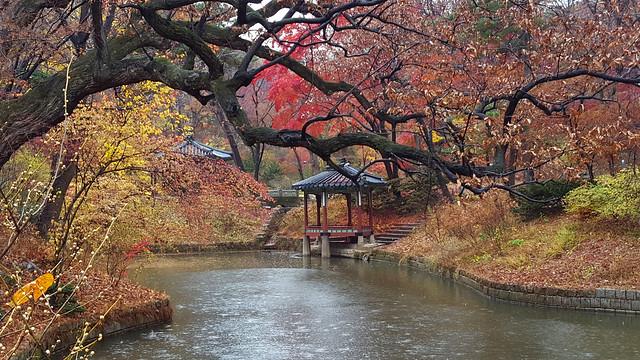
Surrounded by mountains and hills the site offers a beautiful harmony between nature and buildings and was once a privileged resort for the kings of Joseon and their subjects.
The main sight of Changdeokgung, is the Huwon Garden, also called Secret Garden. It is possible to freely visit the Injeongjeon and Nakseonjae pavilions within Changdeokgung Palace while the Huwon Garden can be visited by booking in advance with a guide. Reservations can be made online or directly on-site.
Additionally, visitors can enjoy a palace tour, titled ‘Changdeokgung by Moonlight’, during fall and spring from Donhwamun Gate. We highly recommend this tour by the way. It is absolutely magical to visit the temple at night.
Our opinion on Changdeokgung
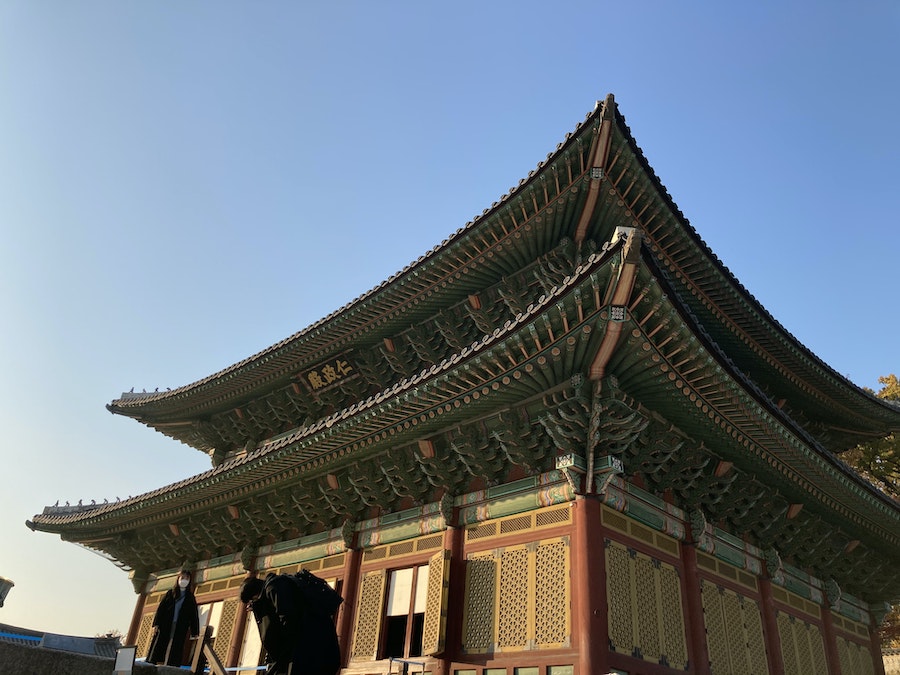
Changdeokgung Palace feels like a peace haven in the heart of the busy Seoul. With its beautiful buildings and magnificent gardens.it is one of the 5 Grand Palaces of Seoul. This palace entered the UNESCO World Heritage List in 1997.
Since Changdeokgung and Changgyeonggung Palace are connected through a gate inside the place, we recommend combining the visit of both Palaces on the same day. For a break, there is a cafe in Changdeokgung’s garden.
- Address : 99, Yulgok-ro, Jongno-gu, Seoul (서울특별시 종로구 율곡로 99)
- Opening hours: ebruary-May, September-October 09:00-18:00 / June-August 09:00-18:30 / November-January 09:00-17:30 (*Closed Mondays)
- Admission: Adults 3,000 won / Children 1,500 won
- Secret Garden (Huwon Tour) : Huwon tour: Adults & senior citizens 5,000won / Children 2,500 won
- Hanbok Rental: here
- Website : www.cdg.go.kr
Walk approx. 5 min from Anguk Station (Seoul Subway Line 3), Exit 3
Read the full post about Changdeokgung here.
4. Deoksugung (덕수궁) the most westernized

Originally called Gyeongungung, Deoksugung Palace was the second most used palace by kings during the Joseon dynasty. The palace was first used as a temporary palace by the 14th King of Joseon (Seonjo) during Japan’s invasion of Korea.
It was not until the reign of the 26th King of Joseon (King Gojong) that the palace became a royal palace. The palace changed its name following the dismissal of King Gojong for the throne of Sunjong, the last king of the Joseon dynasty.
Like the other four royal palaces of the Joseon dynasty, Deoksugung Palace was heavily and intentionally destroyed during the Japanese occupation, currently only a third of the buildings remain as compared to the period prior to the Japanese occupation.
Less imposing in size than the first three palaces, it is the smallest of Seoul’s five palaces. However, Deoksugung has the significant advantage of being able to be visited in the evening. There is surely nothing more beautiful than seeing these buildings from ancient times illuminated.
Located right next to Ciy Hall, Deoksugung Palace has the distinction of having both typical buildings from the Joseon era and structures dating from the first half of the 20th century, in a European style.
What to see in Deoksugung?

The Jeonggwanheon Pavilion owes its form to an architect of Russian origin and offers a subtle blend of Western and Korean style. Its name means ‘a space to silently contemplate the world’. This is a place frequented by the king when he was concerned for the safety of his kingdom.
Seokjojeon is the most remarkable western-style building constructed during the Joseon dynasty in 1910. It consists of a basement floor which was used for court valets, a ground floor for official business, and a second floor for the daily life of the royal family. It is now possible to freely visit the underground space, while the upper floors can be visited by reservation only (on the internet).
The changing of the guard ceremony takes place every day at 10 a.m., 2 p.m. and 3:30 p.m., in front of the Deoksugung (Daehanmun) Great Gate.
It is also possible to participate in a guided tour. There are two a day, one at 10:45 am and the other at 1:30 pm.
Our opinion on Deoksugung

Deoksugung is not as impressive as the other ones. However, we really loved visiting the Palace at night. Right in the middle of the Illuminated Palace, your will be surrounding by tall buildings from the citiy outside the gate. The contrast is absolutely stunning. We recommend a visit to Deoksugung at night. After the visit of the Palace, turn right when going out. There is a very charming street along the wall of Deoksugung. This place if very popular for instragrammers.
Check out our full post about Deoksugung Palace here .
- Address :99, Sejong-daero, Jung-gu, Seoul (서울특별시 중구 세종대로 99)
- Opening hours: 09:00-21:00 (*Closed Mondays)
- Admission: Adults 1,000 won / Children 500 won
- Website : www.deoksugung.go.kr
Walk approx. 5 min from City Hall Station (Seoul Subway Line 1, 2), Exit 1
5. Gyeonghuigung (경희궁), the youngest

Fifth and final, Gyeonghuigung Palace is the most recent of Seoul Grand Palaces. Built at the very beginning of the 17th century as the king’s second home, the Japanese used the place for a school, before eventually destroying it completely in the 20th century. The current construction is therefore not the original one, but a more modern and smaller one. It did not reopen its doors to the public until 2002.
Attached to Gyeonghuigung Palace is the Seoul Museum of History. Opened for the first time in 1985, it allows you to trace the entire history of the construction of the capital to the present day. The visit is free.
What to see in Gyeonghuigung?

After passing through the Sungjeongmun Gate (정문 정문), rebuilt in 1988, one faces directly the main palace building called Sungjeongjeon. This is the most important and grand hall in Gyeonghuigung Palace.
Sungjeongmun houses the king’s throne. Indeed, it is here that the king met the high officials. In addition, this is where official ceremonies were held.
During Japanese colonization, Sungjeongjeon was sold and then moved. Nowadays, it is located at Dongguk University and is used as a Buddhist temple under the name Jeonggakwon (정각원). This building could not be moved back into the palace because it was too complicated to do. So if you want to see the original building, you will have to go to the university. The building we see now at the palace is a reconstruction from 1985.
Then head to Jajeongjeon (자 정전). It was a personal space for the king and it was also in this building that the king discussed the affairs of the country with his subjects. It also served as a venue for academic competitions.
Finally, Heungwamun (흥화문) is the main gate of Gyeonghuigung Palace. During Japanese colonization, this door was first moved to a temple and later it was used as the main entrance to the Silla Hotel. However, in 1988 the gate was moved back into the palace.
Our opinion on Gyeonghuigung

It was a very nice visit, where we stayed a little less than 1 hour. We really like this palace. First of all for its beautiful architecture and especially for its peaceful aspect. We also recommend a visit to the Seoul History Museum which is right next to the palace. Also, out of the 5 palaces, this one is completely free.
- Address :서울 특별시 종로구 신문 로 2 가 1-2
- Opening hours: 9: 00-18: 00. Weekends and holidays: 10: 00-18: 00.
- Admission: Free
Getting there by subway: Stop at Seodaemun station (line 5) and take exit 4. Then walk straight for about 8 minutes. You can also stop at Gwanghwamun station (line 5) and take exit 7. You will then have to walk a bit more.
Other useful information for visiting Seoul Palaces
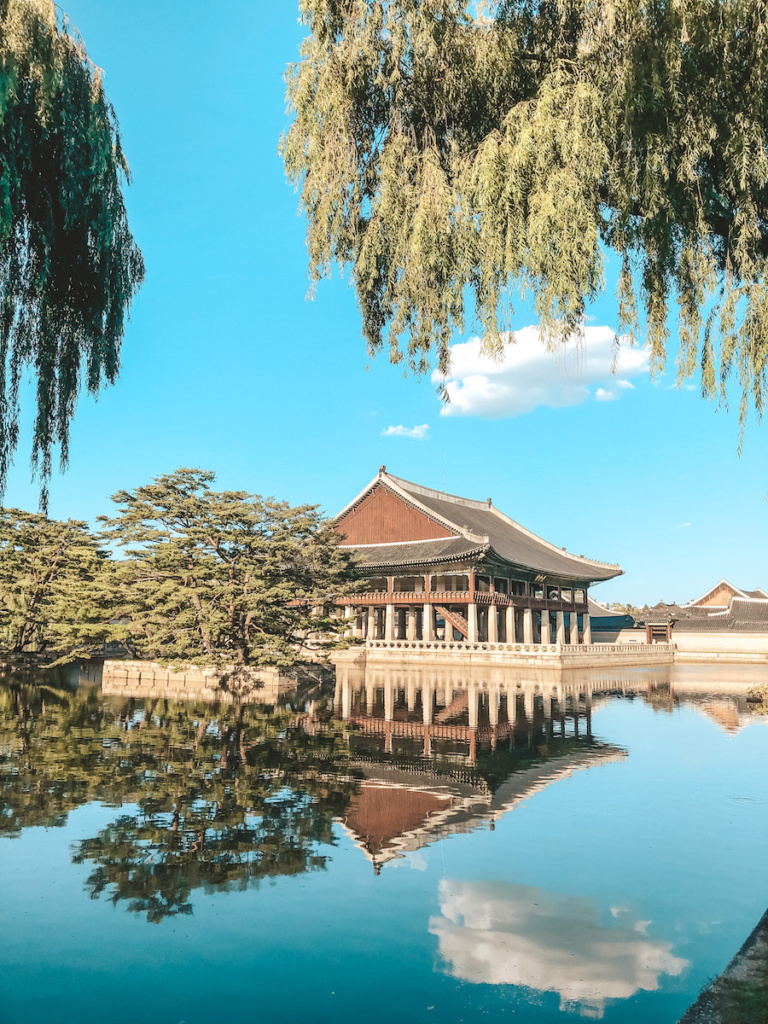
To make the most of these five palaces, the city of Seoul has implemented a pass. This is a small notebook with tear-off coupons. To purchase it, simply go to the cash desk at one of these five locations and request a Combination ticket for palaces. It is 10,000 won (5,000 won for adolescent and child fare). Which is cheaper than paying for each visit. This pass is valid for three months.
Guided tour
Another tip: visit the Seoul Palace with a cultural guide. Indeed, nothing better than visiting a palace with a specialist. These tours are free and available in several languages (Korean, English, Chinese, Japanese). Just ask the front desk or check online for free tours.
Night visit
Gyeongbokgung , Changdeokgung and Changgyeonggung Palaces offer night tours every year until 10 p.m. Check their respective website for more information.
Rent a Hanbok
You get a free entrance if you wear a Hanbok when entering Seoul Palaces. Besides skipping the admission fee, renting a Hanbok is a really fun thing to do in Seoul. Take plenty of memorable pictures with your hanbok. You can book them here and collect them in the shop before your visit.
All you need to know about the architecture of Seoul 5 Grand Palaces
These palaces are built according to an identical scheme:
Naejeon (내전)
Naejeon is a space dedicated to the life of the royal family: composed of the king’s private room, the jajeongjeon (자 정전), a main sungjeongjeon (숭정전), and the taeryeongjeon (태령 전). A junggung space (중궁) corresponding to the Queen’s residence. Donggung space (동궁) which is the residence of the servants
Woejeon (외전)
A woejeon is the space for official business. The woejeon consists of a main jeongjeon building (정전), an office for the peonjeon king (펀전), a building for the affairs of the king’s subjects, etc. In this space is also the throne room, geunjeongjeon (근정전) where the king granted official audiences and welcomed foreign ambassadors and emissaries. The sajeongjeon hall (사정전) was the seat of the royal executive.
The pumgyeseok (품계석)

During the Joseon dynasty, the government had 18 different highly hierarchical ranks. Therefore, in front of the jeongjeon buildings, one can find two rows of standing stones, called pumgyeseok (품계석) indicating where court officials stood, according to their rank, during events at the palace. Two royal guards were seated to the right and left of the jeongjeon building.
The dancheong (단청)
The paintings that you will see frequently are the dancheong (단청). These are the patterns depicted on the wood of buildings, in five colors (blue, red, yellow, white, and black). Their function was to protect the building against insects and squalls of rain. While patterns may have a significantly different meaning from palace to palace, they generally symbolize protection against spirits and fires.
And now you know everything about the structure of Seoul 5 Grand Palaces.
In conclusion about Seoul Grand Palaces

So do you know how to pronounce any of the Seoul 5 Grand Palaces’ names yet? No?? Don’t worry, even after 3 years we still struggle to pronounce any of the palaces’ names. Being lost in translation is part of the fun when living in Korea.
It is complicated to discover them all in one stay. We recommend that you choose one or two from the ones that interest you the most.
If your time is really limited, then our recommendation is to pick Gyeongbokgung . If you do have a bit more time then combining Changgyeonggung and Changdeokgung would be our recommendation, as those 2 are our favorite ones.
Finally, be aware that if you wear a hanbok at the time of your visit, all the palaces in Seoul will be free!
We lived in Seoul for 3 years and loved exploring all these beautiful places in Korea. There are many posts about Korea in this blog, you can find them all here .
HAPPY TRAVEL !
Links to related articles
- CHANGGYEONGGUNG our favorite palace in Seoul
- GYEONGBOKGUNG PALACE : the biggest of all
- DEOKSUGUNG PALACE
- BEST DAY TRIPS FROM SEOUL : escape the city for a day
- AWESOME ADVENTURES near Seoul
- GANGNEUNG : a gorgeous place on the east coast of Korea
- SOUTH KOREA : some of the most amazing things to do in South Korea
- SEOUL : best things to do in the capital
- WEATHER : best time to visit Seoul
- JEJU : the best island escape from Seoul
We are Hammer and Guillaume, a fun couple traveling the world. We will take you to some of the most amazing places on earth. Hammer is a yoga instructor and Guillaume a true water baby, enjoying all kinds of water sports. Follow-us to get the latest update about our travels.
Similar Posts
![seoul palace visit MOSSY FOREST IN CAMERON HIGHLANDS [HIKING GUIDE]](https://afuncouple.com/wp-content/uploads/2023/11/Mossy-Forest-in-Cameron-Highlands-7-768x512.webp)
MOSSY FOREST IN CAMERON HIGHLANDS [HIKING GUIDE]
The Mossy Forest gets its name from the thick layer of moss that blankets the forest. It is one of the best things to do in Cameron Highlands
![seoul palace visit 10 BEST BEACH CLUBS AROUND CANGGU & SEMINYAK [BALI]](https://afuncouple.com/wp-content/uploads/2023/07/Best-things-to-do-in-Seminyak-5-768x432.webp)
10 BEST BEACH CLUBS AROUND CANGGU & SEMINYAK [BALI]
Known for their breathtaking ocean views, luxury amenities, and great atmosphere, Bali beach clubs offer the ultimate experience!
![seoul palace visit HAEUNDAE BEACH IN BUSAN – BEST THINGS TO DO [KOREA]](https://afuncouple.com/wp-content/uploads/2021/07/Haeundae-Beach-Busan-05-768x575.jpg)
HAEUNDAE BEACH IN BUSAN – BEST THINGS TO DO [KOREA]
Haeundae Beach in Busan is South Korea’s most famous beach. A trip to Busan without visiting Haeundae wouldn’t be complete. Full guide here!

GUIDE TO HAEDONG YONGGUNGSA TEMPLE IN BUSAN
If there is one temple to visit in Busan, it is without a doubt Haedong Yonggungsa. Its location right by the sea makes it unique. Full guide
![seoul palace visit 30 AWESOME THINGS TO DO IN BUSAN [KOREA GUIDE]](https://afuncouple.com/wp-content/uploads/2021/07/Busan-04.jpg)
30 AWESOME THINGS TO DO IN BUSAN [KOREA GUIDE]
Busan is the second largest city in South Korea. Plan at least 3 days to visit this beautiful coastal city. Full guide here about Busan.

20 MOVIES THAT WILL MAKE YOU WANT TO TRAVEL TO ASIA
Dreaming about your next destination? Thinking about Asia? Why not watch any of these great movies about Asia?
Leave a Reply Cancel reply
Your email address will not be published. Required fields are marked *

Zen Moments in Korea
Visiting the Five Palaces in Seoul

No visit to South Korea should skip the Five Royal Palaces in Seoul. Of course, if you only have 3 days or even 4 days in Seoul , you might find it hard to visit all the palaces, you might want to know beforehand which one to choose.
This comprehensive guide will help you make the best choice, introduce you to a short history of each palace, show you some pictures and allow you to make your perfect itinerary.
While all palaces are relatively close to one another, it might get challenging to visit all in one day or even a short stay.

This post contains affiliate links. This means if you click on the link and purchase the item, I will receive an affiliate commission at no additional cost to you. Read more about it on our disclosure page here .
A map and useful information

As you can see from the map, the 6 palaces are relatively close to one another, all set in Seoul’s city center. If you are passionate about history or simply want to learn about South Korea’s past, choose to step inside a few of the palaces.
Entrance fees aren’t too high, and if you choose to wear a hanbok you will have free admission.
Seoul City Pass is another option for when you won’t be traveling outside of the capital city and want to see the palaces. It offers free unlimited transportation for 24, 48, or 72-hour, along with free entry to 40+ attractions and discounts to over 60 attractions, including the most important palaces.
The best time to visit the palaces is during spring or fall because that’s when you will have the chance to take beautiful pictures. However, the other seasons are nice as well, even though winter gets really cold, and summer hot and humid.
Where is the best area to stay when you want to visit the palaces? Anywhere in the city center is a great option: Jongno-Gu , Myengdong , Insadong , but also Hongdae .
Gyeongbokgung Palace
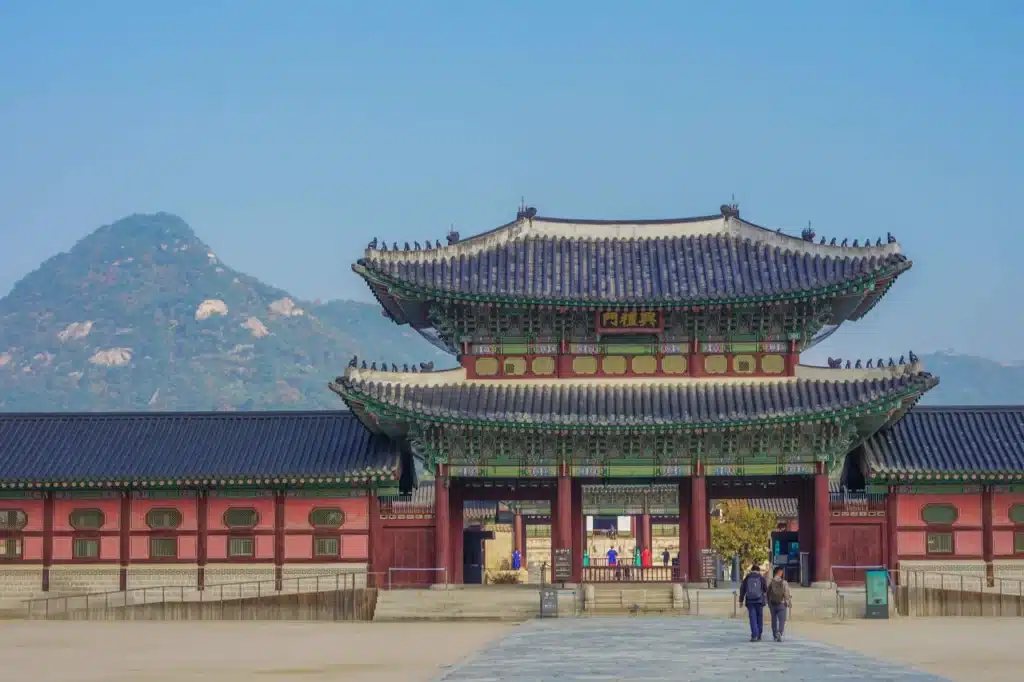
Unlike the Cantonese Chinese names that I easily memorized when we lived in Hong Kong, I had difficulties learning the Korean ones after moving to Seoul. And inevitably, Gyeongbokgung was one of the first place names I came across. However, once I realized that the names are a combination of words, things got a lot easier.
‘Gyeong’ can mean Brilliance, Honor, Respect. In Sino-Korean could also mean ‘Capital City. ‘Bok’ usually means Fortune, while ‘Gung’ means Palace. So by naming it Gyeongbok, the government expressed its desire for a bright future.
Constructed in 1395 AD by the first Joseon king, Taejo, its name was devised by an influential minister called Jeong Dojeon. It was the kingdom’s main palace complex, housing the royal household and most of the government.
Unfortunately, the palace was destroyed during the 1592 – 1598 Japanese invasion of Korea. There are conflicting accounts of the events.
Some sources state that Gyeongbokgung was set ablaze by locals, enraged by the King’s actions: he fled the capital to escape the advancing Japanese, leaving its inhabitants to the conquerers’ mercy.

Other sources seem to indicate Japanese responsibility for the destruction. Ozeki, one of the Japanese commanders, described arriving at the now-abandoned palace in his diary and noted its amazing beauty. Ozeki’s account implies that Gyeongbok wasn’t damaged when the Japanese entered the city.
Irrespective of who was to blame for the disaster, the palace complex was left in ruins for the following three centuries.
Eventually, the palace was rebuilt and expanded in 1867, regaining its status as a symbol of Korean national identity. However, after Japanese agents assassinated Empress Myeongseong in 1895, her husband, Emperor Gojong, left the palace; the Royal family never returned.
The complex was destroyed yet again; the responsibility clearly rests on the Japanese shoulders this time. Japan finally conquered Korea in 1910, annexing it to the Japanese Empire by force. During the period, the conquerors attempted an aggressive Japanization of the peninsula; erasing national symbols was part of these efforts.
In 1915, under the pretext of organizing an Industrial Exhibition at the site, the Japanese government systematically demolished 90% of Gyeongbokgung. Furthermore, they built the Japanese General Government Building at the site, trying to eradicate any vestiges of previous Korean independence.

Finally, in 1989, the Korean government initiated a 40 years plan of rebuilding hundreds of monuments and buildings destroyed during the Japanese occupation. As a result, in 1995, the Korean authorities demolished the former Japanese General Government Building, restoring and reconstructing circa 40% of the complex. The authorities plan to fully restore Gyeongbok to its pre-occupation levels in the following decade.
Walking through the complex today while admiring the many visitors dressed in traditional clothing, one wouldn’t guess the place’s violent history.
We loved visiting the palace’s Secret Garden ; sitting by the pond can easily transport you to a world without worries. The majestic mountain in the background adds to the serene atmosphere. Furthermore, if you are lucky to visit during the cherry blossom season, you will have the chance of taking great Instagramable pictures .
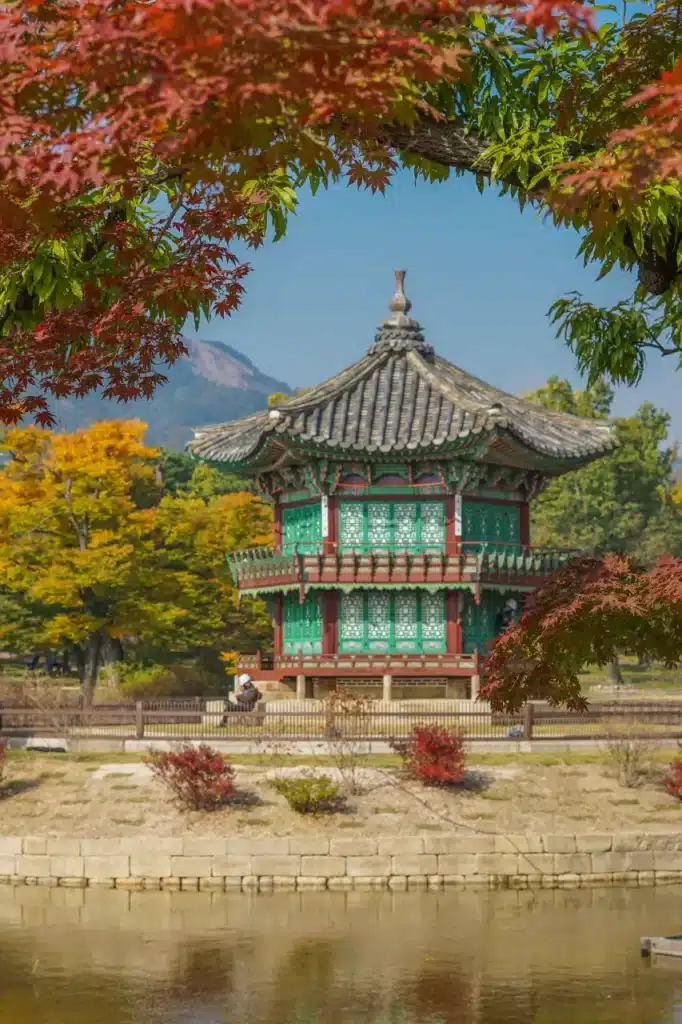
If you enjoy military history, there is a changing of the guard ceremony; it happens several times a day, at pre-determined hours – you should time your visit accordingly. But if you have the chance, nothing beats visiting Gyeongbok (and the other Seoul palaces and Buchan Hanok village) while dressed in traditional hanbok.
Not only can you enter for free at Gyeongbok while wearing it, but you might be requested to pose for pictures by the local ladies. For some reason, Koreans love to take photos of foreigners dressed in traditional Korean clothing; I never felt like a superstar before this experience.
Admission Fees Adults (ages 19-64): 3,000 won / Groups (10 people or more): 2,400 won Children (ages 7-18): 1,500 won / Groups (10 people or more): 1,200 won
Free on the last Wednesday of the month and while wearing a hanbok.
Address : 161, Sajik-ro, Jongno-gu, Seoul
Gyeongbokgung Station (Seoul Subway Line 3) and Exit 5. Anguk Station (Seoul Subway Line 3) and Exit 1.
Official website
Changdeokgung Palace

The Palace of Prospering Virtue, known in Korean as Changdeokgung, was the favorite palace of many Joseon rulers. Moreover, it was the site of the royal court during two out of the three centuries that passed between Gyeongbukgung’s first destruction and its eventual reconstruction in 1868.
Changdeok stands out compared to Gyeongbukgung because its buildings blend in with the natural topography instead of dominating it; its construction style retains elements of the previous Three Kingdoms period of Korean history. Actually, the palace was built specifically to replace Gyeongbuk.
One note before going into the details: according to Joseon tradition, newly crowned kings changed their names similar to the practice of Catholic Popes (e.g., the current Pope Francis was Jorge Mario Bergoglio before he ascended to the Papacy; the first Joseon ruler, King Taejo was Yi-Seonggye before being crowned). Also, in Korean naming tradition, the first name is the family name (Yi is the family name of Yi Seonggye).
King Taejong (born Yi Bangwon), the third ruler of the Joseon dynasty, was reluctant to reside at Gyeongbuk because he had bad memories of the place.

Gyeongbuk was the brainchild of Jeong Dojeon, the first official to hold the Yeonguijeong position, a kind of Prime Minister of Joseon.
Jeong Dojeon envisaged a kingdom run by ministers, with the king having a ceremonial role. However, Prince Yi Bangwon, King Taejo’s fifth son and heir-apparent believed that the Monarch should have absolute power over state affairs.
Given their fundamentally diverging views, Jeong Dojeon convinced the founder of the Joseon dynasty, King Taejo, to appoint his eighth son, Yi Bangseok, as his successor instead of Yi Bangwon.
Enraged, Yi Bangwon raided Gyeongbuk palace, killing Jeong Dojeon and some of the other princes, his own half-brothers, in the process. Saddened by the events, King Taejo abdicated and, eventually, Yi Bangwon ascended to the throne as King Taejong.
Understandably, Taejong preferred constructing a new palace rather than living in the place he committed fratricide.
Today circa 30% of the pre-Japanese structure remains; the site has been a UNESCO World Heritage monument since 1997.

Apart from the impressive historical buildings, today’s main points of attraction are Changdeok’s gardens.
The Huwon, or Rear Garden, was originally constructed for the use of the royal family and palace women. The lotus pond is surrounded by hundreds of different trees and plant species; some trees are more than 300 years old. The Jade Stream area contains a U-shaped water channel initially used for floating wine cups; there is a small waterfall above it.
The Gemuwon, or Forbidden Garden , was destined for the exclusive use of the king. Today, many Koreans call it Biwon, or Secret Garden.
One popular historical K-drama, ‘The Jewel in the Palace,’ was mostly filmed at Changdeokgung.

Admission Fees [Changdeokgung Palace] Adults (ages 25-64): 3,000 won / Group (over 10 people): 2,400 won / Youth ( ages 7-18): 1500 won Students (ages 24 and under): Free (* Except for foreign visitors)
On the last Wednesday of the month, and when wearing a hanbok dress, the entrance is free.
Address : 99, Yulgok-ro, Jongno-gu, Seoul
Subway : Anguk Station (Seoul Subway Line 3), Exit 3.
ChanggyeonggungPalace
Initially named the Suganggung, Changgyeonggung is one of the Five Grand Palaces of Seoul.
Built-in the mid 15 th century, the palace was severely damaged during the 16 th -century Japanese invasion. Rebuilt and enlarged by successive Joseon kings, Changgyeonggung was systematically torn apart by the 20 th -century Japanese administration. The palace complex was destroyed to make room for a park, a botanical garden, and a zoo. After independence and the Korean War, the South Korean government decided to rebuild many iconic buildings and monuments of the past, including the Five Grand Palaces.
Today’s visitors can visit several renovated halls, such as the main hall (Myeongjeong) and the council hall (Munjeong). In addition, Sungmudang hall and Haminjeong pavilion witnessed many important state meetings and official banquets, while Gyeongchunjeon hall was where kings Jeongjo and Heongjong were born. Tongmyeongjeon hall was the main residence of the king and his royal family.
If you tire of visiting the many halls and courtyards, you can always rest by the two ponds called Chundangji.
Admission Fees Adults : 1,000 won / Group (over 10 people): 800 won / Youth ( ages 7-18): 500 won
On the last Wednesday of the month, and when wearing a hanbok dress, the entrance is free. Closed on Mondays.
Address : 185, Changgyeonggung-ro, Jongno-gu, Seoul (서울특별시 종로구 창경궁로 185)
Deoksugung Palace

Deoksugung Palace, also known as Gyeongungung , Deoksugung Palace , or Deoksu Palace, is one of my favorite palatial complexes built by Joseon in Seoul; maybe because we spent a pleasant afternoon on its grounds, wearing the hanboks, immersing ourselves in Korea’s rich history.
The blend of traditional Korean and European architecture makes it unique among the Joseon-era compounds.
In a bid to modernize the country, one of the last Joseon rulers installed electricity in Deoksugung in 1900 and erected a modern pavilion combining both Western and Korean elements, the Jaeonggwanheong. However, during the Japanese occupation, it was transformed into a cafeteria.

Moreover, a European-style, stone palatial building was commissioned, the Seokjojeon. The building was designed by the British architect John Reginald Harding in the Neo-Renaissance style. A typical European garden complements the Seokjojeon. Today, it houses the Korean Empire History Hall.
The Seokjojeon West Building is a later addition; it was opened in 1938 as the House of Yi Art Museum. It continues to serve as the National Museum of Modern and Contemporary Art.
A word of caution, though: it is said that any couple who walks the Deoksugung Stonewall walkway is fated to break up. You have been warned!

Entrance ticket fee: Adult: 1,000 won ; Children: 500 won
Address : 100-120 99 Sejong-daero, Jung-gu, Seoul
Subway : City Hall Station (subway line 1) exit 2
Book your own unforgettable photo session with a local professional photographer on Flytographer.com . They have been featured everywhere from The New York Times to Martha Stewart Weddings and have been called “The Future of Travel Photography” by Conde Nast Traveler and “The #1 Gift for Travelers” by Forbes. Book your session here!
Gyeonghuigung Palace
Constructed in the 17 th century, Gyeonghuigung served as the different kings’ secondary palace for most of its existence. Over time, the complex was expanded to such an extent that it became connected to Deoksugung palace by a bridge.
Unfortunately, most buildings were destroyed by fires in the 19 th -century during the reigns of King Sunjo and King Gojong. The Japanese administration dismantled what remained of Gyeonghuigung, erecting a school for Japanese citizens on the site.
Given South Korea’s administration’s plans to reclaim the symbols of the past, reconstruction of Gyeonghuigung began in the 1990s. Alas, years of neglect made total rehabilitation impossible; as of today, only 1/3 of the initial complex could be recovered.
Tourists can marvel at the exhibits of the Seoul Museum of History located on Gyeonghuigung grounds. Moreover, the Seoul Museum of Arts has a secondary building on the site.
Since 2009, Gyeonghuigung also hosted a unique modern building: the Prada Transformer. As its name suggests, the Transform can change its shape depending on the function it serves one day, it can be a fashion exhibition, the next, it could transform into a movie theater.
Entrance ticket fee: free
Address : 45, Saemunan-ro, Jongno-gu, Seoul (서울특별시 종로구 새문안로 45)
Subway : Seodaemun or Gwangwamun Subway stations, Line 5
PIN FOR LATER!

By Ingrid & Alex
Ingrid A former financial professional, I have been passionate about photography since an early age. My fascination with Korean culture was one of the reasons Alex accepted a business role in Seoul. Alex A former corporate business executive, I am a historical fiction writer. My business career allowed us to live in Seoul and explore South Korea for one year. We fell in love with the country, its culture, food, and people, and we strongly believe you will love it too! Because we know how difficult planning a trip can be, especially to South Korea, we are here to help you out and ensure you have an awesome time there.
15 comments
- Pingback: 11 FUN Things to do in Myeongdong, Seoul - Zen Moments in Korea
- Pingback: Renting a hanbok in Seoul: your complete guide - Zen Moments in Korea
- Pingback: Winter in Korea - the best things to do - Zen Moments in Korea
- Pingback: How to get to the Bukchon Hanok Village | What to see and do
- Pingback: 7 days in Seoul - what to do in Seoul for a week
- Pingback: South Korea 5 day itinerary: an easy to follow guide - Zen Moments in Korea
- Pingback: 5 days in Seoul: the easy-to-follow itinerary
- Pingback: South Korea 10 day itinerary - 4 great options - Zen Moments in Korea
- Pingback: Choose the best Hanok Stay in Seoul: 19 great options
- Pingback: The best time to visit South Korea: by season , including activities
- Pingback: Discover Seoul Pass Itinerary - is it worth it? - Zen Moments in Korea
- Pingback: Is Seoul worth visiting? - Zen Moments in Korea
- Pingback: South Korea Bucket List - the complete list of things worth doing
- Pingback: 7 days South Korea itinerary: what to do and where to go in 2024 - Zen Moments in Korea
- Pingback: Plan for the perfect layover in Seoul - Zen Moments in Korea
Leave a comment Cancel reply
Your email address will not be published. Required fields are marked *
Save my name, email, and website in this browser for the next time I comment.
- Affiliate Disclaimer
- Privacy Policy

Korean Palaces – The Five Grand Palaces of Seoul
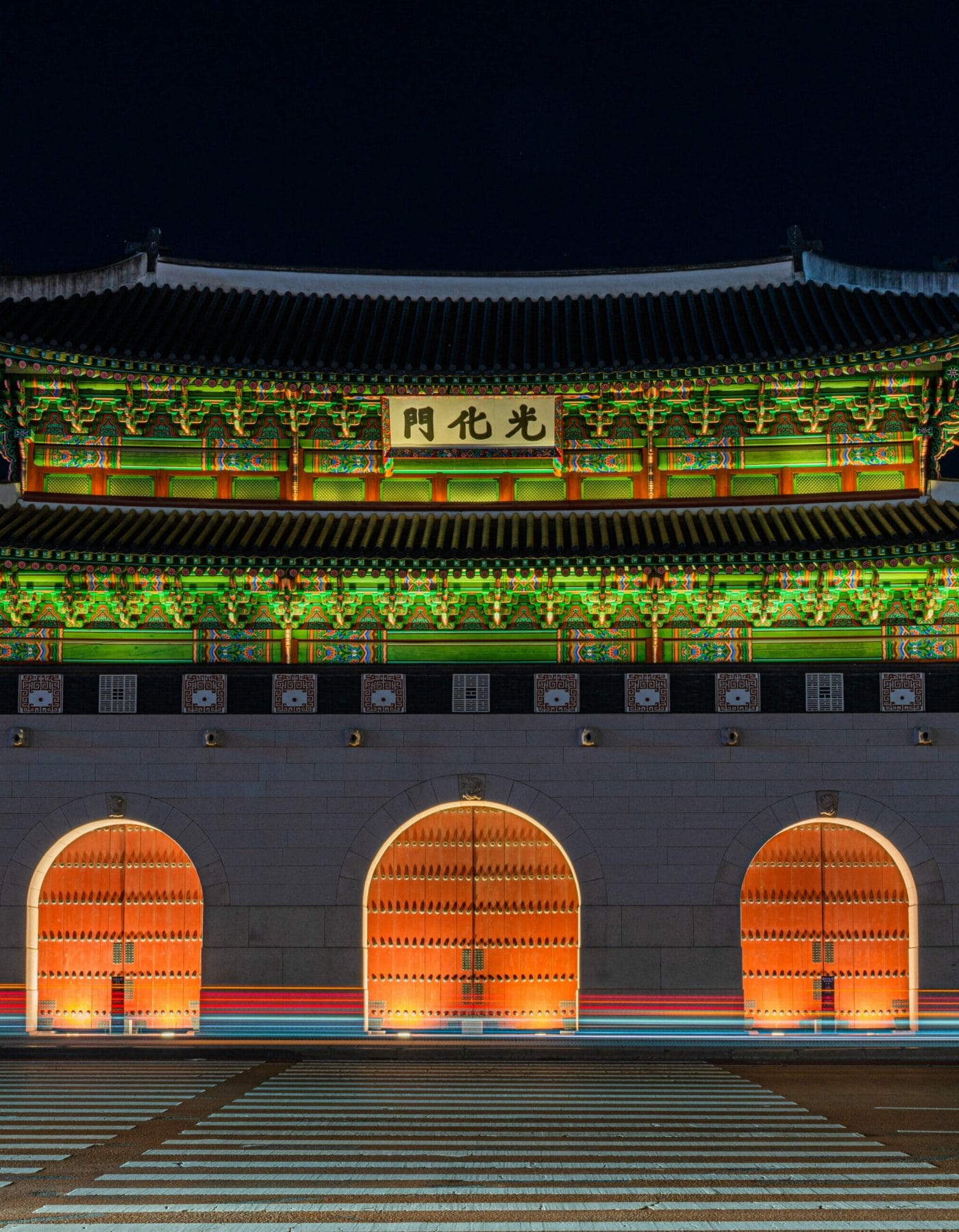
If you plan to visit Korea, a few activities make it onto nearly every travel itinerary. One of these activities is to visit Myeongdong, while another is to take in the sights at Namsan Tower . However, a more traditional activity is to explore the grounds of one of Korea’s many palaces.
Most travellers will visit one of the five Grand Palaces in Seoul. Gyeongbokgung, Changdeokgung, Deoksugung, Changgyeonggung, and Gyeonghuigung are all located around the capital, each with its own highlights. For example, Changdeokgung features a stunning secret garden, whereas Changgyeonggung has a botanical garden you wouldn’t expect to stumble across in a palace!
While there is a range of other historic buildings found across the peninsula (temples and fortresses are especially common), most palaces, and all of the Grand Palaces are located within Seoul as this was the capital during the Joseon Dynasty; at the time, it was called Hanseong or Hanyang, but these are names for what we call modern-day Seoul.
Since these palaces are such an important part of Korean history, I recommend staying in Seoul long enough to check out at least one Korean palace. While the modern side of Seoul has almost limitless attractions, the country also has a rich history and culture that everyone should learn at least a little about. However, that begs the question: How do you pick just one to visit if you’re time-constrained?
Of course, if possible, the best answer is to visit every palace that you can. Unfortunately, it’s often not that easy because travelling often comes with time limitations. In this case, what palace is the best to visit? While many will give the obvious answer (Gyeongbokgung as it’s the largest and most famous palace in Korea), I don’t believe it’s this simple. While the other palaces may not get the same attention as Gyeongbokgung, they are all unique with different attractions.
Although many people visit the palaces to take photos and explore, there is also no better place to learn a bit about Korean history and traditions than at one of these palaces. They are well signposted and explained, and many feature museums within or nearby. On top of this, they’re all located in historically-important areas with a range of other traditional attractions.
So, if you’re wondering what Korean palace you should visit (or if you already know which palace you would like to visit but are looking for further information), read on! In this post, I will cover everything you need to know about Korean palaces, including how you can get free entry and which hidden attractions are most worth visiting. With that said, let’s get started!
Why You Should Visit a Palace in Korea
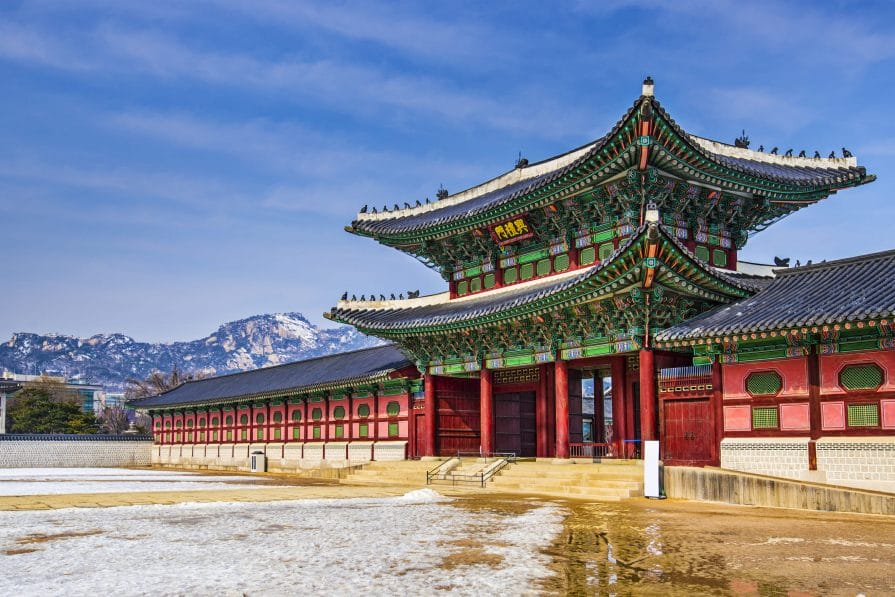
To Learn About Korean History
There are three ways most travellers learn a bit about the country while visiting: museums, palaces, and temples. While museums arguably contain the most information, some travellers find them tedious or too time-consuming. If this is the case, the palaces of Korea are your next best option.
Not only do you learn a lot about Korea (especially if you explore them as part of a tour), but you get to take photos and explore along the way. This also makes exploring the palaces a far more entertaining way to explore Korean history and culture.
If you visit Gyeongbokgung Palace, you’ll find that there is also a museum located within the palace grounds. While this is entirely optional, it’s a great way to expand your learning while also navigating your way around the palace.
It’s worth noting at this point that even if you’ve travelled throughout Asia and visited palaces before, Korea has a unique culture that has remained distinct for thousands of years. While the palaces are based on Chinese principles, they are unique, and you won’t find anything similar outside of the country.
They are Beautiful (Perfect for Photos!)
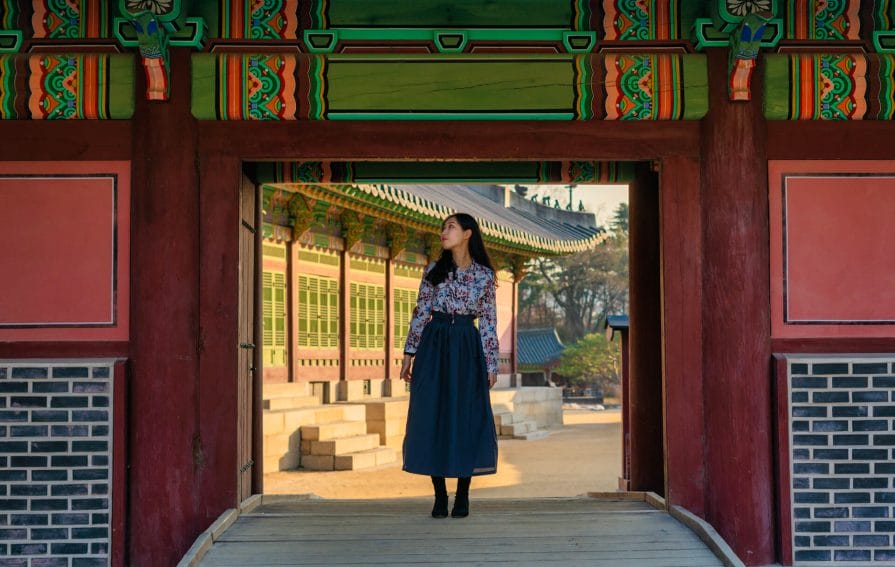
While you can still find this architecture in other locations around Korea, there’s nowhere else that you can see the scale which you’ll find in the palaces (especially the larger ones such as Gyeongbokgung and Changdeokgung). Since they’re so expansive, they also house a great variety of stunning photo locations.
I used to work as a photographer, and my main clients were travellers to Korea who wanted unique travel photos. I always recommend the palaces, and after spending many days at Gyeongbokgung, I can say with certainty that you’ll be able to take some stunning and unique photos there.
If you want to make your photos even more memorable and unique, consider hiring hanbok for yourself and your family or friends. Since these outfits can only be found in Korea, you’ll not only have some very special travel photos, but they’ll be thematically correct with one of the Korean palaces as your backdrop. Of course, hanbok is also beautiful and well worth wearing regardless of the photo opportunities!
For The Other Attractions
The final reason I recommend visiting the palaces is that they often have other attractions than the palaces themselves. For example, Gyeongbokgung Palace has a ceremony for changing the guards throughout the day. While this demonstration lasts only for a minute or two, it’s worth witnessing if you’re planning a visit at the right time.
Another example is the ‘secret’ garden in Changdeokgung. While you can’t freely explore the garden (you will need to be part of a tour to explore this part of the palace), there are guides taking groups through the garden at certain times of the day. The garden is stunning, and one of the reasons why I’ve written an article discussing why I recommend visiting Changdeokgung Palace instead of Gyeongbokgung.
If you’re still deciding if visiting a Korean palace is deserving of a place on your itinerary, I highly recommend that you find the time. There are so many reasons to visit the palaces of Korea, and you’ll be missing out if you don’t go to at least one.
Palace Visiting Tips
There are three ways to get free entry into the five grand palaces in Seoul. The first method is to hire and wear hanbok , Korea’s traditional clothing. This clothing can be hired from a multitude of stores around the palaces and can cost as little as 10,000 KRW per hour.
Hanbok is available in men’s and women’s styles, and you will also be able to find children’s outfits available. While each store will have different outfits available, they are all colourful and elegant. The best part? Most rental stores will let you choose your outfit, meaning you can pick your own colour scheme and accessories.
Hiring hanbok is not only a way to save a little on the palace entrance fee, but it’s also a great way to experience the palaces in a truly unique way. You’ll feel like you’re living in the Joseon Dynasty! Of course, you’ll also get the best pictures if you decide to wear Hanbok to the palaces.
The second method for getting free entry into the palaces is less well-known, and it requires a bit more planning. If you happen to be in Korea on a (major) public holiday, the palaces will open up and admit everyone for free. Of course, if your holiday doesn’t overlap with a public holiday, this won’t work out, but it’s a good choice if the two coincide!
While the palaces will admit visitors for free on a few days throughout the year, the best holidays to visit are Chuseok and Seollal . These are three-day holidays which are combined with weekends to form a five-day holiday, and they typically fall in February/March and September/October.
Of course, depending on the public holiday you choose to visit during crowds may be crazy. However, this is another reason I recommend Chuseok and Seollal – during these days, most locals will be with their families, and even the number of tourists doesn’t seem to be any more than normal. This makes these two Korean holidays ideal times to visit!
The final method for getting free entry into the Korean Palaces is to visit on a Wednesday! Well… The last Wednesday of any month. This is another little-known secret, but if your holiday happens to fall near the end of the month, this might be a deal you want to take advantage of!
Timing is everything
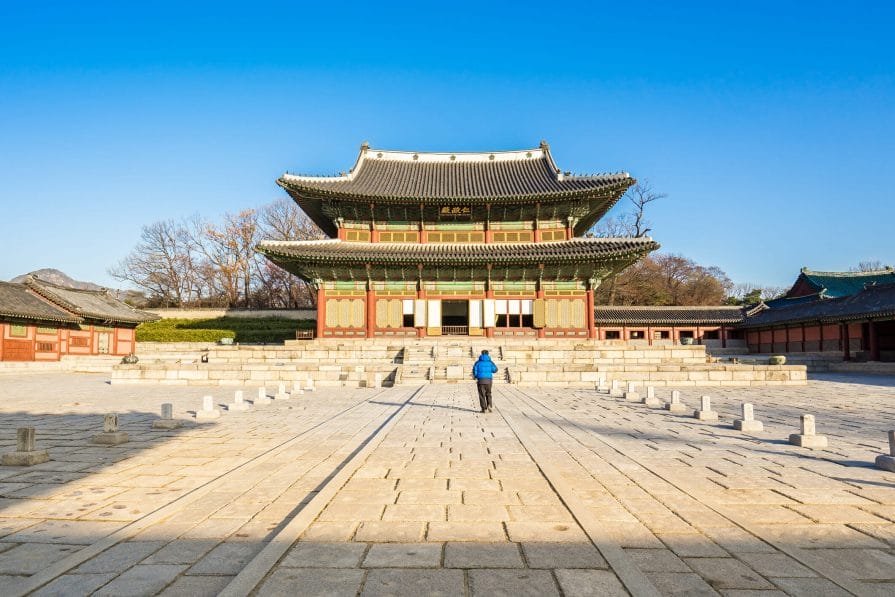
I used to do photography at the palaces, and in total, I would estimate I’ve visited the palaces over 100 times. After all these visits, I learned that the morning is your friend – get there as close to opening time as possible, and you will avoid most of the crowds. From noon until closing, the palaces will be packed and getting nice pictures without unintentional photo-bombers will be difficult.
Secondly, timing is important because the larger palaces will often have events that take place at only certain times. For example, at Gyeongbokgung, you can witness the changing of the guards at certain times throughout the day. At Changdeokgung, you won’t be able to visit the secret garden without a tour, and the tours only operate at certain intervals. For this reason, it’s important to plan ahead!
Finally, the palaces will stop admitting visitors an hour before closing. While you’ll likely want more than an hour in the palaces (especially the larger ones) anyway, it’s important to keep this in mind as you might otherwise be turned away.
Take a Tour
While exploring the palace grounds on your own certainly has its appeal (this is my favourite way to explore them!), there are also many bonuses to taking a tour through the palace of your choice.
The biggest benefit to having a tour guide is that you will be able to learn a lot that you otherwise probably would have never known. The tour guides are incredibly knowledgeable, and depending on the tour you choose, these can be a great way to learn more about the history behind each palace.
On top of this, some tours will give you entry into areas that you otherwise wouldn’t be able to visit. For example, the Secret Garden in Changdeokgung Palace requires a tour guide for entry, and this garden is a highlight of the palace. In these cases, being part of a tour is your only option for exploring the palace.
If you aren’t a fan of group tours like me, don’t worry! There are also many private tours available at more affordable rates than you might imagine. By checking websites such as Klook and Trazy, you can almost always find an affordable tour, many of which are private!
Palaces in Seoul
Gyeongbokgung.
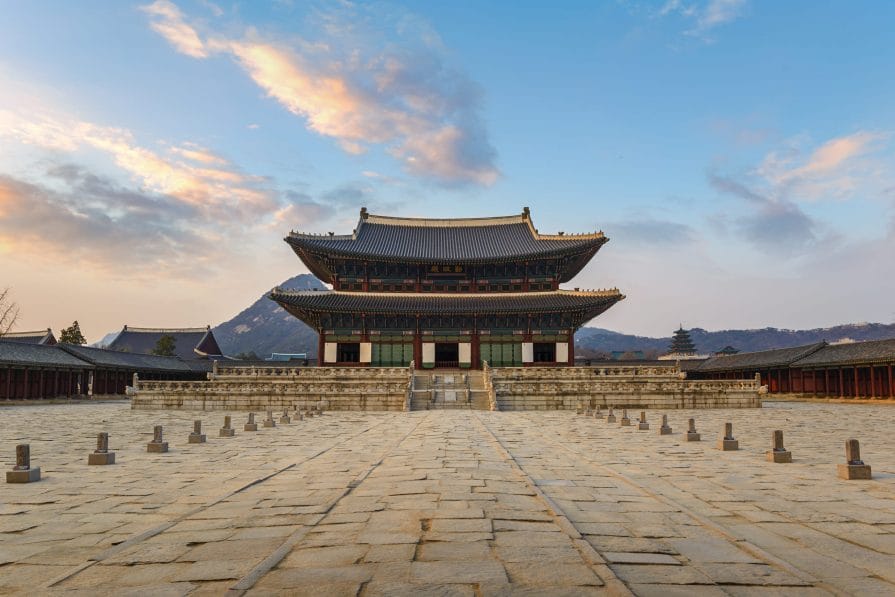
Entrance Fee: 3000 KRW | 1500 KRW for children
Opening Hours: 9 am – 5 pm/6 pm/6:30 pm (depending on the month)
Closed Days: Tuesdays
Closest Subway Station: Gyeongbokgung Station/Gwanghwamun Station
Attractions: Changing of the guard and National Folk Museum of Korea
Gyeongbokgung Palace is by far the most famous palace in Seoul, and it’s the palace that I would guess 90% of visitors to Korea who visit a palace go to. The palace is located in Gwanghwamun , a central district in Seoul with many embassies and consulates.
Gyeongbokgung is the most visited palace in Seoul for a few reasons. Firstly, it’s incredibly convenient to visit as it’s serviced by not one but two subway stations (Gyeongbokgung and Gwanghwamun stations). On top of this, it’s a truly massive palace with a range of other attractions, such as the National Folk Museum of Korea.
Since Gyeongbokgung is the most visited palace in Korea, it’s well-established and maintained. Due to this, various other attractions have popped up around it, including one of my favourite streets in Seoul , which is lined with traditional cafes and restaurants.
Gyeongbokgung is very cheap to visit, and you will pay only 3000 KRW entry per adult. If you’re wearing a hanbok, this fee is waived. While hanbok costs around 10,000 KRW per hour to rent, I highly recommend renting it even without the fee waiver. With this discount, it becomes an even more tempting offer.
While I love Gyeongbokgung Palace, it’s not my favourite palace in Korea (that award goes to Changdeokgung). This is simply because while Gyeongbokgung is massive (if you have the time to explore, it goes far further back than most visitors realise), there is relatively little interest once you pass the first sections of the palace.
However, this also means it’s perfect if you want to take some fantastic photos without being photobombed by crowds of visitors. While the first few sections of the palace are often packed, you will quickly find areas not frequented by other visitors as soon as you explore. This makes it the perfect place to explore if you’re looking for some stunning photos!
Many travellers will dedicate a morning or afternoon to Gyeongbokgung. While you will need a good three or four hours to explore the whole palace (including the folk museum and perhaps a drink at the cafe within the palace grounds), you can take in the most important sights and scenes in a couple of hours. However, since Gyeongbokgung stands in such a fascinating part of Seoul, I recommend dedicating at least a morning or afternoon to the area. This will allow you also to explore Bukchon Hanok Village, Insadong, and perhaps even another nearby palace!
If you’re looking to check out the most famous attractions in Seoul, this palace should absolutely be on your list – especially if you want to see the changing of the guards or check out the National Folk Museum of Korea. On the other hand, if you’re looking to take stunning photos or avoid crowds, I recommend one of the other palaces in Seoul.
Changdeokgung

Entrance Fee: 3000 KRW | Free for children
Opening Hours: 9 am – 4:30 pm/5 pm/5:30 pm/6 pm/6:30 pm (depending on the month)
Closed Days: Mondays
Closest Subway Station: Anguk Station
Attractions: Secret Garden (must be part of a tour)
Changdeokgung is the second most famous of the Five Grand Palaces in Seoul. Located a short walk from Gyeongbokgung Palace, Changdeokgung is a significantly smaller palace that attracts far fewer visitors than its larger counterpart. With that said, don’t expect it to be empty, as it still attracts its fair share of local and international travellers.
Similarly to Gyeongbokgung Palace, Changdeokgung Palace has gone through many eras. Initially completed in 1412, the palace was burnt down in 1592 before being reconstructed in 1609. Only 13 years later, the palace was burnt down again. Its current form is, unfortunately, only a shadow of its former self, as only around 30% of the original palace still stands due to damages caused during the Japanese occupation of Korea.
However, despite only around 30% of the original palace still standing today, Changdeokgung is a stunning palace and my personal favourite for photos. While all five palaces have their own beauty, Changdeokgung has always stood out to me as the most beautiful. Perhaps this is just my opinion, but I’ve always enjoyed exploring Changdeokgung the most out of the five palaces.
Changdeokgung Palace’s biggest attraction besides the palace itself is the ‘secret’ garden located at the rear of the palace. While it’s a secret by name only, the garden is often overlooked by travellers who either don’t realise it’s there or visit at the wrong times (as a tour guide is required to enter the garden).
Originally, this garden was meant only for the royal family. It contains a stunning lotus pond, large, landscaped lawns, and many different species of plants and trees. While the days of private use are now behind the garden, it’s still well maintained and looked after, making it worth visiting if you get the chance.
Another reason to visit Changdeongung is its fantastic location. Not only is Gyeongbokgung within walking distance, but you can easily rent a hanbok in the nearby streets of Insadong or Bukchon Hanok Village. Each of these streets also houses a variety of other attractions that could easily take an afternoon to explore.
Changgyeonggung

Entrance Fee: 1 000 KRW | 800 KRW for children
Opening Hours: 9 am – 9 pm
Closest Subway Station: Hyehwa Station
Attractions: Grand Greenhouse
Changgyeonggung Palace shares a similar history with Gyeongbokgung and Changdeokgung Palaces. Originally constructed and expanded in the mid-15th century and 1483, the palace was partially destroyed multiple times by Japanese invasions and occupations.
While Gyeongbokgung and Changdeokgung get most of the attention from travellers due to their extensive grounds and well-maintained buildings, Changgyeonggung Palace is often overlooked despite being within walking distance of the two more famous palaces.
However, despite being the least famous of these palaces, Changgyeonggung Palace has attractions that make it well worth visiting. On top of this, it’s also far less crowded than Gyeongbokgung Palace and Changdeokgung Palace, making it ideal for photos and exploring.
Perhaps the biggest attraction of Changgyeonggung and one of the key reasons it’s worth visiting instead of (or alongside) the larger palaces in Seoul is the breathtaking greenhouse you will find located within the palace grounds. The Grand Greenhouse is a greenhouse originally constructed over 100 years ago.
The Grand Greenhouse is expansive; inside, you will find hundreds if not thousands of plants of different species. While the greenhouse feels a bit out of place amongst the otherwise traditional-feeling architecture of the palace, it’s a hidden gem and something I accidentally stumbled across a few years ago. Needless to say, I was thrilled with what I thought at the time was quite the find!
If you’re deciding between palace gardens and don’t know whether to visit Changdeokgung’s Secret Garden or Changgyeonggung’s Grand Greenhouse, I would recommend both. They’re both very unique and very different in their appeals. However, if you can only visit one, it comes down to if you prefer the outdoor style of a homely garden or an indoor botanical garden feel.
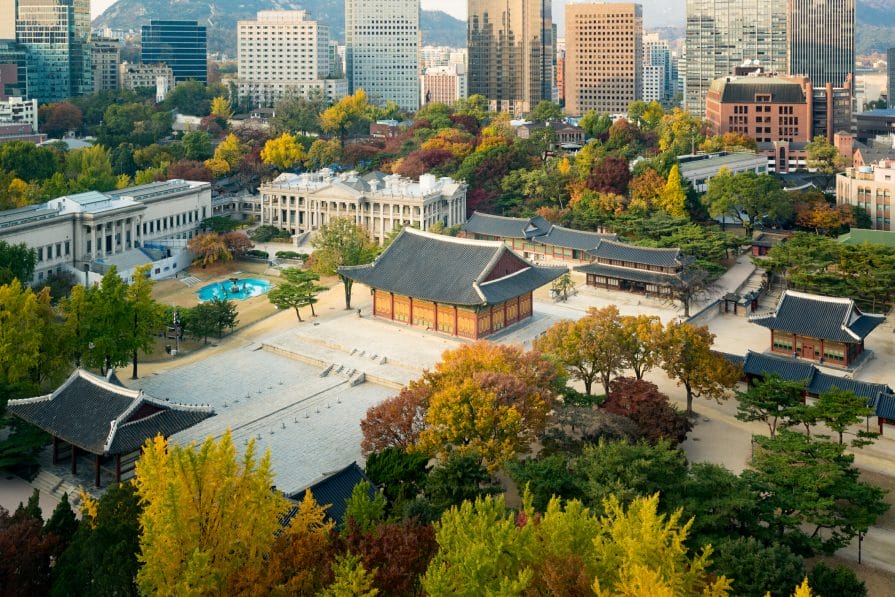
Entrance Fee: 1 000 KRW | 500 KRW for children
Closest Subway Station: City Hall Station
Attractions: Changing of the Guard ceremony
Deoksugung Palace is the second smallest of the Five Grand Palaces in Seoul, so it’s often overlooked in the face of the larger and more popular palaces. However, the small size is one of its greatest appeals – it’s easy to explore and feels more homely than the more immense palaces, some of which are truly vast.
Although it’s hardly surprising to say this anymore, Deoksugung Palace is also within walking distance of Gyeongbokgung Palace and the other palaces. As you might be able to tell by now, while different palaces held power at different times, the power of the Joseon Dynasty was always consolidated in one area.
Deoksugung is a unique palace because it has a more Western influence than the other nearby palaces. King Gojong was a king during the late Joseon Dynasty who resided at Deoksugung during his reign. Being open to Western culture, he constructed some buildings in a Western-style and even installed electric lights in the palace.
Similarly to Gyeongbokgung Palace, Deoksugung Palace has a changing of the guard ceremony, which takes place multiple times throughout the day. While the front gate isn’t as large as Gyeongbokgung’s, and the ceremony doesn’t have quite the same feel, it’s absolutely worth watching if you’re visiting at the right times.
Despite being the smallest of the Five Grand Palaces, Deoksugung has its charm, and while it isn’t my favourite palace in Seoul (that award still goes to Changdeokgung), I’ve always enjoyed my visits to this palace because it’s so unique. Whereas the other palaces feel very traditional and straight out of the Joseon Dynasty, Deoksugung combines traditional Korea and modern Korea.
Gyeonghuigung

Entrance Fee: Free
Opening Hours: 9 am – 6 pm
Closed Days: Mondays and January 1st
Closest Subway Station: Gyeongbokgung Station/Gwanghwamun Station
Attractions: Seoul Museum of History and Seoul Museum of Art
The fifth and final of Seoul’s Five Grand Palaces is the least talked about and the one you will find the fewest people visiting. While it still carries much of the appeal of the larger palaces, it’s often overlooked due to its small size and less touristy location.
Similarly to all the other palaces, Gyeonghuigung is located near Gwanghwamun, and it’s within walking distance of the more prominent and well-known palaces. However, to visit this palace, you will find yourself walking away from the touristy areas and, as such, this palace is the least visited of the five.
Unfortunately, the palace also shares the same history as most of the other Grand Palaces of Seoul, meaning it was burnt down and rebuilt multiple times over the past centuries. While you wouldn’t realise this (as the palace has been expertly restored), most of what you see isn’t the original construction.
To incentivise people to visit, and perhaps because of the palace’s relatively small size, Gyeonghuigung always has free entrance – regardless of whether you are wearing a hanbok or visiting on a public holiday. This makes it a great palace to visit if you happen to be in the area for wherever reason.
Despite being small, Gyeonghuigung still has multiple halls that were used by the royals and for council meetings. While you can’t enter these halls (similarly to the other palaces), you can go up to the door and see inside the rooms and get a feel as to what they would’ve looked like when they were in active use.
Gyeongguigung also houses both the Seoul Museum of History and one wing of the Seoul Museum of Art. If you’re looking to have a well-rounded cultural experience, these two attractions make Gyeonghuigung Palace a great place to visit. While I wouldn’t recommend making this palace the only one you visit during your trip, it’s a great addition to visit Gyeonghuigung alongside a larger palace.
Although many travellers and locals alike overlook Gyeonghuigung Palace, there are some reasons to visit. Perhaps most importantly, it’s a great palace to visit if you want to avoid the crowds. Similarly to the other less-trafficked palaces, this makes it the ideal spot for photos – especially if you decide to hire a hanbok and explore the palace grounds.
About Ethan Brooke
My name is Ethan Brooke and I have been living in South Korea since 2016. Since then, I have fallen in love with exploring and travelling around Korea. One thing that I quickly realised however, is that there is still a lot of information missing on Korea - at least in English. I started Seoulinspired to help fill that gap and to provide information to others living in and visiting South Korea. View all posts by Ethan Brooke →
Leave a Reply Cancel reply
Your email address will not be published. Required fields are marked *
Save my name, email, and website in this browser for the next time I comment.
- Jeju Island
- Sejong City
- North Chungcheong
- South Chungcheong
- North Jeolla
- South Jeolla
- North Gyeongsang
- South Gyeongsang
- Restaurants
- Cafes & Bars
- Adventure & Outdoors
- Festivals & Events
- Best in Korea
- Weekend Getaway
- Book your trip!
- Transportation
- Weather & Seasons
- Emergency Situations
- K Drama & Film
- K Beauty & Fashion
- K Tradition
- Expat Services
- Work and Study
- Where to Live
- Shopping Basics
- Foreign Language Hospitals
- Various Issues
- Search by Map
- Ask a Konnector
- Collab with Us
- Favorite Articles
- Favorite Places

Social Links
- The Five Royal Palaces in Seoul
The five palaces of Seoul are royal palaces of the Joseon Dynasty and symbols of Korea’s culture and history. Each palace has its unique charms.
The five palaces of Seoul are royal palaces of the Joseon Dynasty and symbols of Korea’s culture and history. Each palace has its unique charms: Gyeongbokgung Palace, the royal residence; Changdeokgung Palace, a UNESCO World Heritage Site inscribed in 1997 with remarkable beauty; Deoksugung Palace, a combination of Korean aesthetics and Western architecture; Changgyeonggung Palace, now restored from the damages caused by Japanese Occupation; and Gyeonghuigung Palace, humble and simple.
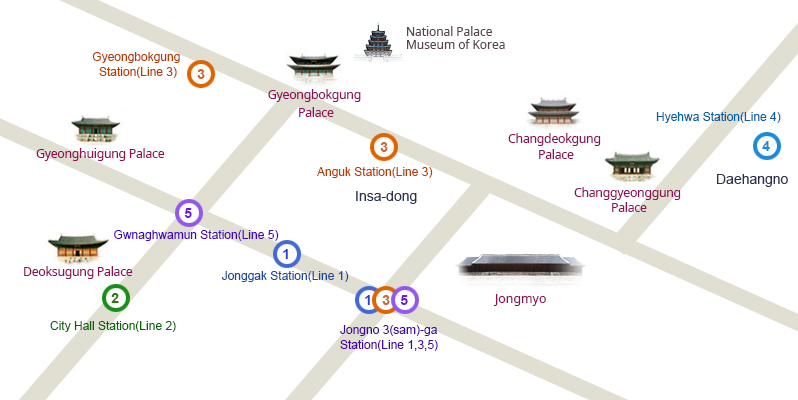
- Gyeongbokgung Palace : 161, Sajik-ro, Jongno-gu, Seoul / +82-2-3700-3900
- Changdeokgung Palace : 99, Yulgok-ro, Jongno-gu, Seoul / +82-2-3668-2300
- Deoksugung Palace : 99, Sejong-daero, Jung-gu, Seoul / +82-2-771-9955
- Changgyeonggung Palace : 185, Changgyeonggung-ro, Jongno-gu, S eoul / +82-2-762-4868
- Gyeonghuigung Palace : 45, Saemunan-ro, Jongno-gu, Seoul / +82-2-724-0274
- Bukchon Hanok Village
- Dongdaemun Design Plaza
- Ewha Womans University
- Hongik University Street
- Ikseon-dong
- Itaewon Special Tourist Zone
- Korea University
- Lotte World
- Myeong-dong Street
- N Seoul Tower
- Namdaemun Market
- Seoullo 7017
- Youngdeungpo
Built in 1395, Gyeongbokgung Palace is also commonly referred to as the Northern Palace because its location is furthest north when compared to the neighboring palaces of Changdeokgung (Eastern Palace) and Gyeonghuigung (Western Palace) Palace. Gyeongbokgung Palace is arguably the most beautiful, and remains the largest of all five palaces. The premises were once destroyed by fire during the Imjin War (1592-1598).
- Address: 161, Sajik-ro, Jongno-gu, Seoul
- Phone Number: +82-2-3700-3900
- Operating Hours: 09:00-17:00 (18:00 / 18:30)
- Closed: Tuesdays
- Admission Fees: 3,000 won / Groups: 2,400 won

For Foreigners under the age of 18, admission to Gyeongbokgung Palace and Deoksugung Palace is free starting in April

Night tours of Gyeongbokgung Palace to start from April 5

Chuseok & Autumn for Foreigners

Gyeongbokgung: The Main Royal Palace of Joseon Dynasty

Hanok-inspired Baskin Robbins: flavors from another time

Art Heaven: Seoul Best Contemporary Art galleries

Places to visit in Hyoja-dong, Seochon
Seldomly people know about Seochon, particularly Hyoja-dong, a beautiful neighbourhood located near Gyeongbokgung Palace. I’m gonna share my experience having a short trip walking around Seochon!

Korea’s Largest Bookstore Chain: Kyobo Bookstore

3 Famous Historical Places to Visit in Seoul

Goblin Kdrama Filming Locations in Seoul

Jongno-gu: Cultural and Artistic Tour I

Day Tour in Seoul for Kdrama Fans – Sample Itinerary and Guides

VISIT SEOUL Awards 2020, What is the most beloved tourist attractions in Seoul this year?

Must-Visit Spots and Attractions in Seoul

Gyeongbokgung Palace and Bukchon Hanok Village

Renting a Hanbok

K-drama Filming Spots in Seoul for K-drama Lovers

Hanbok: Becoming a Prince and Princess Of Korea

Palaces in Autumn – Gyeongbokgung & Changdeokgung

National Palace Museum Of Korea- Exploring Ancient Heritage

Gyeongbokgung Palace- Feel the Korean History and Culture

Gyeongbokgung Palace in Seoul

Gyeongbokgung Palace in Different Seasons

Feel Korean tradition visiting Gyeongbokgung Palace

Hanbok Experience at Gyeongbukkung Palace

Gyeongbokgung Palace - Travel Back in Time To Joseon Dynasty

Changing of Guards Ceremony
Changdeokgung Palace was the second royal villa built following the construction of Gyeongbokgung Palace in 1405. It was the principal palace for many kings of the Joseon dynasty, and is the most well-preserved of the five remaining royal Joseon palaces. The palace grounds are comprised of a public palace area, a royal family residence building, and the rear garden. Known as a place of rest for the kings, the rear garden boasts a gigantic tree that is over 300 years old, a small pond and a pavilion.
- Address: 99, Yulgok-ro, Jongno-gu, Seoul
- Phone Number: +82-2-3668-2300
- Operating Hours: Feb-May, Sep-Oct 09:00-18:00 / Jun-Aug 09:00-18:30 / Nov-Jan 09:00-17:30
- Closed: Mondays

The Deranged Prince and Wailing at Changdeokgung

The Expat Experience in Korea: 9 Awesome Adventures

2021 Moonlight Tour at Changdeokgung Palace Open

FREE Places To Go in Seoul for Hallyu Fans

Secret Garden of Changdeokgung: The Epitome of Joseon Dynasty

A day in Seosulla-gil, Seoul’s historical trail

The Magical Changdeokgung Palace Moonlight Tour

A visit to the Secret Garden of Changdeokgung Palace during snowfall

The Grand Palaces: Changdeokgung and Changgyeonggung

Changdeok Palace
Registered as Historic Site No. 124, Deoksugung Palace was not originally a royal palace, but was the home of Grand Prince Wolsan (1454-1488), the older brother of King Seongjong (1469-1494) of the Joseon dynasty. It wasn’t until 1593 that the palace was used as a temporary palace of the royal family after their home was burned down during the Imjin War. King Seonjo also stayed at Deoksugung Palace after returning to the city.
- Address: 99, Sejong-daero, Jung-gu, Seoul
- Phone Number: +82-2-771-9951
- Operating Hours: 09:00-21:00
- Admission Fees: 1,000 won / Groups: 800 won

2 Days 1 Night Seoul Itinerary for Kdrama Fans

Deoksugung Stonewall Walkway and Nearby Kdrama Filming Locations

Visit to Deoksugung Palace
Located in the heart of Seoul, Changgyeonggung Palace was originally built as Suganggung Palace by the 4th ruler of the Joseon dynasty, King Sejong (r.1418-1450), for his retiring father, King Taejong. It often served as residential quarters for queens and concubines. During the reign of King Seongjong (r.1469-1494), the palace was renovated and renamed to Changgyeonggung Palace. It later became a park with a zoo and a botanical garden during Japanese colonial rule.
- Address: 185, Changgyeonggung-ro, Jongno-gu, Seoul
- Phone Number: +82-2-762-4868

Fall in love with Hyehwa-dong, things to do around the area

Changgyeonggung Palace – A Tour at Joseon’s East Palace

10 Hidden Healing Spots in Seoul
Gyeonghuigung Palace, Historic Site No. 271, was originally called the large palace by Saemun Gate, or the Western Palace, for its location within the city. It was not until the eighth year of Gwanghaegun (1616) that the palace was used as a royal residence for the king, changing the name to Gyeongdeokgung Palace. The name later changed again to the current Gyeonghuigung Palace in 1760. The palace grounds included many halls but they were mostly all burned down in a fire in 1829.
- Address: 55, Saemunan-ro, Jongno-gu, Seoul
- Phone Number: +82-2-724-0274
- Operating Hours: 09:00-18:00
- Closed: Mondays & January 1
- Admission Fees: Free
Recent Stories

Royal Palaces Open for Special Evening Admission

Foreigners in Korean History: Korea’s First Western Architect
- 🇷🇺 Tatiana Badygova

Haunted Palaces: Queen Min and Gyeongbokgung

+S’More Market Toy House: Disney Pixar Cafe in Seoul
- 🇧🇷 Dani Quintana

Getting to Know Seoul @ Seoul Museum of History (Pt.1)

Gyeonghuigung Palace: Kingdom Filming Location

- 🇮🇳 Amitesh Sharma

6 things you must try when you visit Korea
- 🇷🇴 Emilia Bucsan

- 🇺🇳 The KoreabyMe Team

- 🇲🇾 Chok Yan Ting

Traditional Korean Restaurants in Seoul
- 🇺🇸 Margaret Butler

Jongmyo Shrine: Authentic Sanctuary of Joseon’s Kings and Queens
- 🇲🇾 AVIS WEE SIN HUI

Maji: Enjoy the Taste of Temple Food
- 🇲🇾 KOK KE YING

- 🇩🇿 Djedouani Amina

A Visit to the Main Royal Palace of the Joseon Dynasty – Gyeongbokgung Palace

Best Chiropractic Therapy in Suwon, Korea

How to become a student in Korea

Here’s How To Find A Job In Korea In Really No Time
- 🇵🇰 Majid Mushtaq

Best Books to learn Korean

Dream Concert 2023 to be held in Busan on May 27th
Input your search keywords and press Enter.
- Find Account / Password
Enter something special:


- Accomodation
- Attractions
- Food & Drink
- K-Entertainment Tours
- Korean Culture
- Shopping Destinations
- Transportation
- Travel Essentials
- Travel Tips
- Travel News in Korea
- Gyeonggi-do
- North Gyeongsang (Gyeongsangbuk-do)
- North Jeolla (Jeollabuk-do)
- South Chungcheong (Chungcheongnam-do)
- South Gyeongsang (Gyeongsangnam-do)
- South Jeolla (Jeollanam-do)

5 Seoul Palaces You Must Visit to Add to Your Royal South Korea Experience

9,194 total views, 1 views today

Last Updated on 3 years by admin
The five grand palaces of Seoul are must-see sites in Korea that will add on to your royal South Korean experience!
The unmatched amalgamation of traditional and modern makes South Korea a must-visit in every wanderlust’s travel journal. There’s no other place in the world with such majestic royal sites right next to urban skyscrapers!
Although South Korea has developed and modernized at an enormous pace, the ancient temples and palaces are still maintained in excellent condition. Seoul boasts of new skyscrapers but it is also home to the country’s five grand palaces.
A trip to Seoul is not just about shopping , Instagram-worthy cafés , modern architecture, and getting swept up in the Hallyu wave . The city offers a delicate balance between modernity and the rich history of Korea with its 5 grand palaces of Seoul.
Visiting all the 5 grand palaces is Seoul might be an overkill but you should at least visit two of them to see the grandeur of Korean emperors and enjoy the magnificent Korean history.
But, then the question comes down to which one should you choose? Read on below to find out more about all the 5 grand palaces of Seoul and then you can make a decision!
Here’s a little bit about the five grand palaces in a nut shell:
- Gyeongbokgung Palace – The most impressive and magnificent of all the 5 palaces is Seoul. It is also historically most important.
- Changdeokgung & Changgyeonggung Palaces (The East Palaces) – Best surrounding gardens and beautifully reconstructed old buildings.
- Deoksugung & Gyeonghuigung Palaces – Smaller palaces as compared to others. They fit into any travel itinerary especially if you are short on time.
Table of Contents
Royals of South Korea
The last kingdom to rule in Korea was the Joseon Dynasty (조선왕조), which lasted from 1392 until 1910. Much of modern Korea is shaped by the legacy of the Joseon Dynasty dominion in the peninsula.
During 500 years of their rule, Joseon Dynasty rulers constructed the five Seoul palaces, and all five are still standing. These five Seoul palaces are probably the best places to see and experience the history, tradition, culture , and beauty of Korea all in one place.
All the five grand palaces are clustered around the Seoul City Hall and the general business district. These five Seoul palaces include Gyeongbokgung Palace, Gyeonghuigung Palace, Deoksugung Palace, Changgyeonggung Palace, and Changdeokgung Palace.
For those looking to explore the history and culture of Seoul, a tour of the Five Grand Palaces may be an excellent way to spend a couple of days.
Here’s all you need to know about the five Seoul palaces that you must visit for a royal South Korean travel experience.
Gyeongbokgung Palace (경복궁)
The most impressive and expansive of the 5 Grand Seoul palaces, Gyeongbokgung Palace, was the first and the main royal palace of the Joseon dynasty.
Built-in 1395, Gyeongbokgung Palace is additionally commonly mentioned as the Northern Palace. Its because its location is that the furthest north in comparison to the neighboring palaces of Changdeokgung and Gyeonghuigung Palace.
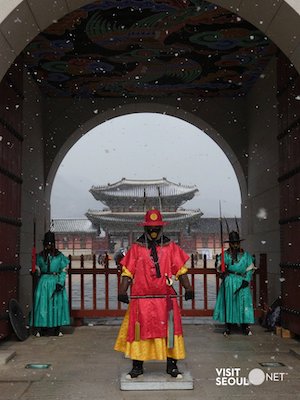
Korea’s government has been restoring the buildings that were destroyed by the Japanese invaders since the 1990s. The glory of the beautiful Gyeonghoeru Pavilion, Hyangwonjeong Pond, and the huge gates of Gwanghwamun are what make Gyeongbokgung Palace the most glorious and grandest of all the five Seoul palaces.
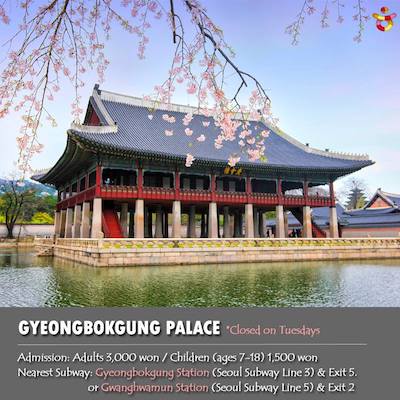
Gyeongbokgung Palace is one of the best attractions and a must-see palace for anyone visiting Seoul .
You can also check out the Bukchon Hanok Village near the palace .
Read more : Gyeongbokgung Palace – Korea’s Magnificent Main Palace
Changdeokgung Palace (창덕궁과 후원)
Changdeokgung Palace is also known as Donggwol, the Eastern Palace. This is because the palace is located on the east side of Gyeongbokgung Palace. For about 270 years, this Seoul palace was home to the Joseon dynasty government. It was preferred residential grounds for many Joseon Dynasty kings.
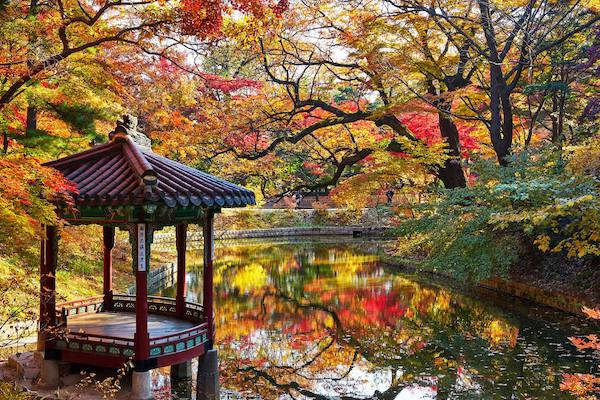
The buildings of Changdeokgung blend with the natural topography of the site instead of imposing themselves upon it making it a picturesque sight.
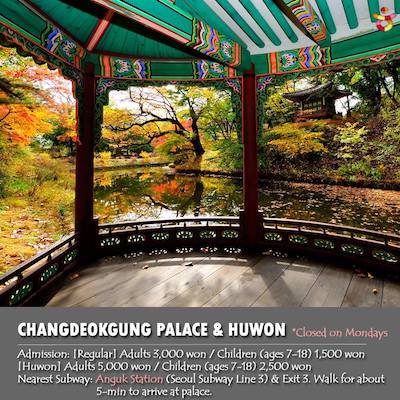
It, just like the other Five Grand Palaces in Seoul, was heavily damaged during the Japanese occupation of Korea (1910–1945). Currently, only about 30% of the pre-Japanese structures of the East Palace Complex (Changdeokgung alongside Changgyeonggung) survive.
Read more : Changdeokgung Palace (창덕궁) and Huwon, The Secret Garden
Gyeonghuigung Palace (경희궁)
Gyeonghuigung is the youngest of the Seoul palaces, having been first built as a secondary palace. It was constructed within the 1600s after the Japanese invasions, which wrecked the opposite original palaces. Gyeonghuigung Palace is now one of the smallest palace complexes in Seoul, also known as Seogwol, meaning “a palace of the west.”
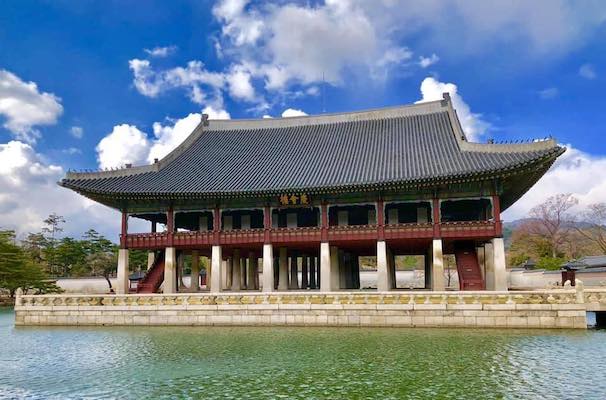
The Japanese dismantled what remained of the palace during their occupation of Korea. Instead of the Korean palace, a faculty for Japanese citizens was built on the location. The South Korean government reconstructed around 33% of the palace under the rebuilding of the ‘five grand palaces’ initiative.
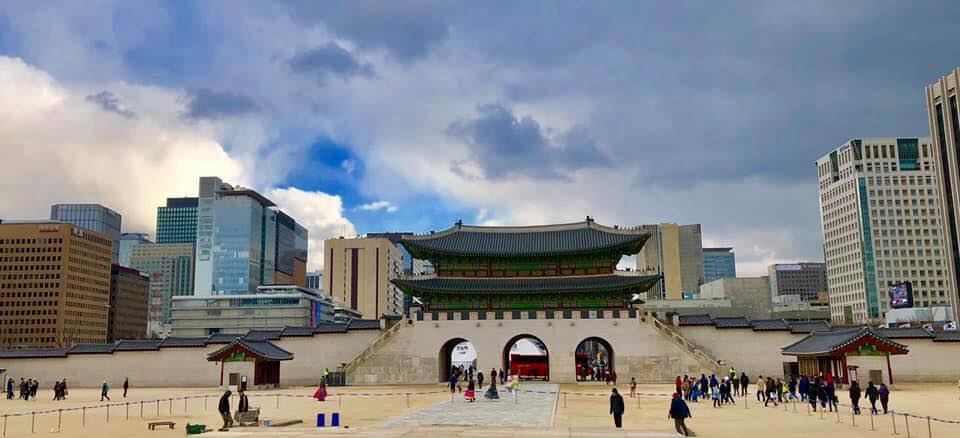
This Seoul palace sits beautifully on the lap of the surrounding mountain Iand. It holds proud traditional beauty in its design and is a significant part of Korea’s history.
Deoksugung Palace (덕수궁)
At Seoul’s most sedulous corner, lies the Deoksugung Palace. This Seoul Palace is a must-visit historical site while touring the magnificent city of Seoul.
Within the boundaries of this historical site, one will be fascinated to find the potpourri of contrasting architectural styles. It is world-famous for its beautifully carved stone-wall road and western-style inspired garden.
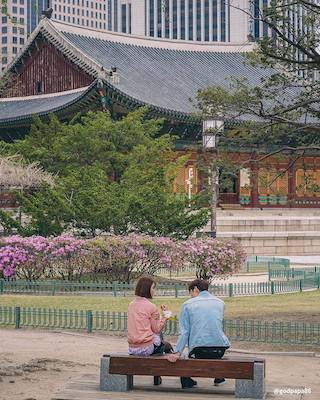
It is the only palace to feature a western-style garden, fountain, and a building. The name Deoksugung translates to ‘palace of virtuous longevity.’
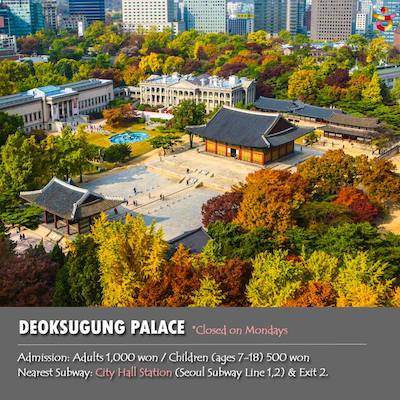
The other buildings with the enthralling mixture of two different types of architecture are the Jeonggwanheon pavilion and the Seokjojeon hall. While the palace encompasses a vast area with many buildings. The present palace grounds are just a little shadow of the former splendor, with only a few structures remaining.
Read more : Deoksugung Palace (덕수궁), Seoul
Changgyeonggung Palace (창경궁)
In the heart of this city lies the grand Changgyeonggung Palace built by the 4th ruler of the Joseon dynasty. This fifteenth-century Seoul palace was also known as “Donggwol” or the “East Palace” along with the Changdeokgung Palace.
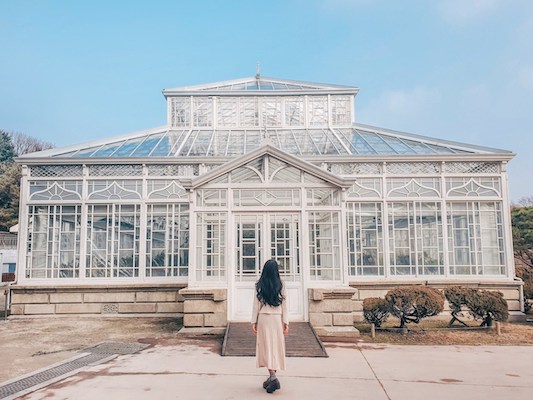
At the entrance stands the mighty Honghwa Gate, past which you will find Okcheongyo Bridge. Cross Okcheongyo Bridge, pass the Myeongjeongmun Gate, surrounded by beautiful gardens you’ll find three courts, Myeongjeongjeon being the main hall, will show you the best of Joseon architectural style. The most prominent building in Changgyeonggung Palace, Tongmyeongjeon, was built for the queen.
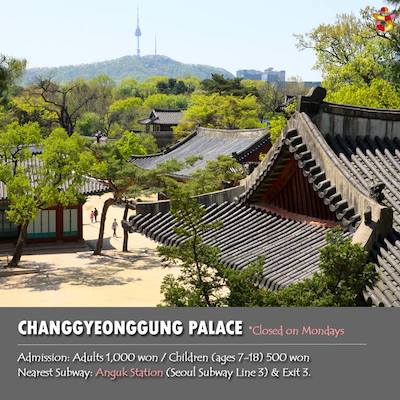
A lot of the original building of this Seoul palace was burnt in war and riots, but it is still a beautiful historical place.
Read more : Taegeukgi: The South Korean Flag – A Brief History
We hope you enjoy your trip to these five amazing grand Seoul palaces and feel free to share your South Korea travel story with us in the comments below. Happy traveling!
Love it? Pin it and save it for later!
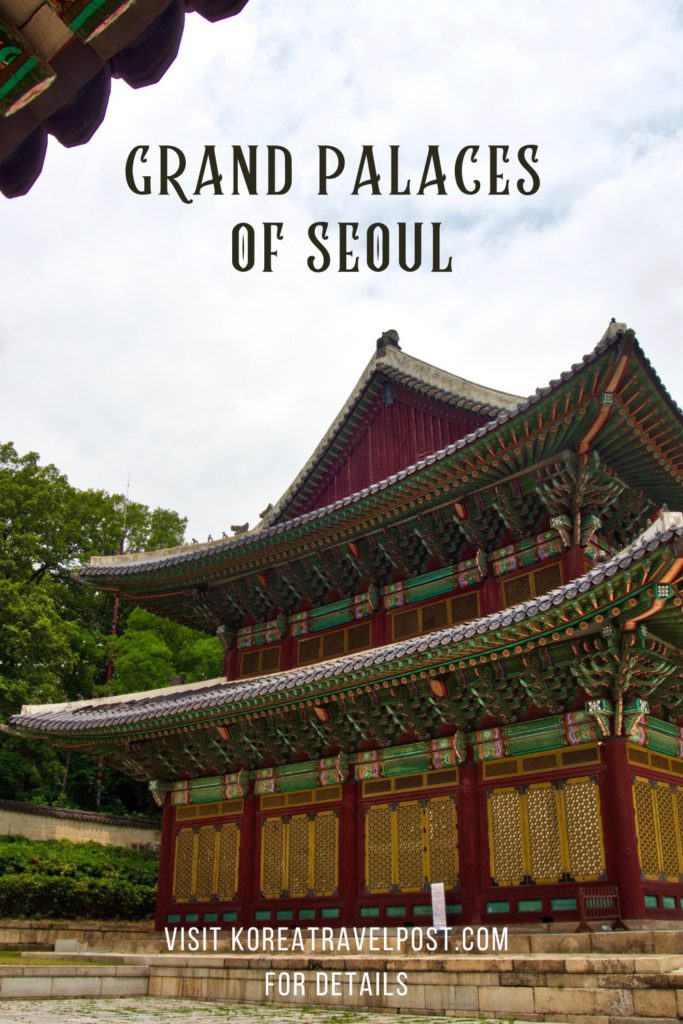

KoreaTravelPost Editor
Hello there! I'm the Features Editor for KoreaTravelPost.
Related Posts
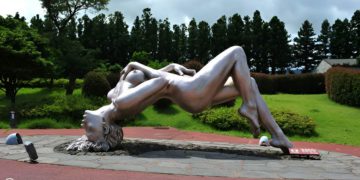
Jeju Love Land: Most Popular Sex-Themed Travel Destination for ADULT Only! Dare to Visit?
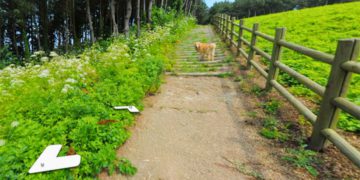
Jukdo’s Golden Guide: Dog Steals Hearts on Google Maps
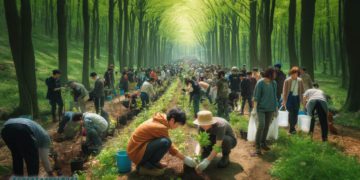
8 Places to Visit for Celebrating Singmogil in South Korea
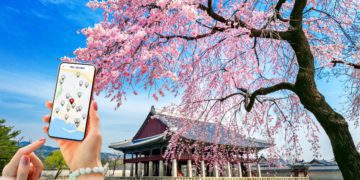
Cherry Blossoms & No Crowds? A. AI Reveals Best Times & Spots!

Explore Suwon’s Unique Fusion of Modernity and Tradition on the Suwon XR Bus 1795 Tour

Everything You Need To Know About COEX Aquarium

South Korea Travel Guide - All You Need to Know About Korea's Voltage, Plug & Adapters
Leave a reply cancel reply.
Your email address will not be published. Required fields are marked *
Save my name, email, and website in this browser for the next time I comment.

TESSAN Germany France Travel Power Adapter

Lonely Planet Korea 12

Korean Snack Box Variety Pack

OSULLOC Lovely Tea Gift Box Set
More from our network.

- Medical Tourism
FREE NEWSLETTER
Copyright © 2024 About Us| Terms of Use |Privacy Policy| Cookie Policy| Contact : [email protected]
Login to your account below
Fill the forms bellow to register
Retrieve your password
Please enter your username or email address to reset your password.

All the insider's travel tips in Korea
The Five Grand Palaces in Seoul You Should Visit
If you are in Seoul , you cannot leave the city without visiting at least one of the grand palaces! They are all concentrated in the center of Seoul, Jongno-gu & Jung-gu, so you can easily explore these palaces. Learn more about the five palaces and also find out the fun activities you can enjoy nearby.
Check out Trazy’s Korean Palace Tour and get your all-access pass to the palaces in Seoul with the Korea Palace Gung Pass !
- Gyeongbokgung Palace
- Deoksugung Palace
- Changdeokgung Palace
- Changgyeonggung Palace
- Gyeonghuigung Palace
1. Gyeongbokgung Palace
- Address: 161, Sajik-ro, Jongno-gu, Seoul ( Kakao Map )
Instagram에서 이 게시물 보기 [H]ot [P]ictures [K]orea 🇰🇷(@hotpickorea)님의 공유 게시물
Gyeongbokgung Palace is the largest palace out of the five grand palaces in Seoul. Established in 1395, it is commonly referred to as the “Northern Palace” because it is located in the furthest north of Seoul compared to the neighboring palaces, Changdeokgung and Gyeonghuigung.
Enjoy the Night View of Gyeongbokgung Palace
Instagram에서 이 게시물 보기 Trazy – Korea’s #1 Travel Shop(@trazy_korea)님의 공유 게시물
The entrance fee to Gyeongbokgung Palace is only 3,000 won for people from 25 to 64 years old. If you rent a traditional Korean attire, hanbok, and wear it to the palace, the entrance is free of charge.
Check out the activities around Gyeongbokgung Palace:
- Modern Hanbok Rental & Photoshoot at Korean Traditional House or Gyeongbokgung Palace
- Seoul Travel Snap Photoshoot (Day/Night)
- Mastering Seoul in 1 Day Group Tour
- Gyeongbokgung Palace Half Day Tour
- Seoul Walking Tour: Gyeongbokgung, Seochon Village & Tongin Market
2. Deoksugung Palace
- Address: 99, Sejongdae-ro, Jung-gu, Seoul ( Kakao Map )
Deoksugung Palace is a small palace located near City Hall Station in Seoul. It’s also famous for its stone wall road. It used to be a place for Korean Empire after the Joseon Dynasty. The changing of the Royal Guard is a popular event that many visitors come to watch.
Enjoy the Night View of Deoksugung Palace
Instagram에서 이 게시물 보기 ᴊᴜɴ🇰🇷(ᴛᴇᴀᴍ sᴇᴏᴜʟᴅᴀʏs)(@bigg_jun)님의 공유 게시물
The entrance fee is only 1,000 won for those who are from 25 to 64 years old. There is the National Museum of Contemporary Art inside the palace where you can enjoy the exhibitions. You have to pay an extra fee for the exhibition. You can enter the palace for free if you wear a hanbok like Gyeongbokgung Palace!
Check out the activities around Deoksugung Palace:
- Deoksugung Palace Half Day Tour
- Seoul Walking Tour: Gyeonghuigung & Deoksugung Palace
- Learn How to Draw with Sand near City Hall Station, Seoul
3. Changdeokgung Palace
- Address: 99, Yulgok-ro, Jongno-gu, Seoul ( Kakao Map )
Changdeokgung Palace is a UNESCO Cultural Heritage and it’s a palace where kings used to stay the longest. There is a Secret Garden called ‘Biwon’ within Changdeokgung Palace, which is renowned for its beautiful garden. The best time to see the garden is during the spring and fall since you can witness the stunning red plum blossoms or orange autumn foliage.
Enjoy the Night View of Changdeokgung Palace
The entrance fee for adults of more than 18 years old is 5,000 won and for youth from 7 to 18 years old is 2,500 won. Moonlight Tour at Changdeokgung Palace is also something that you shouldn’t miss out on. You’ll be allured by the magical dazzling lights of the palace and the garden at night!
Check out the activities around Changdeokgung Palace:
- Bukchon Hanok Village Walking Tour
- Traditional Knot Ornament Making Experience in Bukchon Hanok Village
- DIY Mother-of-Pearl Experience in Bukchon Hanok Village
- Kimchi Making Class in Bukchon Hanok Village
4. Changgyeonggung Palace
- Address: 185, Changgyeonggung-ro, Jongno-gu, Seoul ( Kakao Map )
Instagram에서 이 게시물 보기 조선의 사진가_나인(🇰🇷)(@hc_nain)님의 공유 게시물
Changgyeonggung Palace was built in 1483 by King Sejong for his retiring father, King Taejong. During special public holidays in Korea, such as Chuseok (Korean Thanksgiving Day), the palace hosts traditional games and activities for visitors.
Instagram에서 이 게시물 보기 Ploy 📍 Seoul(@ployslittleatlas)님의 공유 게시물
During the Japanese colonial period, it became a park with a zoo and a botanical garden in 1909. It’s called Grand Greenhouse , which is Korea’s first greenhouse designed in a Western architectural style. It was restored in 2004 and opened to the public so that people can enjoy different types of plants.
Enjoy the Night View of Changgyeonggung Palace
Instagram에서 이 게시물 보기 @qing_e0329님의 공유 게시물
The entrance fee for Changgyeonggung Palace is 1,000 won. A breathtaking night visit is also available at Changgyeonggung Palace until 9pm.
Check out the activities around Changgyeonggung Palace:
- Changgyeonggung Palace Night Tour with Food & Makgeolli (Arriving Soon)
- Seoul Night Group Tour: Gwangjang Market + Changgyeonggung Palace + Naksan Park
- Discover Seoul Pass (24/48/72 – Hour Pass)
- Nanta (Traditional Korean Percussion) Experience in Daehak-ro, Seoul
5. Gyeonghuigung Palace
- Address: 45, Saemunan-ro, Jongno-gu, Seoul ( Kakao Map )
Gyeonghuigung Palace was built in 1620 and has served as the residence of kings for 28 years since 1624. It was officially recognized as a royal villa during the Joseon Dynasty. Unfortunately, most of them were burnt down during the Japanese colonial period. The Seoul city government decided to restore the palace in 1985, however, only 33% of the former palace was reconstructed because there wasn’t much space left due to urban growth. You can enter the palace for free.
Check out the activities around Gyeonghuigung Palace:
- Seoul Pedicab Ride Tour
- Private Seoul City Tour – 1 Day Private Van Tour
Check out more latest, trendiest, and newest things to do in Korea on Trazy.com , Korea’s #1 Travel Shop !

Leave a Reply Cancel reply
Your email address will not be published. Required fields are marked *
This site uses Akismet to reduce spam. Learn how your comment data is processed .
- All about SIM Card
- All about WiFi
- Korea Travel Itineraries
- Getting Around Korea
- National Holidays
- Top 10 Things to Do
- Deoksugung Palace & Jeongdong Walking Tour
- Secret Garden & Bukchon Hanok Village Walking Tour
- Seoul K-drama Shooting Spots Walking Tour
- Namsan Park & N Seoul Tower Evening Hiking Tour
- Seoul City Wall & Ihwa Mural Village Walking Tour
- Seochon Village Walking Tour
- Seoul Hiking Tour: Inwangsan & Bugaksan
- Everland Guide
- Everland Ticket & Packages
- Lotte World Guide
- Discount Tickets
- Han River Cruise Guide
- Han River Cruise Ticket
- Hanbok Rental Service
- Hanbok Rental Guide
- Nami Island Guide
- Nami Island Tours
- The Garden of Morning Calm
- DMZ & JSA
- DMZ & JSA Tours
- Mt. Seoraksan
- Jeju Popular Attractions
- Busan Popular Attractions
- Rest of Korea
- Cherry Blossoms
- Spring Must-Dos
- Water Activities
- Summer Must-Dos
- Autumn Foliage
- Autumn Must-Dos
- Ski & Snowboard
- Winter Must-Dos
- Festivals & Events
- K-Pop & K-Drama
- K-Beauty Guide
- Visit Trazy.com
- General Tips
- Beauty, Hair & Skin Care Service
- Korea Shopping Guide
- Food & Restaurant Guide
- Cooking Class & Food Tours
- Survival Tips
Related Post
Best cafes in seoul run by korean fashion brands, 10 best things to do along the han river in seoul, ultimate guide to weekly k-pop music shows, seoul & jeju island tavel guide | 7-day itinerary, top 3 restaurants & cafes for date night in seoul, 7 romantic date spots & ideas in seoul.
- Go to the menu
The Visit Seoul website uses cookies to enhance the user experience, improve the website, and more.
Continuing use of this website means that you agree to the use of cookies.
- Seoulite's Picks
- Exhibitions
- Smart & Safe Seoul Travel
- Facebook logo icon Instagram logo icon YouTube logo icon TikTok logo icon
Gyeongbokgung Palace
Select a region.
Save travel information you're interested in according to the region to view in your favorites list later on.
SNS Share Content!
- Facebook Link
- Share to twitter
Gyeongbokgung Palace was the first and largest of the royal palaces built during the Joseon Dynasty. Built in 1395, Gyeongbokgung Palace was located at the heart of the newly appointed capital of Seoul (then known as Hanyang) and represented the sovereignty of the Joseon Dynasty. The largest of the Five Grand Palaces (the others being Gyeonghuigung Palace, Deoksugung Palace, Changgyeonggung Palace, Changdeokgung Palace), Gyeongbokgung served as the main palace of the Joseon Dynasty.
The Korean government has invested much time and effort into rebuilding, restoring, and maintaining the palace for future generations. These efforts include work to rebuild and restore the buildings that were destroyed during the Japanese occupation. Visitors to Gyeongbokgung can also visit the National Palace Museum of Korea and the National Folk Museum of Korea as they are located on the palace grounds.
To increase ease of accessibility from Gyeongbokgung Palace to Seochon and vice versa, the palace's western gate, Yeongchumun, was opened to the public on December 2018. For the past 43 years, there were only 3 entrances to Gyeongbokgung Palace - the southern gate Gwanghwamun, the northern gate Sinmumun, and the eastern entrance of National folk Museum of Korea. However, with the opening of the western gate Yeongchumun, entry to the palace from all directions has been now made possible.

Directions Details
#SeoulAttractions #GyeongbokgungPalaceAdmissionFee #KoreanTradition #GyeongbokgungPalace #SeoulTravel #SeoulPalace #SeoulAttractions #SeoulTouristAttractions #KoreanHistoricSites #SeoulOuting #KoreanCulture #SeoulDate
Association recommendation information
- 2024 Gyeongbokgung Starlight Tour Embark on an evening journey to immerse yourself in the history, culture, and landscaping of Gyeongbokgung Palace. Indulge in royal cuisine at the palace's Sojubang and receive insights into the north
- 2024 Spring K-Royal Culture Festival It is Korea's largest cultural heritage festival, offering a rich array of traditional cultural experiences set against the stunning backdrop of palaces.
- Changing of the Royal Guard at Gyeongbokgung Palace A must-see among Seoul's tourist attractions, this ceremony is a great opportunity to experience a rare traditional scene in Korea, as the ceremony is reenacted exactly as it used to be held, with guards wearing royal uniforms, carrying traditional weapons and playing traditional instruments.
- National Palace Museum of Korea The National Palace Museum of Korea showcases 500 years of history with roughly 45,000 artifacts from the Joseon Dynasty.
- 장기 폭염 예상 기간 프로그램 운영 중단: 7.23. ~ 8.11.
- 예약은 관광일 기준 최소 3일 전 까지 가능합니다.
- 3인 미만은 예약이 취소될 수 있습니다.
- 기존 등록된 예약 중 그룹별 정원을 초과하지 않는 예약에 한하여 1일 전 17시 까지 추가 예약 가능합니다.
- 다음달 예약은 전달 15일 이 후부터 가능합니다.
- 발열 또는 호흡기 증상(열, 기침, 가래, 근육통, 코막힘, 인후통 등)이 있는 경우 프로그램 참여를 삼가하여 주시기 바랍니다.
- 보호자가 동반하지 않는 만 14세 미만의 아동 관광객의 경우 현장에서 취소됩니다.
- 기상특보(폭염, 태풍, 호우, 미세먼지 등)로 인해 도보관광 운영이 어려운 경우 모든 예약은 일괄 취소됩니다. (발효 즉시 취소처리) ※예약 당일 기상특보를 상시 확인 바랍니다.
- 해설 진행 시 발생하는 안전사고에 대해서 서울도보해설관광 사무국과 서울문화관광해설사는 책임을 지지 않습니다.
- 한국어를 모국어로 사용하는 대한민국 국민의 경우, 외국어 해설 신청이 불가능합니다.
- 예약은 관광일 기준 최대 5개월 전부터 최소 5일 전 까지 신청 가능합니다.
- 희망하시는 날짜 및 코스에 활동가능한 해설사가 없는 경우 예약은 취소될 수 있습니다.
- 특히 주말 및 공휴일, 봄(4~5월) 가을(9~11월) 성수기에는 예약이 조기마감 되오니 이 점 유의하여 주시기 바랍니다.
- 예약확인을 위해 도보관광 사무국(02-6925-0777)에서 확인 연락이 진행됩니다. (최소 5일~한달 전)3회 이상 전화통화가 이뤄지지 않을 시 예약이 취소될 수 있습니다.
- 경복궁, 창덕궁, 창경궁, 덕수궁 35인 이상 관람 시, 해당 궁궐 사이트에서 15일 전 단체 입장신청이 필요합니다. (2014.1.1.부터 시행)
- 해설 진행 시 발생하는 안전사고에 대해서 도보관광 사무국과 서울문화관광해설사는 책임을 지지 않습니다.
- 예약은 관광일 기준 최소 1주일 전까지 가능합니다.
- 덕수궁의 경우 복지카드를 지참한 관광객에 한하여 무료입장이 가능합니다. ※ 중증(1~3급) 동반인 포함 2명 무료※ 경증(4~6급) 장애인 본인 1인만 무료
- 보호자 또는 보조자가 동반하지 않을 경우 이용이 불가능 합니다.※ 별도의 보조자가 없는 경우 사무국으로 문의 바랍니다. (02-6925-0777)
- 예약확인을 위해 도보관광 사무국(02-6925-0777)에서 확인 연락이 진행됩니다.(최소 5일~한달 전)3회 이상 전화통화가 이뤄지지 않을 시 예약이 취소될 수 있습니다.
- 덕수궁의 경우 복지카드를 지참한 관광객에 한하여 무료입장이 가능합니다. ※ 중증(1~3급) 동반인 포함 2명 무료 ※ 경증(4~6급) 장애인 본인 1인만 무료
- 본 프로그램은 수화해설 중심으로 진행되며, 수화가 불가능한 경우 이용이 불가합니다.
- 본 코스는 보행약자(거동이 불편한 고령자, 장애인, 유모차 이용자 등)를 위한 코스입니다.
- 보호자를 동반하지 않을 시 이용이 불가능 합니다.※ 보행약자 1명당 보호자 최소 1인 이상 동반 ※ 전동보장구(전동휠체어, 전동스쿠터 등) 사용자의 경우 보호자 1인당 보행약자 최대 4인까지 동반 가능 희망하시는 날짜 및 코스에 활동가능한 해설사가 없는 경우 예약은 취소될 수 있습니다.
- 미세먼지 비상저감조치 발령 및 기타 기상악화(폭염, 태풍, 폭우 등)로 인해 도보관광 운영이 어려운 경우 모든 예약은 일괄 취소됩니다. (관광일 전날 기준)
- Reservations must be made at least three days prior to the tour date.
- Additional reservations, one or two days before the tour starts, are only allowed for the tour that is already fixed.
- In the case of group tour, more than 10people, please contact us by e-mail.
- Reservations for the following month are available from the 15th of the current month.
- Please refrain from participating in any tour programs should you be experiencing any symptoms, including fever, coughing, congestion, muscle pain, stuffy nose, and/or sore throat.
- Reservations for tourists 14 years & under without an accompanying adult or guardian shall be canceled on site.
- All reservations will be canceled in the event of a weather warning being issued. (e.g. heatwave, typhoon, heavy rain, fine dust, etc.) (Cancellation will be processed immediately upon implementation) ※ Please always check the weather warning on the day of the reservation on the site below. (https://www.accuweather.com/en/kr/seoul/226081/weather-forecast/226081)
- The Seoul Guided Walking Tour administration office and tour guide affiliates are not responsible for any accidents that happen to occur during the tour program.
- Reservation shall be made at least 1 week before the tour day.
- The course is for tourists with mobility problems (Senior, people with disability, stroller user).
- Reservation may be canceled when a guide is unavailable on the desired date and course.
- Seoul Guided Walking Tour Office (02-6925-0777) will contact you to confirm reservation. (At least 5 days~1 month before tour day) Reservation may be canceled when Seoul Guided Walking Tour Office cannot reach you for more than 3 times.
- Seoul Guided Walking Tour Office and Seoul culture and tourism guide are not liable for the safety accidents during the Seoul Guided Walking Tour.
- 予約は観光予定日を基準に3日前までとさせて頂きます。
- 個人予約:最大10名 ※京福級、昌徳宮、昌慶宮は20名様までご予約頂けます。
- 既にご予約されたコースの中で、グループ別の定員を超えない予約に限り、観光予定日の1日前の17まで追加での予約が可能です。
- 翌月のご予約は前月の15日から可能です。
- 発熱または呼吸症状(熱、咳、痰、筋肉痛、鼻づまり、喉の痛みなど)がある場合は、解説プログラムへのご参加はお控えください。
- 保護者を同伴しない14歳未満の児童観光客は、現場でキャンセルとなります。
- 気象特報(猛暑、台風、豪雨、PM2.5)によりウォーキングツアーの運営が難しいと判断された場合、全ての予約は中止とさせて頂きます。 (発効後直ちにキャンセルを行う) ※ 下記のリンクにてご予約当日の気象特報をご確認ください。 (https://www.accuweather.com/ja/kr/seoul/226081/weather-forecast/226081)
- 観光中に発生する安全事故について、ソウル徒歩解説観光事務局とソウル文化観光解説士は責任を負いません。
- 予約は観光日を基準として少なくとも1週間前まで可能です。
- 本コースは、 移動弱者(移動が不自由な高齢者、障害者、ベビーカー利用者など) のためのコースです。
- 補助人(或いは同行人)を伴わない場合は利用できません。 ※歩行弱者1人当たり少なくとも1人以上の補助人を伴う ※電動補助具(電動車椅子、電動スクーターなど)使用者の場合、補助人1当たり歩行弱者最大4人まで同伴可能
- ご希望の日付及びコースに活動可能な解説士がいない場合、予約はキャンセルされることがあります。
- 予約を確認するため、徒歩観光事務局(02-6925-0777)で確認のための連絡が行われます。 (少なくとも5日~1ヶ月前)3回以上電話が通じない場合、予約が取り消されることがあります。
- 解説を進行する時に発生する安全事故に対し、徒歩観光事務局とソウル文化観光解説士は 責任を負いません。
- 观光日基准最少3日前方可进行预约。
- 最多可申请10人。 (※ 景福宫, 昌德宫, 昌庆宫是例外 最多可申请20人)
- 在已登记的预约团体中,只接待不超过预约人数的团体,可在前一天17时前追加预约。
- 下个月的预约可从前一月15日开始。
- 如有发热或呼吸道症状(发烧、咳嗽、痰液、肌肉痛、鼻塞、咽喉痛等),请避免参与解说活动。
- 无保护者随同的未满14岁儿童游客,会在现场取消解说活动。
- 气象特报(酷暑、台风、暴雨 、雾霾 等)导致徒步观光项目暂停时,所有预约将一律被取消。 (发布紧急措施时立即取消) ※ 请在以下网站上随时确认预约当天的气象特报。 (https://www.accuweather.com/zh/kr/seoul/226081/weather-forecast/226081)
- 对于解说活动中发生的安全事故,首尔徒步解说旅游事务局和首尔文化观光解说社不予负责。
- 观光日基准最少1日前方可进行预约。
- 本线路是为了行动不便者(行动不便的高龄者、残疾人、婴儿车利用者等)的路线。
- 无辅助人员(或同行人)伴随时,不可利用。 ※ 步行不便者1名至少需要1名以上的辅助人员陪同。 ※ 电动辅助器具(电动轮椅、电动独轮车等)使用者时,每一位辅助人员最多可陪同 4名步行不便者。
- 希望观光的日期及线路上无解说员时,预约有可能被取消。
- 为了确认预约,徒步观光事务局(02-6925-0777)会致电进行确认。 (最少5日~一个月前) 3次以上无法连接时,预约将被取消。
- 进行解说时,对于有可能发生的安全事故,徒步观光事务局和首尔文化观光解说员概不负责。
- 最晚請於預約日期3天前完成預約。
- 最多可申請10人。 (※ 景福宮, 昌德宮, 昌慶宮是例外 最多可申請20人)
- 已完成預約的團體若人數超過限制,可於前一天下午5點前追加預約。
- 每月15日將開放下個月的預約。
- 若有發燒或呼吸道症狀(發燒、咳嗽、咳痰、肌肉酸痛、鼻塞、喉嚨痛),請避免參與本活動。
- 未有保護者同行的未滿14歲兒童遊客,會在現場取消參與資格。
- 氣象特報(酷暑、颱風、暴雨 、霧霾 等)而導致徒步觀光無法進行時,將一律取消所有預約。 (發布限令時將立即取消) ※ 請在以下網站上隨時確認預約當天的氣象特報。 (https://www.accuweather.com/zh/kr/seoul/226081/weather-forecast/226081)
- 進行解說時,對於有可能發生的安全事故,首爾徒步解說觀光事務局和首爾文化觀光解說員概不負責。
- 觀光日基準最少1日前方可進行預約。
- 本線路是為了行動不便者(行動不便的高齡者、殘疾人、嬰兒車利用者等)的路線。
- 無輔助人員(或同行人)伴隨時,不可利用。 ※ 步行不便者1名至少需要1名以上的輔助人員陪同。 ※ 電動輔助器具(電動輪椅、電動獨輪車等)使用者時,每壹位輔助人員最多可陪同 4名步行不便者。
- 希望觀光的日期及線路上無解說員時,預約有可能被取消。
- 為了確認預約,徒步觀光事務局(02-6925-0777)會致電進行確認。 (最少5日~壹個月前) 3次以上無法連接時,預約將被取消。
- 進行解說時,對於有可能發生的安全事故,徒步觀光事務局和首爾文化觀光 解說員概不負責。

16 Top-Rated Tourist Attractions in Seoul
Written by Freddy Sherman Updated Dec 23, 2023 We may earn a commission from affiliate links ( )
Author Freddy Sherman has visited South Korea multiple times, most recently exploring Seoul and the DMZ in 2022.
Seoul, South Korea is a vibrant and exciting city, one that deftly combines ancient history with ultra-modern design and technology. This city is filled with a wide range of fun things to do and tourist attractions of all types, from outdoor adventures like exploring Mount Namsan and its surrounding park to indoor fun like visiting one of Seoul's many museums.
Seoul is also a city of palaces, with five huge palace complexes located throughout the city and now restored to their former glory. Of course, it's also known for its food, with a mouthwatering array of street food, Korean specialties like barbecue, and even fine-dining options.
Discover the best places to visit in this exciting city with our list of the top attractions and things to do in Seoul.
1. N Seoul Tower
2. explore the bukchon hanok traditional village, 3. national museum of korea, 4. lotte world tower, 5. visit the dmz, 6. gyeongbokgung palace, 7. seoul museum of art, 8. blue house, 9. bongeunsa temple, 10. gwanghwamun gate, 11. take a walk along cheonggyecheon, seoul's urban stream, 12. jingwansa temple, bukhansan national park, 13. people watch in itaewon, 14. dongdaemun design plaza, 15. gwangjang market, 16. spend a sunday in insadong, where to stay in seoul for sightseeing, map of attractions & things to do in seoul, seoul, south korea - climate chart.
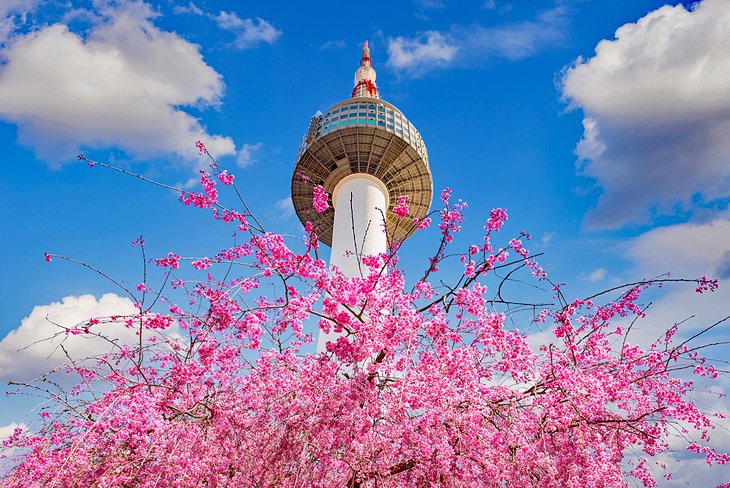
Rising almost 500 meters above the city, this communications and observation tower provides dramatic views of the city from its perch on the side of Mount Namsan. A cable car whisks you up the side of the mountain to the base of the tower. From here, you can go up in the tower and visit any one of four observation decks, one of which is a rotating restaurant.
There are five different dining experiences at the N Seoul Tower and, of course, several gift shops. The n.GRILL, on the top level, is considered one of Seoul's best French fine-dining restaurants. Be sure to visit the new Inside Seoul immersive media art exhibition, where 40 laser projectors create a virtual display of the city via five-dimensional mapping, with the tower at the center.
The views from the tower are great, but so are the views of the tower from most parts of the city. Computer-controlled LED lighting on the exterior of the tower provides a digital, visual cultural experience of Seoul with changing themed lighting presentations.
Address: 105 Namsangongwon-gil, Yongsan 2(i)ga-dong, Yongsan-gu, Seoul
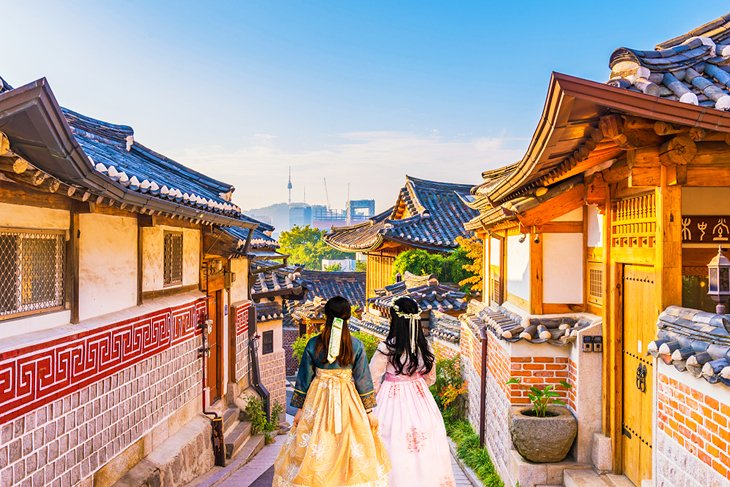
For a taste of Korean traditional culture and architecture, a visit to the Bukchon Hanok Village is a fun and educational way to spend an afternoon. This preserved district of several ancient neighborhoods gives you a feel for what it was like to live in Korea 600 years ago. It's right in central Seoul, in the area between the Gyeongbokgung Palace and the Changdeokgung Palace.
The neighborhoods of narrow streets feature hanoks or traditional Korean houses. It's a unique place, as it's a historic area, very popular with tourists, but it's also a real neighborhood because the houses are all occupied.
Some of the hanoks are now guesthouses and bed-and-breakfasts , and a few are museums and can be toured. Others are cultural centers showcasing traditional crafts and other historic aspects of Korean life, but most are private homes.
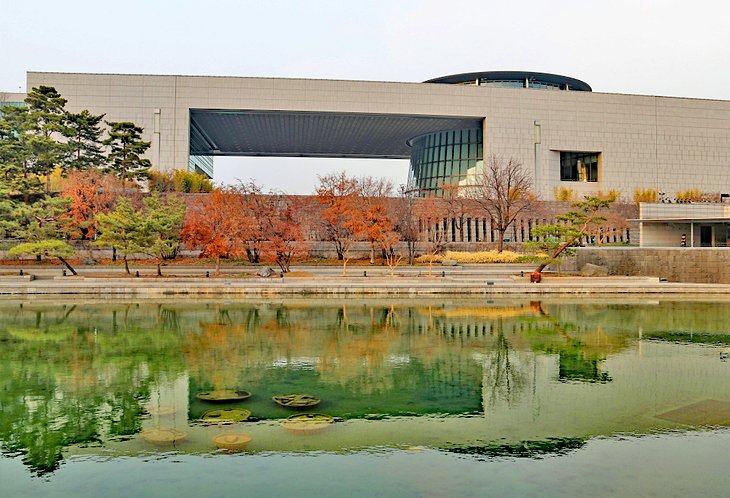
This must-see attraction in Seoul showcases the incredible history and artwork of Korea and the Korean people. The National Museum of Korea , one of the largest in Asia, is in the city's Yongsan District (close to Itaewon).
It focuses on archeology, history, and art and includes a vast collection of works and objects going back more than a million years. There are ancient and prehistoric artifacts, sculptures, paintings, and other artwork along with a large collection of objects and antiques.
Before or after your museum visit, head down the street to Yongsan Family Park , a nice outdoor space to relax. Another important museum worth a visit, The War Memorial of Korea is also close by.
Address: 137 Seobinggo-ro, Seobinggo-dong, Yongsan-gu
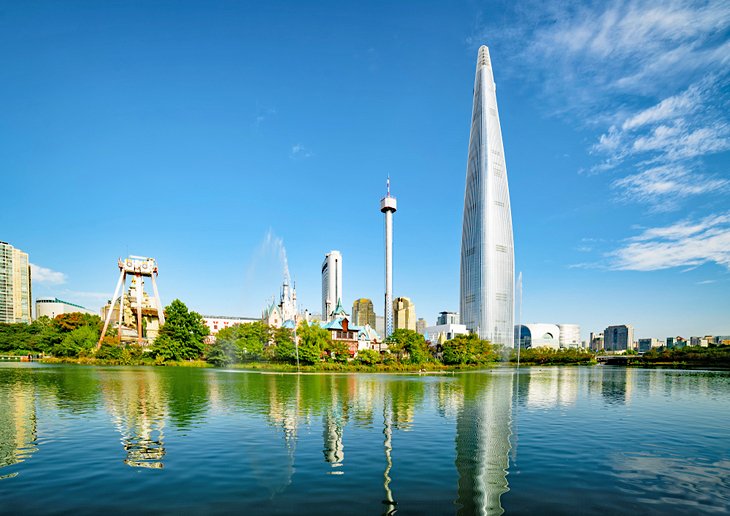
One of the newest attractions in Seoul is the Lotte World Tower skyscraper. The tallest building in South Korea, it's 500 meters above the ground and currently the fifth-tallest building in the world . The vase-like shape, with gentle curves, is designed to mimic traditional Korean ceramic pieces.
There are several indoor and outdoor observation areas (called Seoul Sky) at the top on the 117th-123 rd floors. Views are spectacular both during the day and at night, and you can see 360 degrees around the city.
On the 118 th floor, there's the Sky Deck with the world's highest glass floor. Like magic, the floor changes from opaque to clear, terrifying unsuspecting visitors. Even getting to the top is fun, and the journey is done via super fast, double-decker elevators, with windows on one side and LED screens on the other three and on the ceiling.
Inside the tower are offices, luxury residences, and the SIGNIEL SEOUL luxury hotel. There's also the Lotte World Aquarium, the Lotte Museum of Art, and an enormous shopping mall. The tower is home to the Lotte Concert Hall and the Lotte Cinema, a state-of-the-art, 21-screen MoviePlex with the world's largest movie screen. The tower is adjacent to the Lotte World amusement park, which is a great thing to do in Seoul for families.
Address: Songpa-gu, Jamsil 6(yuk)-dong, Olympic-ro, 300, Seoul
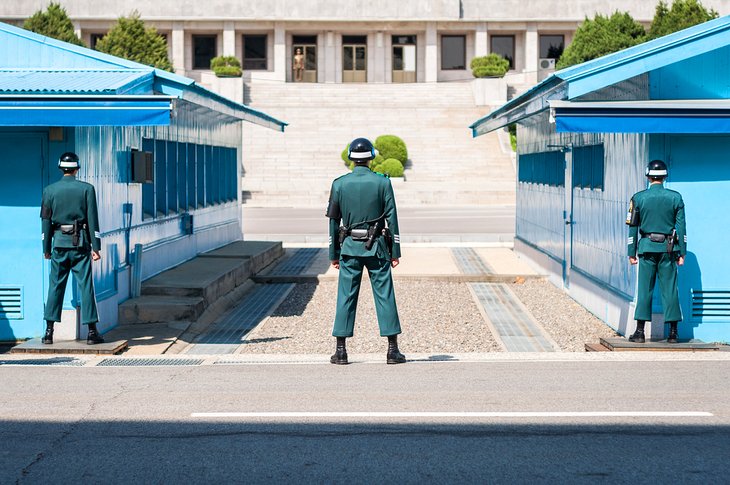
A remnant of the Korean War, the DMZ (Demilitarized Zone) is the area located along the border between North and South Korea. This highly sensitive and highly fortified area can only be visited during an official tour. Aside from the visit to the DMZ, a tour gives you a chance to get out of urban Seoul and see a bit of the Korean countryside.
The Half-Day Korean DMZ Tour , which includes pickup and drop-off in central Seoul, takes you to the important sites in the DMZ area and gets you back to Seoul right after lunch (if you take the early morning tour). The guided tour includes visits to landmarks like the 3rd Tunnel, dug by the North in anticipation of an invasion, and the Dora Observatory, where you can look over into North Korea.
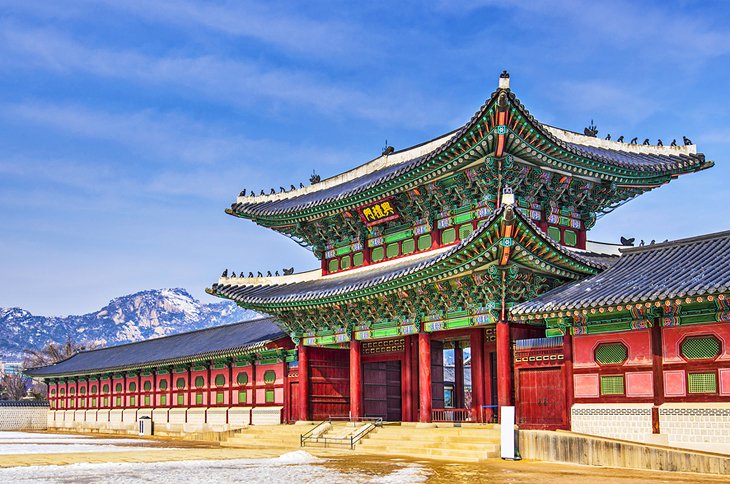
First built in 1395, Gyeongbokgung Palace is the largest of Seoul's five grand palaces built during the powerful Joseon dynasty. Destroyed and rebuilt several times over the centuries, it was restored to its original glory after the Second World War and totally restored in the 1990s.
A visit to the Gyeongbokgung Palace is one of the best things to do in Seoul because within the palace grounds, you can also find the National Palace Museum of Korea and the National Folk Museum of Korea , and both are worth a visit. The palace museum is especially fascinating as it presents items from the palaces of the Joseon Dynasty.
This includes priceless antiques and artwork, as well as everyday items for cooking, cleaning, and daily life. The National Folk Museum focuses on items from daily life, as well as clothing and dioramas, to tell the story of the Korean people since prehistoric times.
Address: 161 Sajik-ro, Sejongno, Jongno-gu, Seoul
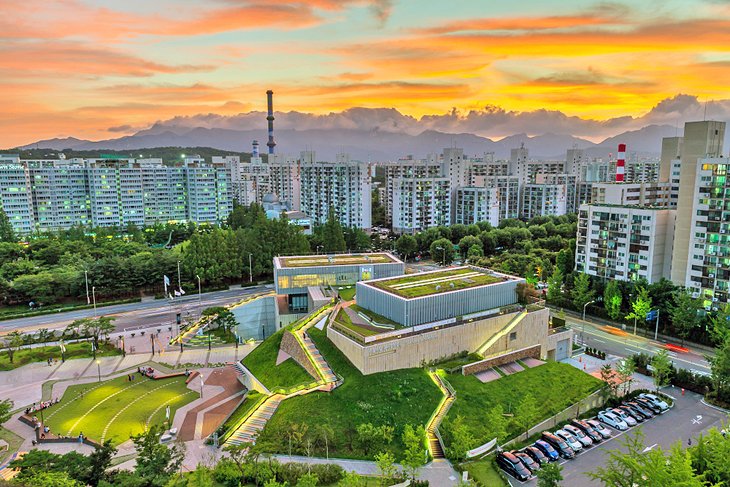
Located behind the Deoksugung Palace, the Seoul Museum of Art , or SeMa as it's known to locals, has a large collection of artwork, mainly from the modern era. The art museum focuses on Korean art and Korean artists but has a decent selection of international works and creators. Changing temporary and visiting exhibitions also showcase unique collections and artwork.
The collection is displayed over three floors in a large building that was formerly the home of the Korean Supreme Court. The museum has six additional satellite locations in other parts of Seoul, and these feature rotating exhibits from the museum's main collection, as well as special exhibitions.
Don't miss the museum's Nam June Paik Memorial House, an exhibition and workshop space inside the house of legendary Korean contemporary artist Nam June Paik. The house is located in Seoul's Changsin-Dong neighborhood.
Address: 61, Deoksugung-gil, Jung-gu, Seoul
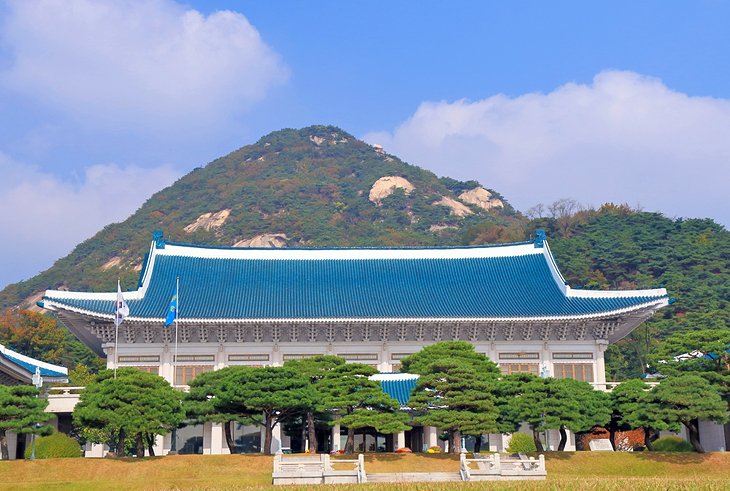
The Blue House is Korea's version of the White House. It's the official residence of the Korean president , as well as the location of his and related executive offices of state. The Blue House isn't really a single building, it's an entire campus of buildings, all built in the traditional Korean style and all featuring the distinctive blue tile roofs where it gets its name.
One of the coolest things to do in Seoul is to take a tour of the Blue House. Hour-long tours are given, but participants must apply and schedule their tour in advance, online. The tour takes you to many parts of the palace complex including meeting rooms, reception rooms, and the Korean version of the Rose Garden, where the Korean president holds press conferences.
Ask your hotel concierge to help with reservations.
Address: 1 Sejongno, Jongno-gu, Seoul
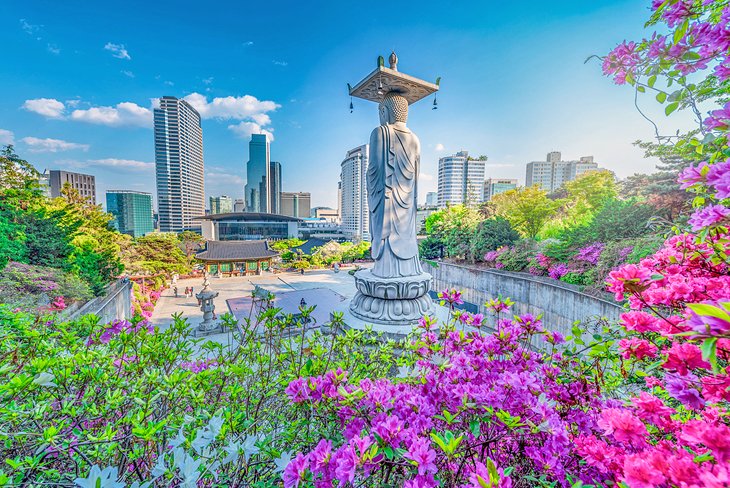
Bongeunsa is one of many Buddhist temples in and around Seoul. It first opened in the year 794 and is a complex of multiple buildings and shrines. It's easy to visit, as it's centrally located in the exciting Gangnam area. If you're spending the day sightseeing and exploring the city, this is a wonderful place to take a break.
The temple is on the side of a low mountain, directly across the street from the massive COEX convention center and mall. It's a popular spot for convention-goers to take a break and enjoy the peaceful atmosphere. Visitors are welcome, and the temple even has a program that allows guests to experience the daily life of a monk for a few hours.
Address: 531 Bongeunsa-ro, Samseong 1(il)-dong, Gangnam-gu, Seoul
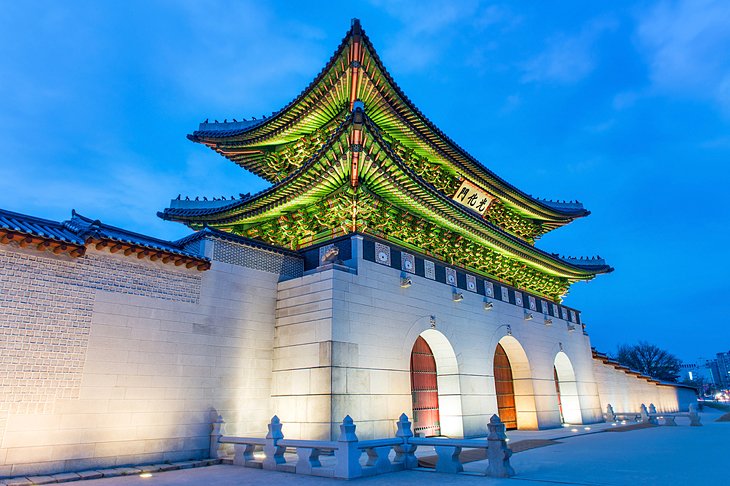
The largest and main gate to Seoul's Gyeongbokgung Palace , Gwanghwamun Gate is home to the changing of the guards ceremony (performed since 1469), which happens daily (except Tuesdays) at 10am and 2pm.
The gate has undergone many renovations and rebuilding, most recently in 2010, when it was restored to its original location and reconstructed with native materials using traditional tools and building techniques.
There's a large plaza in front, and the gate sits in front of the vast Gwanghwamun Square , home to frequent political demonstrations, a large subway station, a giant fountain, and some huge statues of Joseon-era leaders.
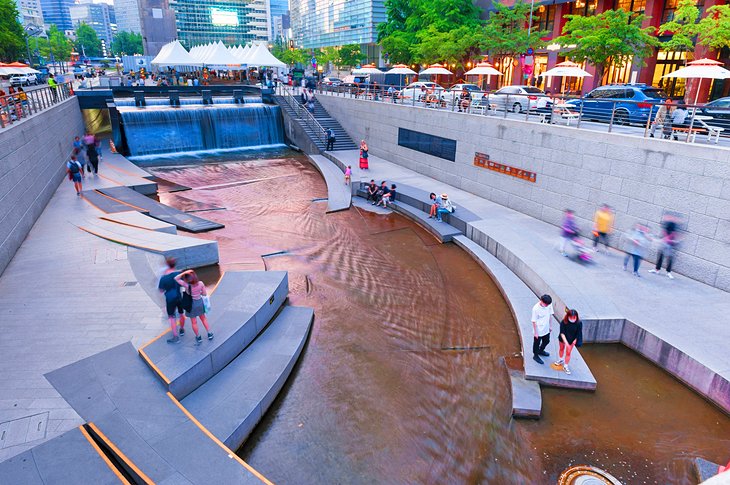
This natural creek that flows through central Seoul was covered over by highways in the post-Korean War economic boom. Seven miles of the creek were uncovered as part of an urban revitalization project and turned into an outdoor recreation area, opening in 2005.
There are now seven miles of creek-side hiking, walking and biking trails. It really has changed the CBD of Seoul by bringing an artery of water and green into what was a very urbanized, crowded area.
The creek is also home to the spectacular Seoul Lantern Festival , held each November. Ornate, lighted paper lanterns are displayed in and along the creek, and each night, thousands of people line the creek to view and enjoy the floating artwork. It's a fun, nighttime activity for families, as a lot of the art installations are geared toward children.
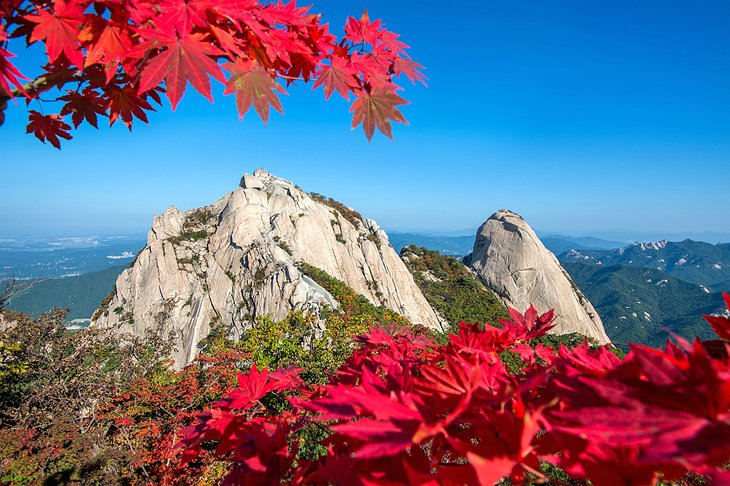
Set within the strikingly beautiful landscape of the Bukhansan National Park , Jingwansa is an ancient temple complex offering many ways to experience and learn about Buddhism and temple life. The traditional buildings are surrounded by miles of hiking trails (you can come here just to hike) snaking through the mountains.
The temple, which grows most of its own food (and even ferments its own kimchee), has a range of public programs. There's a temple stay program, which includes an overnight visit, plus there are cultural and learning programs. They also offer foodie experiences like a traditional vegetarian temple meal, as eaten by the monks.
Jingwansa is on the far west side of the city, it's one of the four major temples of Seoul first built around 1,000 BC.
Address: 73 Jingwan-gil, Jingwan-dong, Eunpyeong-gu, Seoul
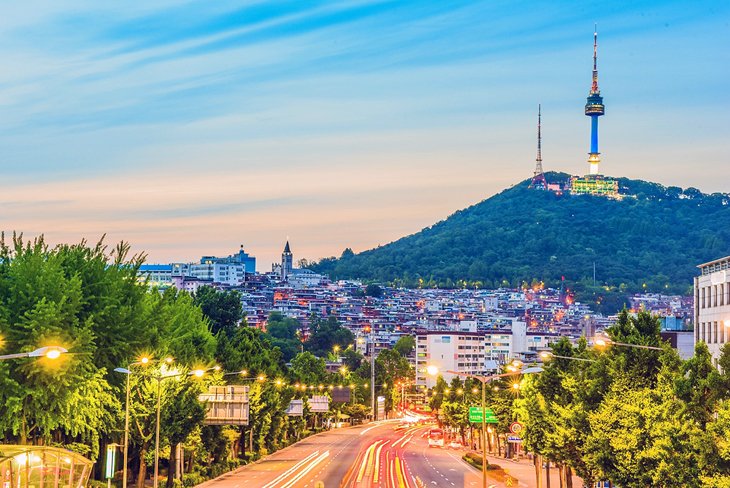
Itaewon is a bustling neighborhood of Seoul focused on a few pedestrian streets filled with shops, cafés, and other consumer businesses. If you have limited time in the city, it's one of those places that can give you a real feel for Korean retail culture in a short time period. There are food carts and street performers, and some of the side streets are filled with restaurants. It's a great place for people-watching.
This is an excellent place to wander around and just lose yourself in the energy of the city. Be sure to wander down pedestrian-only Gyeongnidan Street, as it's lined with all kinds of restaurants and is a place to buy many international foods not easily available in Korea (like pizza and American-style barbecue). It's a fun thing to do in Seoul for families, and you'll see many parents and children here.
Another street, literally called Itaewon Antique Furniture Street, is filled with antique shops, and this is always an excellent place to buy unique gifts.
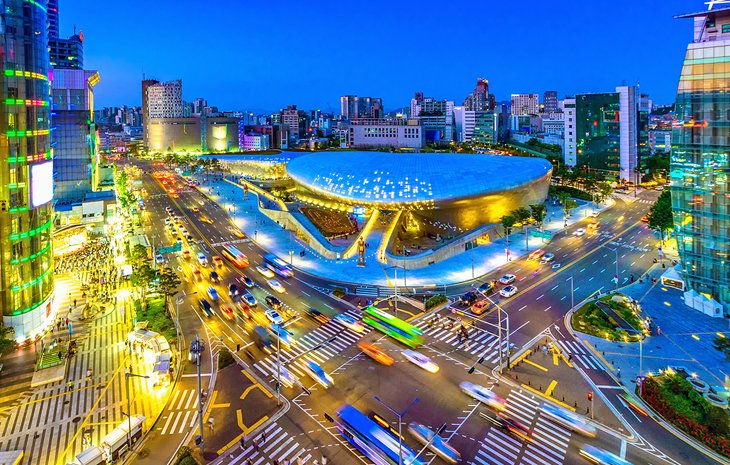
Known by its initials, the DDP is a very cool design center in Seoul's Dongdaemun area. Dongdaemun, Seoul's fashion district, is also known for its shopping; there are a lot of department stores and discount clothing and houseware stores in the area. The DDP has changing art and creative exhibitions open to the public, as well as a very cool store inside.
The silver, orb-like flowing Dongdaemun Design Plaza building looks like something from outer space. It was designed by the late Iraqi-British architect Zaha Hadid, considered one of the great female architects of the modern era. In perhaps Seoul's ultimate contrast, there are ruins of the ancient city fortress preserved just outside the front entrance of the design center.
The complex is filled with showrooms, workspaces, offices, and design studios. There is also what has to be Seoul's coolest shop, with small craft vendors selling all kinds of interesting items showcasing contemporary design and locally made, handcrafted items. It's an excellent place to buy unique gifts.
A visit to the DDP is one of the best things to do in Seoul at night — the design center comes alive when the sun goes down, the highlight being 25,550 white LED roses that light up. The silver-colored, modern, curving building and the rows of artificial flowers make the DDP one of Seoul's best Instagram spots.
After your visit, head across the street for a burger and crinkle-cut fries at one of Seoul's most popular new dining spots, Shake Shack. It's right across from the DDP in the Doota shopping mall.
Address: 281 Eulji-ro, Euljiro 7(chil)-ga, Jung-gu, Seoul
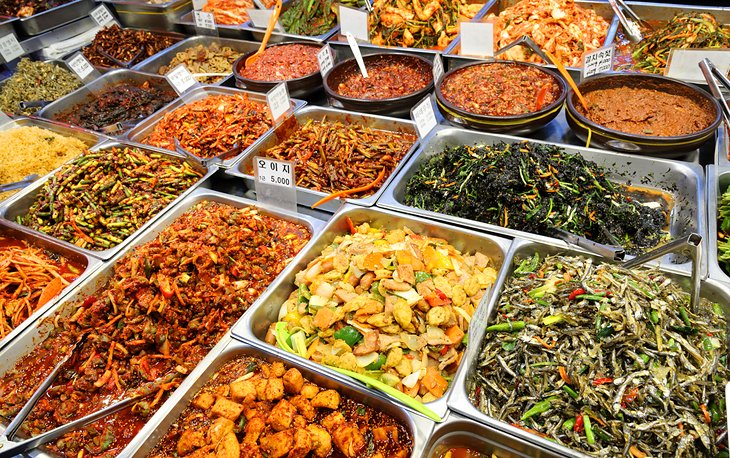
Seoul's best street food market combines a taste-bud tempting array of street food vendors under one large roof. The market features rows of food stalls, offering every kind of Korean food you can imagine.
Most stalls have small chairs or stools in front of them, creating tiny restaurants, where you can sit and have a meal. It's all about tasting things here, and a smile and request will usually get you a sample of most of the things on offer.
The market is in central Seoul, and it's open from 9am to 10pm. The most popular things sold here are bindaetteok (mung bean pancakes), bibimbap (rice mixed with sauteed beef, vegetables, and gochujang red chili paste), gimbap (Korean sushi), sundae (blood sausage), tteokbokki (stir-fried spicy rice cakes), and various types of noodles.
Other parts of the market have vendors selling meat and seafood, and other sections have clothes and household items.
Address: 88 Changgyeonggung-ro, Jongno 4(sa)-ga, Jongno-gu, Seoul
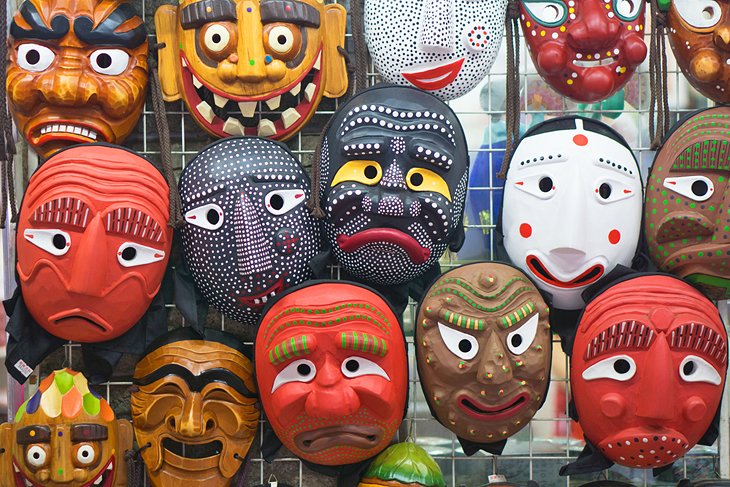
This unique neighborhood in central Seoul is filled with small stores that sell Korean traditional folk and handicrafts, along with art galleries. Stores sell things like hanji (traditional, hand-made paper), hanbok (traditional clothing), teas, pottery, and unique artwork.
The galleries in Insadong feature Korean fine art of all types. There are also a lot of tea houses and small cafes, perfect for a break during your shopping adventures.
The Insadong area really comes alive on Saturday afternoons and all day Sunday, when streets are closed to traffic and it becomes a giant craft and culture fair. Aside from food stalls and vendors, there are traditional music and dance performances and other cultural exhibits.
Luxury Hotels:
- Grand Mercure Ambassador Hotel and Residences Seoul Yongsan is one of Seoul's top 5-star resorts. Located in the heart of downtown, it offers a range of poshly decorated rooms and suites, all with stunning city views, especially after dark. Amenities include multiple restaurants, an indoor golf room, a fitness center, and spa. There is also a swimming pool, hot tub, and sauna. If you're traveling with the family, there is a kids' club, and if that family includes a dog, the hotel is pet friendly.
- Designed with relaxation in mind, SIGNIEL SEOUL has luxurious and comfortable rooms with beautiful decor. It's located high up in Seoul's Lotte World Tower, so the rooms and suites have some spectacular views. There are several restaurants in the hotel and a wide variety close by in the tower and mall complex below. Other on-site amenities include an indoor swimming pool and a hot tub and a spa with a full range of treatments. There is also a fitness center on-site.
- Four Seasons Hotel Seoul is the largest hotel in the South Korean capital city and the first in South Korea. The 5-star property has 317 rooms, including 43 suites, and all feature elegant luxe decor. Expect customizable beds with high-quality linens, spa-style bathrooms, and floor-to-ceiling windows with great city views. The hotel is family-friendly and has a kids' pool and a children's menu at its restaurants. Other amenities include a posh spa, a heated indoor swimming pool, an indoor golf driving range, and a fitness center.
Mid-Range Hotels :
- May Place Seoul Dongdaemun is a top mid-range choice. It offers a mix of rooms and suites that are spartan but comfortable, with wood floors and white linen-draped beds. They also come with air purifiers and blackout curtains. Amenities include a restaurant, a hot tub, and a rooftop terrace where you can check out the panoramic city and mountain views.
- In the middle of Seoul's cultural district, Hotel28 Myeongdong is another excellent good-value choice, especially if you like sleek and modern décor. The hotel has glass walls of windows and well-appointed rooms and suites. Amenities include a restaurant and workout room.
- GLAD Gangnam COEX Center Hotel has a convenient locale just outside Exit 1 of the Samseong Subway Station. Rooms feature contemporary décor, floor-to-ceiling windows, and giant wall-mounted flat-screen TVs. Amenities include a restaurant with a breakfast buffet, a workout room, and a 24-hour front desk.
Budget Hotels :
- Delight Hotel is a clean and comfortable budget choice with contemporary rooms featuring luxury linens, marble bathrooms with rain showers, and large windows. Amenities include a restaurant serving complimentary breakfast, 24-hour room service, a hot tub, and even rental bikes to explore the area.
- Also, try the Grid Inn Hotel for budget-friendly lodging. Centrally located in the Gwanak-Gu district, it offers tidy rooms with refrigerators, blackout curtains, and safes. There is a restaurant and coffee shop on-site. The front desk is open 24 hours, and there is self-service laundry for guests.
More Related Articles on PlanetWare.com
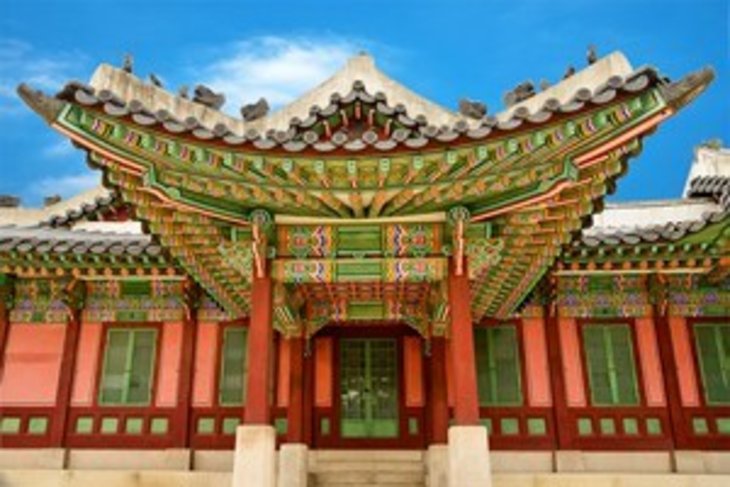
Beyond Seoul: While many of the country's highlights are in Seoul, have a look at our article on the top attractions in South Korea for ideas on places to visit throughout the country.

5 Beautiful Royal Palaces In Seoul: Info & Tips
Seoul has a perfect mix of history, culture, and tradition with the thrum of modern life. A brilliant way to peek into its illustrious past is to explore the majestic royal palaces in Seoul.
In this guide, I’ll show you the most stunning Seoul royal palaces, with information and tips you need to plan an unforgettable visit.
Useful tips for visiting Seoul palaces
The Seoul palaces are not just architectural wonders; they are windows that offer glimpses of South Korea’s vibrant past.
Here are some golden nuggets of advice to truly make your palace visit shine:
Opt for a guided tour
Don’t just admire the buildings; dive deep into their stories. Plenty of tour agencies and guides offer insightful anecdotes about Seoul’s palaces.
These tours often come with bonus visits to neighboring temples and museums, so you can soak in the city’s rich history in one swoop.
For example, you can join the Gyeongbokgung Palace and Bukchon Hanok tour .
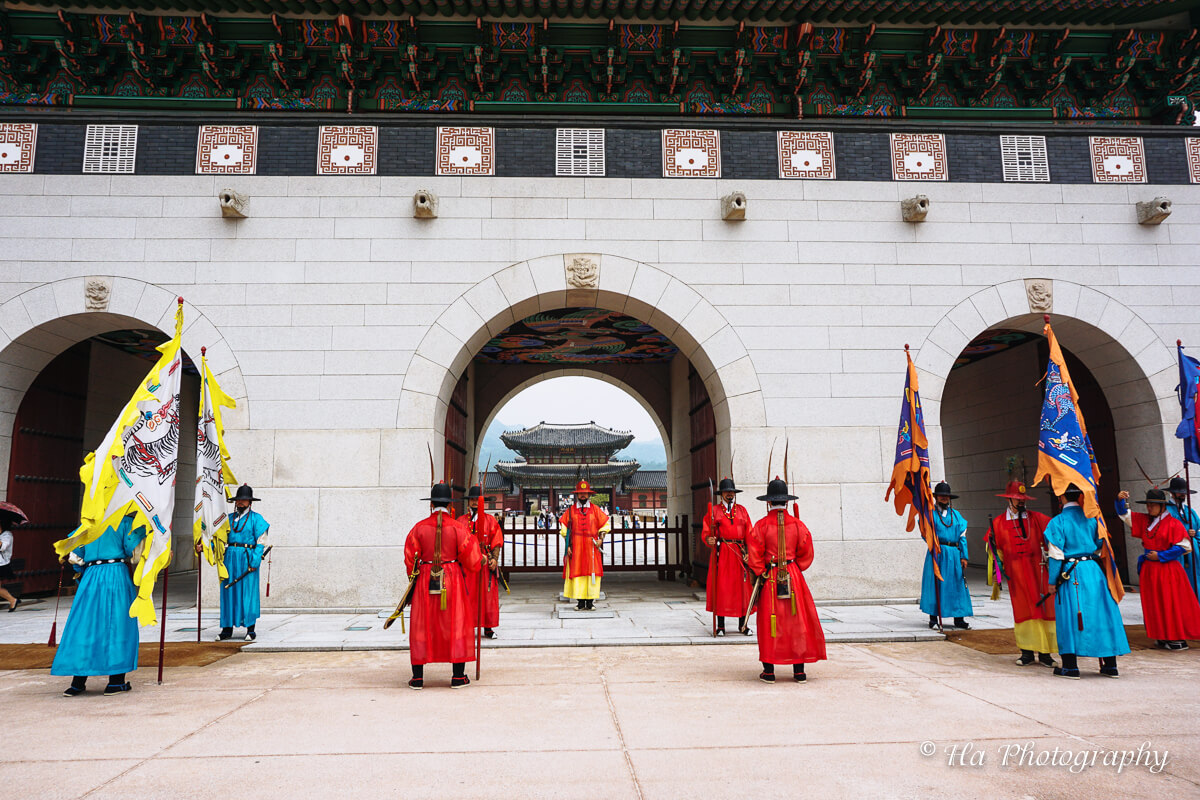
Get Discover Seoul Pass
Want to explore multiple palaces without emptying your pocket? Discover Seoul Pass have you covered.
It offers free entry to several palaces and other attractions, like museums or cultural performances.
Wear a hanbok for free entry
Feeling adventurous? Don the traditional Korean attire – a hanbok – and waltz into many of the Seoul palaces for free.
Hanbok rental shops abound near the palaces and even online. So, go ahead and truly step into the shoes (or hanbok) of ancient Koreans!
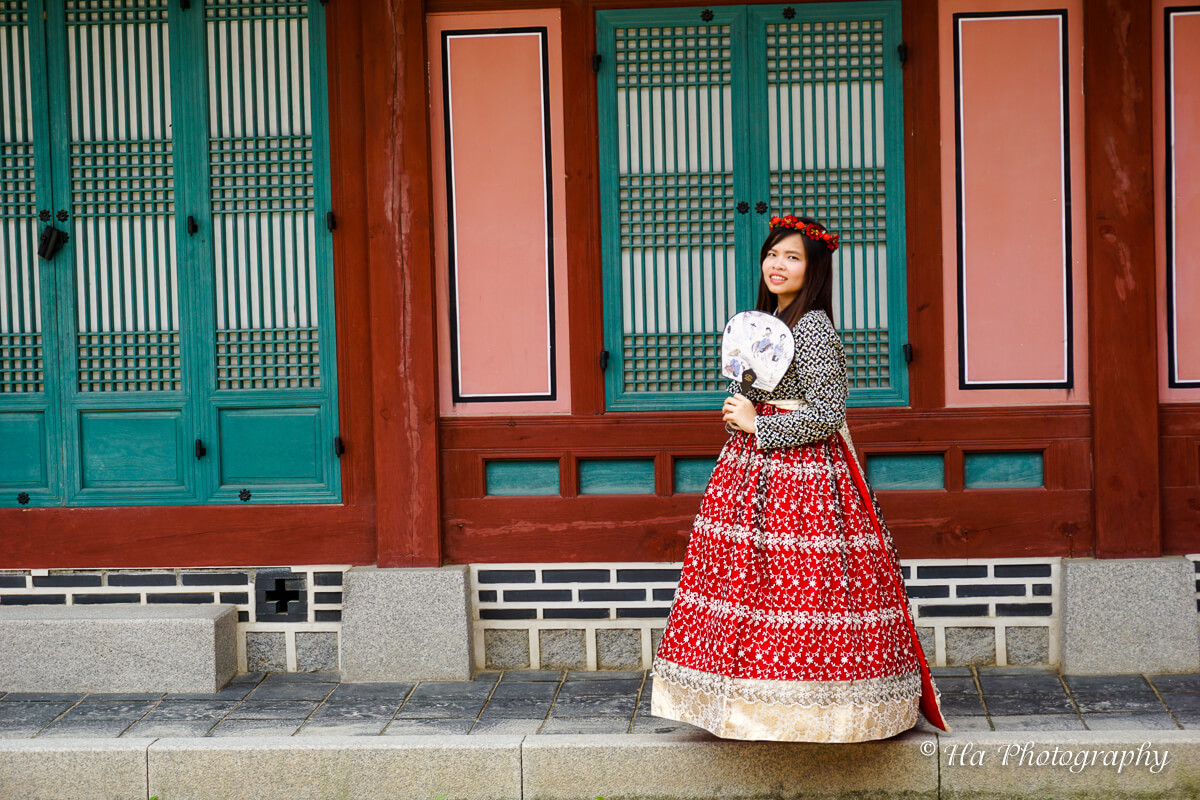
Mark Culture Day on your calendar
Culture Day, which falls on the last Wednesday of every month, is your golden ticket to free entry into many palaces, including Gyeongbokgung, Changdeokgung, and Deoksugung.
Take this chance to wander the beautiful palace gardens without shelling out a single penny.
When is the best time to visit royal palaces in Seoul?
I highly recommend visiting Seoul’s royal palaces during the spring or fall seasons. The weather is mild, and the gardens and trees are in full bloom with vibrant colors.
Spring offers the bonus of cherry blossoms in the palace gardens, while in the fall, the foliage turns into a stunning array of red, orange, and yellow.
Winter might be a bit chilly for some, but don’t write it off completely! Some palaces host unique events like ice skating and light festivals in winter, making for a charming visit.
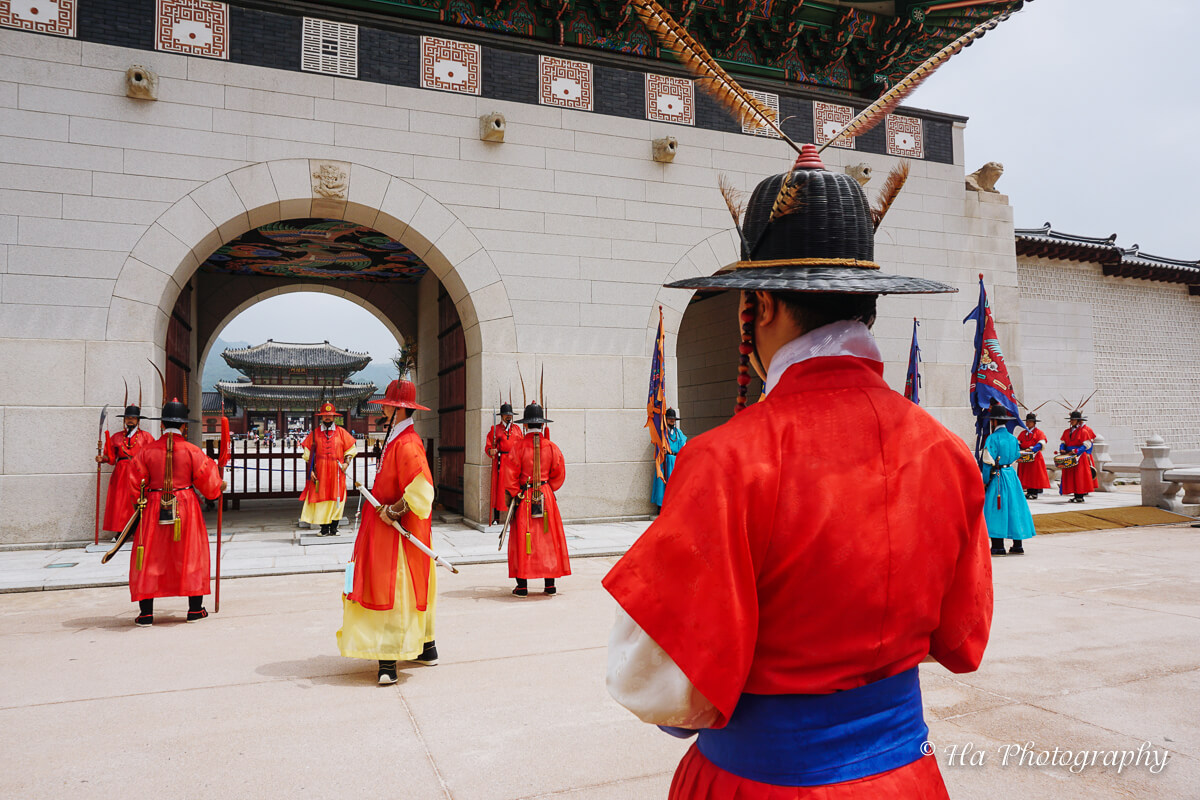
Best royal palaces in Seoul
Let’s explore five grand palaces in Seoul!
1. Gyeongbokgung Palace
Constructed in 1395, the magnificent Gyeongbokgung Palace served as the Joseon Dynasty’s royal hub.
Despite being destroyed and reconstructed numerous times, the palace remains a proud symbol of Korean sovereignty.
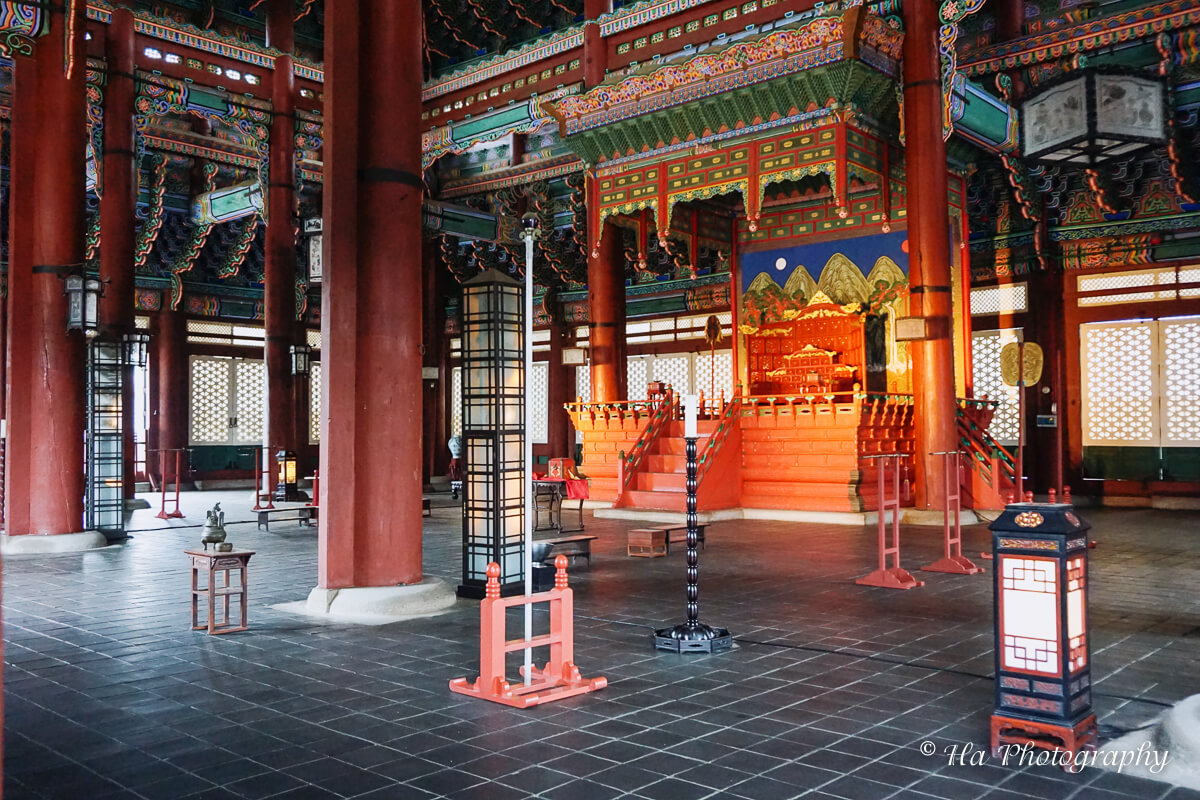
The palace exudes a fusion of traditional Korean and Chinese architectural styles. Do not miss out on the Geunjeongjeon Hall, Gyeonghoeru Pavilion, and the National Palace Museum of Korea.
To truly appreciate the palace’s significance, take a guided tour or rent an audio guide.
2. Changdeokgung Palace
Nestled in the heart of Seoul, Changdeokgung Palace is a majestic structure built in 1405.
Designated as a UNESCO World Heritage Site in 1997, the palace is one of the Five Grand Palaces that the Joseon Dynasty left as their legacy.
Here, the beauty of traditional Korean architecture intertwines with the principles of Confucianism. The buildings, built with wooden frames, stone walls, and tiled roofs, follow a feng shui layout.
But it’s the gardens that I adore the most, especially the renowned Secret Garden. It’s like a green retreat amid the urban sprawl.

The Throne Hall, used for critical ceremonies, and the Injeongjeon Hall, serving as the king’s audience chamber, are both must-see attractions.
3. Deoksugung Palace
The Deoksugung Palace is a gem that deserves a spot in your Seoul itinerary.
Built in the 15th century, this palace was once home to Korean royalty, symbolizing their power and authority.
The highlight for me at Deoksugung Palace is its unique blend of traditional Korean and Western architectural styles.
You’ll find Eastern-style buildings with curved roofs and wooden pillars share the space with Western-style structures featuring brick walls and arched windows.

Don’t miss out on the Changing of the Guard ceremony at the Daehanmun Gate – a vibrant showcase of traditional Korean martial arts and music.
Also, take the time to visit Jeonggwanheon Hall, a banquet hall built for King Gojong. The curved glass ceiling and walls offer captivating views of the palace grounds.
Changgyeonggung Palace
Constructed in 1483 during the Joseon Dynasty, Changgyeonggung Palace has worn many hats – a royal residence, a secondary palace, and even an educational institution.
Despite damage from the Japanese occupation, restoration efforts have preserved its grandeur.
The serene ambiance of Changgyeonggung Palace, surrounded by lush gardens, is what I fell in love with. True to its name, “Palace of Flourishing Gladness,” it’s a perfect escape from the city’s bustle.
The architecture is worth a mention too – think of traditional Korean elements like wooden pillars and tiled roofs.
Gyeonghuigung Palace
Stepping into Gyeonghuigung Palace, built in 1623, is like taking a step back in time.
It served as a secondary palace and later as a military headquarters during the Japanese occupation.
The architecture is a treat to the eyes, showcasing a harmonious blend of traditional Korean and Western styles.
Check out the Geoncheonggung Residence, King Gojong’s home. The beautiful gardens and tranquil pond make it a great spot to relax. And if you love books, a visit to the Seogeodang Hall, the king’s library, is an absolute must.
Additional tips for visiting Seoul Palaces
Night visit.
Palaces in Seoul are stunning by day, but they take on a magical aura under the starlit sky. Some palaces, like Gyeongbokgung and Changgyeonggung, offer night openings during specific periods, and it’s an entirely different experience.
The beautifully lit structures against the dark backdrop create a romantic and serene atmosphere.
So if you’re a night owl or a photography enthusiast, this is something you shouldn’t miss. Make sure to check their websites for night opening schedules and tickets.

Learn a bit of history before your visit
A bit of pre-visit reading can go a long way! Having some knowledge about Korea’s history, particularly about the Joseon Dynasty, will significantly enrich your palace visit.
Understanding the context behind these beautiful buildings will allow you to appreciate them even more.
Respect the rules and be mindful
Remember that these palaces are important historical sites. Follow any rules posted, like not touching artifacts, not climbing on structures, and respecting designated paths.
Also, if you are visiting in hanbok, bear in mind that it’s traditional attire and not a costume, so it should be worn with respect.
FAQs about palaces in Seoul
What is the most famous palace in seoul .
Gyeongbokgung Palace is definitely the most famous palace in Seoul as the main royal residence during the Joseon Dynasty. From here, you can catch the changing of the guard ceremony, explore the many buildings and pavilions, and even dress up in traditional Korean hanbok for a unique photo opportunity.
Can you enter palaces in Seoul for free?
Each palace has their own admission fee, but you can enter for free waering Hanboks.
The palaces in Seoul will take you on a journey through time, and each palace has its own unique charm and history. Whether it’s the grandeur of Gyeongbokgung, the beautiful gardens of Changdeokgung, the architectural fusion of Deoksugung, the tranquility of Changgyeonggung, or the cultural richness of Gyeonghuigung, you’re in for a regal treat.
I hope my tips and suggestions will make your palace-hopping experience in Seoul an unforgettable one.
Ha is an avid traveler and writer with a background in marketing & hospitality. She's lived in a few countries and traveled to more than 30. When she's not traveling or writing, Ha loves trying new recipes.
Similar Posts
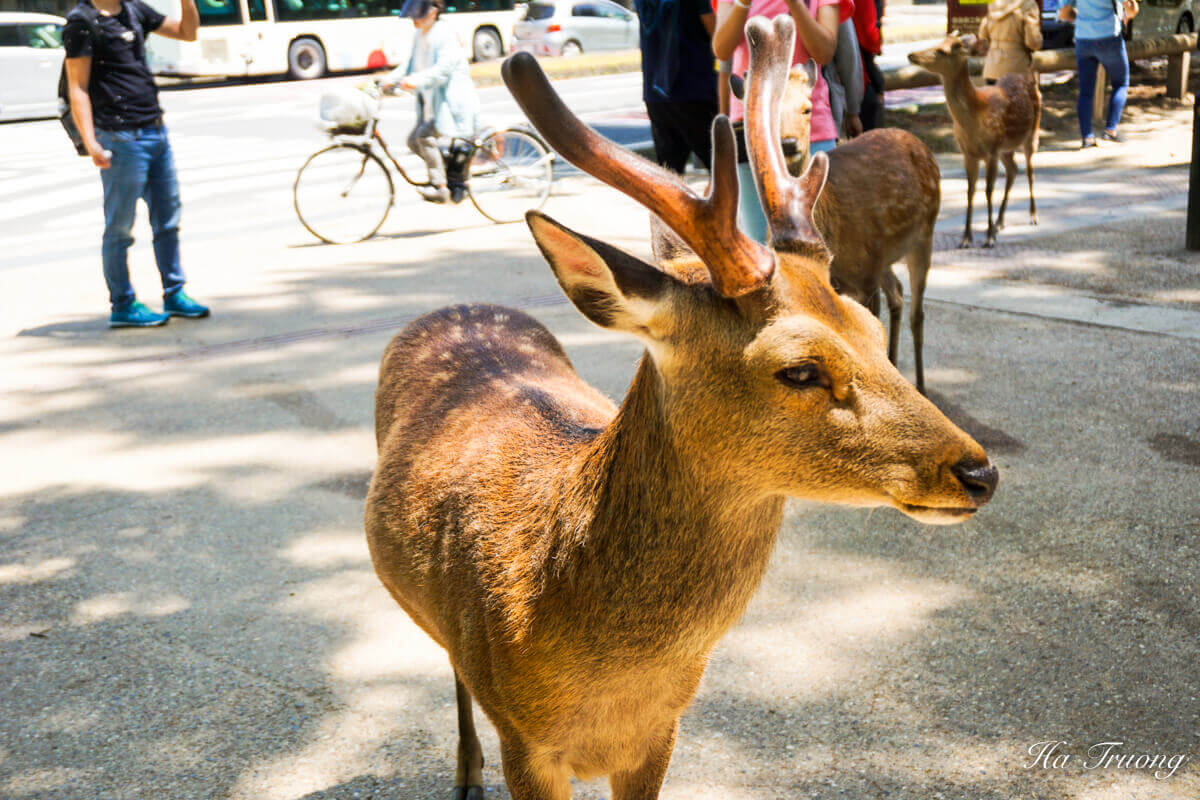
Nara Park Japan: Visit Japan’s Deer Sanctuary
Nara Park is a familiar name to those who love nature and the unique culture of the Kansai region in…
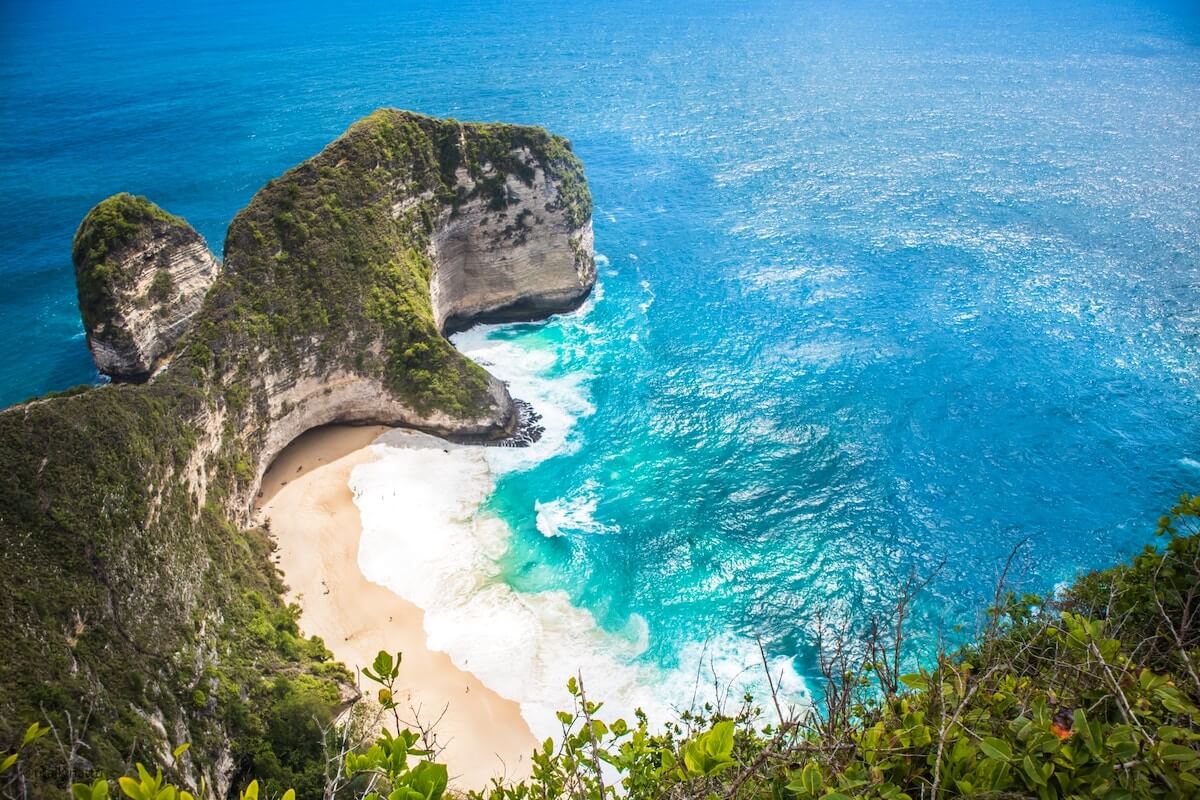
Nusa Penida Guide: Explore Bali’s Alluring Island
Everyone raves about Bali, and rightfully so. But just off its southeastern coast is a gem waiting to be explored…

Ayutthaya Thailand Guide: All you need to know
Found in 1350 by King U-Thong and the capital of Siam, Ayutthaya was one of Asia‘s most prosperous cities with…
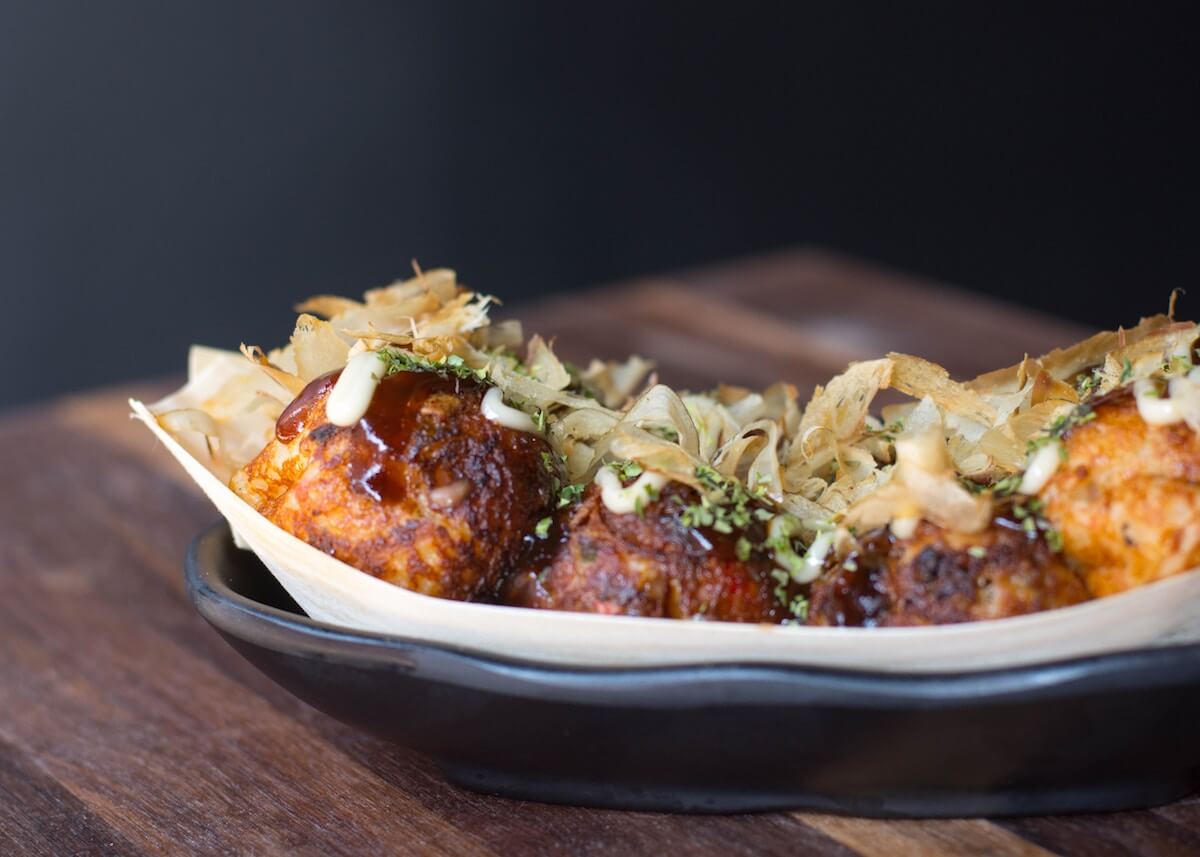
10+ Must-Try Japanese Food
Japanese cuisine is famous for its delicious dishes with beautiful decoration and extraordinary service. In this Japanese food guide, you’ll…
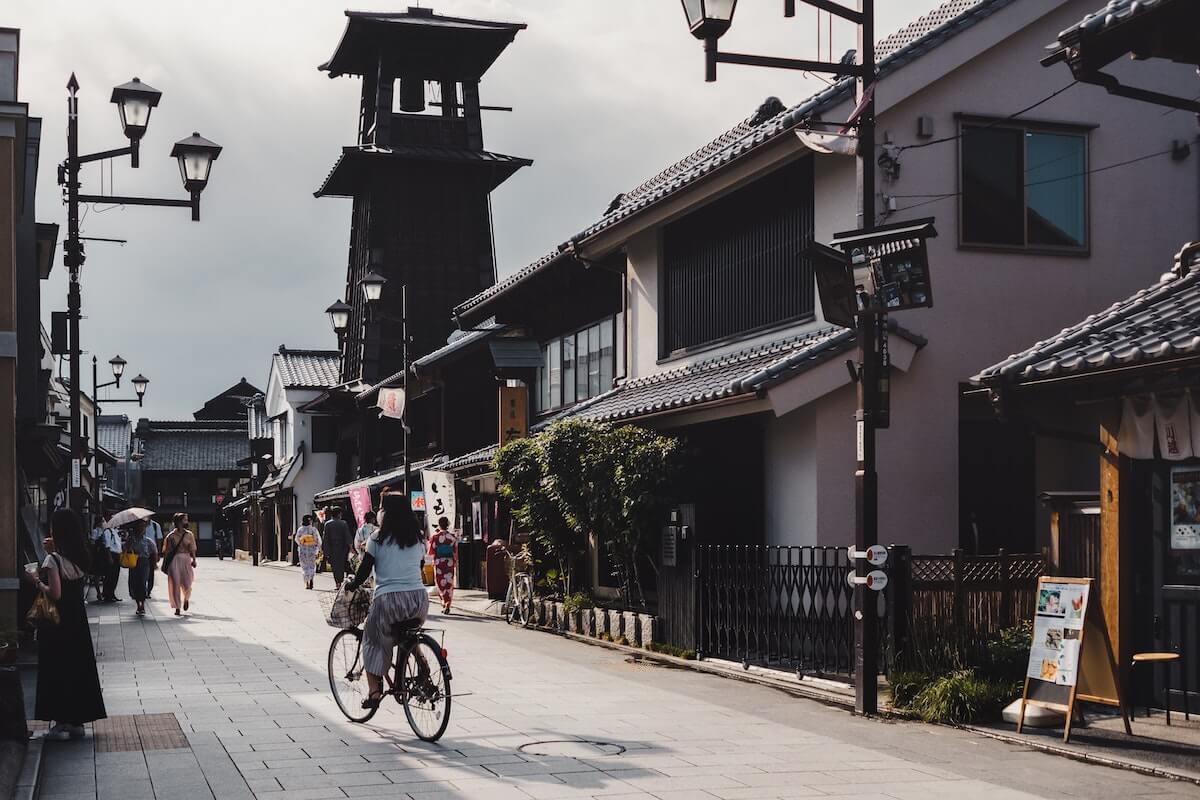
10 Awesome Day Trips From Tokyo Japan
Tokyo has so much to offer that many travelers never venture outside of the capital. However, it is well worth…
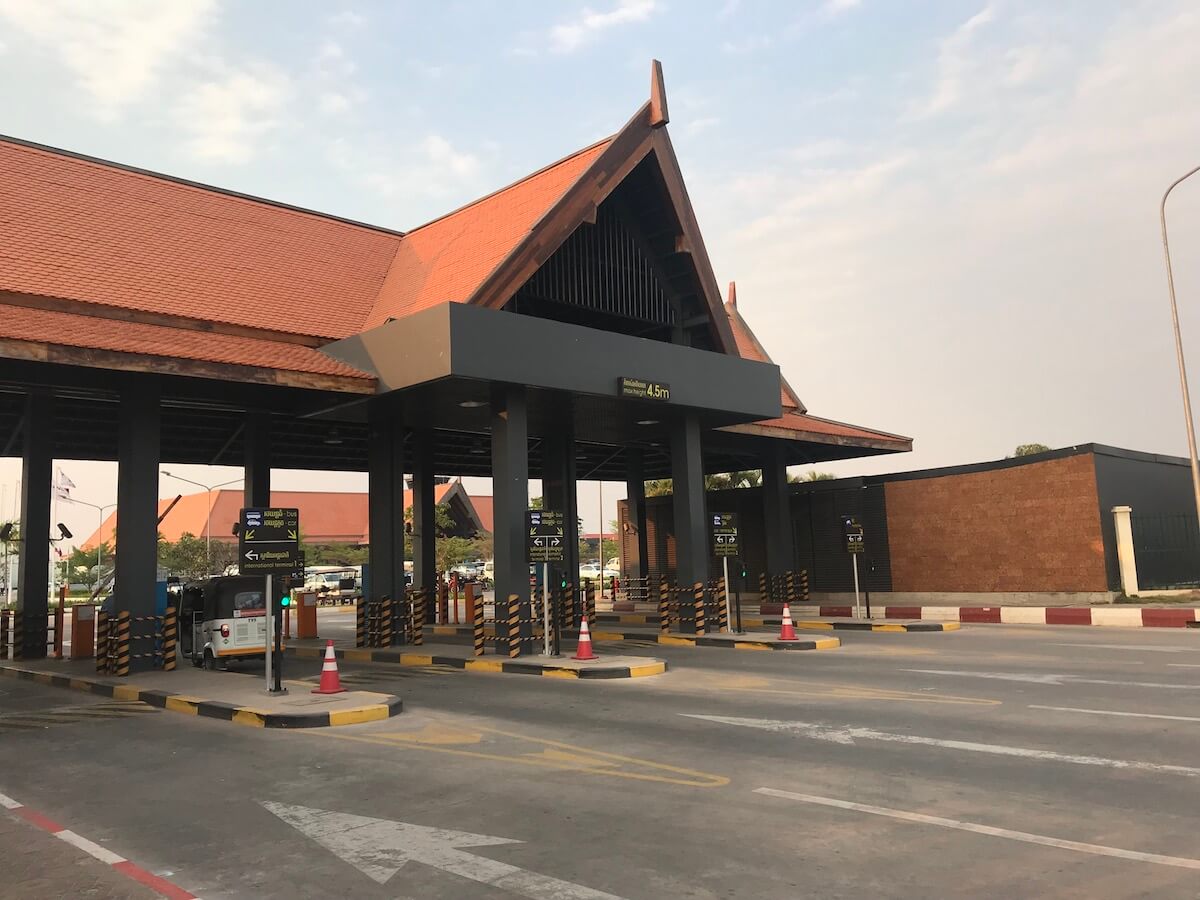
Ho Chi Minh To Siem Reap: Transport & Ticket Guide
Over the Vietnamese border in Cambodia, you can find one of the world’s magnificent attractions – the Angkor Temples. Siem…
Leave a Reply Cancel reply
Your email address will not be published. Required fields are marked *
We’re in Myanmar right now and it’s SO epic… click here to follow along on Instagram.
- Meet the Team
- Work with Us
- Czech Republic
- Netherlands
- Switzerland
- Scandinavia
- Philippines
- South Korea
- New Zealand
- South Africa
- Budget Travel
- Work & Travel
- The Broke Backpacker Manifesto
- Travel Resources
- How to Travel on $10/day
Home » Asia » South Korea » Seoul
34 BEST Places to Visit in Seoul (Attraction Guide for 2024)
Seoul is one of the most popular destinations in Asia. It’s a bustling metropolis that combines cyber-punk sights with old-world goodness. It’s a truly unique city.
There are numerous cool places to visit in Seoul and a lot of sights to see. This city has it all, from a fascinating and unusual culture to great food, amazing shopping, and great entertainment options. It’s also very welcoming and used to travelers making it a safe and accessible place in Asia. There countless points of interest in Seoul, so you’ll have an exciting and busy trip to the city.
The idea of traveling in Seoul can seem a little intimidating. It’s a sprawling metropolis and doesn’t quite have the complete ease of its East Asian neighbor Japan. However, Seoul is actually a very safe city and is popular amongst tourists, so the tourist trails are well worn and easy to explore.
With this easy guide, you’ll find it easy to travel to Seoul and come back with stories and pictures that other people just can’t match! There are a lot of cool places to visit in Seoul, so let’s get to it!
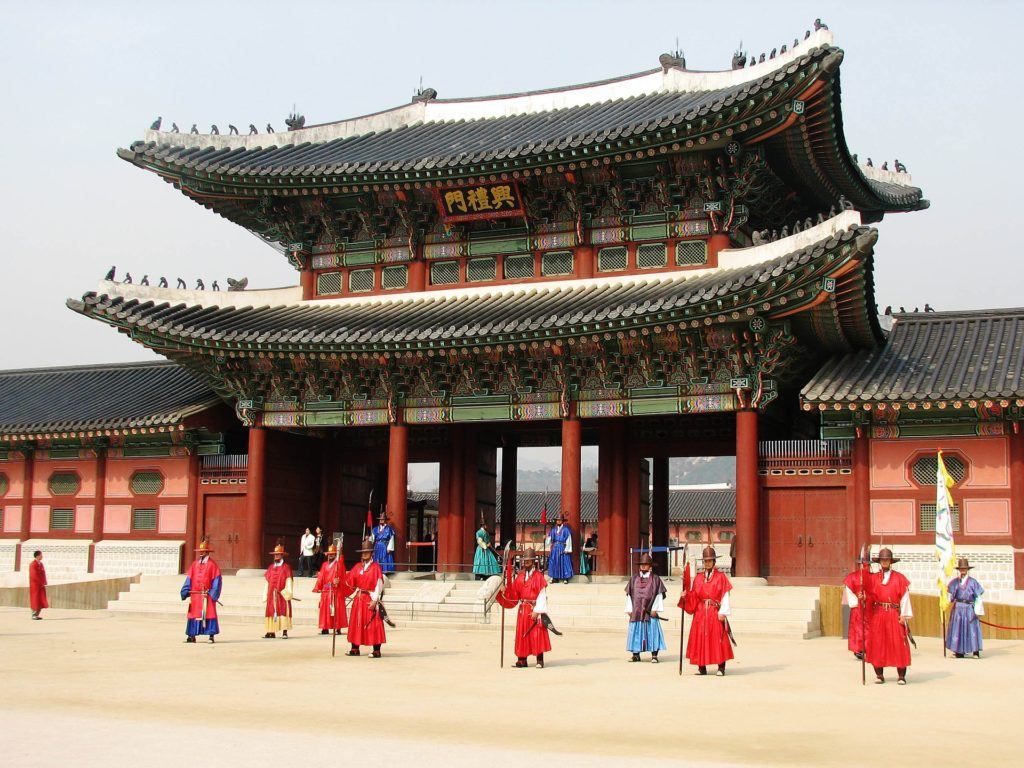
Need a place quick? Here’s the best neighbourhood in Seoul:
The best places to visit in seoul, faqs on the best places to visit in seoul, final thoughts before visiting seoul’s best places.
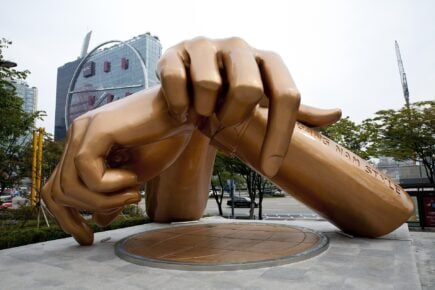
Gangnam translates as ‘south of the river’ and is a district that has blown up in recent years. It was originally an area dedicated to sleepy rice fields – but you’d never believe it when visiting today!
- Check out the K-pop scene and pick up a few CDs at Evan Records.
- Shop for the latest fashion and boutique items (or just window shop) at Galleria department store.
- Eat bibimbap at Tokkijung or a famous Korean barbeque meal at Yang Good.
Where do you start with the best things to do in Seoul – in a city of 10 million? Your experience while travelling in South Korea will be dramatically different by the accommodation you choose. You want to make sure you’re closest to all the coolest things to do.

Unlock Our GREATEST Travel Secrets!
Sign up for our newsletter and get the best travel tips delivered right to your inbox.
#1 – Bukchon Hanok Village – A great place to see in Seoul for Korean architecture
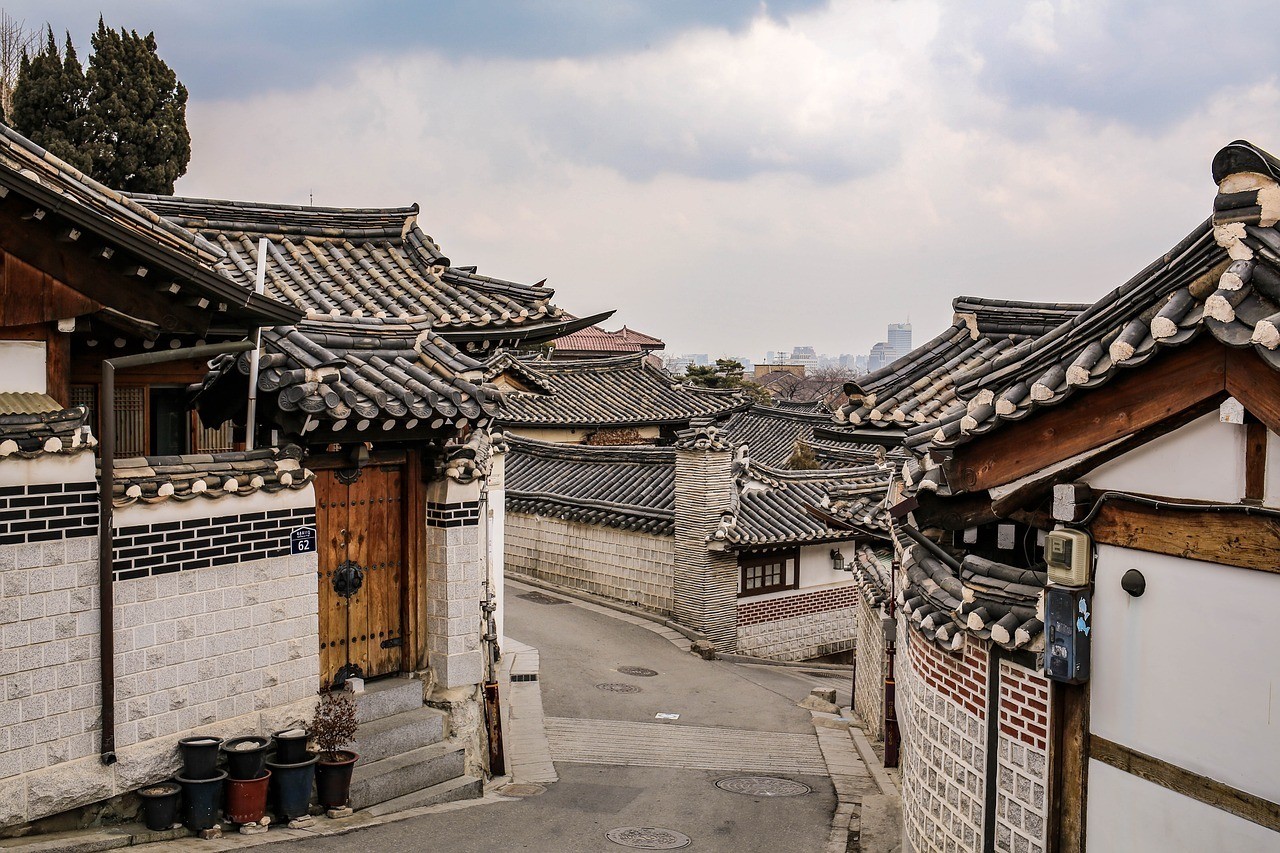
- A great place to experience Seoul’s traditional culture.
- You’ll be able to take some awesome pictures in this area!
- Just be aware that people still live in these houses, so be respectful of their privacy.
Why it’s so awesome: The traditional houses in Seoul are called Hanok and they date back to the Joseon Dynasty between 1392 and 1910. These houses are designed to maintain a balance between the house and the outside world of mountains, rivers, and land contours. This makes them extremely aesthetically pleasing and one of the must-sees in Seoul! You may even be able to find an Airbnb in Seoul in this architectural style if you’re lucky!
What to do there: People actually still live in this residential area, which is located between Gyeongbokgung Palace and Changdeokgung Palace, so be respectful of their spaces and time. If you can, join a guided tour early in the morning to get even more insights. Or take some extra time and explore the area and make sure you get some pictures too. There are some spots where you can see the traditional houses against more modern landmarks, and they make for the most striking photo-ops of all.
#2 – Myeongdong – A great place in Seoul if you love to shop!
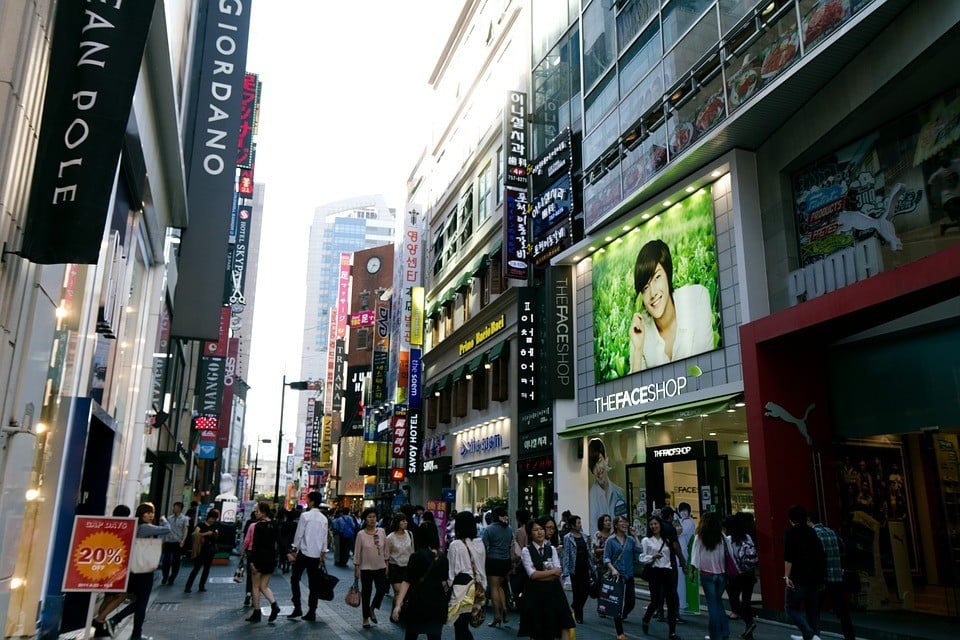
- Literally shopper’s paradise!
- You’ll find amazing deals in this area on every kind of cosmetics you can imagine.
- Make sure you take advantage of the samples and the changing deals and offers.
- If you want to find out more, get a guide to show you around!
Why it’s so awesome: The women of Seoul look amazing. They’re always beautifully dressed and have impeccable make-up, and this area is why. Myeongdong is a whole shopping area dedicated to every cosmetic store and brand you could ever want. So, no matter what type of skin you have or what make-up look you want, you’ll be able to find the right products in this area.
What to do there: This is the most famous place in Seoul for shopping and there are always a lot of special deals and offers in this area so keep your eyes open and take advantage of them. A lot of shops also offer free samples, so don’t be afraid to try a brand you’ve never heard of! This is a trip mostly for the girls, so leave the guys at home and take your best friends along for the ride.
#3 – Lotte World – A must-do in Seoul for families!
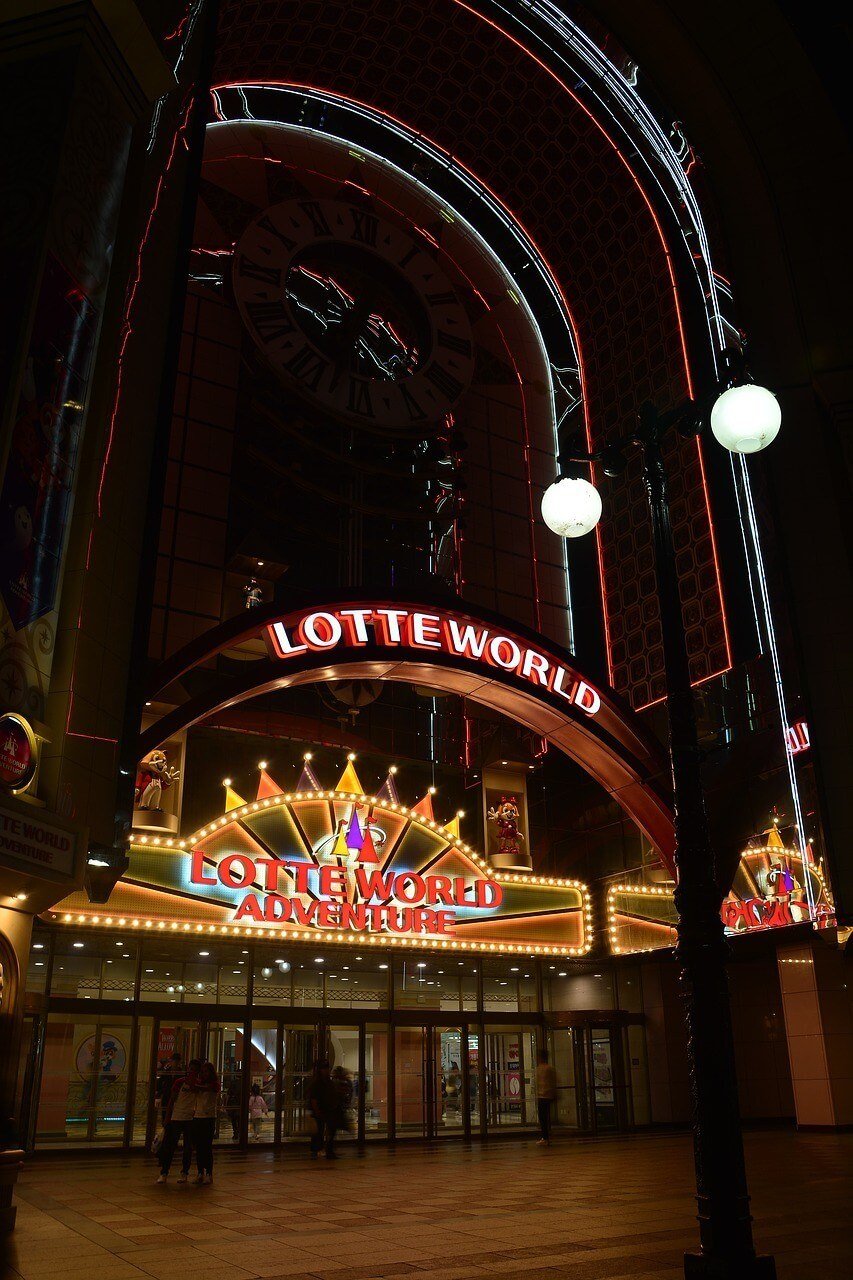
- The world’s largest indoor amusement park.
- If you get tired of the rides, then visit the shopping complex also on-site!
- This is a Seoul must-do and a great place to take the kids.
Why it’s so awesome: Lotte World is huge. It includes both an indoor and outdoor amusement park and there is also a hotel, an aquarium, luxury boutiques, a water park, and a shopping center on-site! So, even if you get tired of the rides, you can always slip out and grab a meal or a bargain before returning to the Lotte fun.
What to do there: Take the kids, or friends, and just enjoy the amusement park. The rides and attractions are some of the best you’ll ever see at Lotte World and it’s well worth taking an entire day in this park to soak it all in.
Make sure you try the Desperados game, the Dragons Wild Shooting game, and the Comet Express rollercoaster for maximum fun and thrills! It’s easily a must-visit in Seoul if only to feel like a kid again. Buy your tickets before you go, so you won’t end up waiting in line.
#4 – Gyeongbokgung Palace – Possibly one of the most important places to visit in Seoul
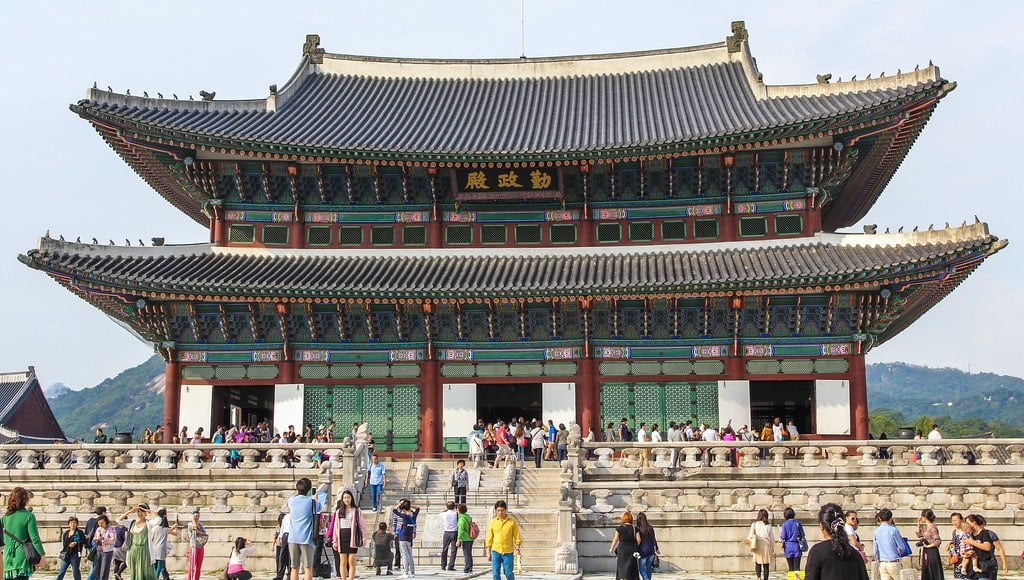
- When you travel to Seoul, you absolutely must not miss this historic building!
- The largest and most important palace in Seoul.
- If you wear a traditional hanbok dress, they’ll let you in for free.
Why it’s so awesome: The Gyeongbokgung Palace is often compared to the Forbidden City in Beijing and is a Seoul must-see. Built in 1395, it was the main royal palace of the Joseon family, who ruled Korea for hundreds of years.
The palace was mostly destroyed by Imperial Japan during the early 20th century but over the following years, it has been meticulously restored. It is now considered to be one of the most beautiful palaces in the world, which is why it’s one of the best places to visit in Seoul.
What to do there: There are lots of places in the city where you can hire a hanbok – a traditional Korean dress. If you turn up at the palace wearing it, they’ll let you in for free. Aside from that, just explore the site. I’d recommend jumping on a guided tour to get to know all of the details about this stunning palace.
Also, make sure you show up to see the changing of the guard or the Gwanghwamun Gate Guard-on-Duty Performance . Either one happens between 10 and 4 pm every hour on every day except Tuesday and it’s a really fun thing to see in Seoul.
#5 – N Seoul Tower – A place to go in Seoul to see the city from a different angle.
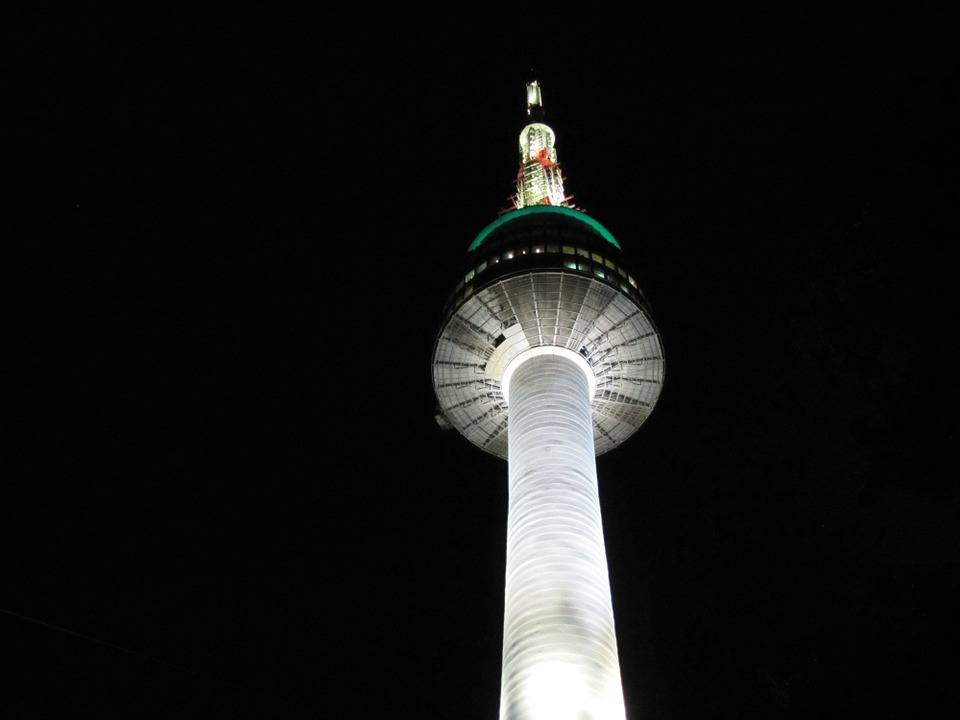
- The best place for panoramic views of the city.
- The building also hosts a variety of cultural and entertainment events as well as restaurants and snack bars.
Why it’s so awesome: If you’re looking for the top place to visit in Seoul, they don’t get much more “top” than this. The N Seoul Tower is located on Mt. Namsan and has been Seoul’s most iconic site since its opening in 1980. It’s actually a communication and observation tower, but over the last few years, it’s become one of the most important and celebrated sites in the city.
What to do there: Go to the top and enjoy the views. Sometimes, the best way to explore a city is to see it high up and at a distance so you can get an idea of the scale, and this tower offers the best place in the city to do just that.
Afterwards, go down to see a movie or an exhibition in the cultural space, or just grab a table at the upscale restaurants there and enjoy a fantastic meal. If you are passing through Seoul, then you see this (but not climb) on a Seoul transit tour from the airport.
#6 – The Yun Dong-ju Literature Museum – A great place to visit in Seoul if you are alone.
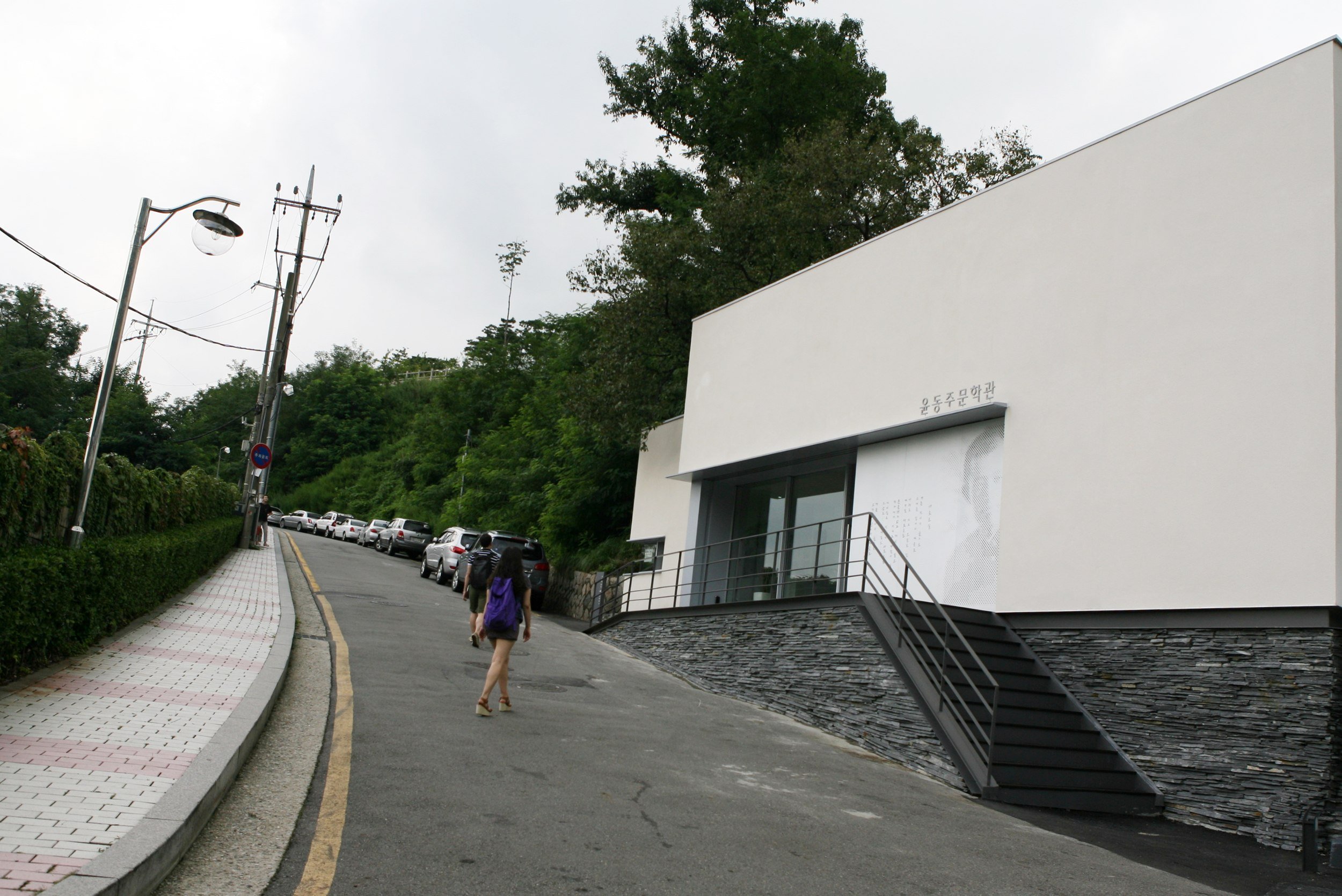
- Reading the books and poetry from another culture is a great way to gain a deeper understanding, and this is a great entry point into South Korean Literature.
- If you love books and history, this is a Seoul must do.
Why it’s so awesome: This is a museum built in honor of the beloved South Korean poet Yun Dong-Ju. It’s a three-room museum where you can explore photos from his life as well as first editions of his poems. The space itself is beautiful as well; the indoor space perfectly captures the contemplative, inspiring mood of the poetry and is a Seoul itinerary must for the contemplative travelers.
What to do there: Spend some time exploring the photos and contemplating this poet’s work before going outside. You can take a wall on Poet’s Hill at the back of the museum and get great views of the city and the N Seoul Tower. After your visit, you might even be inspired to get writing!

A new country, a new contract, a new piece of plastic – booooring. Instead, buy an eSIM!
An eSIM works just like an app: you buy it, you download it, and BOOM! You’re connected the minute you land. It’s that easy.
Is your phone eSIM ready? Read about how e-Sims work or click below to see one of the top eSIM providers on the market and ditch the plastic .
#7 – The Jeoldusan Martyr’s Shrine – An important historical site in Seoul.
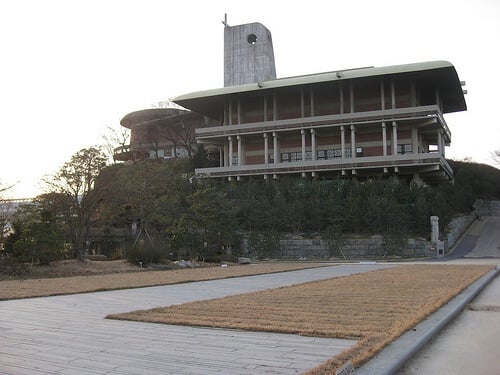
- A sobering but beautiful shrine that remembers a very dark time in history.
- Don’t take the kids to this site as some of the displays may upset them.
- If you want to explore Seoul, going back to its roots is a good way to start.
Why it’s so awesome: This is a Catholic shrine on the Han River and marks the Byeonin Persecution of 1866. At this time, nine French missionaries were martyred which led to the French fleet attempting an invasion into Korea. In retaliation, the Jeoldusan government targets, punished and murdered French and Korean Catholics, leading to this site became known as the ‘beheading mountain’. This obviously isn’t a fun site, but it’s an important part of Korean history and must be seen if you want to understand the present.
What to do there: The shrine is especially beautiful at night when votive candles give it an otherworldly glow, but it’s still beautiful and sobering when you go during the day. Don’t bring your kids with you as the Shrine houses a gallery and museum display torture implements that were used on the captured Catholics.
#8 – The Seoul Museum of Art – The perfect attraction in Seoul if you are on a budget!
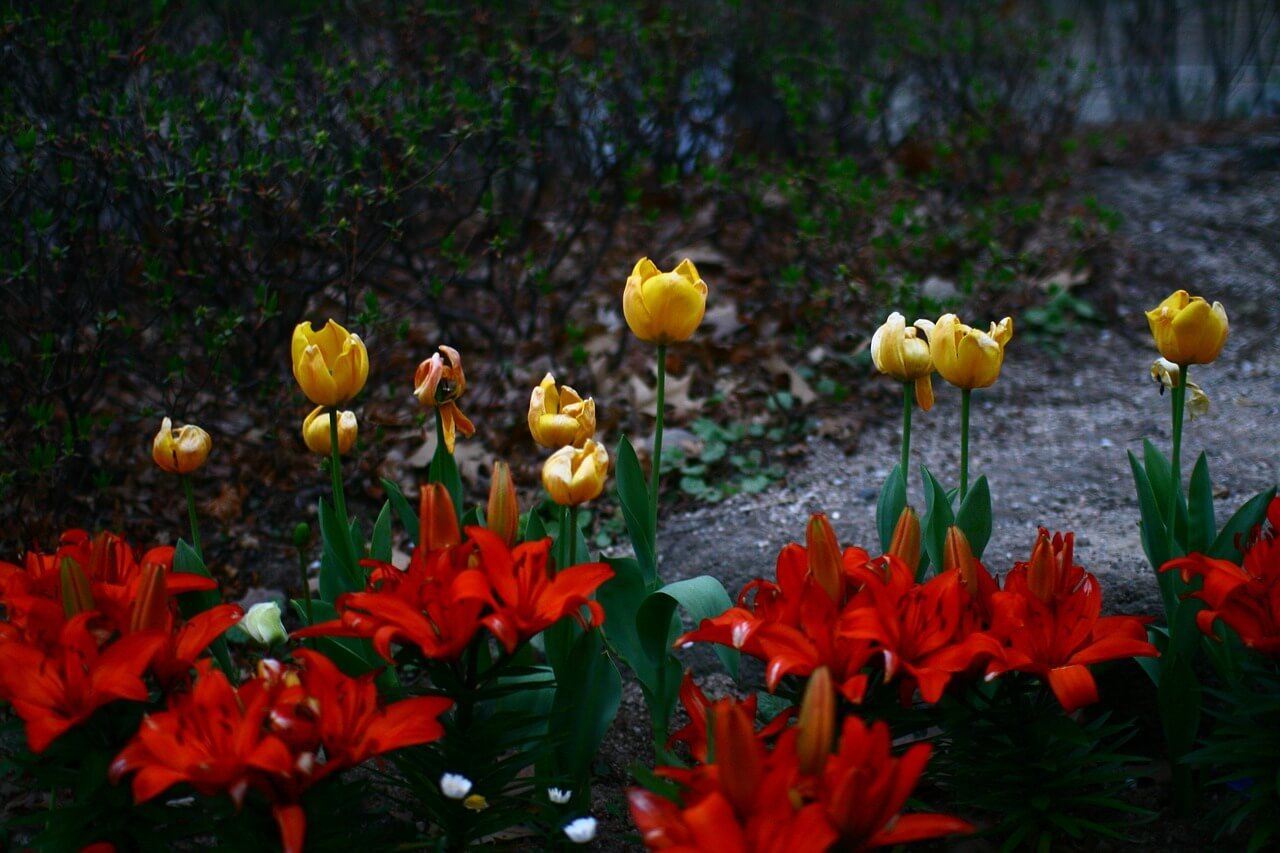
- One of the best points of interest in Seoul that’s also free!
- The museum is housed in a beautiful and historic building which offers great photo opportunities.
Why it’s so awesome: How about a free thing to do in Seoul! This museum plays host to a range of special exhibitions that can be expensive, but the permanent display is totally free. It highlights the career of the Korean artist Chun Kyung-Ja, who was influenced by African culture and art and is worth the trip to the museum alone.
What to do there: Before you go, check out what special exhibitions they have on during your stay. Korean art is very unique and well worth exploring, so spend some time getting to know their unique style. But make sure you check out the regular display as well because it’s beautiful and soulful.
#9 – The Cheongun Literature Library – Another place in Seoul for the bookworms!
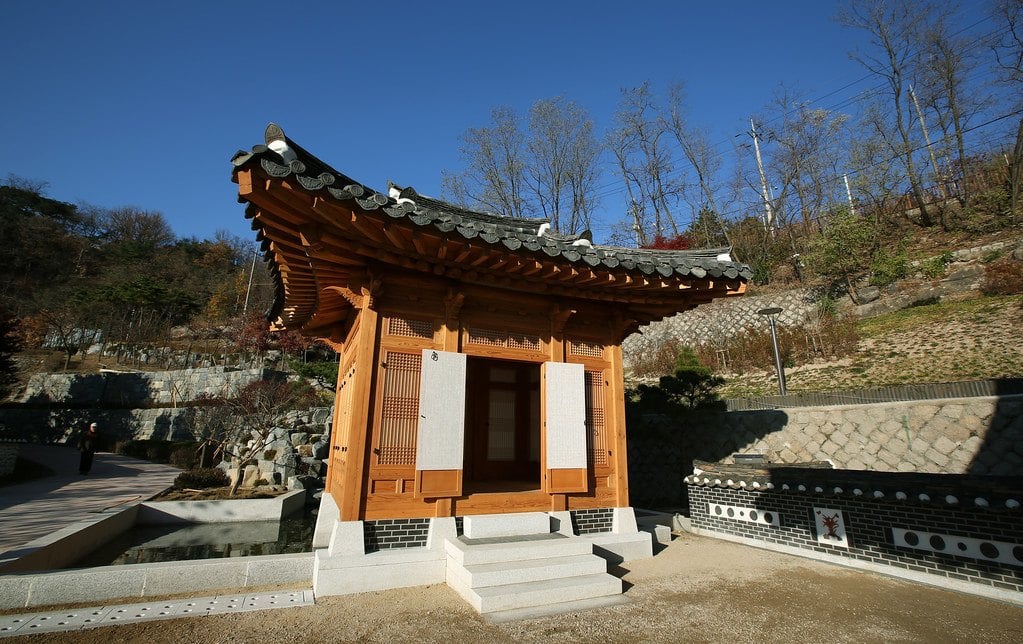
- An amazing place to spend some time if you love books!
- One of the most beautiful museums in Korea.
- If you’re trying to work out what to do in Seoul on a quiet afternoon, this is a site where you can sit back and relax.
Why it’s so awesome: The collection of books at this library is fairly average, but it’s the space that makes it amazing. The reading rooms are located on the second floor of a traditional Korean house which is spacious, sunny, and welcoming. So, if you love to read , this is a perfect place to settle in and do it!
What to do there: Make sure you spend some time exploring this traditional Korean house. This style of Korean architecture is unique and oddly harmonious with the natural surroundings, so it’s worth taking note of it. And then, get away from the busyness of the city by choosing a book and taking it upstairs to read. There’s nothing like reading a good book in an atmospheric space, so take advantage of the opportunity.
#10 – Everland – A very cool place in Seoul for a day trip
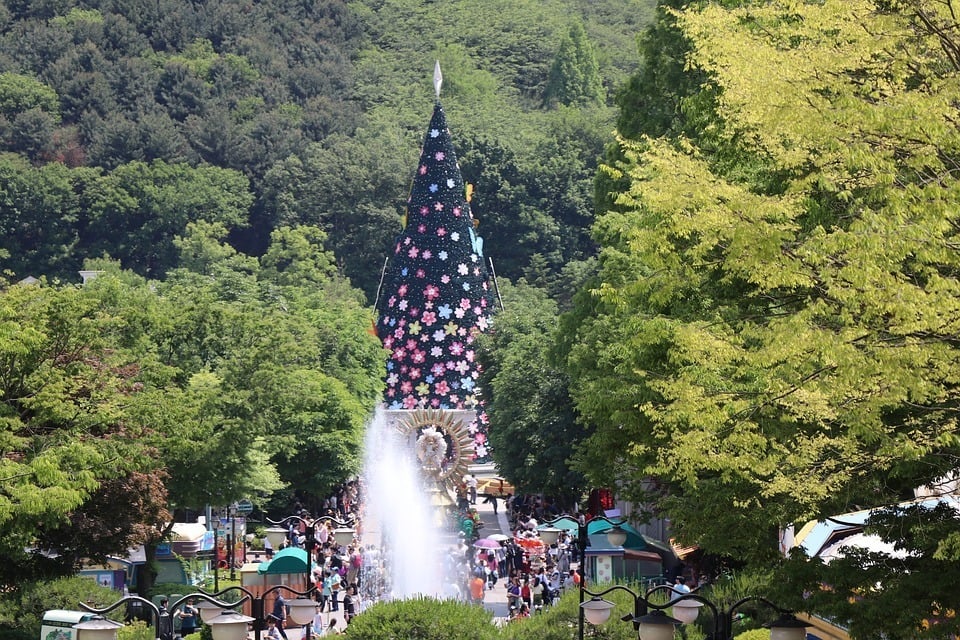
- A great place to take the whole family while you’re visiting Seoul
- This park has the steepest wooden roller coaster in the world.
Why it’s so awesome: Seoul breaks a lot of world records and this affects how they build things and what they enjoy. Everland is the largest outdoor theme park in South Korea and has five zones of rides and attractions. This includes the world’s steepest wooden roller coaster and South Korea’s only safari, so come expecting some thrills.
What to do there: Get there early because there’s a lot to do and you’ll need the whole day to fit it all in. If you love roller coasters, make sure you ride the world’s tallest wooden coaster and be prepared to scream your lungs out along the way!
#11 – The NANTA Theater – Seoul and South Korea’s artistic scene is definitely a must-see.
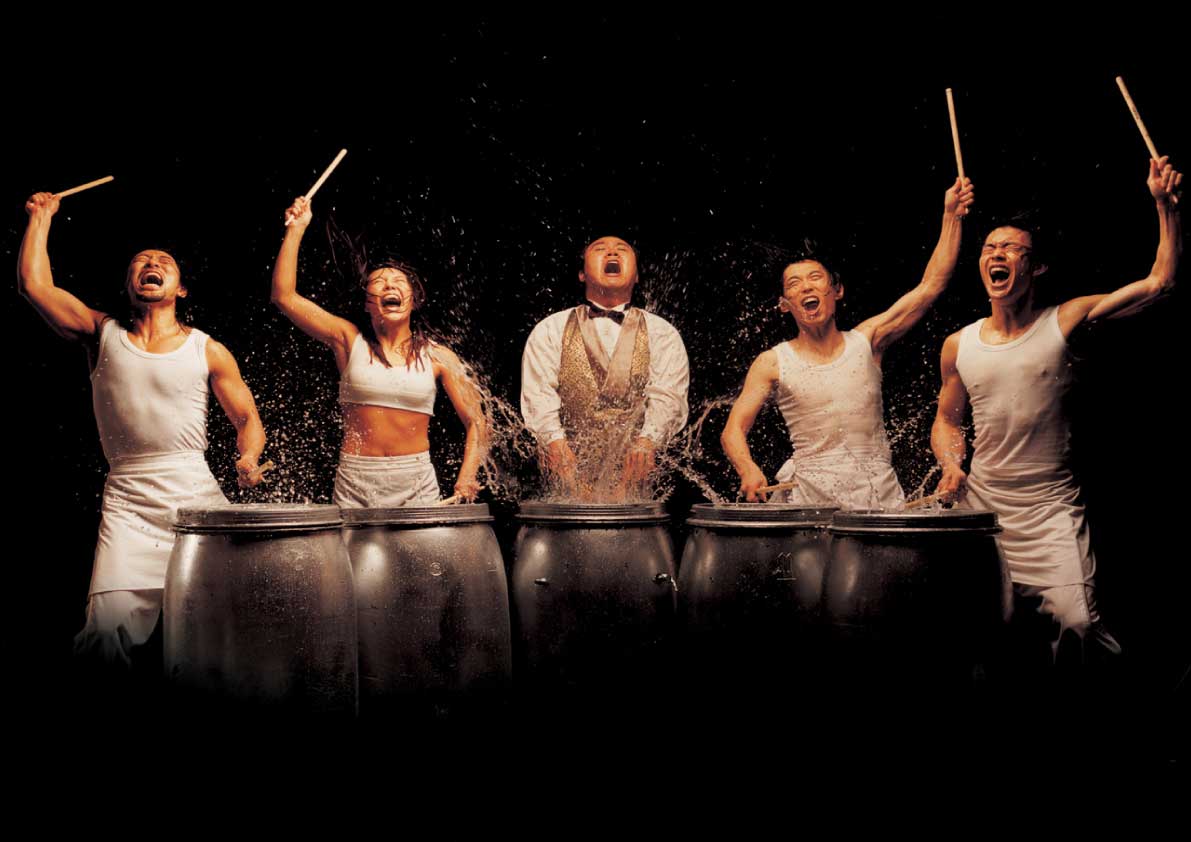
- Another side of Korean culture and one you probably won’t expect!
- The most popular theater performance in the city.
Why it’s awesome: Every culture is different and sometimes it’s great to get a first-hand view of just how different another country can be. The NANTA Theater is the perfect place to get a different view on the modern culture of South Korea. It’s the most popular theatre in the city and has a non-verbal, musical base. Perhaps a little strange, but it’s a terrific window to seeing another side of the city while backpacking in Seoul .
What to do there: This theatre has shows regularly so check out what’s on before you arrive in the city. And once you’re there, just enjoy the culinary-themed comedy performance with acrobatic moves and rhythmic melodies. Chances are that you’ve never seen anything like it and never will again! The shows sell out fast – they’re incredibly popular – so book early to make sure you don’t miss out.
#12 – The Seoul Alive Illusion Museum – Quite the quirky place in Seoul to visit!
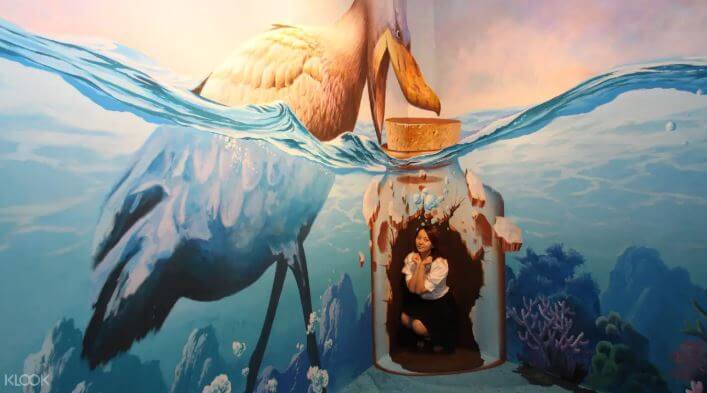
- The first museum of 4D optical illusions in South Korea.
- Includes more than 100, slightly quirky exhibits.
- The perfect place to go with friends or with your family while you’re visiting Seoul.
Why it’s awesome: Even if you’ve been to an optical illusion museum before, you probably haven’t seen one like this. A lot of the exhibits in this museum are slightly quirky and unusual, and you’ll probably spend a lot of your visit to this venue laughing your head off at the displays you can become part of. It’s just a little run-of-the-mill Korean madness.
What to do there: Make sure your phone or camera is fully charged before you spend a few hours at this museum because you’ll need it. Even if you’ve seen optical illusion museums before, this one is unique. Make sure that you check out the Disney displays and become a part of popular movies like Frozen and Cinderella in your own personal works of art. Sort your booking in advance to have an even better experience!

Wanna know how to pack like a pro? Well for a start you need the right gear….
These are packing cubes for the globetrotters and compression sacks for the real adventurers – these babies are a traveller’s best kept secret. They organise yo’ packing and minimise volume too so you can pack MORE.
Or, y’know… you can stick to just chucking it all in your backpack…
#13 – Tosokchon – A must-do in Seoul to delight your tastebuds.
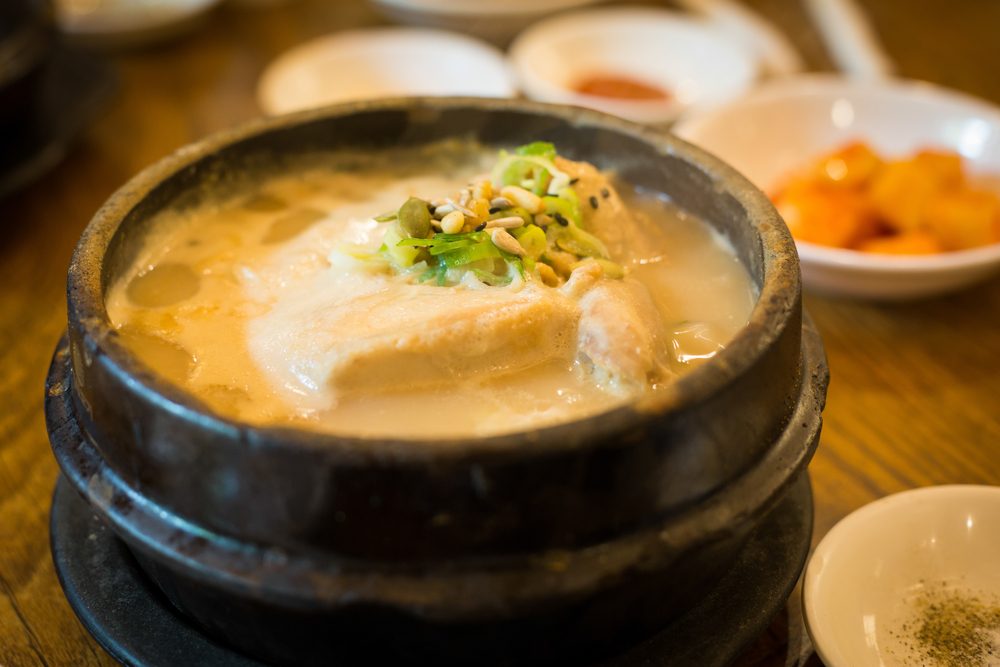
- Home to one of the most famous dishes in the city.
- Expect queues, but the wait is definitely worth it.
- Buy a ticket online if you want to skip the line
Why it’s so awesome: Every city has a dish that they’re famous for and one of Seoul’s most famous dishes is known as Samgyetang. This is ginseng chicken soup, and the best place to buy it is at Tosokchon restaurant on Jahamun-ro 5-gil Road. Once you taste the dish, you’ll understand why people queue up to eat it every day.
What to do there: Arrive early if you want to be in the front of the line and just wait patiently. The dish is worth the trouble, as all the locals in line will tell you, so just accept the wait and enjoy your food once it arrives. Make sure you try it though; it’s a must-do when visiting Seoul!
#14 – The Cheonggyecheon Stream – A quiet and romantic place to see in Seoul.
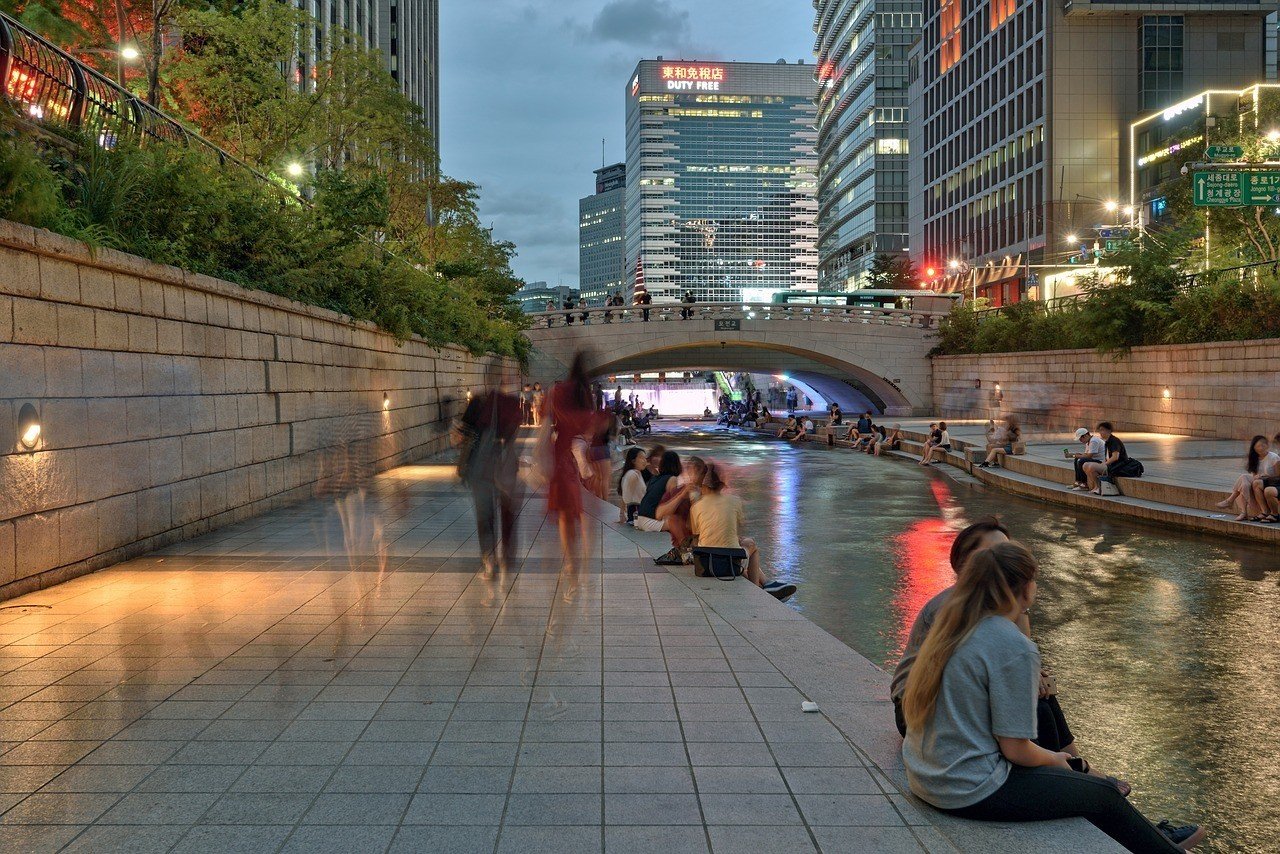
- A chance to take a break from the busy city and enjoy a slice of nature.
- You can also walk the length of the stream, which will take you alongside lots of Seoul’s best tourist attractions.
Why it’s so awesome: Seoul is a busy modern city and sometimes it’s nice to get away from the crowds and pollution and enjoy a bit of nature. And that’s exactly what this stream is for. The locals often visit on hot summer days and spend time sitting in the shade and dipping their feet in the water, and you can do the same when you need a little break.
What to do there: Walk down to the stream and just spend some time relaxing. The stream is like a little oasis in the middle of the city, so take the time to slow down and rest. You can also walk the length of the stream if you’re feeling energetic and stop off at local attractions along the way.
#15 – Bukhansan National Park – The most beautiful nature in Seoul.
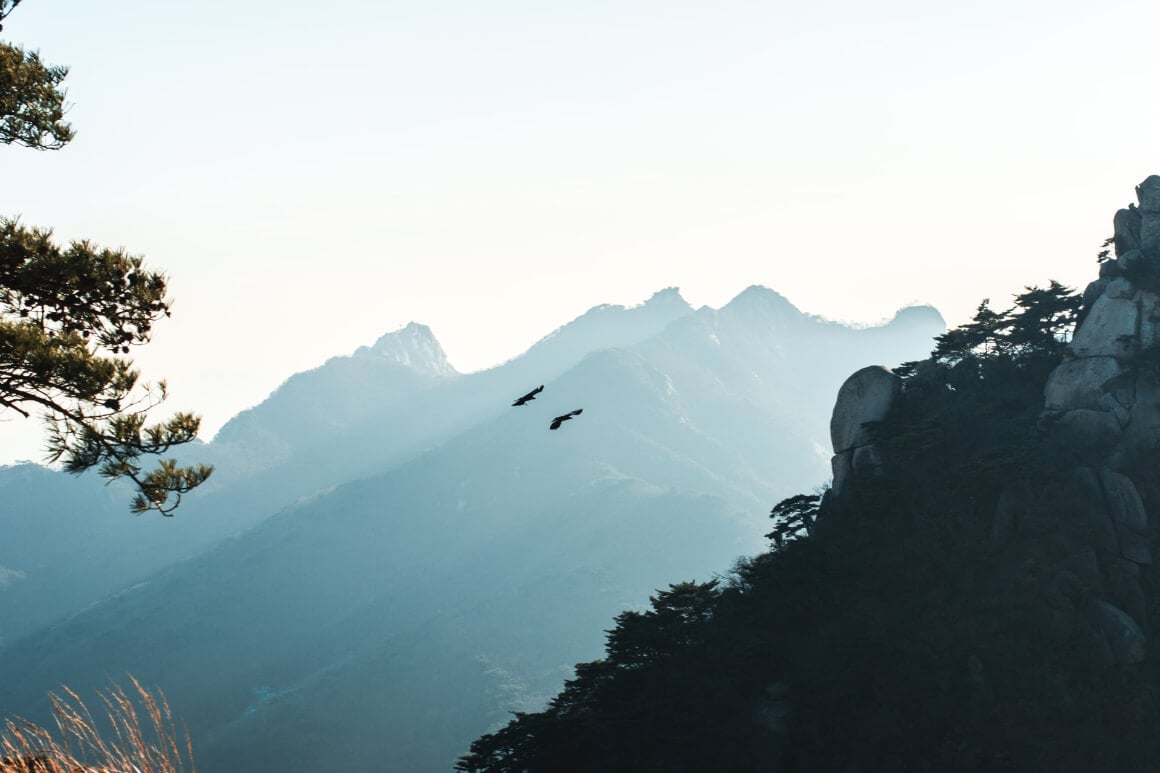
- A traditional market where you can find almost anything you want to buy.
- The prices are extremely good, so make sure you check it out if you want something specific.
Why it’s so awesome: While you’re in Seoul, you might find the city can be overwhelming at times. No matter, because just outside the city centre you’ll find the Bukhansan National Park, which is the best place to go hiking in Seoul. Aside from outdoor recreational activities, the national park boasts impressive mountain views and lush forestry. You might also see some ancient temples and fortresses along the way.
What to do there: The reason most people visit the Bukhansan National Park is to do some hiking. Whether you’re an avid hiker or a beginner level hiker, you’ll find a trail suitable to your ability here.
#16 – Gwangjang Market – Seoul’s street food delights!
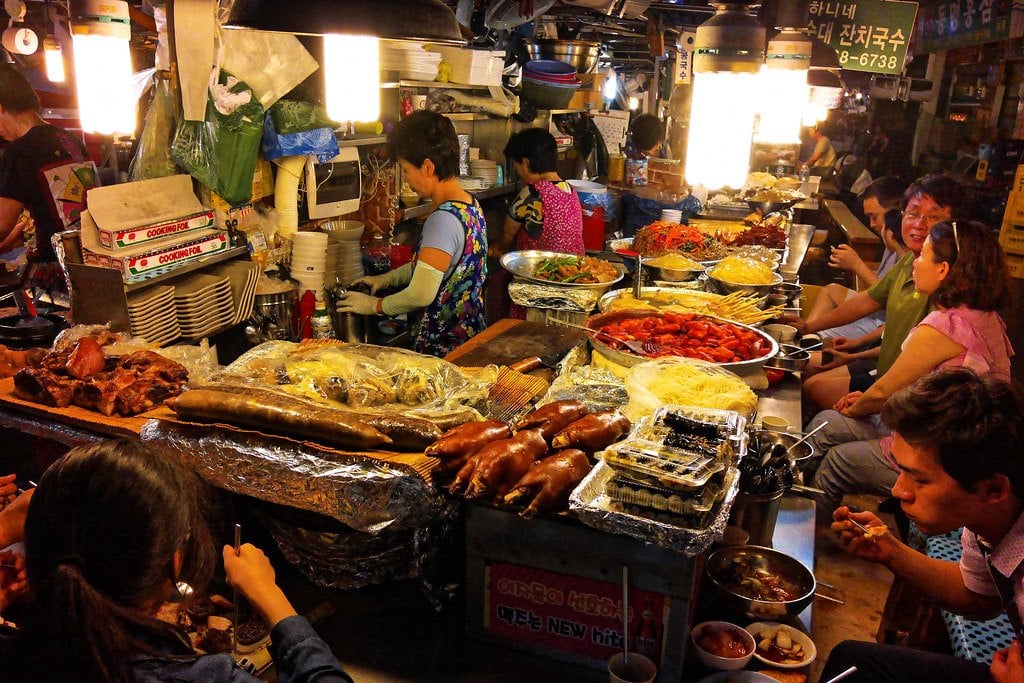
- One of the best places to eat in Seoul.
- This market is popular with tourists and locals.
Why it’s so awesome: If you want good street food when you visit another country, then you need to go where the locals go. And the locals all know to go to Gwangjang Market. This was the first permanent market in Korea selling local delicacies and fine linen and it also contains some of the best stalls in the city if you enjoy trying street food.
What to do there: You can do some shopping while you’re at this market, but mostly you want to try the food. The market’s open Monday to Saturday from 9 am to 10 pm, so bring your appetite and try as much of the street food as you can. Make sure that you try the bindaetteok or mung bean pancake and tteokbokki and noodles for a really unique eating experience.

Our GREATEST Travel Secrets…
Pop your email here & get the original Broke Backpacker Bible for FREE.
#17 – Hongdae – A must-see for foodies!
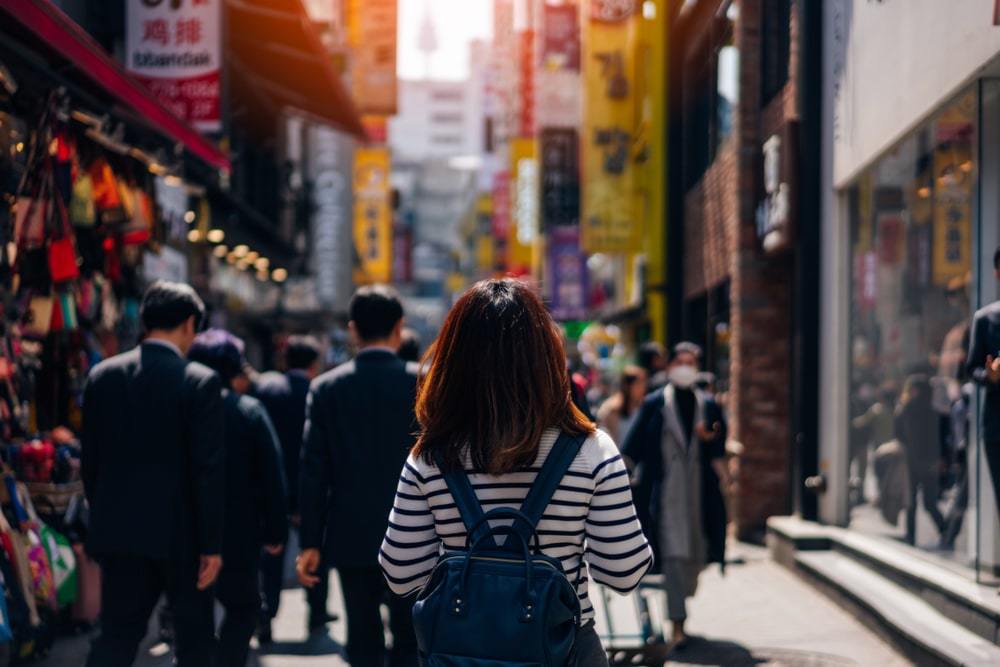
- Seoul’s nightlife center.
- This area is near the university, which is why it’s filled with young people and fashionable places to eat and party.
Why it’s so awesome: The areas around universities in most cities are beacons for popular eateries and wicked nightlife and Seoul is no different. Just moments from Hongik University, one of the most prestigious in the city, this area attracts students, locals, and tourists who enjoy the best and most fashionable shopping and dining in the city. Some of Seoul’s best hostels are in the area too!
What to do there: This is an area that really comes alive at night, so save it for an evening when you don’t have much to do. Find somewhere to eat, because this is one of the best places to eat in Seoul, and then go shopping. There is a range of clothing stalls and shops selling vintage goods so take your time and see what’s available. And if you enjoy clubbing, you’ll find lots of different options in this area.
#18 – Ikseon-dong Hanok Village – An unknown (but awesome) place to see in Seoul!
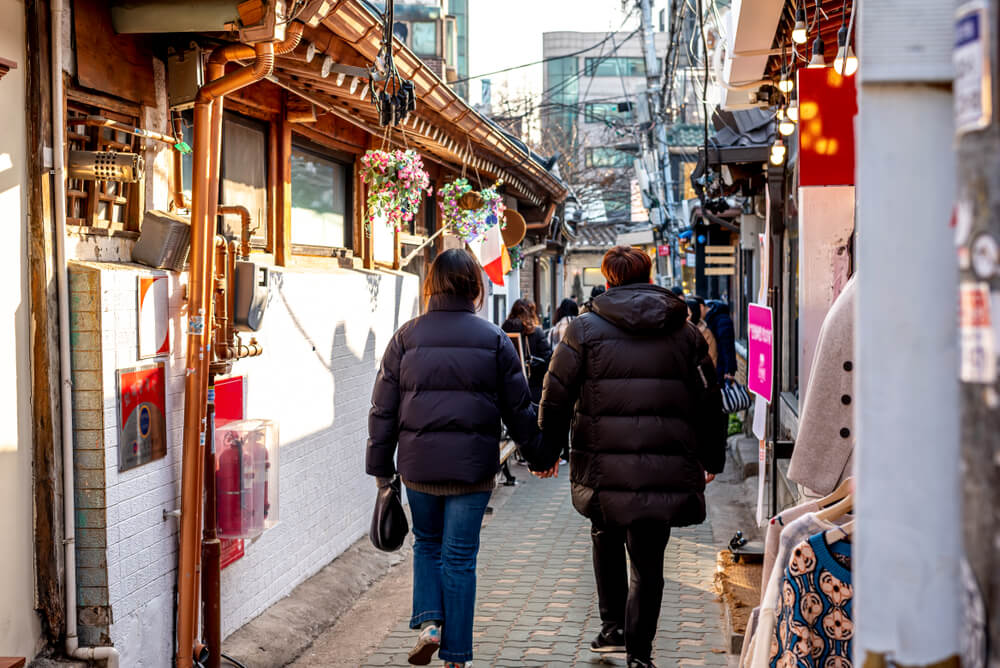
- The best place in the city to experience old Korea.
- There are some amazing cafes and pubs in this area too, so make sure you have a meal during your explorations.
- If you’re trying to decide what to do in Seoul off the tourist trail, this is the perfect place to visit.
Why it’s so awesome: This area isn’t usually listed as one of the best places to visit in Korea, but it’s great if you want to enjoy a mix of history, food, and creative shopping options. The area was first established in 1920 and preserves that time almost perfectly. Wandering the alleys could almost make you believe that you’ve moved back in time, and makes for a great afternoon.
What to do there: Just wander the alleys and enjoy the time away from Seoul’s tourist spots. There’s always something hidden to discover and explore in this area, and it’s well worth spending some time there to get a real feel for the past.
But don’t neglect the present either, because the shops are some of the most interesting in the city too. So, do some shopping and then stop at one of the artisan cafes or gastro pubs for a meal. It’s also worth it to join a pub crawl tour with a local guide to get to know the hidden gems of this cool district.
#19 – Insa-dong
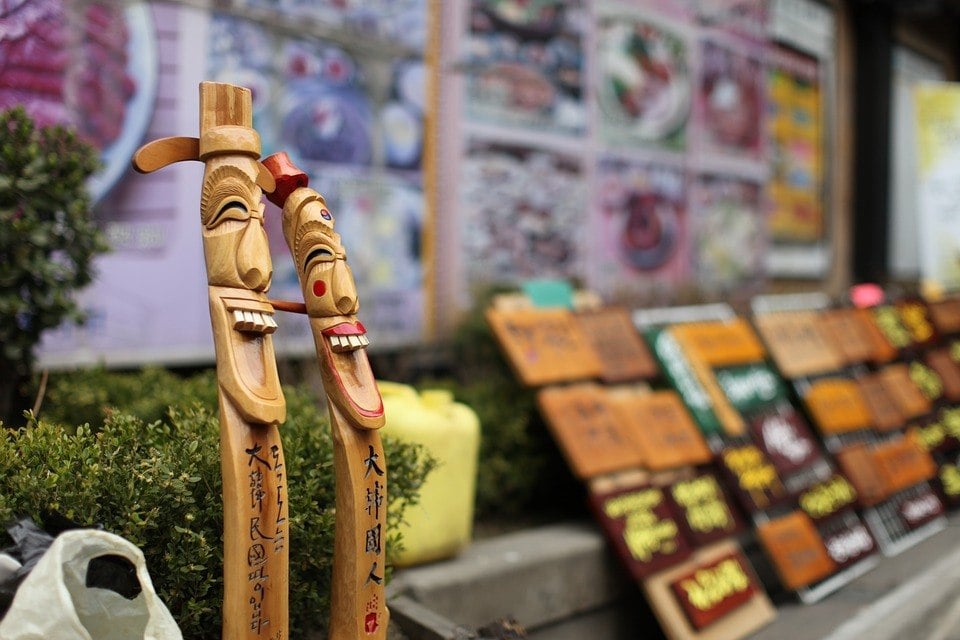
- If you want unique souvenirs, this is one of the hotspots in Seoul for them.
- The center of Korean traditional culture and crafts.
- A great place to explore Seoul and support local craftsmen at the same time.
Why it’s so awesome: If you’re interested in traditional Korean culture and crafts then this is the place where it’s all gathered together so you don’t miss anything. Insa-dong specializes in goods that can only be purchased or enjoyed in Korea, so it’s the perfect place to grab a souvenir for your loved ones back home!
What to do there: There are about a hundred galleries in Insa-dong and they display every type of Korean craft that you can imagine or have ever heard of. Make sure you check out the hanboks, which is a piece of traditional Korean clothing, traditional teas, and folk crafts. Also, try to go on a Sunday as streets are blocked off to allow for stalls and booths as well as traditional performances and exhibits.

Drink water from ANYWHERE. The Grayl Geopress is the worlds leading filtered water bottle protecting you from all manner of waterborne nasties.
Single-use plastic bottles are a MASSIVE threat to marine life. Be a part of the solution and travel with a filter water bottle. Save money and the environment!
We’ve tested the Geopress rigorously from the icy heights of Pakistan to the tropical jungles of Bali, and can confirm: it’s the best water bottle you’ll ever buy!
#20 – Yongma Land Abandoned Theme Park – A haunted place to visit in Seoul… maybe…
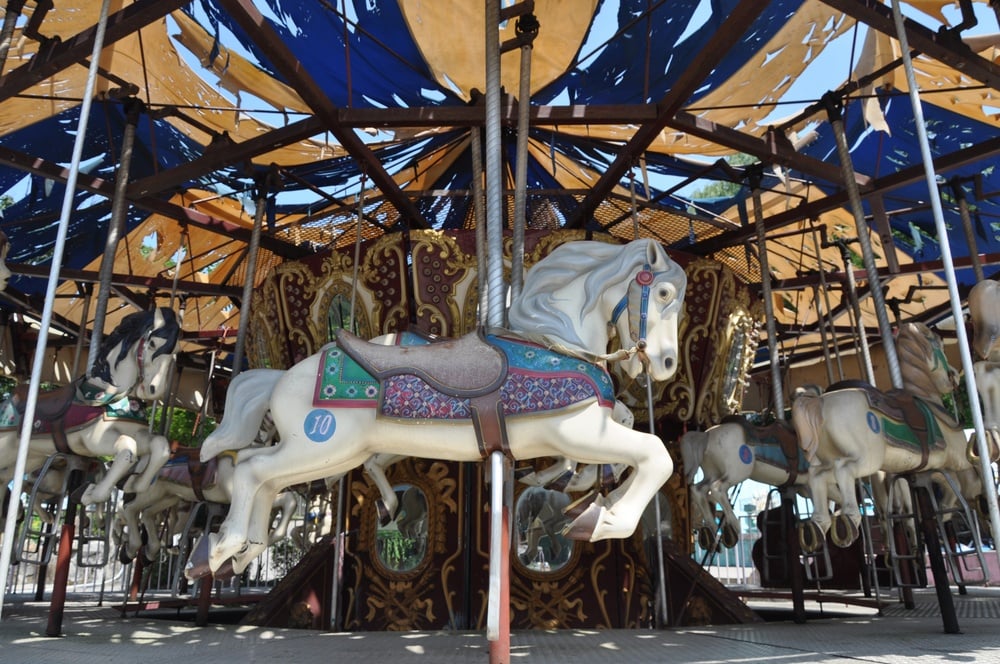
- A slightly creepy look at the other side of entertainment.
- There are stories going around that the park shut down because of a ghost!
- If you want to find unusual things to do in Seoul, this is the perfect place to start.
Why it’s so awesome: Yongma was built in 1980 and was a small, family-run amusement park. It shut down in 2011, allegedly because of ghosts, though it’s far more likely that the owners had economic reasons for closing their doors. But since then, the park was bought by a savvy businessman who invites visitors to become part of the park’s demise.
What to do there: If you’ve ever wanted to explore an abandoned amusement park, this is your chance. You can clamber over old dodgem cars, try out the carousel, and take pictures next to a sad clown roller coaster.
There’s a small charge involved, and if you get there at night you can pay a little extra and ask the owner to turn on the lights of the merry-go-round while you’re there. Set against the declining rides, it’s a ghostly sight that should be savored.
#21 – Seodaemun Prison – Possibly one of the most important historical places to visit in Seoul.
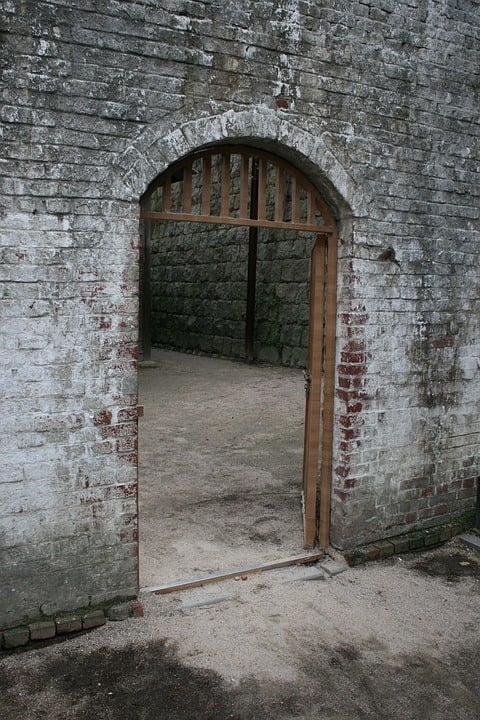
- Not a fun place to visit, but an important one if you want to understand South Korean history.
- This was a prison built for Koreans who rebelled against Japanese forces.
Why it’s so awesome: Built in 1908, this prison held Korean rebels who fought against Japan’s invasion and occupation. Before it was created, the country had virtually no penal system, and this location came to symbolize the determination of the Korean people to win their freedom despite the costs. Many Korean patriots died in custody, were tortured or executed at this location, and it’s a sobering reminder of the darker side of humanity.
What to do there: This isn’t a fun place to visit in Seoul. It was designated as a historic site in 1988 and renovated in 1995 and is a stark and sometimes brutal slice of Seoul’s history. As you walk through the prison-turned-museum, you’ll see torture chambers with terrifyingly realistic mannequins of famous Korean patriots and get an idea what it was like for the people who lived and died within the prison’s walls.
#22 – Coffee Hanyakbang – Seoul’s Must-Visit for the Coffee Connoisseurs
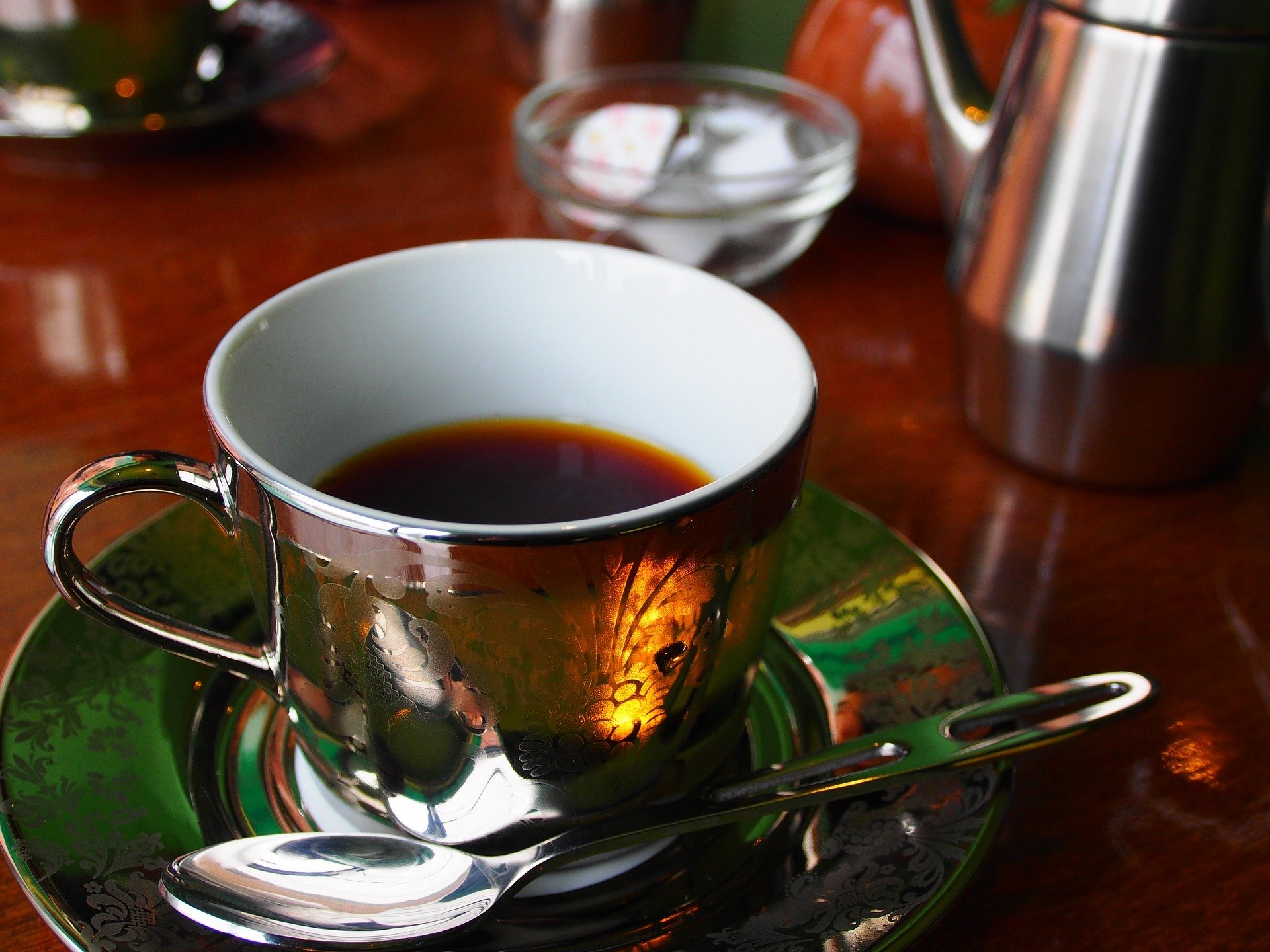
- The perfect place for coffee lovers of all ages.
- A nearly hidden gem that only the locals know about.
- If you live for your morning coffee, you’ll find lots of new coffee tastes at this site.
Why it’s so awesome: Almost everyone loves coffee and this tiny shop allows you to celebrate it in style. It’s almost hidden down a narrow, unmarked alleyway but coffee connoisseurs know that it’s there and turn up in droves to get the perfect coffee experience. The shop is decorated in a mix of Korean and Chinese styles and is determinedly rustic, with lots of wood and exposed pipe. And it sells delicious, hand-drip coffee at decent prices.
What to do there: Drink your morning coffee, of course! The owners roast the beans by hand at the back of the shop and grind them on site, so the whole shop has that rich, tongue-tingling smell of fresh coffee. And the making of each coffee is a science too, with everything precisely calculated to create the perfect cup, every time. So enjoy!
#23 – The War Memorial of Korea – A different take on a war memorial.
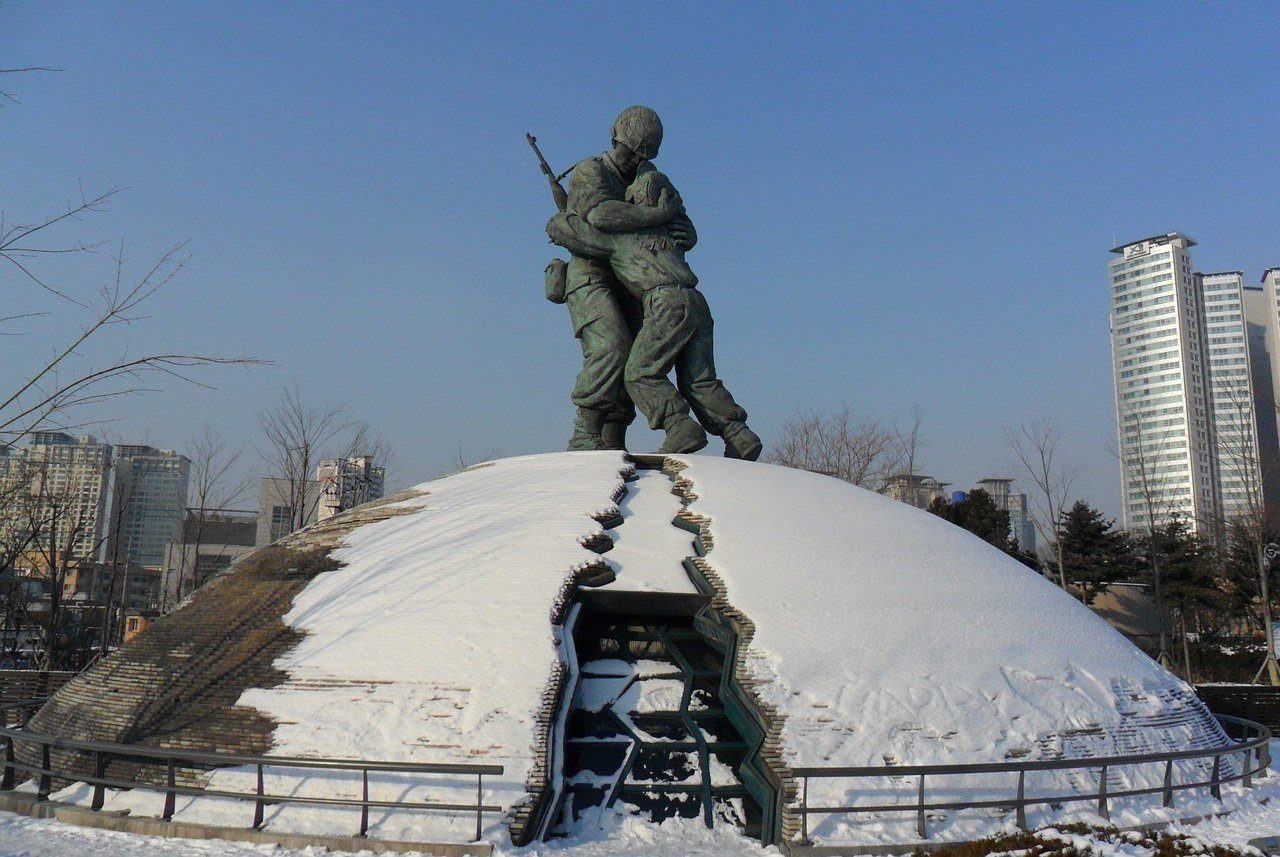
- A strangely lighthearted look at Korean military history.
- Fun and educational, so it’s a great place to take the kids.
Why it’s so awesome: There are 6 exhibition halls and an outdoor space for war machines too big to fit inside at this site and the place is packed. In fact, there are over 13,000 pieces of military equipment and memorabilia at the Korean war memorial , placed on the grounds of the former army headquarters of Korea.
The focus is on the Korean and Vietnam war and this isn’t the type of museum where you just stand back and look. The displays are designed to be touched and felt, to give visitors a better idea of what the wars were really like.
What to do there: There’s a lot to see at this memorial so make sure you put aside a few hours. The Combat Experience Room is particularly interesting and uses audiovisual effects to surround you with the sounds, sights and smells of the battlefield. Outback, the lines of tanks and heavy artillery are laid out like a metal petting zoo, and if you’re interested in this type of machinery, you’ll have an amazing time exploring it all.
#24 – Jogyesa Korean Buddhist Temple – For some sacred sightseeing in Seoul.
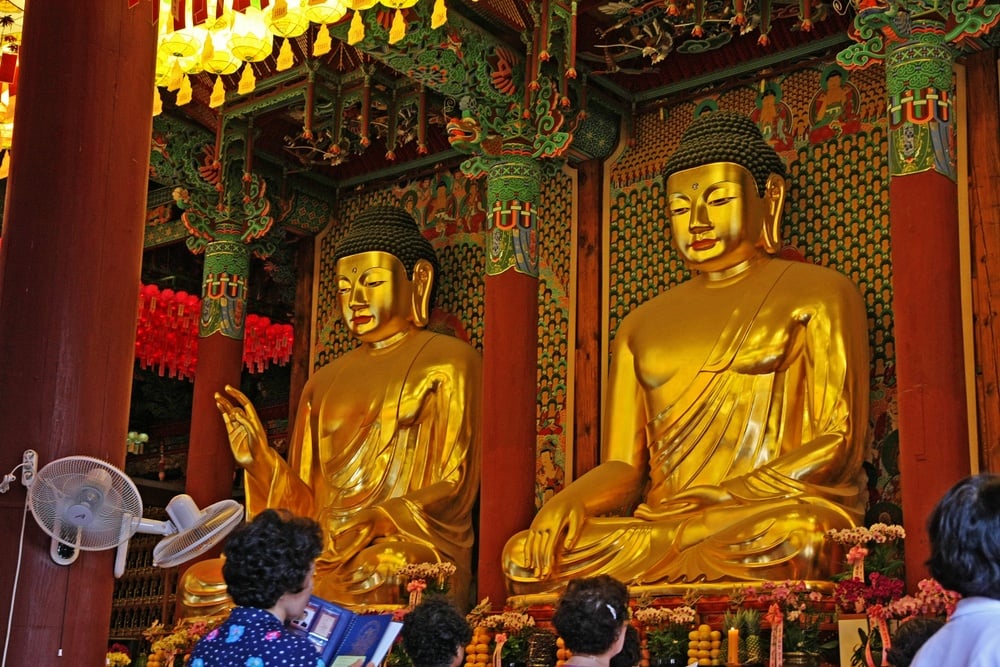
- A Buddhist temple that’s an important part of the locals’ lives.
- The garden surrounding the temple has some ancient trees that are simply amazing.
Why it’s so awesome: Sometimes there’s nothing like exploring a temple that’s still in use in the modern-day if you want to understand a culture better. And this temple in the middle of Seoul’s high-rise district is one of the best places to visit in the city to learn more about its people. This Zen Buddhist temple is always full of locals and tourists, which makes it an exciting, as well as an interesting place to people, watch and spend some quality time.
What to do there: Spend some time just watching the people as they come and go on their everyday business. And when you’re done, explore the compound itself. You could also find yourself a guide that will show you around and explain each statue in detail.
The trees in this area are apparently over 500 years old and they’re strung with banners and streamers in bright colors to make them look even more spectacular! This all combines to make this temple one of the top places to visit in Seoul if only for a quick contemplative meditation.
#25 – Suwon’s Hwaseong Fortress – More of Seoul’s old landmarks!
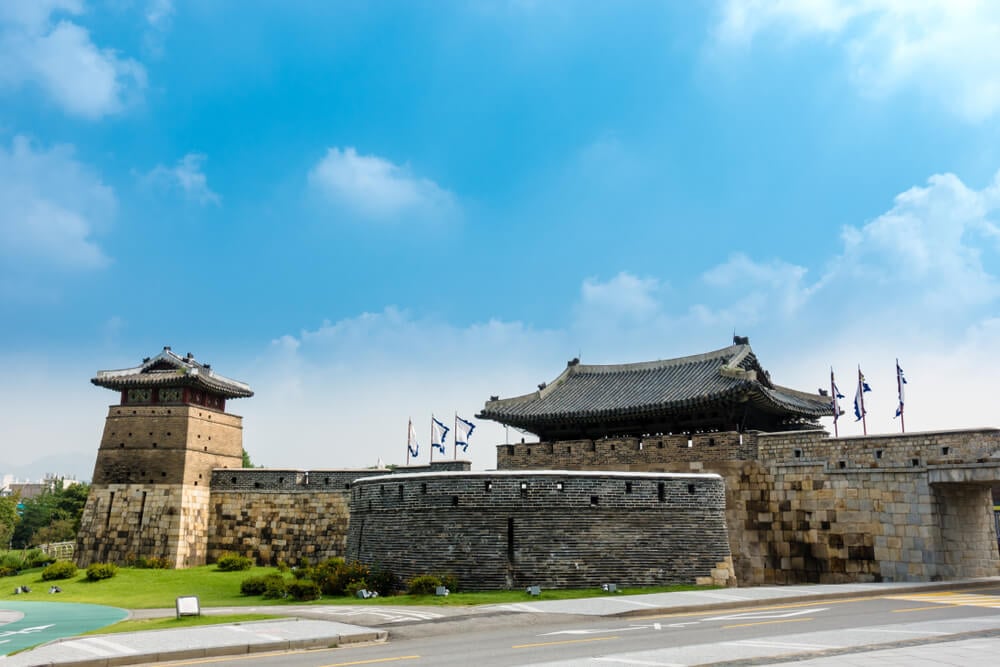
- If you’re looking for a quick day trip from the city, then make it to this UNESCO World Heritage Site.
- Located only an hour and a half from Seoul.
- One of Seoul’s most important historical sites.
Why it’s so awesome: Built between 1794 and 1796, this fortress was created to house the remains of the King’s father, who had been murdered by his own father. It’s an enormous complex that was meant to be the first step in moving the capital from Seoul to the city of Suwon, where the Fortress is located. This obviously never eventuated, but the fortress remains and was declared a UNESCO site in 1997 .
What to do there: It will take you a couple of hours to see the entire castle, so if you have a spare morning or afternoon while you’re in Seoul then make the trip out to see it. There are a lot of different features including the interior and exterior as well as a palace museum, so make sure you take enough time to see it all.
#26 – Seoul’s Children’s Park – A beautiful place to go outdoors in Seoul.
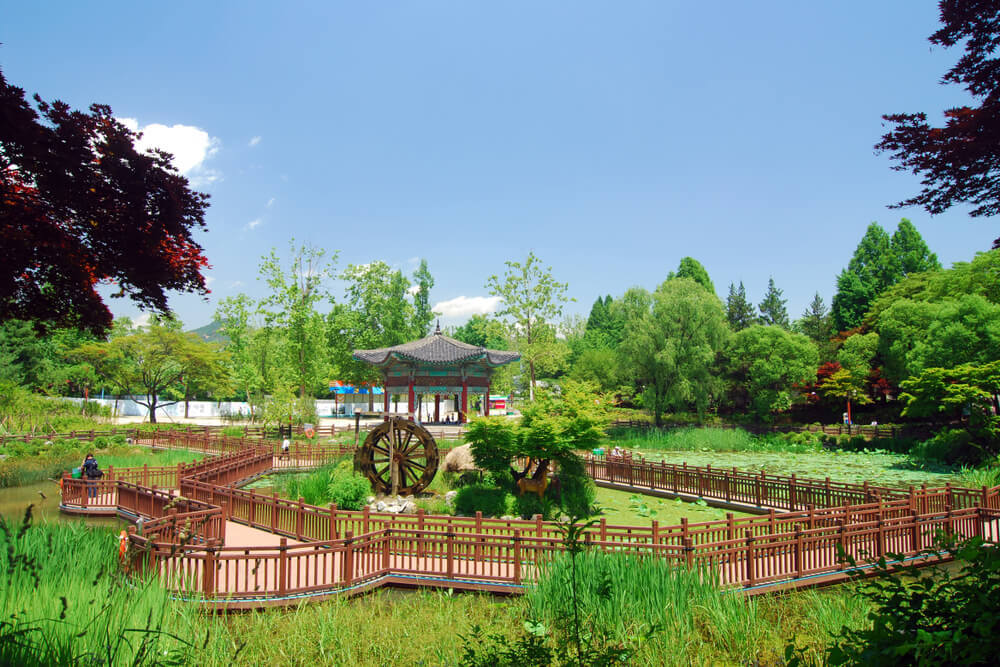
- A great place to take the kids.
- Even if you don’t have children, you’ll enjoy this massive green area in the central Seoul.
Why it’s so awesome: If you’re tired of the skyscrapers and find yourself longing for some greenery, then you can find this park in the middle of the city. Not only does it include a lot of green, open areas, there are also some cool exhibits and attractions in the park that will interest everyone, not just the young.
What to do there: Escape from the city and spend some time in nature. This park also includes amusement rides and playgrounds as well, so if you feel like being a little more active then there are lots of things to try!
#27 – A Lotte Mart – A weird choice of things to see in Seoul but hear me out!
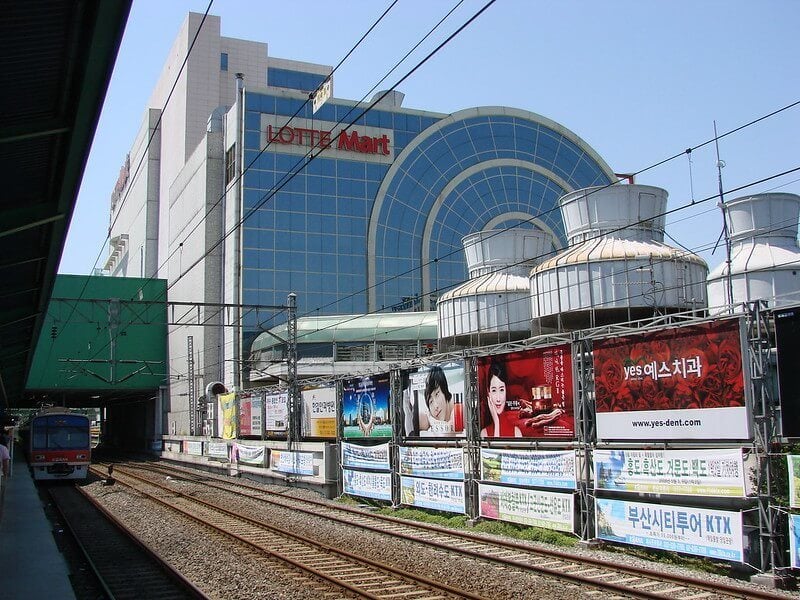
- Lotte Marts in Seoul aren’t like the ones back home, so make sure you stop by for a look and a snack, you’ll be surprised what you’ll find there.
- If you love snacking but want to save some money, you can eat like the locals do with some very unusual meals and snacks from this store.
Why it’s so awesome: It sounds a bit strange to suggest that you go to a supermarket, but this is one experience you really shouldn’t miss because these stores are one of the most famous places in Seoul.
Lotte Marts are iconic in the city and they’re one of the coolest grocery stores in the world. While wandering around you’ll get a much better idea of how important food is in Seoul. And you might also find some new treats to try too!
What to do there: Make sure you take part in the whole experience. Lotte Marts usually have free food samples as well as an incredibly wide range of foods that you’ve probably never seen anywhere else. Just watch your wallet, because it’s too easy to overspend in Lotte Mart, and buy something tasty.
#28 – The Jongmyo Shrine – Another cultural highlight of Seoul.
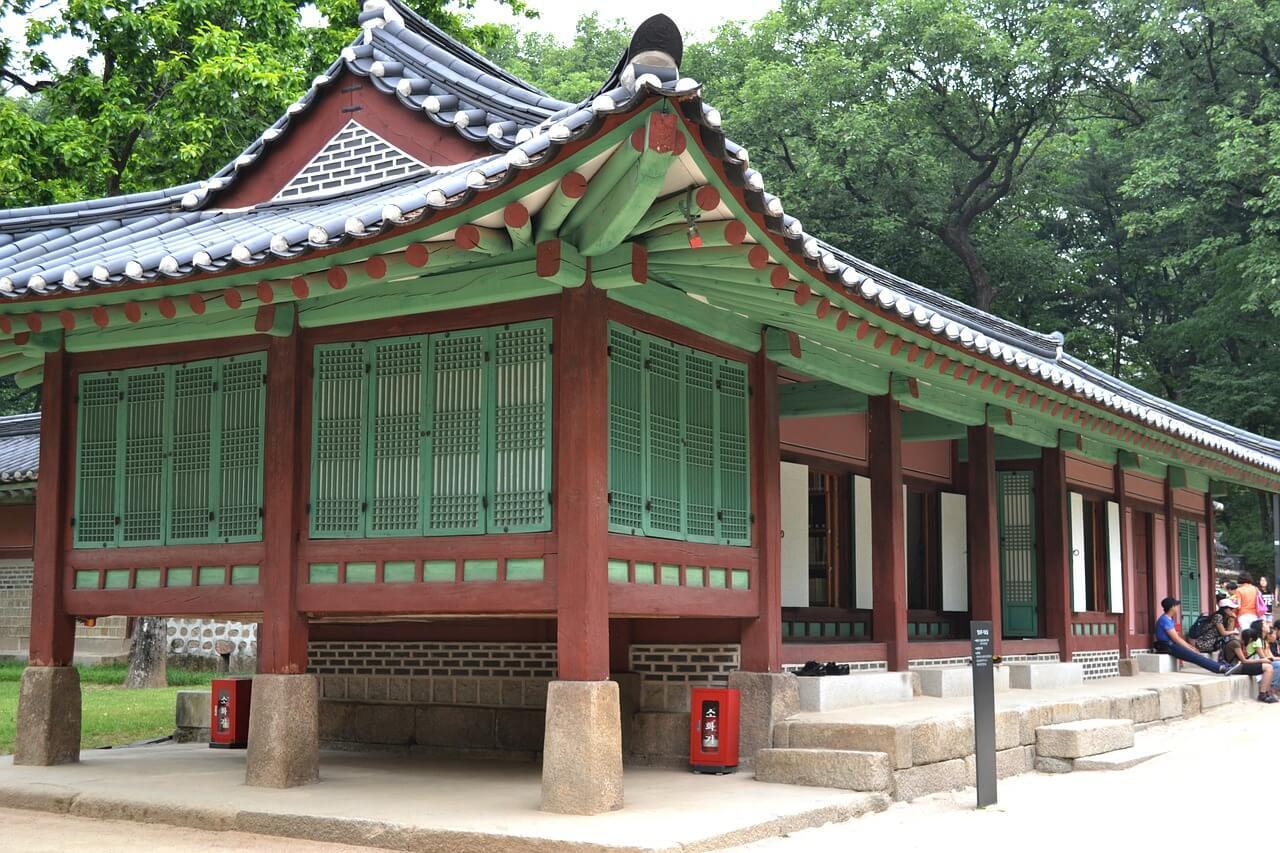
- A UNESCO-listed site and close by the popular suburb or Insadong.
- A Seoul must-see when you’re in the city.
Why it’s so awesome: This is one of the most popular landmarks in Seoul and it’s also one of the best ways to learn about its ancient traditions. This shrine is the most popular attraction in Seoul and it’s a UNESCO Heritage site; the perfect way for you to learn more about the history of the city.
What to do there: If you go to the shrine on Saturday then you can explore on your own. Any other day except Tuesday when the shrine is closed, you will need to join a guided tour. There are tours in English every couple of hours. While you’re there, make sure that you pay attention. You’ll learn about ancient customs, music, and even about memorial services during your visit, so it’s worth paying attention.
#29 – National Museum of Modern and Contemporary Art – More awesome Korean art!
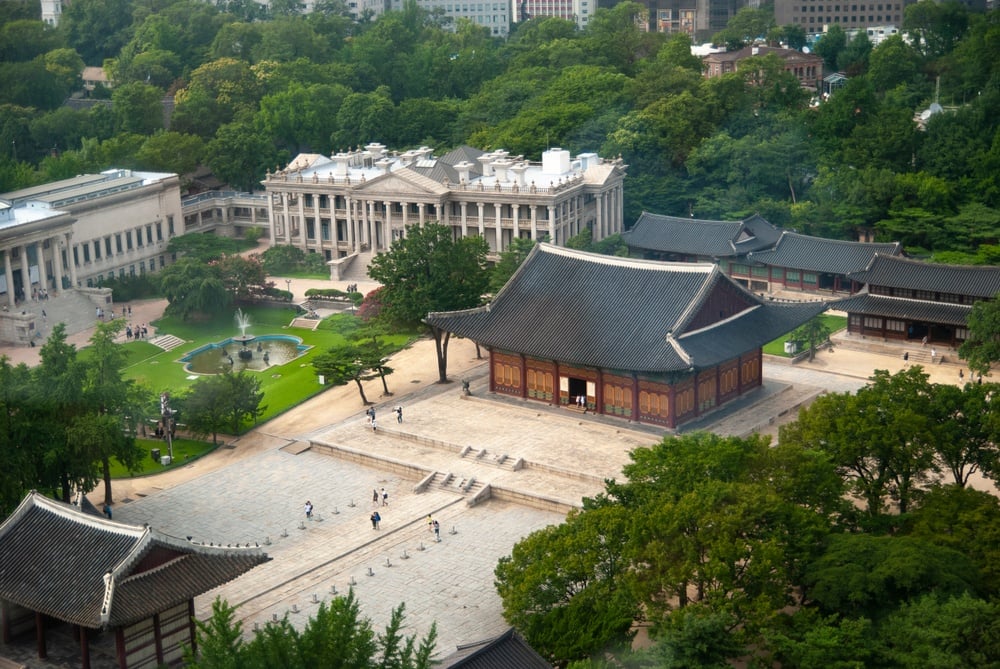
- The National Museum of Modern and Contemporary Art in Seoul is an amazing traditional style building.
- Located on what used to be Seoul’s Defense Security Command.
Why it’s so awesome: This museum is a must-visit on your Seoul itinerary. It’s an enormous museum that’s built on the principles of madang , which encourages people to socialize together by providing a large, communal courtyard just for that purpose. And it works too, which makes it a great place for people watching.
What to do there: The exhibits at this museum change regularly, so find out what’s on while you’re in the city and don’t miss out. Also, spend some time exploring the building while you’re there. Korean architecture is unique and deserves some time and attention.
#30 – Socheon – A nice non-touristy place to visit in Seoul
- If you’re looking for the best food in the city then you need to go to Socheon, which is where the locals go.
- You’ll have some of your best meals in a slightly dingy restaurant in this part of the city.
Why it’s so awesome: Socheon is one of the best places in Seoul for cheap and delicious local food and a good break from the tourist attractions. Located on the west side of Gyeongbokgung, this area caters mostly to locals, so you won’t find as many fancy restaurants and neon lights there. Instead, you’ll find mostly ordinary, slightly run-down restaurants that serve some of the best food you’ve ever tasted.
What to do there: Some restaurants serve great food in this area but they’re a little hard to find. Most of them don’t have a website or even a menu in English, so you’ll have to order your meal from pictures or by what the locals are eating. To get a great meal, walk until you find a place that contains a lot of locals. Figure out what you want and just point – whatever you get, it’ll be delicious!
#31 – Dongdaemun – An awesome neighborhood in Seoul.
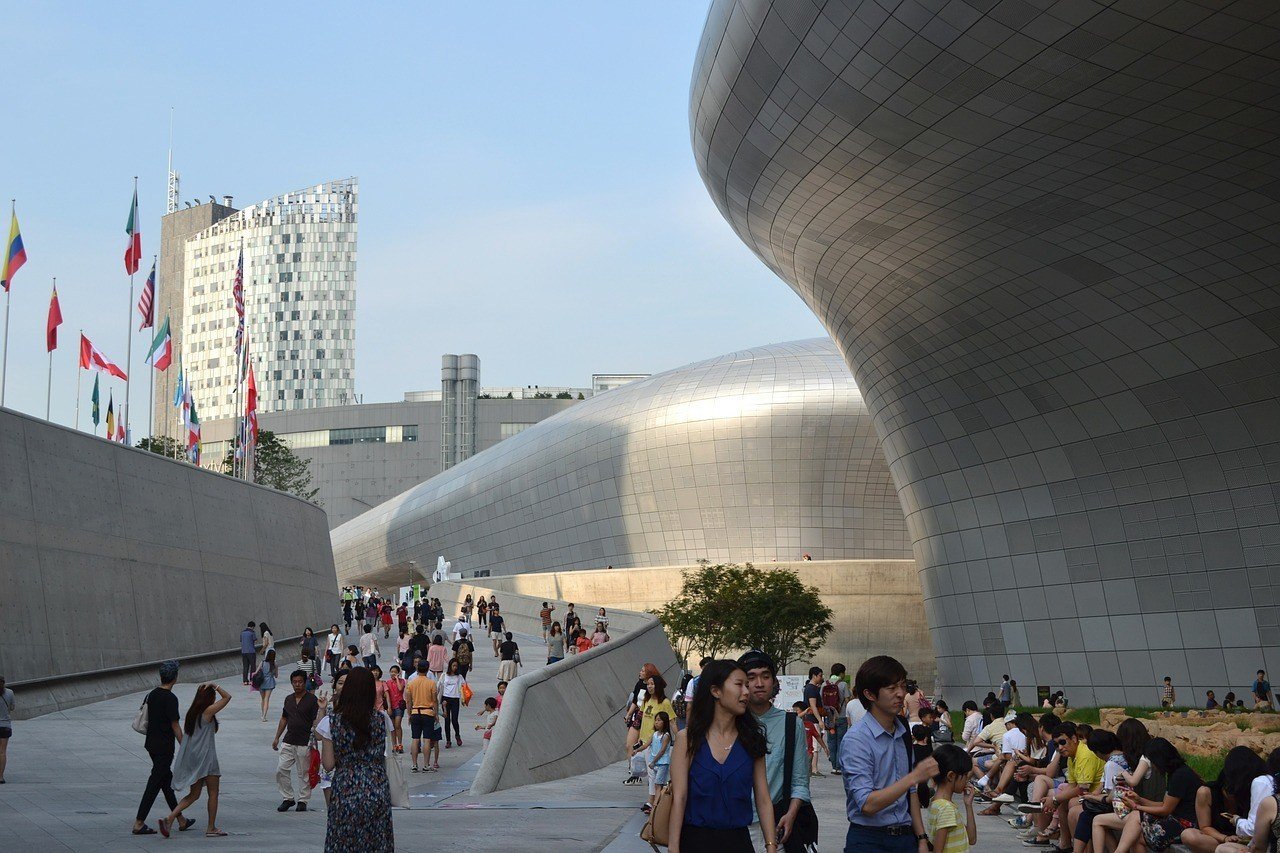
- One of the best places in Seoul for bargain shopping!
- Bring cash so you can haggle down the prices.
Why it’s so awesome: Dongdaemun shopping area is a veritable labyrinth of wholesale and retail shops. You could quite literally get lost in this area looking for something, and the crowds of locals and tourists alike enjoying the bargains are evidence of how good the prices and the variety of goods are.
What to do there: If you’re looking for something specific to buy, chances are that you’ll find it in this area. Take cash with you so you can haggle and find something sweet. But if you just want to wander and people watch, this is the perfect place for it too. Many of the shops are open all night, so there’s always something going on for you to observe.
#32 – Dongdaemun Design Plaza – A famous modern landmark in Seoul.
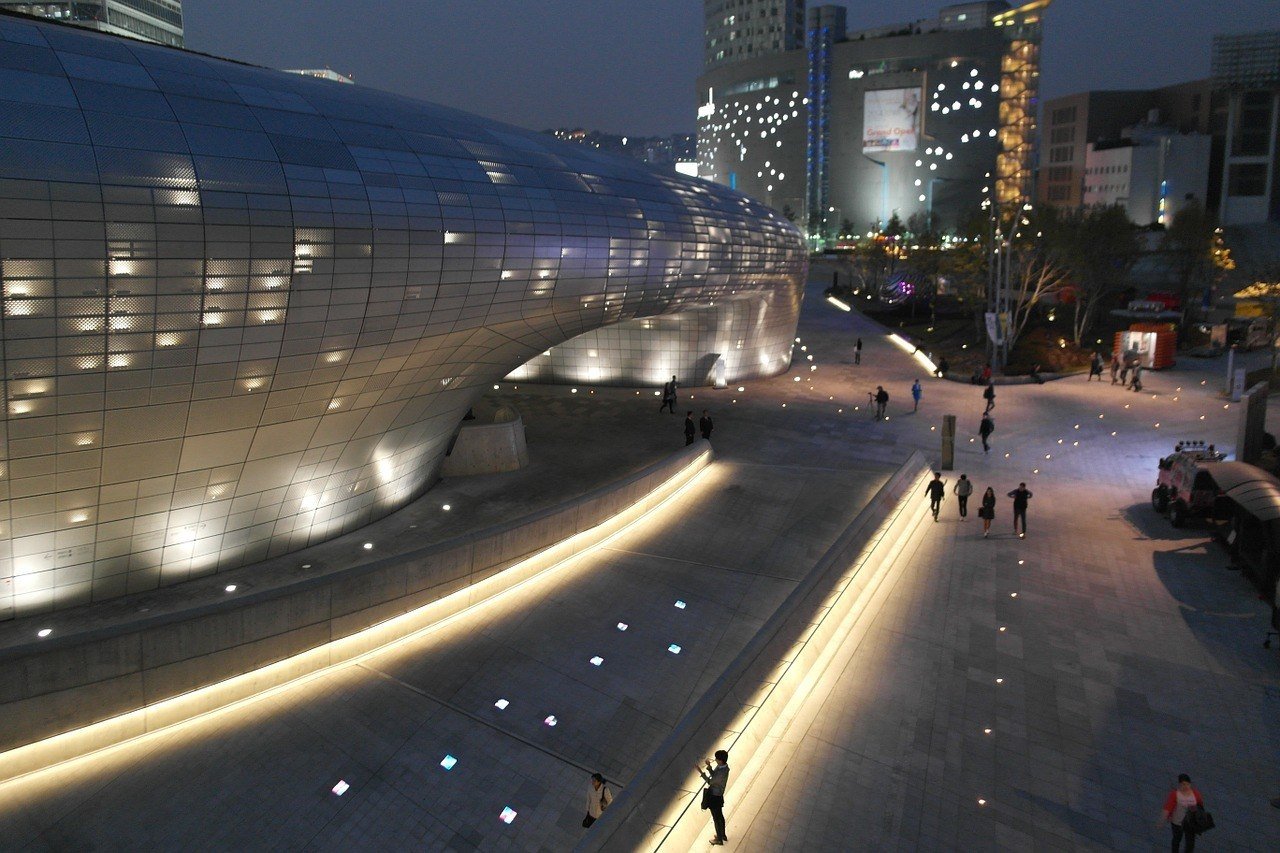
- One of the hotspots in Seoul for shopping and entertainment options.
- The building itself is unusual, stunning, and looks great in photos.
Why it’s so awesome: This building is one of the most eccentric in the city and looks amazing in photographs for you to put on your social media feeds. The long, sinuous curves of the building seem to go on forever and as if that wasn’t enough it also contains countless stores, exhibition spaces, parts of the original Seoul fortress that used to stand on the site, and a design museum.
What to do there: Make sure you take a photo of yourself with this building to show the people back home because the curving lines back for a great background. And then just explore the building. You can shop, explore the history of the site, or just wander the floors looking for anything that looks like fun. It’s the perfect place to go for anyone who’s looking for Seoul vacation ideas.
#33 – Mapo-Gu – A quirky area in Seoul to visit.
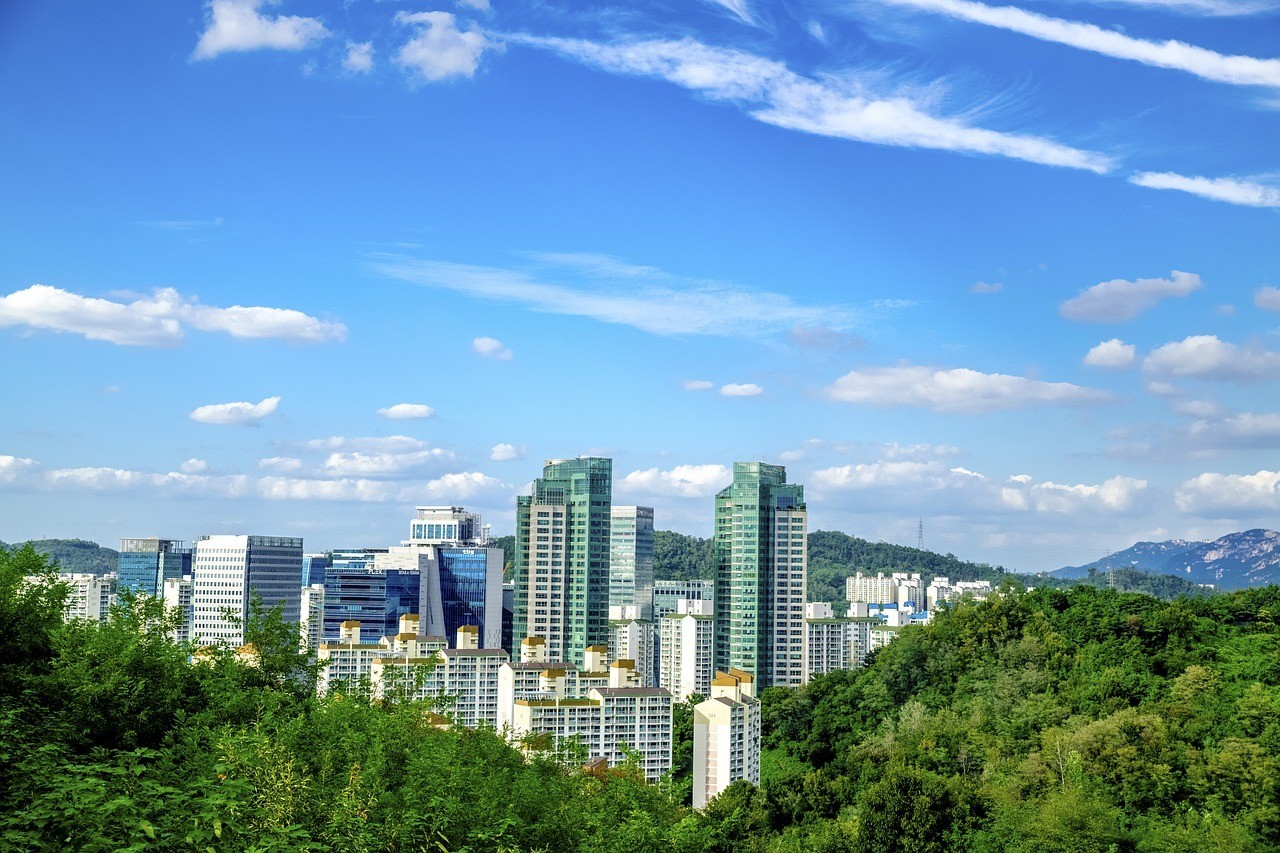
- One of the quirkiest places to go in Seoul.
- If you’re looking for weird and wonderful experiences and cafes, this district will exceed your wildest expectations.
Why it’s so awesome: Mapo district is one of Seoul’s 25 districts and it’s also one of the most unusual. It’s home to a large number of themed cafes, so if you want your cup of coffee with a side of cats, dogs or raccoons, you’ll find all that and more in this district.
What to do there: Korea is constantly innovating and looking for new ways to explore old ideas and you can experience that first hand while you’re in Mapo-Gu. Try the poop café if you’re looking for one of the most unusual places in Seoul, or just wander from one café to another hugging cute animals!
#34 – Nami Island
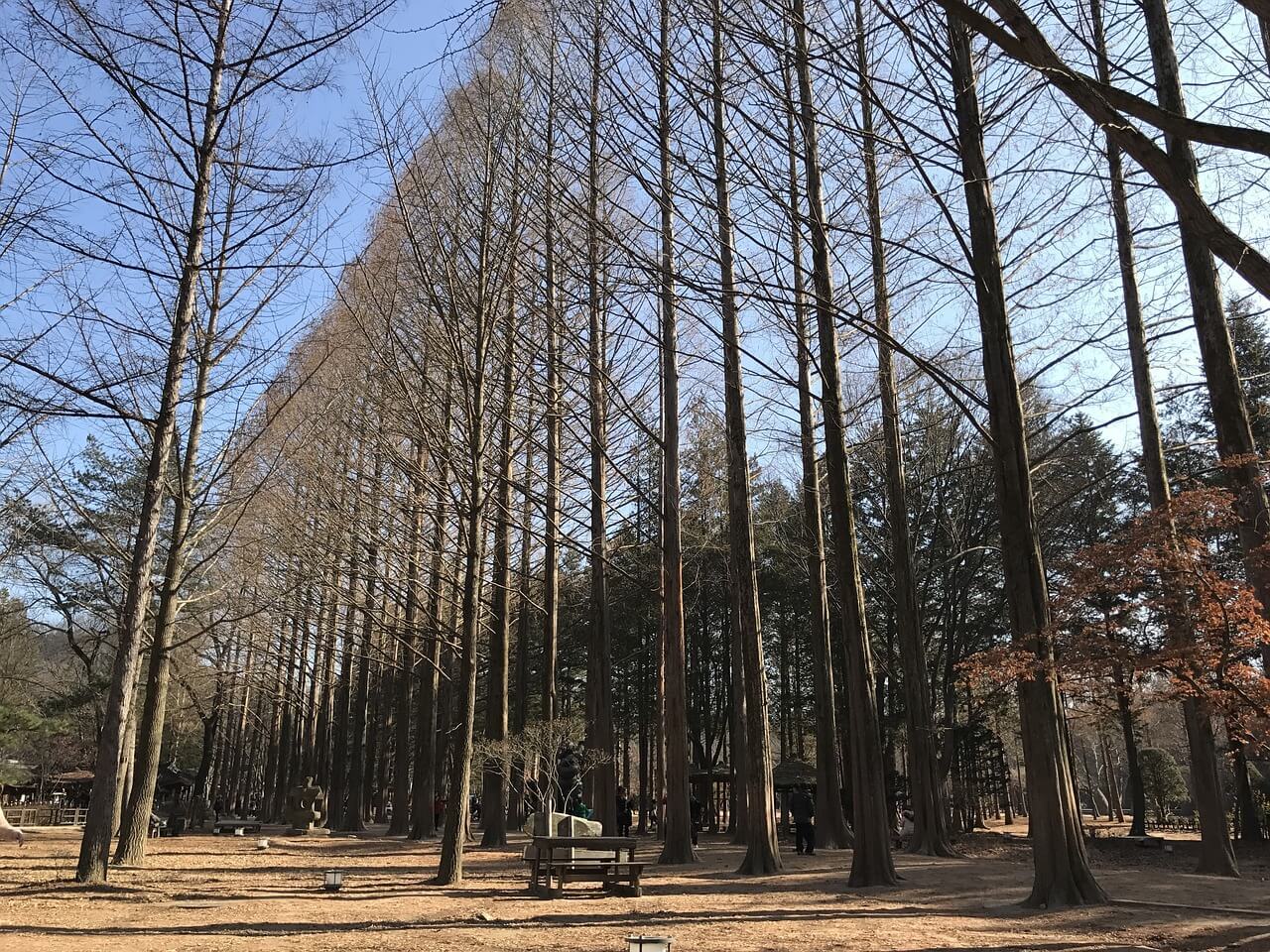
- One of the most popular spots for a holiday break in Seoul.
- It’s usually thronged with tourists so show up early if you want to avoid the lines.
Why it’s so awesome: Nami Island is a lovely nature area close to the city that’s a fantastic place to visit in the winter and summer months. In summer it has rides, zip wires, hiking, and lots of large open spaces to explore. And in the winter, it’s set up for all the winter sports and activities that you’ve ever dreamed of trying.
What to do there: Nami Island is an awesome place to visit in winter as the lake freezes and gives you an amazing view across the lake. It’s also home to a lot of winter sports and activities, which is why tourists and locals alike travel there in throngs to enjoy the colder months. Also, if you like to read, make sure you visit Petite France, which is a village modeled after the famous book The Little Prince.
Get insured for your trip to Seoul!
When you’re travelling to Seoul, having good travel insurance is an absolute essential BEFORE you set off. It means if things go wrong, you’re already in a good position.
ALWAYS sort out your backpacker insurance before your trip. There’s plenty to choose from in that department, but a good place to start is Safety Wing .
They offer month-to-month payments, no lock-in contracts, and require absolutely no itineraries: that’s the exact kind of insurance long-term travellers and digital nomads need.

SafetyWing is cheap, easy, and admin-free: just sign up lickety-split so you can get back to it!
Click the button below to learn more about SafetyWing’s setup or read our insider review for the full tasty scoop.
Find out what people want to know about the best places to visit in Seoul
Is 3 days in Seoul enough?
Three days should be enough to see the main highlights, but there are some gorgeous hikes around the city that are worth staying longer to see.
Is Seoul a safe place to visit?
Yes, Seoul is a safe place to visit and violent crimes are rare.
Is Seoul a cheap place to visit?
No, Seoul isn’t a cheap place to visit, though there are some cheap attractions that will help keep costs down.
What is a free place to visit in Seoul?
The Seoul Museum of Art is a free place to visit in Seoul and a great place for art lovers to explore.
Seoul is an ultra-modern city where you can experience the latest technology alongside ancient traditions and culture. This capital of South Korea is a powerhouse in the world economy at the moment, which makes it a very attractive location for visitors from all walks of life.
South Korea perhaps gets overlooked sometimes by its other East Asian neighbors, however, it is a rich country with an ancient history and vibrant people. Backpacking in South Korea is a rewarding journey, but more than likely you’ll start in Seoul.
Seoul is a city that never sleeps, with ancient palaces next to skyscrapers and night markets, and it’s the perfect location for anyone looking to experience a different side of Asia. And if you use this easy guide to Seoul’s coolest places to visit and the most sobering historical sights, you’ll walk away with memories that last a lifetime.
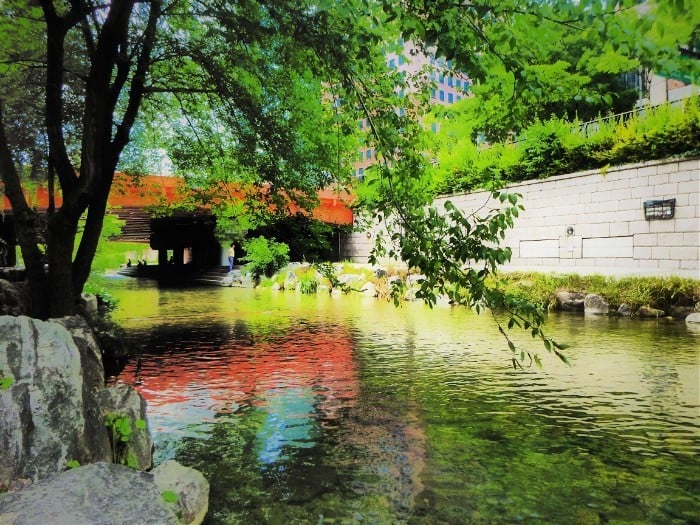
And for transparency’s sake, please know that some of the links in our content are affiliate links . That means that if you book your accommodation, buy your gear, or sort your insurance through our link, we earn a small commission (at no extra cost to you). That said, we only link to the gear we trust and never recommend services we don’t believe are up to scratch. Again, thank you!
Share or save this post

Thanks for the info. Suggestions like “Mapo-Gu” are a bit ridiculous, if you pull it up on google maps that region could take a week or more of 6 hour days walking. I doubt anywhere but a small part of it is of interest, but where? Who knows. Same seems to be the case for Socheon which I don’t know how to pull up. We need like a center point or at least main strip indication please.
Hi Justin. It’s 33 minutes by bus to Mapo-Gu although I suppose you can walk there if you want. We have included this area for it’s general vibe and invite our readers to explore it on their own terms.
Hmm. Sorry what I mean is Mapo-Gu (in English Mapo District) is nearly half the size of Manhattan. Do you get what I mean when I say it wouldn’t make sense to tell someone “you can walk to Manhattan if you want, but once you are there you can experience the vibe and find everything?”
I also explored these fabulous attractions during my last tour and came back with an awesome experience.
Leave a Reply Cancel reply
Your email address will not be published. Required fields are marked *
Save my name, email, and website in this browser for the next time I comment.
Notify me of followup comments via e-mail.
- Skip to content
- Skip to primary sidebar
4corners7seas
Overland travel blog
The Five Grand Palaces of Seoul: which Seoul palaces should you visit?
Architecture , History , Korea / November 22, 2017 by Simon Norton / 4 Comments
The Five Grand Seoul Palaces of the Joseon Period , along with Jongmyo Shrine, make up the main traditional sightseeing spots in the Korean capital. Although the sites mostly date back to the 1300s – 1500s, the majority of the buildings standing on them today are actually recent reconstructions, as the original structures were destroyed by Japanese invasion (16th Century), and the reconstructions then destroyed by Japanese occupation (20th Century), and repeatedly by fire; the East Palace (Changdeokgung & Changgyeonggung) is the only one with a decent number of surviving pre-20th Century structures (around a third), but the reconstructions have been done well and do look the part.
Visiting all five would probably be overkill for most visitors, especially if you’re only in Korea for a short time. On the other hand, you should probably visit at least one or two while you’re in Seoul!
So, which one(s) to visit? Read on below for more detail on each palace, but in a nutshell:
Gyeongbokgung if you want to see the most historically important & physically impressive of the Seoul palaces.
East Palace (Changdeokgung & Changgyeonggung) for genuinely old buildings (rather than modern reconstructions of old buildings), and for the best surrounding gardens.
Deoksugung and/or Gyeonghuigung if you’d prefer to visit smaller palace sites, perhaps combining them with a city stroll.
Changing of the guard ceremonies are held at the gates of Gyeongbokgung and Deoksugung at various times through the day (see below for times).
Some of the palaces are famous for cherry blossom viewing in April, namely Gyeongbokgung, Deoksugung, and Changgyeonggung.
(If you wear a hanbok you get free entry to the palaces; this is especially popular with bus tour groups, as well as smaller groups of tourists and locals dressing up for a day out. You can arrange hanbok rental here *)
Gyeongbokgung
The most impressive and expansive of the 5 Seoul palaces, Gyeongbokgung was the original palace (construction began in 1395) and was historically the main seat of royalty, though that moved to Changdeokgung following the Japanese invasions in the late 1500s as Gyeongbokgung wasn’t rebuilt until the 1800s.
The Japanese destroyed it again in the early 20th Century during their occupation of Korea, and most of the present buildings at Gyeongbokgung today only date from the 1990s. The reconstruction is pretty convincing though, and this is the palace to go for if you want to visit the largest and most important of them.
It’s a large site and if you also visit the National Palace Museum and/or the National Folk Museum which both stand on the palace grounds, it’ll take up half a day.
If you want to see the changing of the guard at Gyeongbokgung, you can check the schedule here
Access: Line 3 Gyeongbokgung Station / Line 5 Gwanghwamun Station (take exit 9 and walk north past the King Sejong statue)
Changdeokgung & Changgyeonggung (the East Palace complex)
These two palaces stand back to back, with a gate in the separating wall providing direct access between them; collectively they’re also referred to as Dongwol (East Palace), and though they have separate ticketing (3,000 won for Changdeokgung and 1,000 won for Changgyeonggung) it usually makes sense to visit them both in one go.
The East Palaces have the most pre-20th Century structures still standing, so if you’re wanting to see some genuinely old palace buildings rather than modern reconstructions, this is where to go (around a third of the buildings you see date from the 1600s-1800s, though are in fact still not the originals – which were also destroyed by the Japanese invasion in the late 1500s).
Changdeokgung is the second oldest of the 5 palaces, was the main one from 1592 – 1868 (between Gyeongbokgung’s first destruction & reconstruction), and is the only one to have been listed as a UNESCO World Heritage Site. The UNESCO listing is both due to the fair number of surviving older structures, and the way this palace was designed to be in harmony with its surroundings rather than imposed upon them (the Secret Garden in particular).

Changdeokgung’s famous Huwon (‘Secret Garden’) can usually only be visited on a guided tour (the ticket for this is an extra 5,000 won – if you get the all palaces combination ticket (see entry fee info at bottom of page) it also includes the Secret Garden). The guides are really good and the tour takes around 90 minutes, but if you prefer to wander freely you can do so on ‘Culture Day’ on the last Wednesday of every month, when the palaces all have free entry; it’s still 5,000 for the Secret Garden, but without the requirement to join a tour.
The Secret Garden isn’t just a pretty garden, it’s actually like an entire additional palace complex with various buildings and pavilions standing in beautifully landscaped surroundings; the entry fee may seem steep, but it’s definitely worth it if you’re there during the spring blossoms or autumn colours:

Acess: Line 3 Anguk Station, walk 5 minutes east
Changgyeonggung is notable for the large grounds it stands on, with beautiful landscaped gardens renowned for their spring blossoms and autumn colours.

Nice in winter too:

Access: Line 4 Hyehwa Station, walk 5 minutes west
Deoksugung & Gyeonghuigung
These two palaces are much smaller than the above three, so if you’re not really into palaces but feel like you ought to see one while you’re in the country, you should find one of these two nice and manageable!
They’re also located quite near one another, with an attractive tree- & sculpture-lined walled road connecting them, and there’s a good museum at Gyeonghuigung, so you can easily combine the two palaces with the museum and a bit of a city walk for a cultural half-day which isn’t too heavy on the palaces.
Deoksugung is located right outside City Hall Station (Line 1 exit 2, or Line 2 exit 12 and head north), and historically served mostly as an auxiliary palace. It wasn’t as badly destroyed as Gyeongbokgung and Gyeonghuigung, so you do see a few pre-occupation structures alongside the modern reconstructions.
It’s also notable architecturally for being the only Korean palace with some western-style buildings (dating to the early 20th Century). Deoksugung is a popular cherry blossom spot too.
You can see the changing of the guard at Deoksugung at 11:00, 14:00, and 15.30 daily (except Mondays)
Gyeonghuigung is the youngest of the Seoul palaces, having been first built as a secondary palace in the 1600s i.e. after the Japanese invasions which wrecked the other original palaces. However it was badly damaged by fire in the 1800s, and then the Japanese occupation finished the job off in the early 1900s.
The reconstruction standing at Gyeonghuigung today is entirely modern and is also much smaller than the original palace, so this site has the least historical authenticity of the five. It’s still an attractive place though, and the Seoul Museum of History stands on its grounds; the palace and museum taken together are worthwhile, and can easily be visited in conjunction with nearby Deoksugung.
Access: halfway between Seodaemun & Gwanghwamun stations (Line 5) on Saemunan-ro (the main road between the stations), a 5-minute walk from each.
Deoksugung & Gyeonghuigung walking route
After visiting Deoksugung, turn right out of the gate and immediately right again, then follow the road up alongside Deoksugung’s outer wall, going straight ahead at the little roundabout behind the palace. This road has various sculptures and a number of decent eateries and cafes (at the start near Deoksugung and again at the top where it meets the main road) where you can make a pit stop; when you get to the main road, cross over and head right a few more minutes to Gyeonghuigung.
Jongmyo Shrine
The Jongmyo Shrine was founded around the same time as Gyeongbokgung Palace the late 1300s, and was similarly destroyed in the invasions of the late 1500s. It was rebuilt in the 1600s, and has largely survived intact since then.

The shrine’s purpose was memorial of the Joseon kings & queens through Confucian rituals, with each king & queen’s spirit housed in spirit tablets upon their deaths. Annual rituals are still held today, on the first Sunday in May.

If you’re keen to learn about traditional Korean culture & beliefs, you’ll pick up more at Jongmyo Shrine than at the palaces, not least thanks to the guides – entry is usually only by guided tour (included in the entrance fee), the exception being Saturdays when visitors are free to roam. Tours begin at set intervals through the day, with English, Chinese, and Japanese language tours available (in addition to Korean), and the guides are very knowledgeable about both the shrine itself and Korean history generally.
Even if you’re not a big history buff, the shrine’s nice to visit because the buildings are hundreds of years old, and it has a peaceful atmosphere rather than the crowds at the palaces. (If you’re really not keen on a guided tour, just visit on Saturday)
Access: just east of Jongno 3-ga Station (Lines 1 & 3)
Gyeongbokgung: 3,000 won Changdeokgung: 3,000 won (plus 5,000 for the Secret Garden) Changgyeonggung: 1,000 won Deoksugung: 1,000 won Gyeonghuigung: free (there’s no ticket gate; it’s more like a public park) Jongmyo Shrine: 1,000 won
Culture Day: the last Wednesday of every month is ‘Culture Day’, when you can enter any of the palaces free of charge. It still costs 5,000 to enter the Secret Garden, but entry isn’t limited to the usual fixed tour times so you can just buy the ticket and wander at your own leisure (guided tours do still run at the normal times if you’d prefer to have a guide).
Combination ticket: for 10,000 won you can get a combo ticket covering all of the above (including the Secret Garden), valid for one month. The combination ticket is available from the regular ticket windows at each site.
Remember, entry to the palaces is free if you wear a hanbok *
Opening Hours
The sites all open at 9am, and close between 5pm-6:30pm depending on the season (earlier in winter), with last admissions 30-60 minutes before closing. The exception is Deoksugung, which closes at 9pm (last admission 8pm).
(Jongmyo Shrine is usually only entered on guided tours; the guides are great, but if you want to wander the shrine freely you can do so on Saturdays only)
Closed days
Monday: East Palace complex, Deoksugung
Tuesday: Gyeongbokgung, Jongmyo Shrine
Have you been to any of the Seoul palaces? Any questions? Give me a shout below!
For more Korea posts click here
Search for hotel deals in Seoul *
For hiking in Seoul click here
For my Korea overland travel guide click here
* Affiliate links i.e. if you follow the links to Hotels Combined or Trazy and make a reservation, 4corners7seas will receive a commission from them; this commission comes out of their profit margin at no extra cost to you. Thank you in advance should you choose to support 4corners7seas by using these links
Reader Interactions
November 19, 2018 at 10:42 am
Hi Simon, Since you gave me such excellent advice for my hike, I thought I’d ask your advice for my next stop. I have about 8 hours in Seoul on Sunday. I would like to explore the city a little bit. What would your suggestion be? Culture, art, architecture, it’s all awesome. Aaaaand coffee shops of course 🙂 Thank you! Ruth
November 21, 2018 at 4:15 am
Happy to help again! Is that 8 hours total on the ground, or 8 hours free time excluding airport?
For sure I’d recommend at least one or two of the above palaces. If you visit Gyeongbokgung & the two attached museums that already fills a couple of hours, and if you also stroll over to the East Palaces that adds a couple more. On the way between them you can check out Insadong street, which is a good spot for food & coffee, also handcrafts & souvenirs if you’re in the market for any.
Alternatively maybe think about the Namsan hike, given your Gwanaksan time you won’t need long at all for Namsan. You can hike up it right out of Seoul Station, so you could do that first before descending to Myeongdong for food/coffee, then from there head to Deoksugung or Gyeongbokgung – you could jump on the subway, or just do the whole thing on foot. If walking, you can go from Myeongdong to Gyeongbokgung via City Hall (and potentially Deoksugung), Cheonggyecheon stream, and Gwanghwamun Square. You can find all those on Google Maps easily enough, but it doesn’t work for walking routes in Korea so I recommend downloading an app called KakaoMap which does the job nicely.
Depending how long you have downtown, either of the above itineraries should be enough. For more suggestions check out this post I wrote on my Korea snowboard site. Any questions, fire away!
September 25, 2019 at 3:16 pm
Great post! Exploring the palaces in Seoul is one of my favourite things to do. I love that they have the palace ticket for only 10,000 won. It makes the palaces so accessible, and you only need to buy one ticket! My personal favourite is Jongmyo Shrine. The tour guides are so knowledgable, and you learn so much about Korean history. Plus it is gorgeous!
September 26, 2019 at 3:51 am
Cheers Erica! It’s a great city in so many ways, and the palaces are a big part of that
Leave a Reply Cancel reply
Your email address will not be published. Required fields are marked *
Save my name, email, and website in this browser for the next time I comment.

How To Visit Gyeongbokgung Palace In Seoul
By: Author Mark and Kristen Morgan
Posted on Published: August 21, 2023 - Last updated: March 6, 2024
Categories Asia Travel Blog
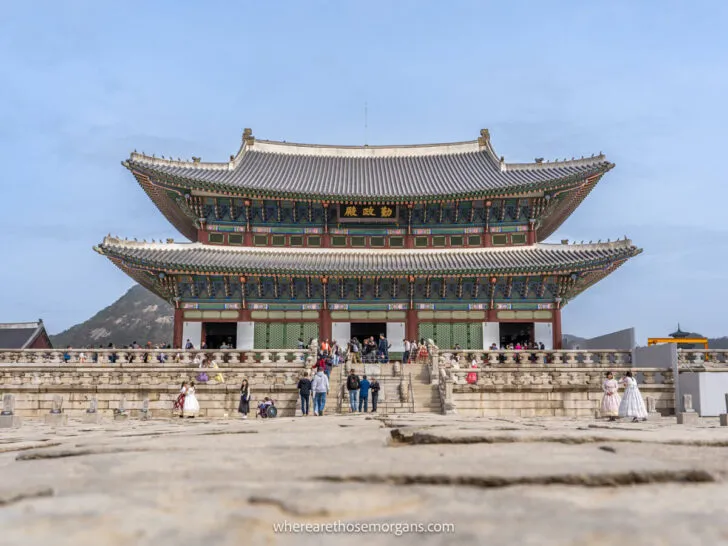
Located in northern Seoul, Gyeongbokgung Palace is one of the best things to do in the city . It was built in 1395 and served as main palace during the Joseon Dynasty so it’s a great place to learn about Korean history and traditions.
In this guide, we’re going to show you exactly what to see inside Gyeongbokgung Palace including highlights you should not miss and how to take the free guided tour.
Our Seoul Experience
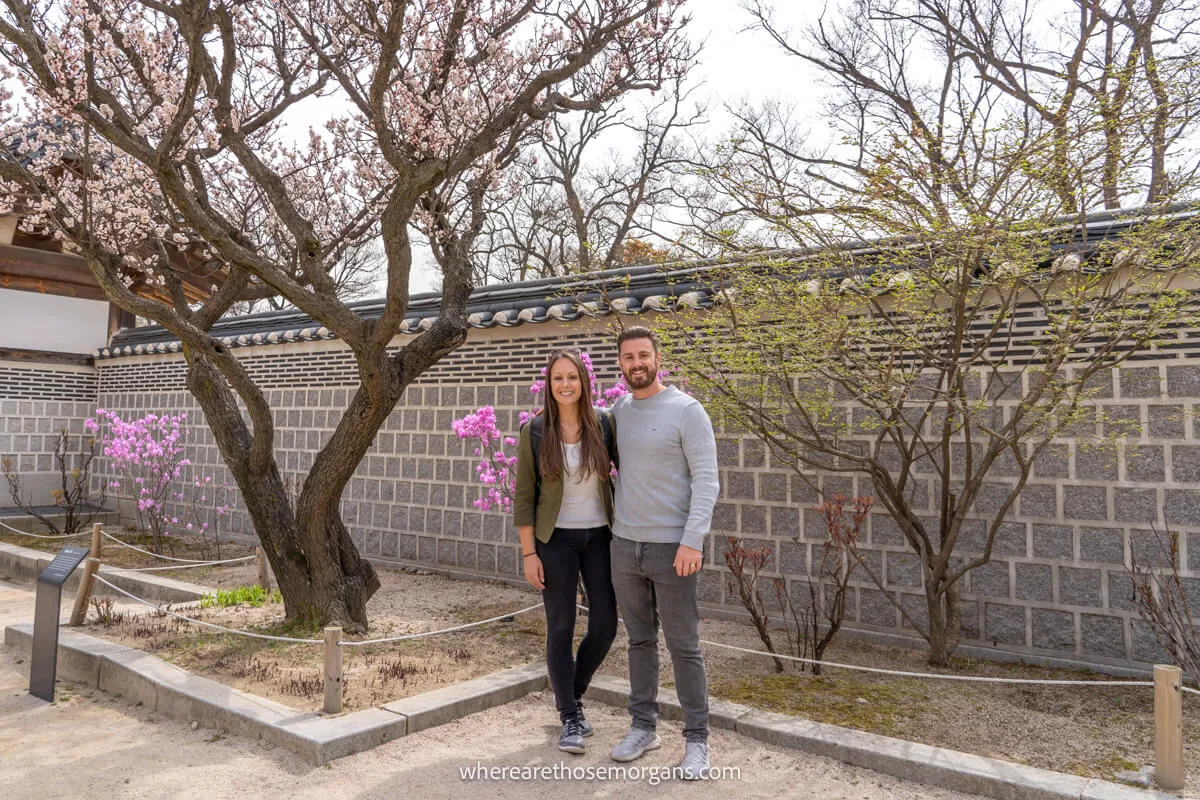
We spent 14 days exploring Seoul in March 2023 . During this trip, we personally visited Gyeongbokgung Palace as well as the 4 other royal palaces in Seoul . This is the most popular and well known palace in the city and it was extremely busy, especially because it was the beginning of cherry blossom season.
Since this is the largest palace complex, we decided to take the free guided tour so we could easily see the highlights. Our guide will show you what to expect and how to plan your day to make the most of your time here. Read more about us .
Gyeongbokgung Palace History
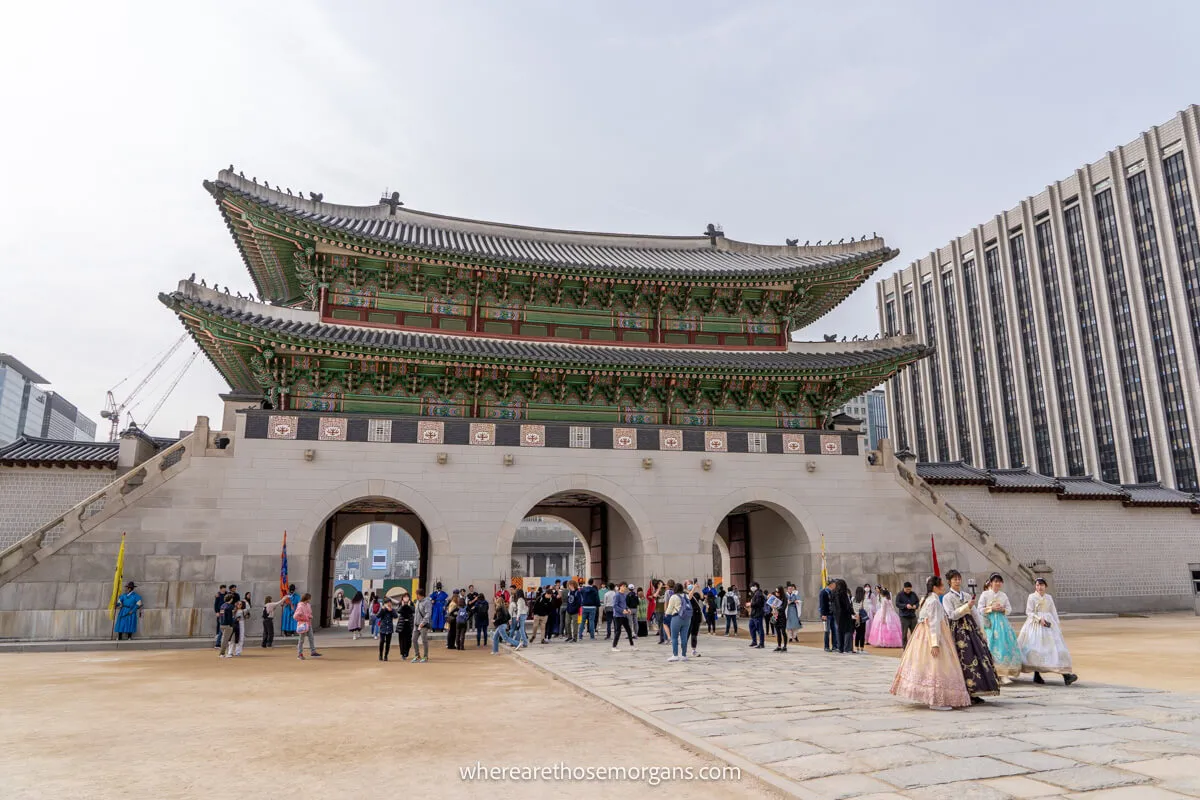
Originally built in 1395, Gyeongbokgung Palace was the primary palace established for the Joseon Dynasty (1932-1910). It was constructed between Baegaksan Mountain to the north and present day Sejong-deoro to the south so it become influential in the dynasty’s economy and politics.
The name “Gyeongbok” translates to brilliance and fortune and it reflected the founders hope for the dynasty to have good fortunes and prosper. Sadly, the palace has been destroyed several times by numerous Japanese invasions with the last occupation occurring from 1910-1945.
However, in 1990 an extensive restoration project demolished the Japanese government building that was constructed over the place grounds and the original buildings have been rebuilt.
Visitor Information
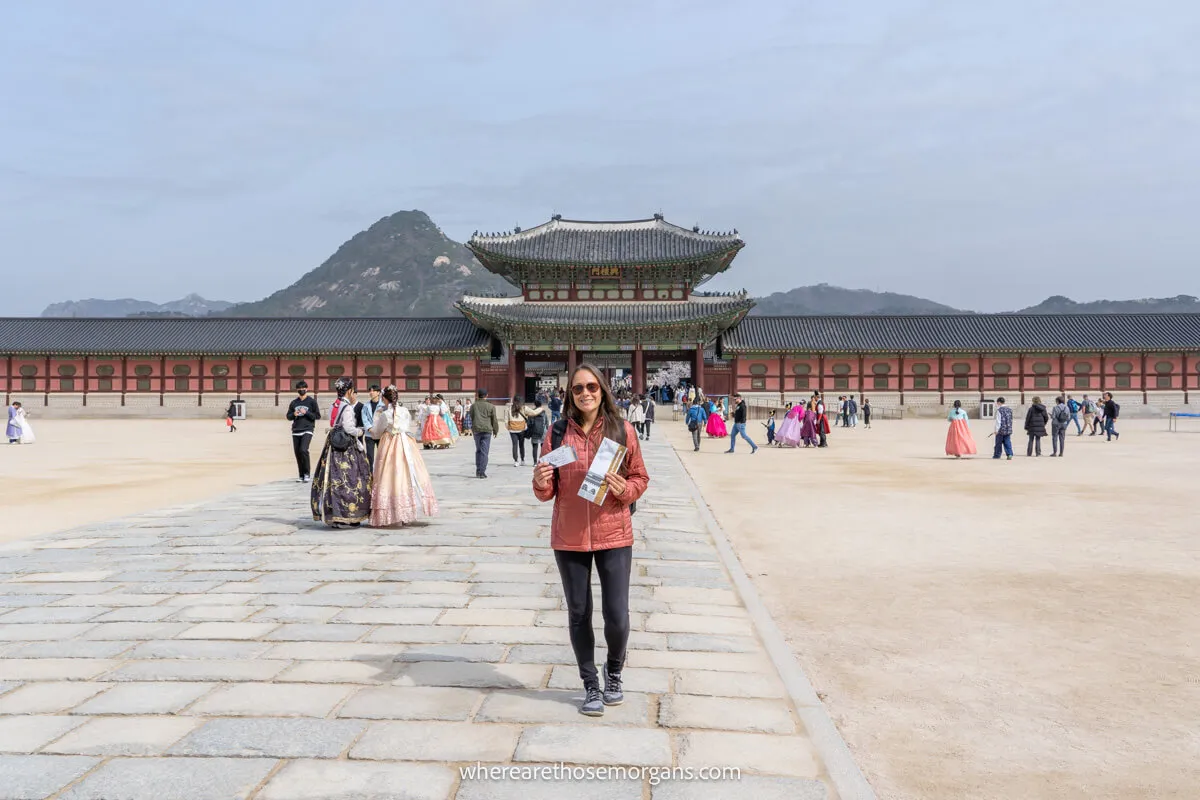
Known as the northern palace, Gyeongbokgung is located in the northern part of the city . It’s open every day of the week from 9:00-17:00 or 18:30 depending on time of year, but it’s closed Tuesday. Last admission is one hour before closing so make sure you give yourself enough time when visiting.
- Address : 161 Sajik-ro, Jongno-gu, Seoul, South Korea
- Location : Google maps
- Best subway stop : Gyeongbokgung Palace Station (line 3, exit 5) or Gwanghwamun Station (line 5, exit 2)
Admission tickets for Gyeongbokgung Palace cost 3,000 KRW for adults (US$ 2.26) and 2,400 KRW (US$ 1.81) with groups of 10 or more. Visitors over the age of 65 and children under the age of 19 will receive free entry into the palace . You can also visit for free on Culture Day, which is the last Wednesday of every month .
We think the easiest way to purchase tickets is on site, but if you plan to visit all 5 of Seoul’s royal palaces, you should consider the royal palace pass . This is what we used to visit Gyeongbokgung Palace.
The royal palace pass costs 10,000 KRW (US $7.53) and it’s valid for three months from the date of purchase . This pass can only be purchased from the sites listed below:
- Gyeongbokgung
- Changdeokgung
- Changgyeonggung
- Jongmyo Shrine
It’s a good opportunity for those who want to visit numerous palaces in the city because it will save you a little bit of money. Additionally, it also saved us some time by not having to wait in a long ticket line.
Hanbok Rentals
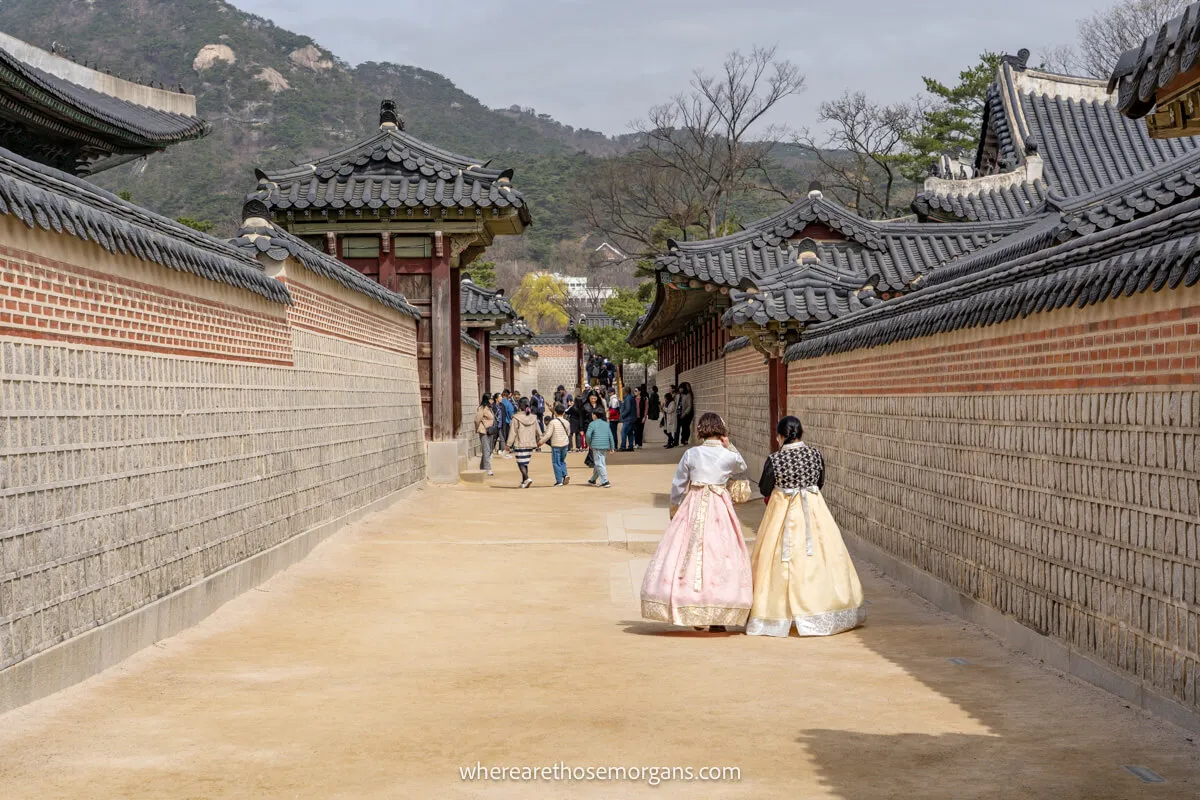
Admission to Gyeongbokgung Palace is free for anyone wearing a hanbok . This is traditional Korean clothing and it’s very common for people to have their hair done for the occasion as well.
When you visit the palace, you can expect to see numerous tourists dressed in hanboks. If you want to rent you own, this hanbok rental is a very popular option. You can also rent a premium hanbok if you’re looking for something truly memorable.
Travel Tip : Hanboks are typically rented by the hour or per day.
Gyeongbokgung Tours
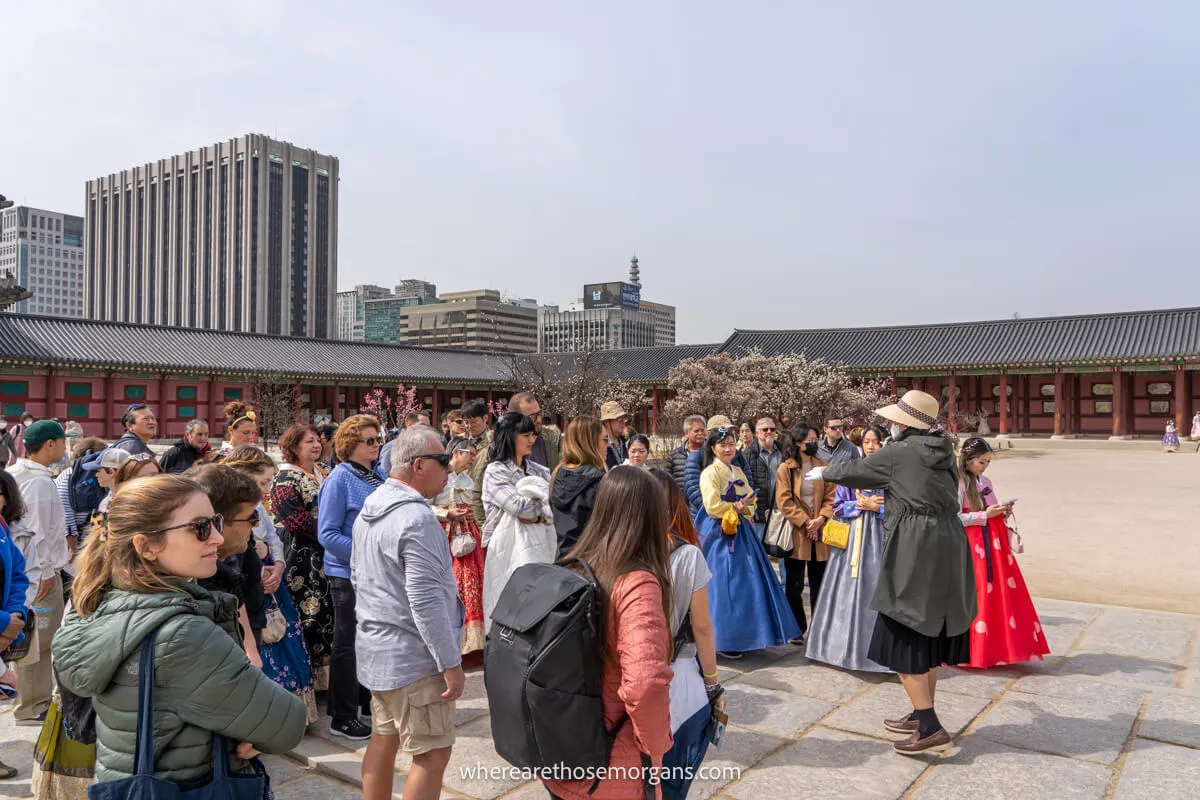
There are many ways you can experience Gyeongbokgung Palace. You can use the free informational brochures provided in numerous languages to walk around the grounds and learn about the various buildings on your own. Or you can rent an audioguide at the main entrance.
When we visited, we took the 11:00am free guided english tour provided on site and it was well worth our time. You can expect a tour to last between 60 and 90 minutes. The tours begin in front of information center inside the Heungnyemun Gate. Here are the guided tour times for the palace:
- Chinese : 10:30, 15:00 (Wed-Mon)
- English : 11:00, 13:30, 15:30 (Mon-Wed)
- Japanese : 10:00, 14:30 (Wed-Mon)
- Spanish : 10:30, 15:00 (Fri + Sat)
If you can’t visit during the free guided tour hours , you can book a tour with a third party company . Many of these tours include admission to the palace as well as some of the best things to do in Seoul .
Here are highly rated tours :
- Gyeongbokgung History Walking Tour – Two hour tour featuring the history of the Joseon Dynasty’s largest palace
- Seoul City Highlights + Palace Tour – Four hour tour with an optional hanbok experience
- Gyeongbokgung Morning Tour – A detailed tour with a local guide to help you lean about the best parts of the palace
- Walking Tour With Expert – Three hour tour featuring Gyeongbokgung Palace and Bukchon Hanok Village
10 Best Things To Do In Gyeongbokgung Palace
It can be very overwhelming when you visit Gyeongbokgung Palace because it’s such a large palace and one of Seoul’s main attractions. However, there are important highlights you shouldn’t miss during your visit. Here’s what to see at Gyeongbokgung Palace:
1. Changing Of The Guard
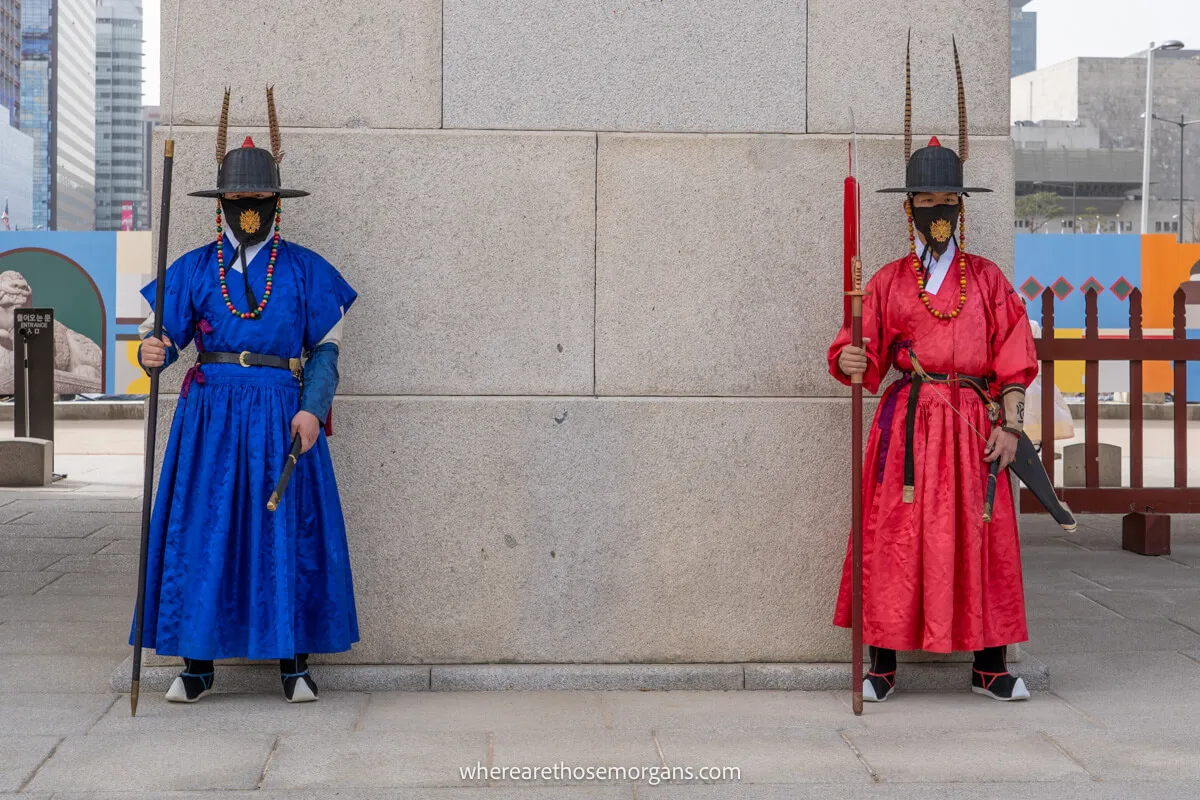
One of the best things to see at Gyeongbokgung Palace is the changing of the guard ceremony . There are two different ceremonies you can see and they take place at various times throughout the day either inside or outside the main gate of the palace.
The first is the guard duty performance which occurs outside of Gwanghwamun Gate and this ceremony takes place at 11:00 or 13:00. The second is the changing of the palace guard which happens inside Gwanghwamun Gate at 10:00 or 14:00.
If you’ve seen changing of the guard at Buckingham Palace in London, it’s very similar. We recommend you try to make it for at least one ceremony because they are performed extremely well and showcase an important part of Korean history.
Travel Tip : If you miss the changing of the guard ceremony at Gyeongbokgung, you can also see it at Deoksugung Palace in front of Daehanmun Gate at 11:00, 14:00 or 15:30.
2. Geunjeongjeon Hall
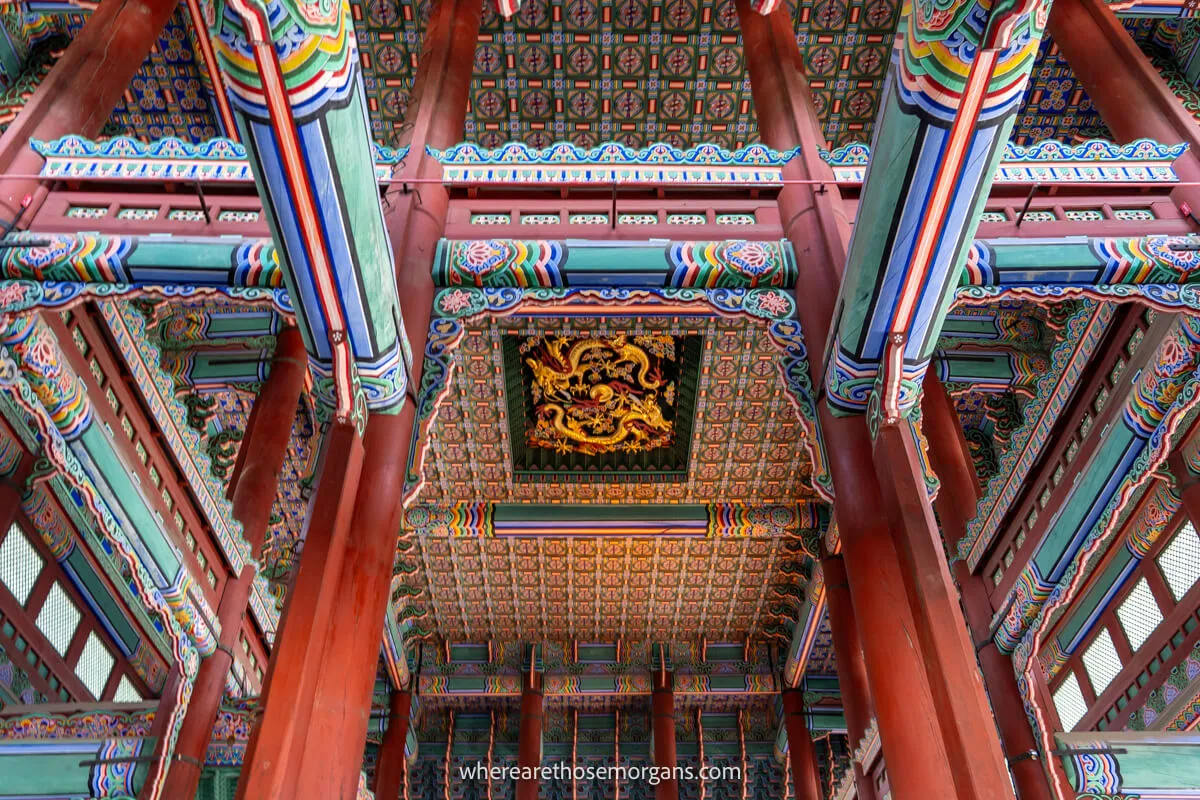
Built for the sovereignty of the Joseon rulers, Geunjeongjeon Hall was the throne hall of the palace . It held official events such as coronation ceremonies, cabinet meetings and receptions of foreign envoys. This hall is the largest and most formal hall in the entire complex so you shouldn’t miss it.
Throughout the years, seven of the twelve Joseon kings were enthroned at Geunjeongjeon Hall. This is also where high ranking officials were assembled to pay respect to the king. The original Geunjeongjeon Hall was built in 1394, but it was burnt down by the Japanese in 1592 and the building you can see today was rebuilt in 1867 .
Travel Tip : This is one of the most crowded locations in the palace so if it’s busy continue with other buildings in the complex and return when the crowds subside.
3. Sujeongjeon Hall
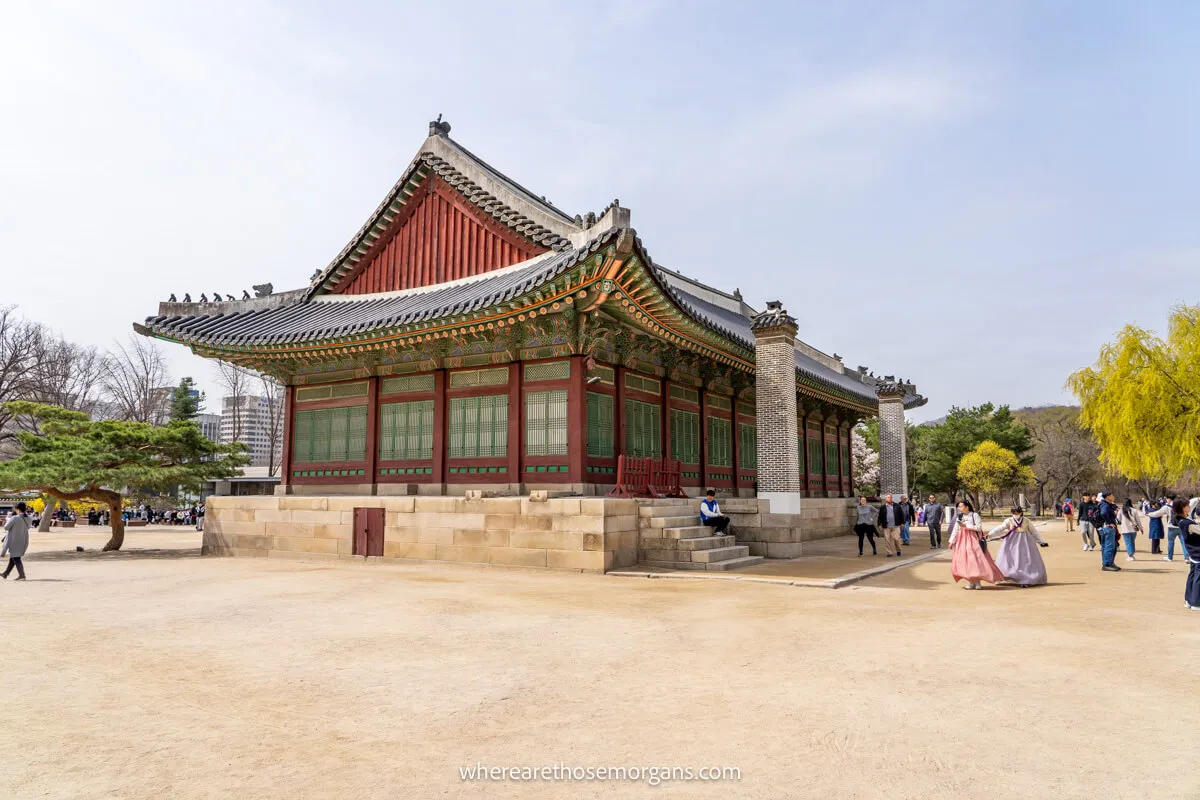
The Sujeongjeon Hall is the only surviving building of all the government offices . It principally served as a council hall where the king discussed national affairs with his court officials through morning briefings and royal functions.
During our tour, we learned this area once contained a building known as Jiphyeonjeon . This is where the Korean alphabet and writing system was invented during the reign of King Sejong (1418-1450). But the current hall we see today was built in 1867.
4. Gyeongheoru Pavilion
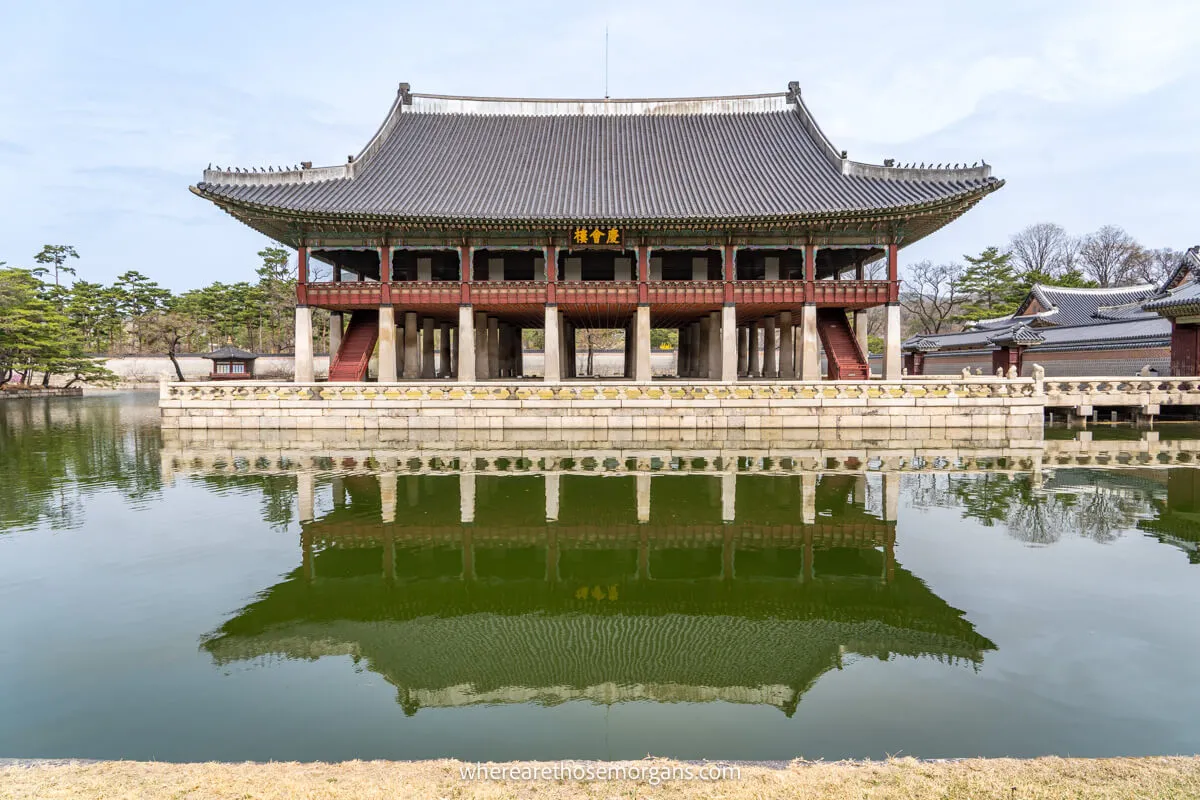
Located on an artifical lake, Gyeongheoru Pavilion can be found in the western part of the palace . The pavilion was used for royal banquets, large receptions, final state examinations and religious rituals. “Gyeonghoe” translates to a joyous banquet and the “-ru” suffix means pavilion .
Originally built as a small pavilion for the king to enjoy the views of Inwangsan Mountain, both the pond and pavilion were enlarged in 1412. But much like many of the other palace buildings, it was destroyed by fire in 1592 from the Japanese invasion and rebuilt in 1867.
Today, Gyeongheoru Pavilion is still in use for special functions and the second floor showcases a banquet hall. There are 48 high stone supports with 24 round and 24 square pillars.
Travel Tip : Gyeongheoru Pavilion is the largest elevated pavilion in Korea.
5. Sajeongjeon Hall
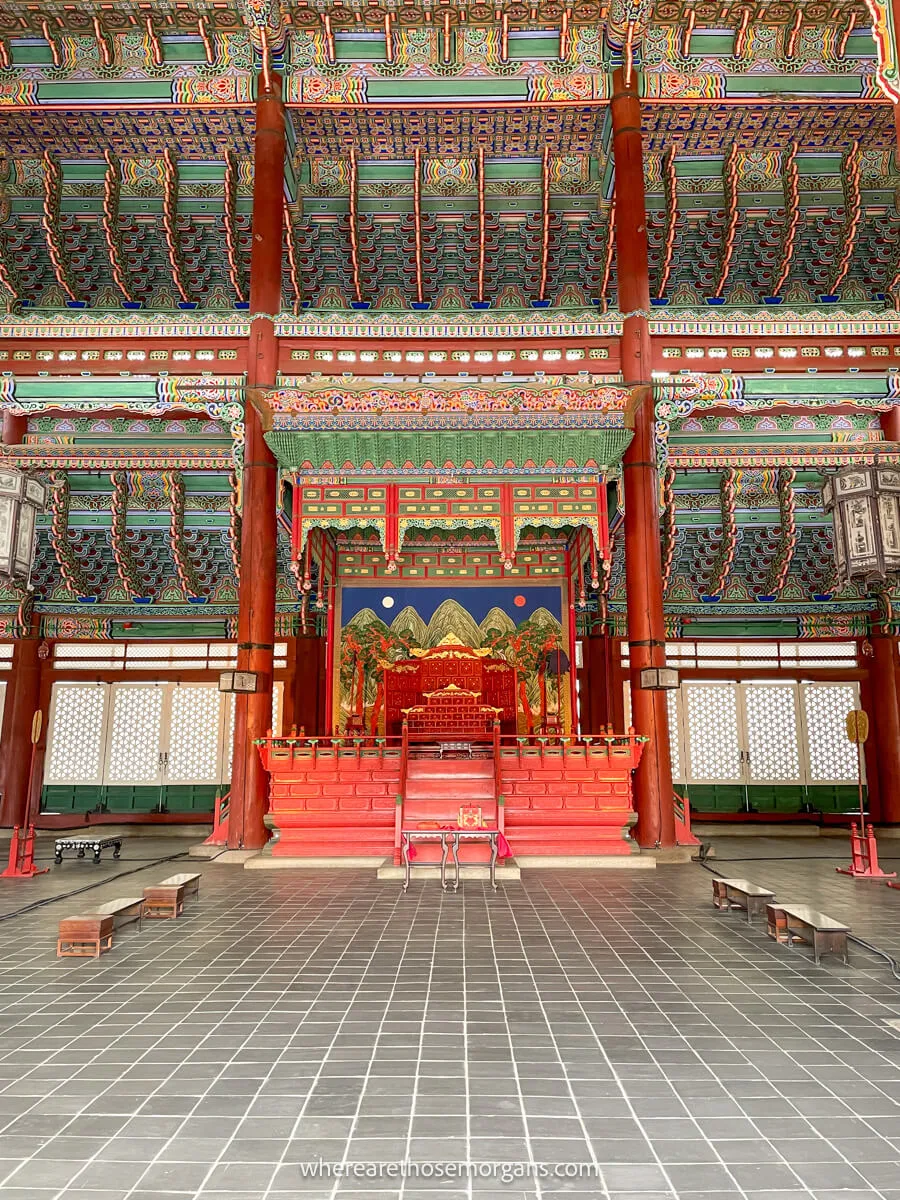
Another interesting building inside Gyeongbokgung Palace is Sajeongjeon Hall. This building served as council hall where the king could meet with high ranking officials, hold daily morning assemblies or attended lectures on state affairs. Rebuilt in 1867 , you’ll also find a throne in this hall similar to Geunjeongjeon.
Travel Tip : The two auxiliary halls located on the right and left of Sajeongjeon Hall contain flues in the floors which were used for heating. It’s assumed these buildings were historically used in all four seasons.
6. Gangnyeongjeon Hall
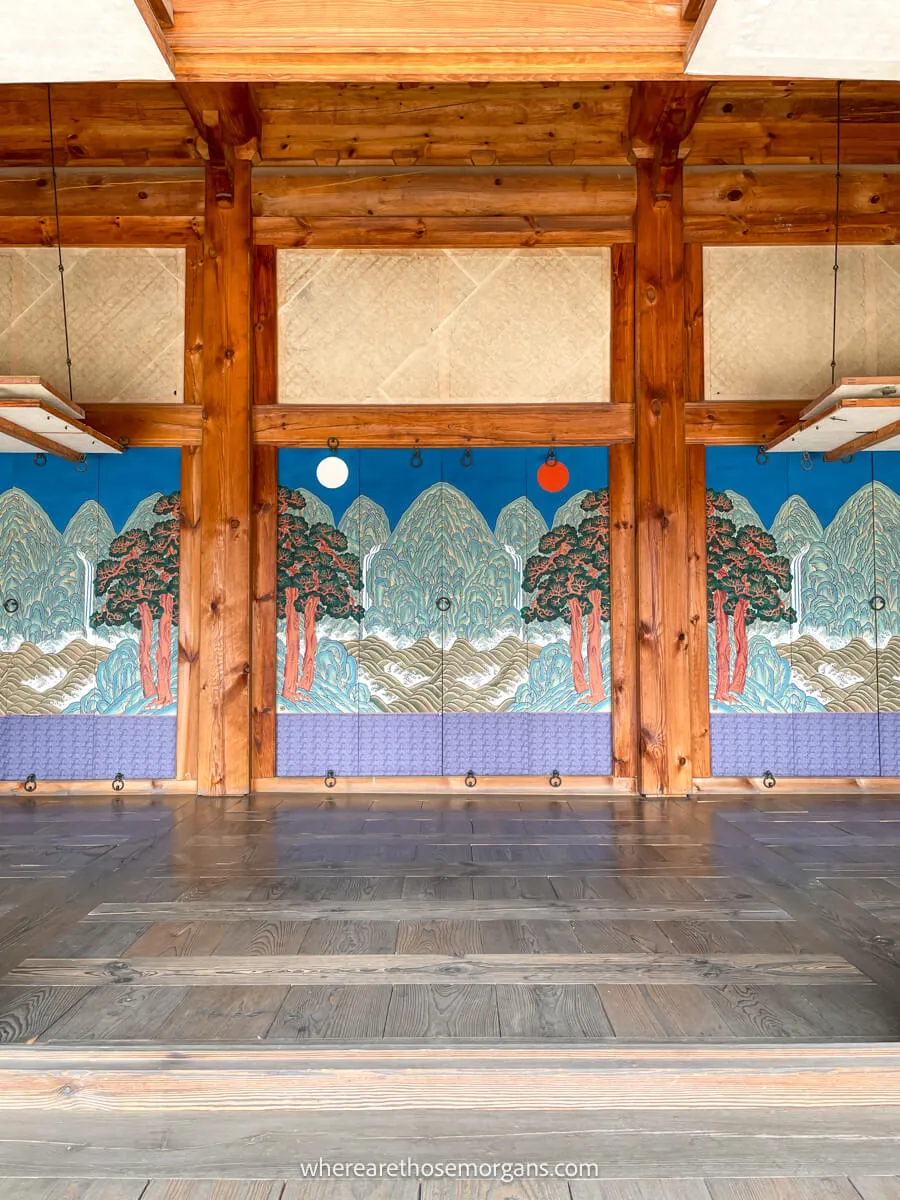
Located in a secluded part of the palace, Gangnyeongjeon Hall served as the main living quarters for the king and queen . There was a private area where the king slept, but it was also used for unofficial meetings, reading and refreshments when the king needed to secretly discuss issues.
The original Gangnyeongjeon Hall was burnt down in the Japanese invasion in 1592 and it was restored in 1865. But the new building was dismantled in 1917 and taken to Changdeokgung Palace after a fire. The Gangnyeongjeon Hall we see today was restored in 1995 .
7. Gyotaejeon Hall
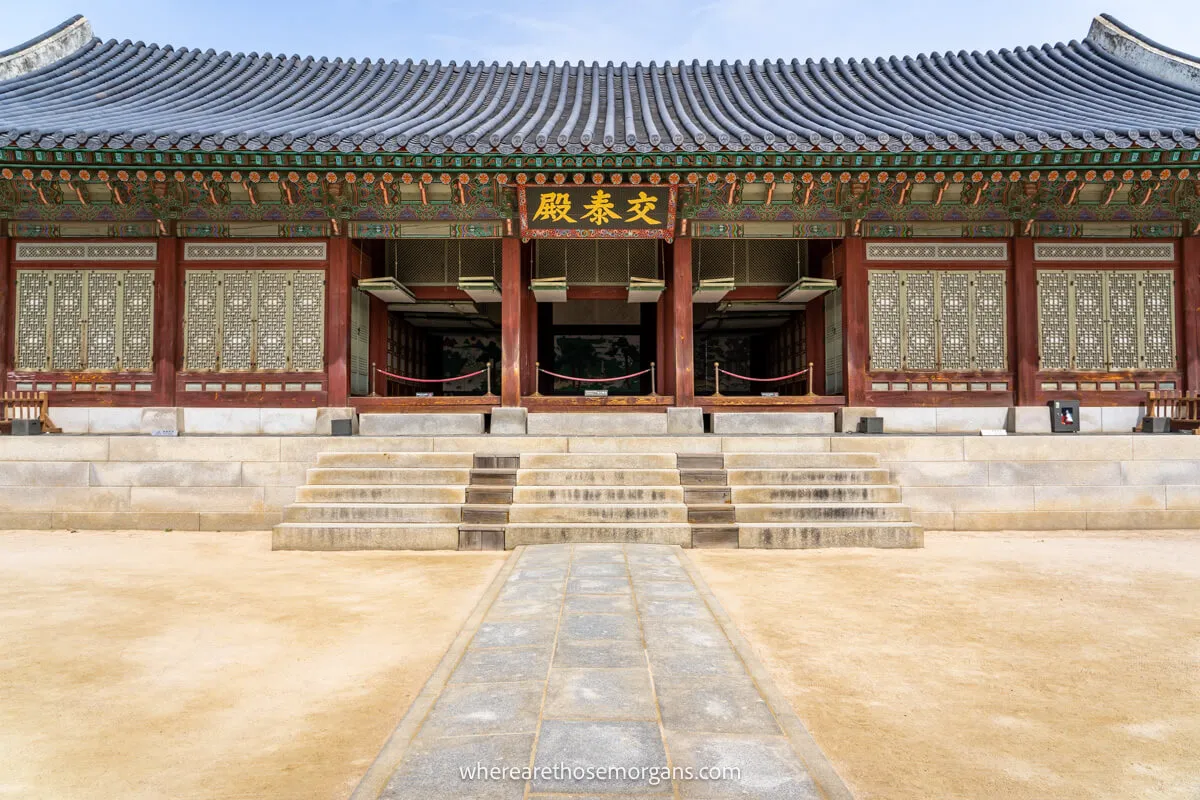
Along with Gangnyeongjeon Hall, Gyotaejeon Hall was the official residence of Joseon queen consorts . Their main duties included managing and supervising the royal household affairs with all members of the female royal court. It’s believed this hall was built around 1440 during King Sejong’s reign.
8. Amisan Mound
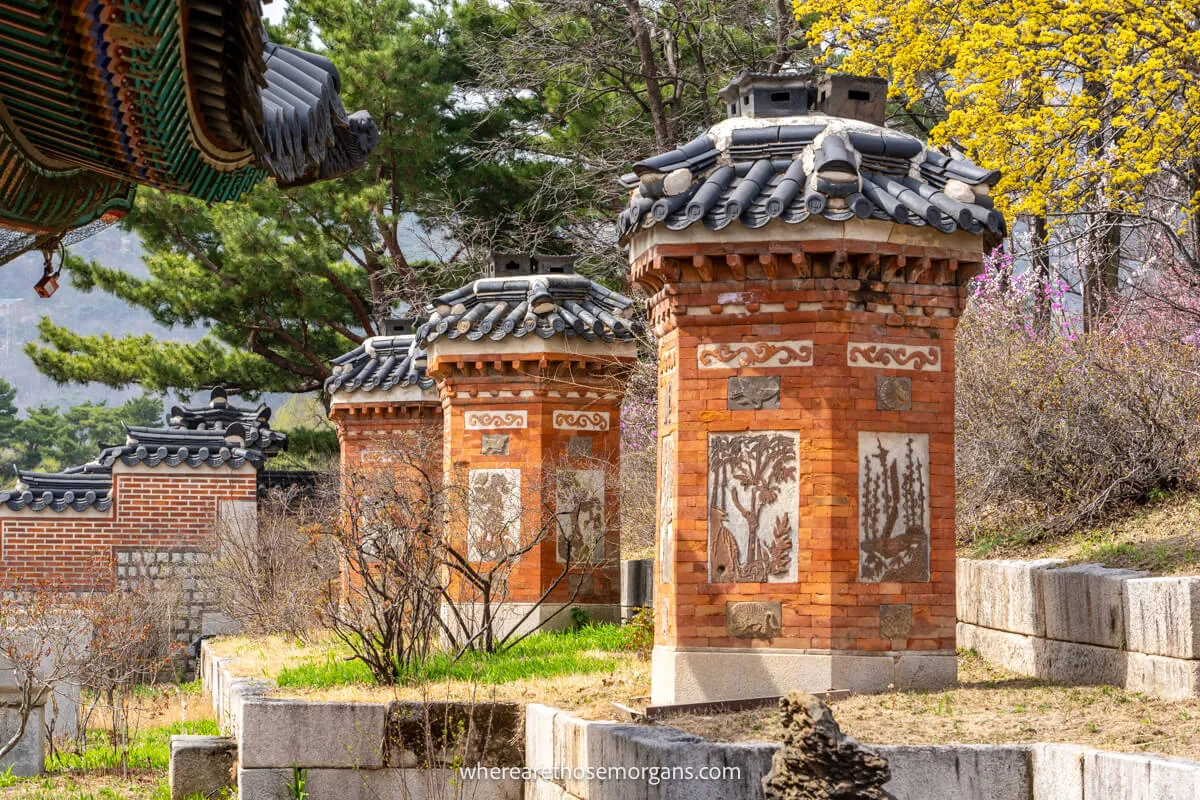
Just behind the Gyotaejeon Hall, visitors will find the beautiful Amisan Garden . The highlights of this garden are the four brick chimneys and the surrounding fine terraced flower beds . The four chimneys are hexagonal shaped and decorated with plants as well as the ten symbols of longevity to ward off evil spirits.
Travel Tip : We think Amisan Garden is a hidden gem inside Gyeongbokgung Palace so be sure you don’t miss it.
9. Hyangwonjeong Pavilion
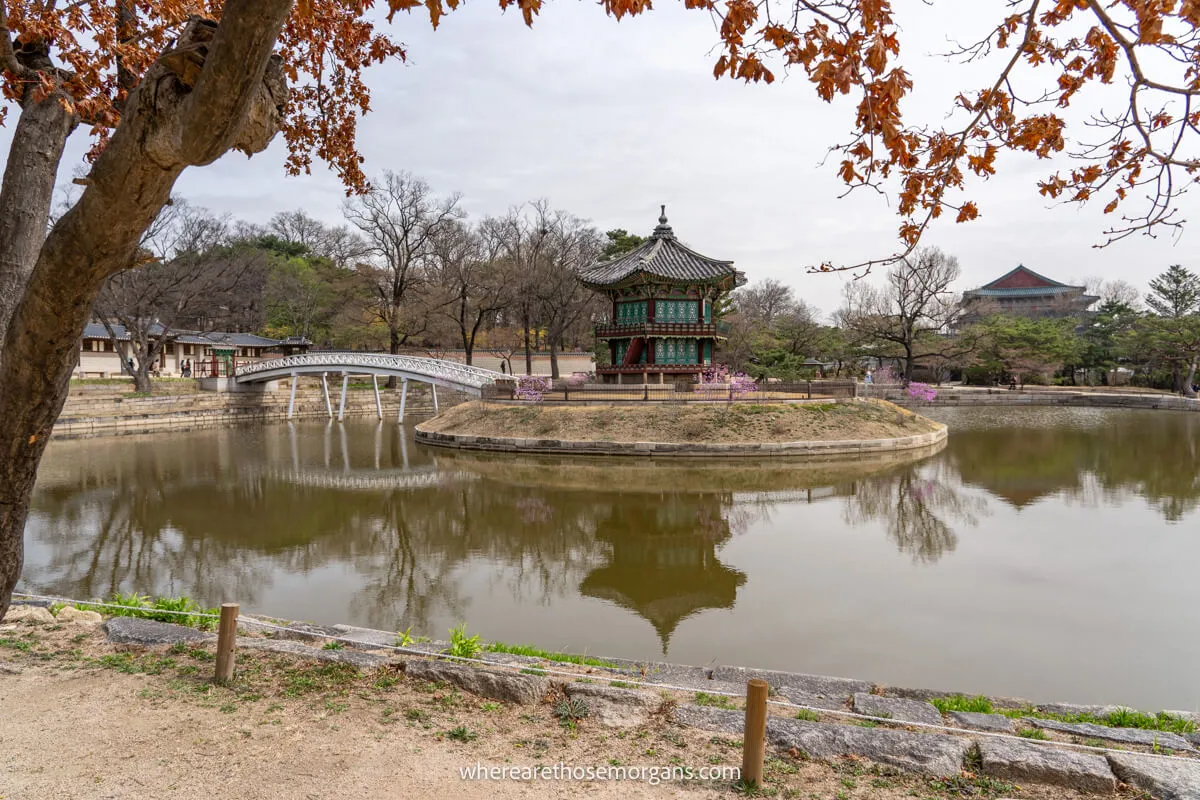
Created in 1456, the Hyangwonji Pond is found in the northern garden of Gyeongbokgung Palace. Hyangwonjeong Pavilion is a stunning structure that sits on top of an artificial island in the center of the pond.
We learned the beautiful wooden bridge leading to the pavilion is called the Chwihyanggyo Bridge and it literally translates to “getting intoxicated by the scent.” Unfortunately, visitors are not allowed to cross the bridge , but you’ll find carp and lotus flowers surrounding the pavilion.
Travel Tip : One of the most popular times to visit the Hyangwonjeong Pavilion is in spring or fall when vibrant foliage is reflected in the water of Hyangwonji Pond.
10. National Folk Museum Of Korea
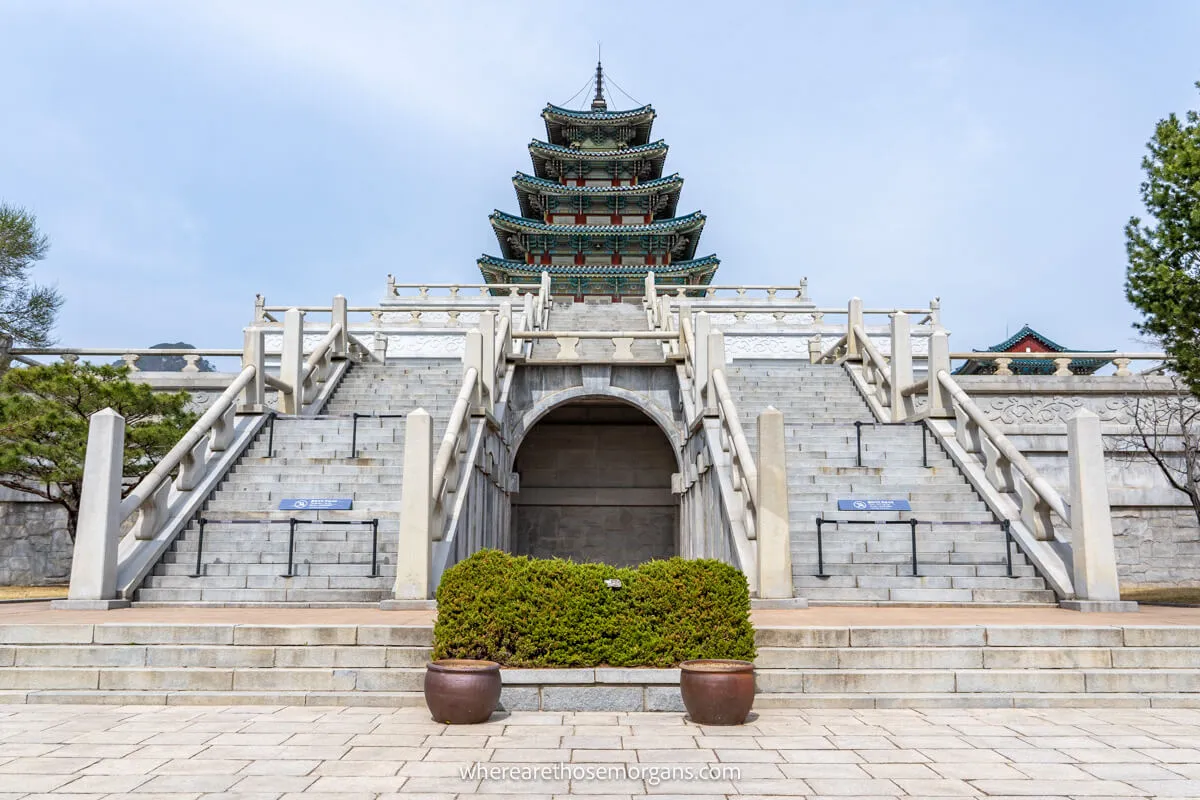
Technically not inside the palace, but located just outside on the eastern border is the National Folk Museum of Korea . It’s a popular museum that showcases the lifestyles, traditions and history of Korean culture.
The entire complex features three permanent exhibits along with two special exhibits , an open air exhibition and a children’s museum. Admission to the National Folk Museum of Korea is free with a Gyeongbokgung Palace ticket . You can join a free guided tour at 10:30 and 14:30 in front of Exhibition Hall 1.
The Morgan Conclusion
Visiting Gyeongbokgung Palace is one of the best things you can do in Seoul because it was the main palace of the Joseon Dynasty. While much of the palace was destroyed by Japanese invasions, extensive restorations have rebuilt many of the original buildings. Visitors can also take advantage of the free guided tours offered in numerous languages.
So is Gyeongbokgung Palace worth visiting ?
Yes, the Gyeongbokgung Palace is worth visiting because it’s the largest palace in Seoul. You’ll be able to see where the kings and queens once lived including where they performed daily activities. Additionally, visitors can see the changing of the guard ceremony which is unique.
We think Gyeongbokgung is the most impressive palace in Seoul because it showcases hundreds of years of Korean history. The stunning architecture, expansive grounds and reenactments of royal rituals make it the most popular tourist attraction in city.
However, this is a very large complex and it will be very busy. You can also expect to walk a lot if you want to see the highlights we included in this guide. We spent about 3.5 hours inside Gyeongbokgung including our guided tour and watching the changing of the guard ceremony.
But you can shorten this time frame by visiting on your own. Of if you want to get away from the crowds, we suggest you visit Changgyeonggung or Deoksugung .
Our Gyeongbokgung Palace Photos
We enjoyed our visit to the palace and took many photos. Here are a few of our favorites so you know exactly what to expect:
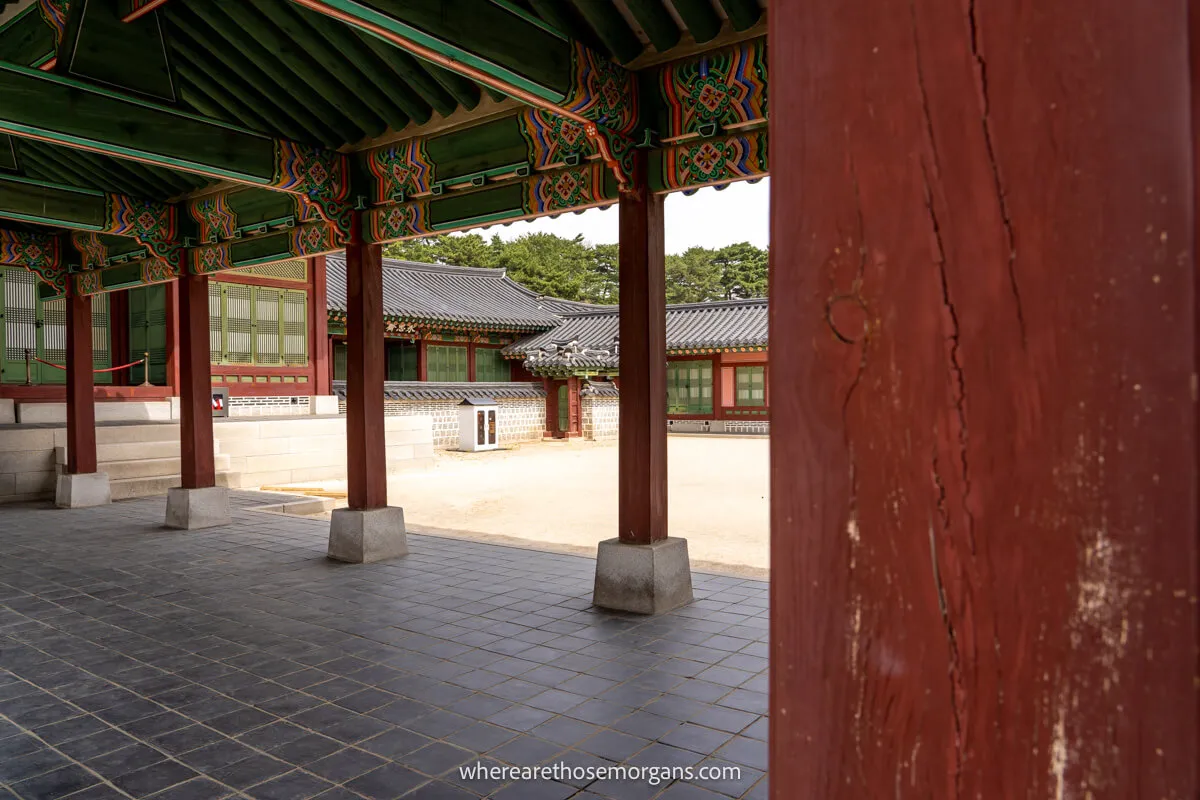
More Seoul Palaces
- How to visit Changdeokgung Palace
- What to see inside Huwon Secret Garden
- Guide to visiting Changgyeonggung Palace
- First time visitor guide to Deoksugung Palace
- Best things to see inside Gyeonghuigung
- The best palaces to visit in Seoul
Our Popular Seoul Guides
- 35 amazing things to do in Seoul
- How to find the best DMZ Tour
- Unique things to do at Imjingak Park
- How to visit the Namsan Seoul Tower
- Complete guide to Seoul Sky observatory
- How to visit the Jongmyo Shrine
- What to see at the Seodaemun Prison
- 20 best hotels in Seoul
Want more Seoul content? Head over to our South Korea Travel Guides to explore the very best of Seoul and beyond.
We hope this guide featuring best things to do at Gyeongbokgung Palace helps with planning your visit to Seoul!
Please let us know if you have any questions about visiting this palace or Seoul in the comments below.
Happy Travels ,
Mark and Kristen
Enjoy this Gyeongbokgung Palace guide? Pin it for your visit!
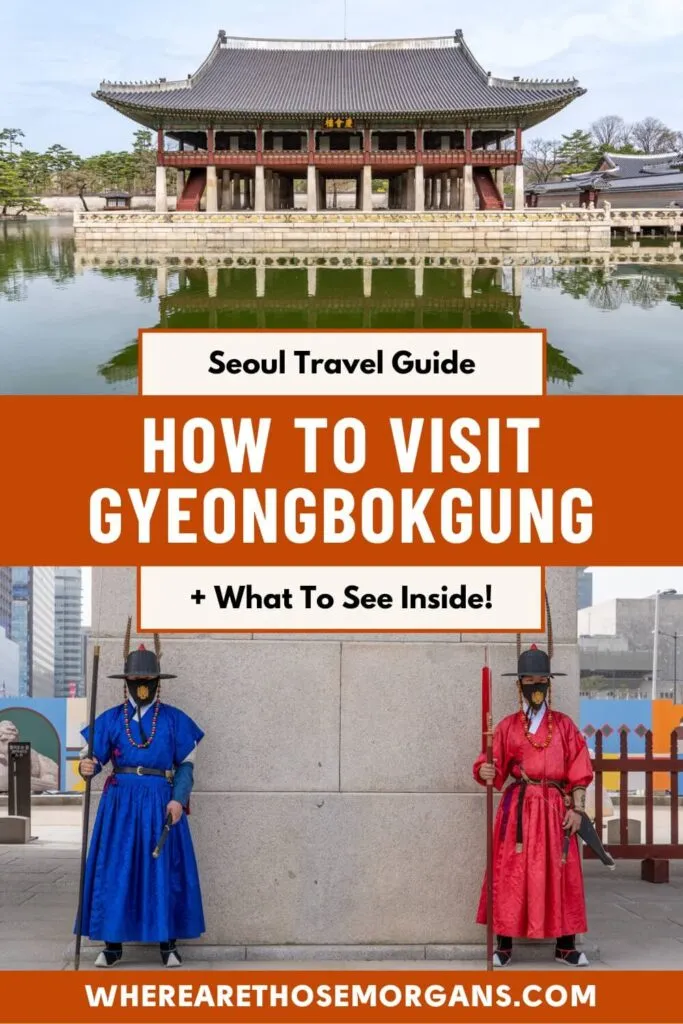
Note : This article contains affiliate links. When you make a purchase using one of these affiliate links, we may earn a small commission at no extra cost to you.
All Rights Reserved © Where Are Those Morgans, LLC. Republishing this article and/or any of its contents (text, photography, maps, graphics, etc.) in whole or in part is strictly prohibited.
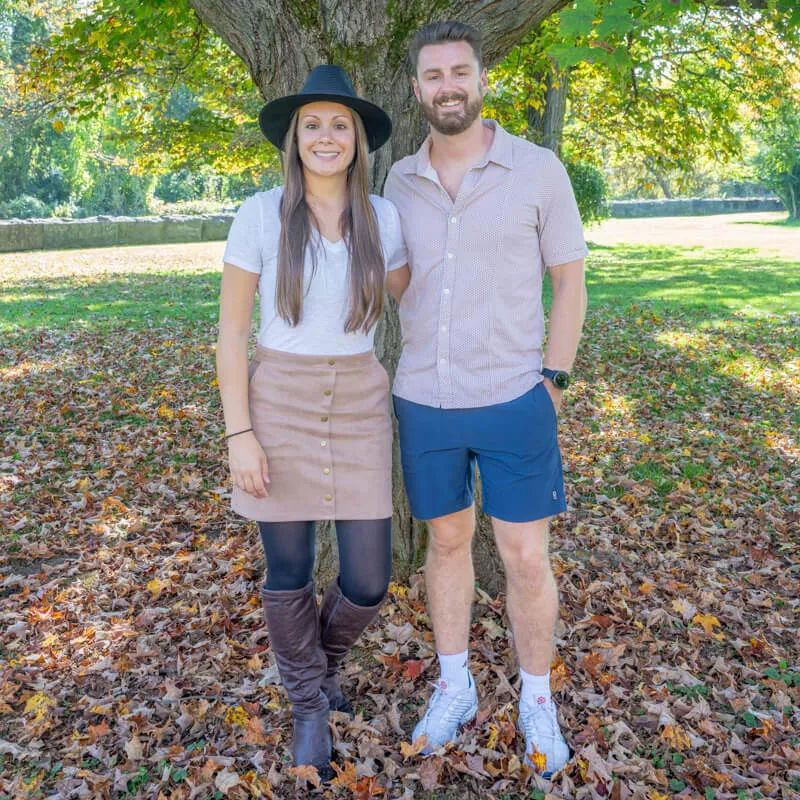
Mark and Kristen Morgan are travel, hiking and photography experts. Over the last 6 years traveling full time, they have explored more than 40 countries and 30 US states.
Where Are Those Morgans has been featured in USA Today, Gestalten, Get Your Guide, CityPASS and Condé Nast Traveler along with various other publications. Read more about us .
Share this article!
SEOUL - north | SEOUL - south
Day Trips from Seoul | Busan | Best Collections
🌸Festivals ( Seoul • Busan )
30 Must Visit Places & Activities To Do in Seoul, Korea
KoreaToDo handpicked collection of must visit places and activities to do in Seoul across a wide range of cultural, most popular, hidden secrets and local favourite hunts.
The Seoul Must-visits and Must-do Collection offer quick picks for the first timers to Seoul , busy travellers with little planning time, travellers with short holiday in Korea and perhaps fresh ideas for the seasoned travellers.
Which are your favourites and how many have you visited? ENJOY!
1. Korea Palaces
Visit either:
Gyeongbokgung Palace : The largest + Changing of Royal Guards Ceremony
Changdeokgung Palace : UNESCO World Heritage + Secret Garden
Deoksugung Palace : Most conveniently located next to City Hall Station + Changing of Royal Guards Ceremony

2. Namsan Seoul Tower
With the four distinct seasons, multiple ways to reach its peak and day/night scenery, N Seoul Tower is definitely a place to visit more than once.

3. Myeongdong
The shopping, cafes, restaurants and street food mecca! You can't claim been to Seoul without visiting Myeongdong, the hot favourite for many visitors to Seoul! You can also catch Korea's longest running and award winning show, NANTA in Myeongdong too!

4. Cafe Streets
Check out one of the rooftop cafes at the chic suburb of Sam cheongdong . Enjoy your favourite drink and watch the sun sets over the beautifu l horizon.
Other popular cafe streets/areas:
Ikseondong Hanok Village
Seoul Forest Cafe Street

5. Korean BBQ
With so many Korean BBQ Restaurants in Seoul, why not BBQ differently this time, over a king-size pot lit at Hansang Gadeuk BBQ Restaurant ?
Other recommended BBQ restaurants at:

6. Korean Markets
KoreaToDo favourite picks include:
Tongin Market : Fill up your lunch box with purch ases using brass coins
Gwangjang Market : Many popular local food to try!
Yeongcheon Market : A must-visit for the doughnuts lovers, freshly made!

7. Seoul City Wall
The 18.6km long wall of cultural significance, surrounding the center of Seoul across 4 main mountains.
KoreaToDo Top Picks:
Naksan Mountain Trail : The easiest and gradual walking trail with picturesque view of the city, just 2 subway stops away from Dongdaemun Station.
Inwangsan Mountain Trail : Feel the achievement of reaching a Seoul's mountain summit (338.2m) along the Seoul City Wall.

8. Bukhansan National Park
Enjoy nature beauty with clear flowing rivers, tall trees and fresh air at this most visited National Park in Korea, so close to the Seoul City Center.
You can choose an easy walk/hike and turn back anytime (after your picnic?) or challenge yourself to one of its peaks. There are signs in English and you will see Koreans hikers on weekdays too.

9. Han River (Hangang) Parks
Han River is a major river running through Seoul. 12 parks are created along Han River in Seoul, offering relaxation and sporting hub for the citizens.
KoreaToDo Hot Picks : Parks with direct subway station access, unique attractions & activities to do (i.e. bicycle rental, duck boat rental, ferry cruises, etc):
Ttukseom Hangang Park
Yeouido Hangang Park

10. Bridge Walk across Han River
With so many bridges connecting North and South of Seoul across Han River, bridge walk offers one of the best and unique experiences on your holiday in Seoul.
KoreaToDo's favourite pick:
Jamsil Railway Bridge Walk : end-to-end subway station connections.

11. Underground Malls
There are many underground malls in Seoul. Of which, the Express Bus Terminal Underground Mall (GOTO MALL) stands out among the rest as the largest underground mall in Seoul with over 600 shops. You can find the latest fashion wear, paintings, household items, beddings, accessories and even plants & pots at GOTO MALL .

12. Ko rean Universities
Ewha Womans University is the largest university for women in Korea. I t has the largest underground campus (ECC), designed by world renowned architect. The beautiful campus is within walking distance to subway station. There are great shopping and restaurants outside its campus too!
In autumn, Yonsei University nearby is a must-visit for its autumn foliage!

With day tours to go and so many places to visit in Seoul, including palaces, shops, cafes and restaurants, parks are often given a miss by travellers unfortunately...
Nonetheless, please do take some time to relax in nature and enjoy the beautiful seasonal flowers and plants Seoul Parks has to offer.
Hot picks include:
Seoul Grand Park
Seoul Forest
Olympic Park
Haneul Park

14. Kakao Friends / Line Friends Flagship Stores
You can find your favourite and cutest Kakao Friends and Line Friends merchandise from toys, stationeries, clothing and lifestyle items... only in South Korea!
Best locations for both flagship stores located near subway stations:
Gangnam Shopping Street
Hongdae Shopping Street

15. Factory Outlets
Deal hunters for the popular brands like The North Face, Columbia, Fila , Adidas, New Balance, etc, check out the factory outlets in Seoul.
Recommended picks near subway stations:
Lotte Outlets (Seoul Station Branch)
Hyundai City Outlets Dongdaemun

16. Olive Young
We can't leave out the cult favourite for beauty lovers, Olive Young!
Visit the largest Olive Young store in South Korea, Olive Young Myeongdong Flagship Store and stock up your beauty care products (e.g. masks, sun cream).
💡If you are new to Korean skincare, you can check out the bestsellers on their global site.

KoreaToDo TOP PICKS - Tours, Activities & Discount Tickets
➥ Handpicked experiences by KoreaToDo for their uniqueness, value, popularity, price competitiveness and at times, tedious to reach by public transport.

N Seoul Tower Observatory Ticket
enjoy breathtaking views

Yeo Yong Guk Korean Traditional Medicine Spa Packages
must-go wellness place by KTO

Lotte World 1 Day Pass & Lotte World Aquarium
located in the heart of Seoul

Coex Aquarium in Seoul Admission Ticket
largest aquarium in Seoul

Seoul Eland Hangang River Cruise (Day Cruise)
40 mins, multiple timings

Discover Seoul Pass (Lotte World, COEX Aquarium, Han River Cruises, etc)
free access to >60 attractions

Hanbok Rental near Changdeokgung Palace by Dorothy Hanbok
Kid/Male hanbok available.

Private Transfer: Incheon Airport (ICN) to Seoul (1-3 or more pax/car)
Myeongdong, Hongdae, etc
♔ KoreaToDo recommends Klook.com , Asia leading in-destination service provider.

🌸SPRING PICKS🌸 Handpicked Experiences from Seoul

Chasing Cherry Blossom & Spring Flowers Day Tour
29 Mar - 14 Apr 2024
3 best spots of the day in Seoul/Gyeonggi

Taean Tulip Festival & Strawberry Picking Day Tour
12 Apr - 7 May 2024
500g strawberry picking

Jeonju Hanok Village, Wansan Park & Gakwonsa Temple Day Tour
8-23 Apr 2024
King Cherry Blossom Festival

Pink King Cherry Blossom Tour (Spring Flower Festival, Gaesimsa & Munsusa)
14-29 Apr 2024
king cherry blossoms are larger & denser

Hwadam Botanic Garden, Nami Island & Gangchon Railbike Day Tour
29 Mar 2024 ~

Pink King Cherry Blossom Tour (Wansan Flower Garden, Jeonju Hanok Village)
15-28 Apr 2023
& Gakwonsa Temple
Other KoreaToDo Collections that you may like:
Top Popular & Unique Day Trips from Seoul under 3 hours
Recommended Day Tours from Seoul & WHY
Top Favourite Shopping Heaven in Seoul
Essential Travel Tips to Korea
Still looking? Explore KoreaToDo handpicked collection of:
Seoul - North of Han River
Seoul - South of Han River
- Environment
- Road to Net Zero
- Art & Design
- Film & TV
- Music & On-stage
- Pop Culture
- Fashion & Beauty
- Home & Garden
- Things to do
- Combat Sports
- Horse Racing
- Beyond the Headlines
- Trending Middle East
- Business Extra
- Culture Bites
- Year of Elections
- Pocketful of Dirhams
- Books of My Life
- Iraq: 20 Years On
Seoul's great palace is opening to night tourists for first time since Covid-19 pandemic
Moonlight foreign language tours at changdeokgung, one of the south korean capital's most-visited landmarks, are back.
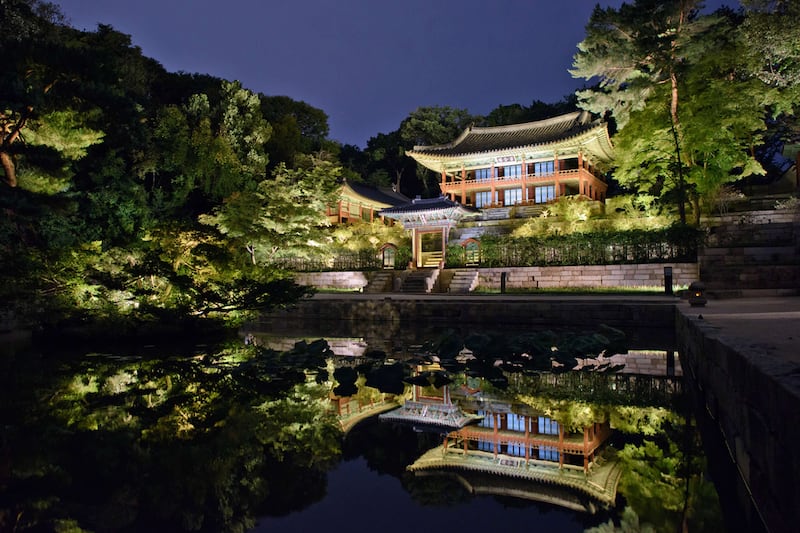
The Changdeokgung Palace during a moonlight tour in Seoul. AFP
One of Seoul's most-visited landmarks is reopening for night visits for the first time since the global pandemic.
Tourists will soon have a rare chance to explore Seoul’s magnificent Changdeokgung Palace beneath the stars during night-time guided tours featuring traditional Korean performances.
On Sunday and June 4, the 58-hectare Royal complex in the South Korean capital will host the first English-language moonlight tours of the landmark since before the Covid-19 pandemic.
Typically, the Unesco World Cultural Heritage site is only open to visitors during the day.
During these visits, Changdeokgung will be illuminated by both artificial light and the warm glow of traditional Korean lanterns. Tour participants will learn the history of the structure, which dates to the 1400s.
The 100-minute night tours cost Dh83 per person, and runs at staggered intervals from 7.20pm on both dates. Each session admits up to 75 travellers.
Korean capital's after-dark delight
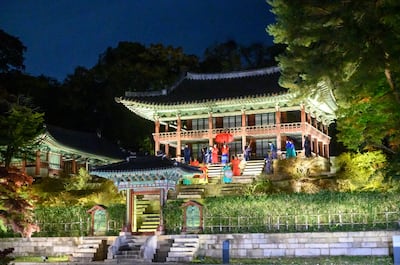
In the daylight, the palace is wonderfully photogenic, thanks to the dazzlingly-bright colours of Dancheong. This is the name of a Korean design system which, for about 2,000 years, has been used to embellish the country’s most important structures.
Dancheong decorates the palace in a dense array of floral and geometric patterns, all painted in a specific palette of red, green, blue, yellow, black and white. As a result, Changdeokgung’s buildings look commanding and regal at a distance, and mesmerising up close. And they will be even more striking in the moonlight.
Organised by the Korea Cultural Heritage Foundation, tours begin at the palace’s chief entrance, the hulking Donwhamun Gate and go through the complex to the lush grove that is the Secret Garden Forest Trail.
Guides leading the tours will explain how Changdeokgung was razed during the Japanese invasions of the late 1500s. Its dozens of halls, offices, pavilions and bridges were later carefully reconstructed.
Along the way, tourists will meet staff dressed as the King and Queen of the Joseon Dynasty. They’ll also stop three times to watch brief performances of the Daegeum bamboo flute, Ajaeng string instrument, traditional Korean Court dances, and Gagok singing.
Seoul's must-visit ancient palaces
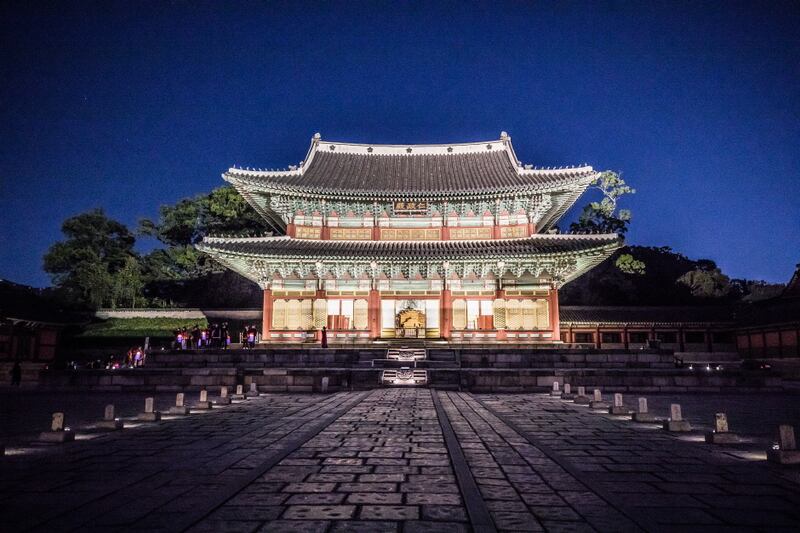
Changdeokgung Palace will light up after-dark for the first foreign moonlight tours since the global pandemic. Photo: Visit Korea
Seoul attracts many tourists with its futuristic appeal, as an enormous city spiked by high rises, modern museums , towering five-star hotels, and massive shopping centres. But embedded within this cutting-edge cityscape is a wealth of historic sites, including five Imperial palaces, all in the downtown area.
They are Changdeokgung, Gyeonghuigung , Changgyeonggung, Deoksugung, and Gyeongbokgung. The latter is the largest, and also Seoul’s top tourist attraction, a 14th-century wonder long home to the kings of Korea’s Joseon Dynasty. But Changdeokgung is the most majestic.
It owns a picturesque location at the foot of Bukhansan, a forest-clad, 830m-tall mountain and national park that looms over the Seoul CBD. Directly to the palace’s south is Seoul’s most famous religious site, Jongmyo Shrine, a colourful, 16th century Confucian complex which protects the spirit tablets of Joseon kings and queens.
And the moon's gleaming presence will render a visit to this historic landmark all the more memorable.
Checking In
Travel updates and inspiration from the past week


IMAGES
VIDEO
COMMENTS
The largest palace in Seoul, Gyeongbokgung, actually just reopened the majority of their grounds in spring 2022, after more than half a decade of renovation. ... Visit the most beautiful palace in Seoul at night—even though the garden is gorgeous during the day, it is ten times more breathtaking at night. ...
Deoksugung Palace 덕수궁. Located in the corner of Seoul's business area. This palace was previously named as Gyeongungung Palace in 1611, and after 1907, it was named as Deoksugung Palace. Deoksugung refers to the palace of virtuous longevity. Besides, this palace is famous for its beautiful stone wall.
Changdeokgung Palace | 창덕궁. Changdeokgung and its secret garden were first built in 1405 to serve as a secondary palace to Gyeongbokgung until Japanese invasions destroyed most of the palaces in the 1500s. Since Changdeokgung was the first one rebuilt, it served as the primary royal residence throughout the 1600-1800s.
Visiting The 5 Royal Palaces In Seoul, South Korea. Published: October 2, 2023 - Last updated: March 6, 2024. There are five royal palaces in Seoul. While most visitors add Gyeongbokgung, Changdeokgung and Changgyeonggung to their bucket list, there are two more palaces to consider including Deoksugung and Gyeonghuigung.
There are a total of 5 royal palaces in Seoul, all of which are open to the public and showcase the best of traditional Korean architecture, design, and royal life: Gyeongbokgung Palace: The main royal palace in Seoul and arguably the most beautiful and busiest. Changdeokgung Palace: The most well-preserved palace that also features an ...
Gyeongbokgung Palace (경복궁) Ideal for: First time visitors and those with only time to see one palace in Seoul. History enthusiasts and those interested in Joseon Dynasty architecture will love this. Key Info: Gyeongbokgung Palace, built in 1395, is the largest and most famous of the five palaces. You could spend many hours here really, but at a minimum two to three is enough.
Changgyeonggung (창경궁) the most romantic one. 3. Changdeokgung (창덕궁) the one with a secret garden. 4. Deoksugung (덕수궁) the most westernized. 5. Gyeonghuigung (경희궁), the youngest. Other useful information for visiting Seoul Palaces. All you need to know about the architecture of Seoul 5 Grand Palaces.
If you can, time your visit to Changgyeonggung with spring or fall. These two seasons are the best times to visit Seoul. Visit in spring to see the landscape draped in cherry blossoms or in autumn to admire the blazing fall colours. Opening Hours: 9:00 am to 5:30 pm (closed Mondays) Entrance: ₩1,000.
No visit to South Korea should skip the Five Royal Palaces in Seoul. Of course, if you only have 3 days or even 4 days in Seoul, you might find it hard to visit all the palaces, you might want to know beforehand which one to choose.. This comprehensive guide will help you make the best choice, introduce you to a short history of each palace, show you some pictures and allow you to make your ...
Gyeongbokgung Palace is by far the most famous palace in Seoul, and it's the palace that I would guess 90% of visitors to Korea who visit a palace go to. The palace is located in Gwanghwamun, a central district in Seoul with many embassies and consulates. Gyeongbokgung is the most visited palace in Seoul for a few reasons.
The five palaces of Seoul are royal palaces of the Joseon Dynasty and symbols of Korea's culture and history. Each palace has its unique charms: Gyeongbokgung Palace, the royal residence; Changdeokgung Palace, a UNESCO World Heritage Site inscribed in 1997 with remarkable beauty; Deoksugung Palace, a combination of Korean aesthetics and Western architecture; Changgyeonggung Palace, now ...
At Seoul's most sedulous corner, lies the Deoksugung Palace. This Seoul Palace is a must-visit historical site while touring the magnificent city of Seoul. Within the boundaries of this historical site, one will be fascinated to find the potpourri of contrasting architectural styles. It is world-famous for its beautifully carved stone-wall ...
1. Gyeongbokgung Palace. Gyeongbokgung Palace is the largest palace out of the five grand palaces in Seoul. Established in 1395, it is commonly referred to as the "Northern Palace" because it is located in the furthest north of Seoul compared to the neighboring palaces, Changdeokgung and Gyeonghuigung.
Gyeongbokgung Palace, a popular tourist attraction in Seoul, was the first royal palace of the Joseon Dynasty. Many people wear hanbok while walking around and touring the complex. ... Visit Seoul Online Service (Seoul Tourism Organization's representative website, Visitseoul Service, Seoul Danurim Tourism Service) [The term of validity] Aug 16 ...
A visit to the Gyeongbokgung Palace is one of the best things to do in Seoul because within the palace grounds, you can also find the National Palace Museum of Korea and the National Folk Museum of Korea, and both are worth a visit. The palace museum is especially fascinating as it presents items from the palaces of the Joseon Dynasty.
To truly appreciate the palace's significance, take a guided tour or rent an audio guide. 2. Changdeokgung Palace Nestled in the heart of Seoul, Changdeokgung Palace is a majestic structure built in 1405. Designated as a UNESCO World Heritage Site in 1997, the palace is one of the Five Grand Palaces that the Joseon Dynasty left as their legacy.
The N Seoul Tower is located on Mt. Namsan and has been Seoul's most iconic site since its opening in 1980. It's actually a communication and observation tower, but over the last few years, it's become one of the most important and celebrated sites in the city. What to do there: Go to the top and enjoy the views.
The Five Grand Seoul Palaces of the Joseon Period, along with Jongmyo Shrine, make up the main traditional sightseeing spots in the Korean capital.Although the sites mostly date back to the 1300s - 1500s, the majority of the buildings standing on them today are actually recent reconstructions, as the original structures were destroyed by Japanese invasion (16th Century), and the ...
Address: 161 Sajik-ro, Jongno-gu, Seoul, South Korea. Location: Google maps. Best subway stop: Gyeongbokgung Palace Station (line 3, exit 5) or Gwanghwamun Station (line 5, exit 2) Admission tickets for Gyeongbokgung Palace cost 3,000 KRW for adults (US$ 2.26) and 2,400 KRW (US$ 1.81) with groups of 10 or more.
ENJOY! 1. Korea Palaces. Visit either: Gyeongbokgung Palace : The largest + Changing of Royal Guards Ceremony. Changdeokgung Palace: UNESCO World Heritage + Secret Garden. Deoksugung Palace: Most conveniently located next to City Hall Station + Changing of Royal Guards Ceremony. 2. Namsan Seoul Tower.
One of Seoul's most-visited landmarks is reopening for night visits for the first time since the global pandemic. Tourists will soon have a rare chance to explore Seoul's magnificent Changdeokgung Palace beneath the stars during night-time guided tours featuring traditional Korean performances. On Sunday and June 4, the 58-hectare Royal ...
Get an excellent overview of Seoul on this full-day sightseeing tour of the city's top attractions. With a guide, you'll visit Jogyesa Temple, Gyeongbokgung Palace, the National Folk Museum, N Seoul Tower and Namsangol Hanok Village; watch the changing of the guard at Gwanghwamun Gate; and drive by the Blue House (Cheongwadae).
When we had lunch at Woo Lae Oak, everyone else was having barbecue but I suggest trying the naengmyeon. It's an interesting dish and Woo Lae Oak is said to be one of the best places to try it in Seoul. Address: 62-29, Changgyeonggung-ro, Jung-gu, Seoul, South Korea. Operating Hours: 11:30AM-9:30PM, daily.